

27 Ancient Roman Ruins That Are A Must-See
It’s no secret to anyone that Rome is a top destination for archaeology buffs. From the Colosseum to the ruins of the ancient aqueducts scattered around the city, there is no city like Rome that better fits the moniker of an open-air museum. Our selection of the most interesting ancient Roman ruins will help you get around the precious sites that gave shape to the sophisticated Roman civilization.
Even admitting that there is hardly a site better than another, one can’t really deny that with a limited time, making a choice becomes necessary. Here are our suggestions of some pretty amazing archaeological sites in Rome you should include on your bucket list. Let’s dig in!
Table of Contents
Map of the most important ancient ruins in Rome
Fantastic archaeological sites to visit in Rome
Impossible not to start with the Colosseum . Arguably the most popular site in all of the city and the first landmark everyone rushes to, a visit to the Colosseum is a must for every first-timer.
A mighty amphitheater erected in the 1st century, this is where gory shows and fights between gladiators and gladiators against wild animals took place to please emperors and ordinary citizens.
There are many types of Colosseum tours , depending on how much you want to see, how much you are willing to spend and whether you are interested in accessing spaces usually closed to the public or staying within the general areas.

Roman Forum and Palatine Hill
Right next to the Colosseum and often included in the same tours are the Roman Forum and the Palatine Hill, two of the most important archaeological sites in Rome.
The cluster of buildings that includes temples, stores, and funerary altars were once the pulsing heart of ancient Rome. Now we can visit the forum and even see where Julius Caesar was cremated and where Romans still bring fresh flowers to his altar.
The Palatine Hill is believed to be the first settlement where Rome was founded and is a fantastic place to see ancient Roman imperial villas.
Together with the Colosseum, the Roman Forum and the Palatine Hill are the largest ancient site in central Rome. To visit, I recommend booking your ticket online especially if it’s high season such as summer or December .

Baths of Caracalla
A mighty witness to Romans’ love for taking care of themselves and enjoying some spa time, the Baths of Caracalla are great to visit and a fantastic hint to how gorgeous they must have been back in the day.
Mosaics, ornamental statues, arches, and vaults were part of the decorations of the different areas from the gym to the calidarium to the tepidarium .
The baths included also a library where the spa-goers could relax and part of the complex is Rome’s largest Mithra temple located underground.
I find the Baths of Caracalla one of the most fascinating ancient sites in Rome. It’s huge and well-preserved so that you can walk around the different rooms and halls, understand how they were set up and what was the path and routine.
Don’t miss visiting underground to see where the slaves would stay to continuously feed the furnaces with wood so that the upper floors and water would always stay warm.

Mausoleum of Augustus
Reopened in March 2021 after 14 years of renovation, the Mausoleum of Augustus is the monumental tomb of one of the most important figures of imperial Rome. A first circular corridor runs all around the central body where the funerary urns were kept, likely including also Augustus’ urn.
The largest circular tomb of the ancient world, this grand mausoleum reminds us of the Etruscan funerary monuments and was built by the same emperor as a celebration of defeating Mark Anthony and Cleopatra in the battle of Actium.
This is the funerary mausoleum of the Gens Julia-Claudia dynasty and some of the illustrious members that were buried here include Augustus himself, Marcello, his nephew who died prematurely, Livia, Augustus’ wife, emperor Tiberium, emperor Caligula and his mother, and emperor Nerva, even though belonging to the Flavia dynasty.
During our tour, we visited all the floors of the mausoleum and could see how it was adapted to other purposes throughout the centuries when local noble families interred the main body to make different uses out of the ancient structure.
This is how the mausoleum became a stronghold first, under the Colonna family, it was covered by a garden rooftop by the Soderini family, and even transformed into an amphitheater by the Portuguese-born Correa clan.

Make sure you read our selection of the most important buildings in Rome .
Teatro di Marcello
The building of Teatro di Marcello (the Theater of Marcellus) started under the rule of Julius Caesar and ended with his nephew Augustus. In 13 BC it was given its name as a tribute to Augustus’ nephew who died in Baiae near Naples in 27 BC.
Erected in the Campo Marzio area where, traditionally, theater plays had already been taking place, the Theater of Marcellus occupied an area of the Circus Flaminius where peasants and ordinary citizens participated in the city’s legislative and judiciary gatherings.

All around, porticoes and temples were erected similar to other peasant areas such as the Aventine Hill and the Forum Boarium. When Christianity took over, the theater was abandoned and used as a stronghold by patrician families. Today it can only be visited from the outside.
You can visit the Theater of Marcellus after a tour of the Colosseum or the Capitoline Museums and then, just crossing the small passageway of the original Roman pavement behind it, you will end up in the Portico d’Ottavia in the Jewish Ghetto.
Portico di Ottavia
Part of the same archaeological site of the Theater of Marcellus, Portico di Ottavia will introduce you to the Jewish Quarter. Built by Quintus Caecilius Metellus Macedonicus in 146 BC after his victory that resulted in turning Macedonia into a Roman province.
The sumptuous Porticus of Octavia was overlooking the Circus Flaminius from where triumphal processions would start. The beautiful Porticus included two large temples, one devoted to Juno Regina and one to Jupiter Stator.
The whole structure was later rebuilt by Augustus between 27 and 23 BC and named after his sister Octavia. In 203 AD, the Porticus of Octavia is renovated again by emperor Septimius Severus and his changes are most of the vestiges we can see today.
Originally, the structure was raised on a podium and included two temples, two libraries (one Greek and one Latin), and a Curia, the area for public gatherings.
The front facade featured at its center a monumental gateway in the form of propylaea as it was in Greek temples or buildings. In 19 AD an arch was built in honor of Germanicus right beside the propylaea.
Inside, the temple was like a museum hosting several works of art.
In the 8th century, they built the adjacent Sant’Angelo Church partially covering the northern part of the propylaea.
Today, the Porticus of Octavia is nicely nestled inside the Jewish Quarter, making it one of the easiest archaeological sites in Rome to visit. The site is open from 9 am to 6 pm (7 pm in summer) and you don’t need to book to enter. Being so close to a modern neighborhood, you can either visit before or after a delicious Roman Kosher meal.

Vicus Caprarius
Vicus Caprarius is a great and little-known archaeological site in Rome in the very city center, a stone’s throw from the Trevi Fountain . I, myself, discovered it recently and was very pleasantly surprised. Among the names they gave to this site is “city of water” ( la città dell’acqua ) and once inside, it’s easy to understand why.
Set up on the cistern of Aqua Virgo, the ancient aqueduct that through its branches and new parts supplies water to the Trevi Fountain and other important fountains in Rome.
Even though water is really an important feature of this archaeological site in central Rome, it’s not the only thing you will see as also other parts of the neighborhood have been dug in the area.

Aqua Virgo Ancient Ruins
More than in a single site, the remains of Aqua Virgo ancient aqueduct are ancient Roman ruins scattered around the city. Apart from the site mentioned above where is the aqueduct’s cistern, two of the best places to see this ancient piping system are next to the Trevi Fountain in Via del Nazareno 9 or on the underground floor of La Rinascente shopping mall in Via del Tritone. In both places, you can see the arches of the waterway.
To access the ruins in Via del Nazareno you need to call Rome municipality at 060608 and the visit is paid (4€ per person), while to see the ruins inside the department store is free.
The experience inside La Rinascente is very interesting because along with the ruins, a multimedia installation runs repeatedly and tells visitors the story of the area and of the other ancient Roman remains that were found here including a domus, an insula, and parts of other aqueducts.
These were all re-buried but archaeologists managed to study them and gather the information we can learn via the multimedia show.

San Clemente Basilica
Just behind the Colosseum, San Clemente is a medieval basilica steeped in history gifting us with a fascinating experience. Before making your way underground, take a tour around the street-level church for some austere ecclesiastic architecture.
Time to dive into some ancient history, now, visiting the early-Christian 4th-century basilica under the medieval one and taking a walk around an ancient Roman neighborhood.

In these ancient Roman ruins, you will see a magnificent example of the Mithra temple and school, the archaeological site of the Roman mint, and the tiny alleys of an authentic Roman district.
San Clemente Basilica is one of those precious Roman ancient sites to visit that are also easy to reach because a short stroll away from the Colosseum. Unfortunately, it’s not allowed to take pictures.
Santa Cecilia in Trastevere Basilica
Hands-down one of my favorite experiences in Trastevere , visiting the undergrounds of Santa Cecilia Basilica will reveal an ancient domus complete with baths, an insula , and the entrance to a taberna (shop). On your way around one of the most interesting ancient Roman ruins, you will also see pieces of a mosaic floor and remains of working tools and jars.
Between the modern church and the ancient Roman findings, visitors will marvel at the arches, vaults, and pillars of the beautiful crypt where the tomb of the saint is kept. Before leaving the area, check if there is a long queue standing in front of Da Enzo al 29, one of Trastevere’s best restaurants and if there isn’t, enjoy a fantastic traditional Roman meal.

Vatican Necropolis
If you decide to visit the Vatican , you will soon realize that there are so many places to see that you can hardly do it in one day. However, if you can afford some extra time or if you are an archaeology buff, the ancient Roman necropolis under St. Peter’s Basilica won’t leave you unimpressed.
Sprawling besides the circus emperor Caligula built on the gardens he had inherited from his mother Agrippina that later became Nero’s Circus where Christians were persecuted and where Peter was allegedly killed, a tour around the necropolis will show a great deal of Roman and early-Christian history. I’ve been once but wouldn’t mind visiting again since there is so much to learn and understand.
Hadrian Mausoleum
Known as Castel Sant’Angelo, the scenic mausoleum on the banks of the river is also known for having been the papal residence and public prison. But it was built as the funerary monument to emperor Hadrian and a visit shows the centuries of history and kingdoms Rome has endured. Plus, a beautiful view of Saint Peter’s dome.
Due to the many layers of history that the Hadrian Mausoleum went through and the many functions it covered, during your visit, you will see remnants from very different periods, not just from imperial times, when it was built.
Parco degli Acquedotti
If you have ever thought about studying or reading about the fantastic feats of public engineering represented by the ancient Roman aqueducts, a visit to southern Rome’s Parco degli Acquedotti along the Appian Way will be utterly fascinating.
With the juxtaposition of six of the main 11 waterways such as Aquae Marcia, Tepula, Iulia, Claudia, Anio Novus, and Anio Vetus (the latter only underground), you can enjoy your visit to one of the largest ancient sites in Rome with a walk or by renting a bike. This is a lovely park to relax also for families with kids and you can either visit independently or by joining a private guided tour .
Very close, and somehow connected to the experience is also Parco di Tor Fiscale where Aqua Claudia and Marcia intersect in two places and Aquae Tepula and Iulia that cross them forming a polygonal shape. This area is called Barbaric Camp because it’s where the Ostrogoths settled when they besieged Rome in 537.

Sant’Agnese Fuori le Mura Complex
The beautiful and historically layered Sant’Agnese Fuori Le Mura Complex lies in Via Nomentana and is one of the must-see ancient Roman sites. All around the modern church are important early-Christian sites that include large catacombs, a graveyard, the ruins of a 4th-century basilica, the crypt where the young martyr Sant’Agnese is buried, and the 4th-century Mausoleum of Costanza, the daughter of Constantine the Great.
The strong devotion Costanza felt for Sant’Agnese martyr was what pushed to her build this complex. It’s thanks to her, in fact, that we have the archaeological Roman ruins of the 4th-century basilica as well as her own funerary monument beautifully decorated with the finest mosaics. Whether you are after art or history, the complex of Sant’Agnese Fuori Le Mura is one of those ancient Roman ruins you don’t want to miss.

St. Paul Outside the Walls Undergrounds
Underneath the important Basilica of San Paolo Fuori le Mura is a vast ancient Roman site that you can access from the cloister of the church. This is a very interesting archaeological area because you can wander around it and see vestiges from different eras.
Starting from the earliest ecclesiastic complex dating back to the 5th and 6th centuries, you will also view the remains of some houses historians think are from a project by Pope Symmachus to give shelter to the poor people of the area.
Access to the Basilica is free of charge, but to enter the cloister that gives you also access to the archaeological site costs 4€.
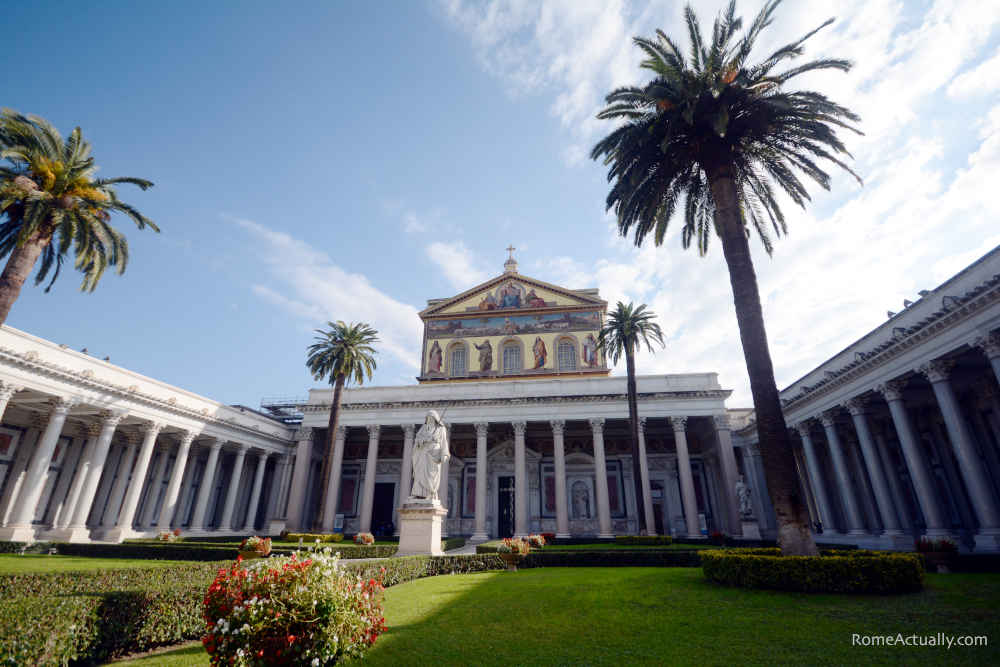
Stadium of Domitian
Have you noticed that Piazza Navona has an oval shape? Wondering why? Because it was built on top of a vast stadium wanted by emperor Domitian in an effort to shift his fellow citizens’ interest from the gory shows of the Colosseum to more well-behaved Greek sports disciplines.
The imperial effort went unsuccessful for the most part, but the remains we can see today from Via di Tor Sanguigna of Domitian’s Stadium show a finely decorated theater with carvings and ornamental statues. Visitors can also watch an interesting representation of how both the stadium and the city of Rome were at the time of Domitian.

Rome’s Catacombs
Even though scattered all around the city, I gather Rome’s Catacombs in one paragraph because they are quite a lot and belong to pretty much the same period of time, the early Christianity in the city.
From Priscilla Catacombs near Villa Ada Park to the huge San Callisto’s in the Appian Way, visiting Roman ancient burial sites is very fascinating to understand an important part of the local history and society in what it concerns both the Christian persecutions, the cult of the dead and the transition from paganism to Christianity.
Rome’s Mithra Temples
Similar to the Catacombs, also the sanctuaries devoted to the Persian god Mithra are several in Rome so even though placed in several locations, I think it’s less confusing to gather them under the same roof.
Apart from the one mentioned above located below San Clemente Basilica, most Mithra temples are underground and often open to the public only after previous booking and request to the Council (060608) or to a certified guide. Those that are worth a visit are the ones of the Baths of Caracalla, the Circus Maximus and underneath Palazzo Barberini .
Pyramid of Caestius
Located in the Testaccio neighborhood near Ostiense, Rome’s Pyramid is pretty difficult not to notice since it’s huge and stands out from all the other buildings in the area. It was built by Caius Cestius between 18 and 12 BC at a time when the Egyptian style was very popular in Rome.
Unfortunately, it’s not always open so if you want to enter, you should call Rome municipality at 060608 for inquiries. Otherwise, you can go see it from outside and maybe enter the adjacent Protestant Cemetery where you will also stumble upon the sweet cats of the Pyramid’s colony that often jump into the graveyard to relax.
Trajan’s Markets
At this site, you will be visiting an archaeological area and a museum, the permanent exhibition of Imperial Fora, the huge archaeological park along Via dei Fori Imperiali connecting Piazza Venezia with the Colosseum.
The area housed shops and administration offices and what we call the Trajan’s Markets was where they managed all the activities related to the Trajan’s Forum. The tour includes traditional and interactive panels as well as multimedia presentations showing how the Imperial Fora were in their heyday.
You will see parts of decorations, pillars, temples, columns, sculptures, capitals from all the imperial fora including the ones of Julius Caesar, Augustus, and Nerva, apart from Trajan’s one. As a big perk, when visiting this archaeological site, you can also enter the ruins of Trajan’s Forum.

Domus Aurea
Relive the splendor of Nero’s Domus Aurea he built for himself after the devastating fire that in 64 AD destroyed much of Rome’s city center. This was the sumptuous home emperor Nero built for himself and included a large complex of gardens and other areas destined for the entertainment of the family or for residential purposes.
Occupying a surface of more than 50 hectares over the Palatine and the Esquiline Hills, according to historians, the Domus Aurea was the largest and most opulent residential mansion ever built in Rome.
Even though after Nero’s death his successors tried to erase everything linked to him also by looting its residence from all its decorations, today it’s possible to visit what’s left of it and see how it was back in the day thanks to the immersive multimedia Domus Aurea Experience. Here for more info .
Circus Maximus
Not far from the Colosseum, the Circus Maximus was a huge oval-shaped racecourse for chariots. Today is mainly used as a park, for relaxing, and running, and also for public events such as concerts, New Year’s celebrations, and for festivals and activities the council organizes on the occasion of Rome’s birthday on April 21st .
Since on the actual site there is no illustrative panel, a nice way to enjoy your visit and see how it looked like back in its heyday is to join the recent Circo Massimo Experience sponsored by Rome Council, a tour of the place with the aid of Zeiss VR devices for multimedia reconstruction. Click here for more info on timing, prices, and how to book.
Nearby, you can visit the Baths of Caracalla and, if you happen on the weekend, you can visit one of the best food markets in Rome , Mercato Campagna Amica al Circo Massimo (Via di S. Teodoro 74).
Domus Romane of Palazzo Valentini
Not far from Piazza Venezia is Palazzo Valentini (Via Foro Traiano 85), a 16th-century palace now the seat of Provincia di Roma. In its undergrounds, it’s possible to visit the ruins of an ancient Roman domus , a patrician house belonging to a powerful family from imperial times, probably of a senator, that still preserves mosaics, colorful flooring, and finely decorated walls, and shows even the remains of a private thermal bath.
Diocletian Baths at Museo Nazionale Romano
Museo Nazionale Romano is a museum in Rome spread into several locations. The main one is next to Stazione Termini and is staged all around the huge Diocletian Baths, the ruins of which you can visit during your tour. The museum itself, even though not an archaeological site, displays arguably the world’s largest collection of ancient Roman findings, tools, mosaics, decorations and more.

Crypta Balbi
On the other hand, Crypta Balbi is located in Via delle Botteghe Oscure between Largo Argentina and Piazza Venezia. Standing right next to the theater Lucius Cornelius Balbo built in the 13th century BC, the crypt was a covered porch to serve as a protection for the citizens waiting to enter the nearby theater in case of rain or as a refreshing point for the breaks during the plays.
Largo Argentina
Largo di Torre Argentina is an important sacred area of Ancient Rome consisting of four large temples. One of the first temples built here dates back to the 3rd century BC and was commissioned by the naval commander Gaius Lutatius Catulus after his victory against the Carthaginians.

The second temple was erected in the 2nd century BC at the request of Quintus Lutatius Catulus and lies near the oldest of all the temples of Largo Argentina, the one devoted to Feronia, ancient Sabine divinity, built between the 4th and 3rd centuries BC.
Largo Argentina is also famous for being the place where important Roman statesman and commander Julius Caesar was murdered and for hosting one of Rome’s largest feline colonies.
As a fantastic update, the important Roman archaeological site of Largo Argentina has been finally opened to visitors who can access and have a tour around it for 5€ per person. In summer, it’s open until 7 pm, and in winter, until 4 pm (last entrance, an hour before closing time).
Insula of the Ara Coeli
It’s such a pity that this wonderful place is hardly noticed by the crowds. Probably its position slightly hidden from the main route or its being below modern-day street level are the culprits for it being so out of the radar even though one of the most important ancient ruins in Rome and revealing of the urban planning and development of Roman times.

To face the increasing overcrowding of the city between republican and imperial times, Romans started to build tall blocks of flats that would develop vertically instead of horizontally. From the street, if you look down over the fence, you can see all four floors the insula was originally built with, the shops ( tabernae ) of the ground floor, and beautiful frescoes on the upper level.
About The Author: Angela Corrias

23 Best Rome Tours – Explore the Eternal City with an Expert

3 Days in Rome – What to See and Do in Rome in 3 Days

How to Plan a Trip to Rome – Complete Step-by-Step Guide
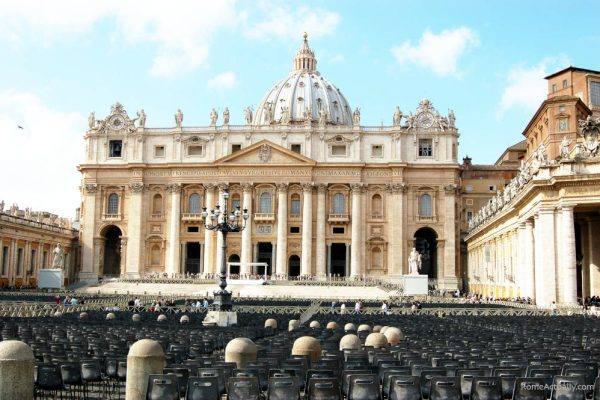
Easter in Rome – All You Need to Know (2024 Edition)
Leave a Comment Cancel reply
This site uses Akismet to reduce spam. Learn how your comment data is processed .
Privacy Overview

30+ Ancient Roman Ruins & Archaeological Sites In Rome
If you’re a history buff, you’ll definitely want to check out my guide to 30 must-see Roman ruins, archaeological sites, and historic landmarks in Rome, Italy. These attractions are some of the best ways to experience the city’s rich history.
Rome is a city filled with magnificent ancient sites and can be overwhelming to navigate. Essentially, the city itself is a sprawling outdoor museum that transports you to a bygone era at every turn.
With so many incredible ruins to explore, you’ll want to plan your visit carefully to make the most of your time.
Many of these Roman ruins tell great stories: Roman armies vanquishing foes, heros cementing legacies, and dedications to gods to seek their protection.
If you listen closely, you can hear Julius Caesar and his cohorts speechifying, promenading, and leading victory parades through the Roman Forum.
READ : History of the Rise and Fall of Ancient Rome
2,000 years ago, Rome was synonymous with “civilization.” You were either civilized or you were a barbarian to be defeated.
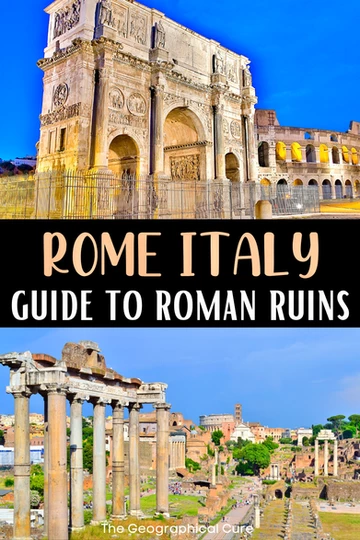
To attest to their then-civilized nature, ancient Romans left a raft of fascinating ancient buildings, temples, forums, and sculptures.
Some are hulking ruins. Others are well preserved and offer a secret peak into Rome’s tumultuous past and controversial rulers.
Let’s tour the 31 most interesting ruins in Rome that should be on your Italy bucket list .
Roman Ruins And Archeological Sites In Rome Italy
Here are my picks for the 30+ must visit Roman ruins in Rome.
1. Domus Aurea: Nero’s Underground Golden House
Nero’s Golden House was once the grandest building on earth.
It’s not your typical Roman tourist site, and is an often overlooked hidden gem in Rome. Domus Aurea is an excavation in progress, one of Rome’s best Roman ruins and archaeological sites.
Built by Emperor Nero between 64-68 AD in the heart of imperial Rome, the sprawling property covered up to 300 acres. The facade and walls were adorned with frescos, gold leaf, glass mosaics, pearls, and marble. In natural light, it had a golden hue.
READ : History of the Roman Emperors
But little of this wealth survived Nero’s rule. As Nero’s extravagance and tyranny spun out of control, rivals condemned both his reign and his emblematic palace.
For a decade after his death, the palace was looted, destroyed, and filled in with brick. But the vivid frescos by the artist Famulus couldn’t be pried off the walls.
At the end of the 15th century, the Domus Aurea was discovered by accident when a young man fell into a crevice. To his surprise, he found himself surrounded by paintings.
At first, the palace ruins were thought to be caves or grottos. Artists like Michelangelo and Raphael flocked to see the ancient frescos.
In the 18th century, proper excavation of the Golden House began. Now, you can visit (with a hard hat) on the weekends. The crown jewel is the Octagonal Room, which represented a revolution in architectural style and technique. Here’s my compete guide to Domus Aurea .
Thanks to YouTube, you can also take a virtual tour of the ruins of Domus Aurea, still an excavation in progress, and see how it would’ve looked looked almost 2,000 years ago in ancient Rome.
Click here to book a guided tour of Domus Aurea. Click here to book the virtual reality experience.
2. Domus Transitoria, Nero’s First Palace
Before there was Domus Aurea, there was Domus Transitoria. Nero’s first palace was built between 60 and 64 BC. The palace had a short life. It was destroyed in the great fire of Rome in 64 BC.
Like Domus Aurea, Domus Transitoria was a massive and lavishly decorated palace, connecting the Palatine Hill and Esquiline Hill. It was dubbed the Transit House.
According to Seutonius, Domus Transitoria was characterized by all the pomp, gold, and luxury one typically associates with grandiose Neronian architecture.
Domus Transitoria was just opened in April 2019. You enter and descend a staircase to inspect the site underground.
Virtual reality headsets bring the dank place to life, allowing visitors to see vignettes of the palace in its former glory.
You can take this YouTube virtual tour to see the ruins and a glimpse of what the palace looked like in ancient Rome.
3. Pantheon: Rome’s Most Perfect “Ruin”
Without a doubt, the Pantheon is the best preserved building from ancient Rome.
You’d don’t have to wrinkle your brow or struggle to conceptualize anything, as with many ruins. It’s all before you.
The Pantheon was a temple dedicated to all of the gods. It was originally built by Augustus’ right hand man, Marcus Agrippa in 27 BC.
The pediment still proclaims that “Marcus Agrippa, three times consul made this.” But Agrippa’s version was destroyed by fire.
In 120 AD, the Pantheon was rebuilt by Hadrian. The well traveled emperor, a true Grecophile, reimagined it as an oversized Greek temple.
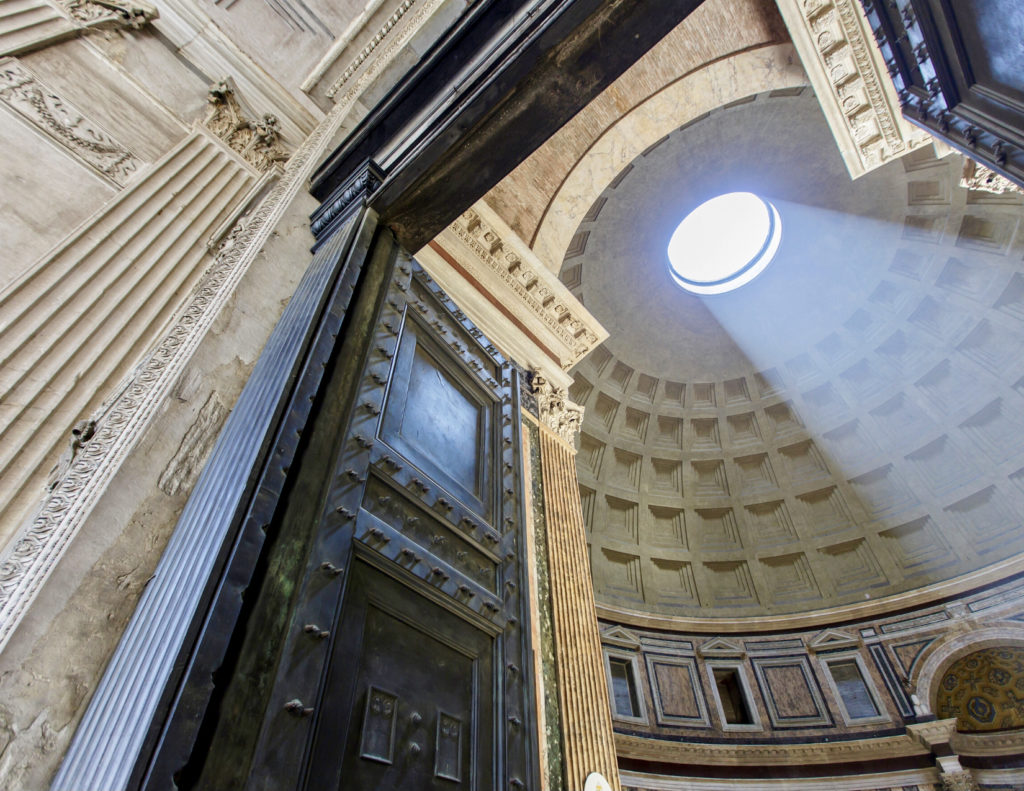
It has 40 foot tall Corinthian granite columns from Egypt, a pediment, and portico. It was considered a masterpiece of engineering and mathematical precision.
The Pantheon’s most emblematic feature is its perfect unsupported spherical dome. At the time, it was a major architectural breakthrough. The dome became the model for Michelangelo’s dome for St. Peter’s Basilica and for Brunelleschi’s dome for Florence Cathedral .
The dome is made of lightweight concrete, a Roman invention. The concrete gets increasingly thinner as the height of the dome increased.
The coffered ceiling also reduced the weight without compromising the dome’s structural integrity. At the top is the oculus, or eye, which is the Pantheon’s only source of natural light.
After the fall of Rome, the Pantheon became a Christian church, which helped save it from looting at first. But eventually the interior, marble, and gold were all looted in the 7th century, although the marble floor is recreated.
The Pantheon is filled with tombs of important Romans, including the artist Raphael.
You can take a 360 tour of the Pantheon here . And here’s a fantastic video from Smarthistory with shots of the Pantheon and an explanation of its importance.
Here’s my complete guide To the Pantheon . Click here to book a guided tour of the Pantheon.
4. Baths of Diocletian: Largest Baths in Ancient Rome
Rome took its baths seriously. They were places to swim, bathe, and socialize. The Baths of Diocletian were built by Emperor Maximian to honor his co-Emperor Diocletian.
Constructed between 298-306, the Baths of Diocletian were Rome’s largest bath complex. They were meant to surpass the Baths of Caracalla and could accommodate 3,000 citizens.
Ironically, Diocletian never saw the baths. Diocletian was a colorful man with a big ego, who thought he was a living god. Having successfully divided the empire to make it easier to manage, he governed in the east or camped out in his swishy palac e in Split Croatia .
The baths were built using the typical bath design of Roman times — with a frigidarium (cold), tepidarium (warm) and caldarium (hot), large bathing chambers, and gymnasiums.
There were smaller rooms for private bathing, changing, and meetings. On the ruins of the frigidarium, Michelangelo was commissioned to build a church, the Basilica of Santa Maria deli Angeli e dei Martiri.
Today, the Baths of Diocletian are part of the National Roman Museum. The baths aren’t particularly conveniently located. They’re in northeast Rome near the Termini station. The upside is that you can experience ancient ruins without the crowds.
Here’s a good YouTube video guide of the site. You can also explore the baths in Google Art & Culture .
Click here to book a skip the line ticket and guided tour for the baths.
5. Roman Forum: the Epicenter of Ancient Rome
I advise having a guided tour for the Roman Forum . It’s vast and there’s not much signage. It will be difficult to divine what you’re looking at without a guide to decipher the lovely rubble.
The forum is a rectangular valley running from Arch of Titus to the Capitoline Hill. The main road is the Via Sacre.
The forum was the beating heart of Rome, the seat of power, and its central showpiece. It was a grandiose district consisting of white temples, grand basilicas, and vibrant public spaces.
The Forum was the scene of political upheavals, funerals, and triumphant parades. Before the Colosseum was built, it even hosted gladiatorial battles.
Stroll by the Basilica of Constantine, the Temple and House of the Vestal Virgins, the Temple of Venus and Rome, the Basilica of Constantine, and the 3 columns of the Temple of Castor and Pollux.
You’ll also find the ruins of the Temple of Caesar . It was built by Augustus after Caesar’s assassination. Inside, in a small apse area, is a mound of stone and dirt covered with coins and flowers. This is the altar holding Caesar’s ashes and marks his grave.
You can take a virtual tour of the forum on Google Arts & Culture , with almost 300 different items to eyeball. You can also take a 360 tour on 360 Cities or a virtual walking tour with Pro Walks.
Most tickets include entry to the all the imperial ruins — Colosseum, Palatine Hill, and the Roman Forum. There are plenty tour options you can choose from.
They all vary slightly in duration and what you see. So pick one that best suits your sightseeing agenda.
I’ve done the fourth and seventh one on this list and loved both tours.
- skip the line entry tickets to all 3 sites
- tickets + a 2 hour guided tour for all 3 sites
- 3 hour guided tour and entry to all 3 sites
- tickets & tour of all 3 site s + underground Colosseum access
- Colosseum tour with entry tickets for Palatine Hill and the Roman Forum
- 4 hour private day tour of Ancient Rome
- skip the line private guided tour with an art historian
- skip the line private tour of all 3 sites + the underground Colosseum
6. Colosseum: Into the Gladiators’ Lair
Formally named the Flavian Amphitheater, the Colosseum has stood in Rome for almost 2,000 years. It’s the most instantly recognizable monument from the classical world.
Despite the ravages of time, the Colosseum is an incredibly well-preserved piece of Rome’s fascinating history.
Emperor Vespasian began constructing the Colosseum in 72 AD. It was finished by his son Titus in 80 AD. Domitian subsequently added the hypogeum, or basement.
In its glory days, the Colosseum was a vivid white with painted trim and frescoed hallways. There were monumental statues of the Greek and Roman gods in the arches of the middle two stories. The top story had a retractable canvas awning to shade spectators.
The Colosseum hosted the popular “games,” a form of ancient theater re-creating far flung lands and mythological themes for the masses. There were many variations.
The spectacles pitted men against men, men against beasts, and beasts against beasts. There was a menagerie of beasts — lions, giraffes, crocodiles, dogs, rhinos, elephants, etc.
The best way to visit the Colosseum, and go behind the scenes, is on an Underground Colosseum Tour. You’ll visit parts not accessed by the standard tickets, like the hypogeum and third ring.
You can tour the Colosseum on Google Arts & Culture , where there are over 200 photos. You can take a virtual walking tour of the Colosseum on its official website. Or take a 360 virtual tour on Air Pano.
Here’s my complete guide to the Colosseum , with must know tips for visiting. You can book guided tour of the Colosseum or a tour that also includes the underground gladiator area of the Colosseum .
7. Theater Of Marcellus: A Romantic Facade
Located in the Jewish Ghetto neighborhood of Rome, the Theater of Marcellus is easily overlooked by most tourists. But I walked past it everyday on the way home to my Air Bnb in Trastevere on my last visit.
The monument isn’t far from the gigantic white Monument of Victor Emanuel. And it looks like a mini-Colosseum.
The Theater of Marcellus is truly ancient. Julius Caesar launched construction and his heir Augustus inaugurated it in 12 BC. It could seat 20,0000. As you walk around it, you’ll see both Doric and Ionic columns. There are ruins piled up all around it.
Unfortunately, you can only admire the exterior and walk along the amphitheater edge. In the 4th century BC, the theater started to crumble. Thereafter, it was used as a stone quarry and repurposed, like so much else, for other buildings in Rome. In the summer, there are sometimes concerts outside.
Today, the Theater of Marcellus is a building that’s half private and half public. If you look at the photo, you’ll see luxury apartments lining the top.
8. Augustus’ Mausoleum: Family Tomb of Julio-Claudian Dynasty
Augustus’ Mausoleum is the family tomb of Rome’s first emperor. As mentioned above, Augustus ruled between 63 BC and 14 AD and was the great nephew and heir of Julius Caesar.
His mausoleum was built around 28 BC after the Battle of Actium. It was inspired by the mausoleum of Alexander the Great in Egypt.
The mausoleum was a burial place for Augustus, his wife Livia, and the other Julio-Claudian emperors. Not much has survived from its former grandeur and it’s original appearance is unknown. The mausoleum is closed to the public.
Though it was in ruinous condition, a 6.5 million euro restoration began in 2016 and was is only partially complete as of the summer of 2023. 50% of the structure is long gone — pillaged and destroyed.
The renovated monument opened to the public in March 2021 with a 3D experience, much like Domus Aurea. Hopefully, excavations will be fully complete in the summer of 2024.
Click here to book a skip the line ticket. Here’s a YouTube video of Rome’s mayor showing off the restored mausoleum.
9. Ostia Antica: an Alternative to Pompeii
Founded in 4th century BC, Ostia Antica is an ancient harbor town about 40 minutes outside Rome. It’s a pretty adorable town too, with warm orange stone buildings.
In ancient Rome, Ostia served as a naval base. Later, it became important commercially. This was where food and grain supplies arrived to feed Roman citizens.
There are some impressive preserved ruins. It’s similar to Pompeii — the excavation of an entire ancient city.
You get to wander around the ancient town at will.
Along the way, you’ll see a necropolis, an amphitheater, ancient temples and gates, the Baths of Neptune, statues, mosaic floors, and the forum. Mosaics were used to inform illiterate Romans about the purpose of a given building — tavern, baths, brothel, etc.
Click here to book a guided walking tour. You can also book a half day guided tour from Rome .
You can explore Ostia Antica virtually on Google Arts & Culture .
10. Baths of Caracalla, Termi di Caracalla
The Baths of Caracalla are another must visit Roman ruin in Rome. The baths were inaugurated by Emperor Caracalla in 216. The massive complex is one of Rome’s best preserved ancient sites.
Construction began in 206 AD, under the direction of Emperor Septimius Severus. His son, Caracalla, finished it 10 years later, after killing his brothers to seize sole power.
The baths could accommodate 1600 people. The original brick walls are still standing, a towering shell. They were once covered in stucco and marble. But that was long ago carried off by looters.
The sculptures and mosaics from the Baths of Caracalla have been moved to museums. The famous Belvedere Torso is now in the Vatican Museums .
The Farnese family pillfered and excavated the baths. The Farnese Bull and the Farnese Hercules are in Naple’s Archaeological Museum. Two fountain shaped bathtubs are now in the Piazza Farnese in Rome.
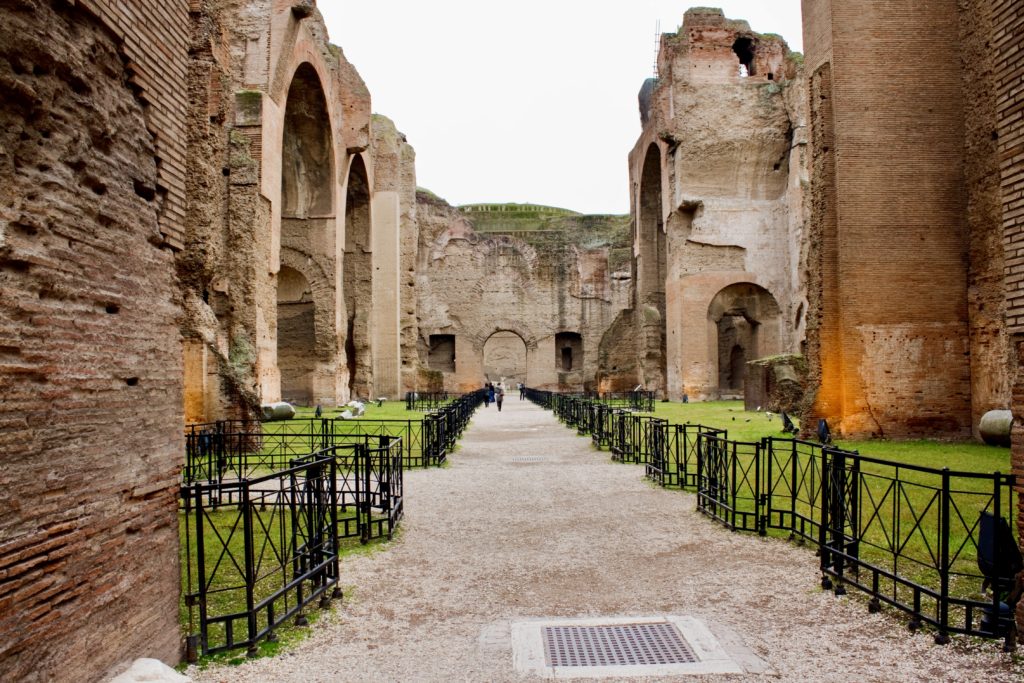
The large rooms at each end of the structure were used for exercise. In between was a long pool flanked with changing rooms and decorated with mosaics.
You can still see the black and white floor mosaics. To keep cool in the summer, the Romans played games in the pool on tables.
Tourist can even visit the underground tunnels of the bath complex, where slaves kept the baths going. You can also don virtual reality googles.
Here’s my complete guide to the Baths of Caracalla . You can book a small group or private tour of the baths. You can also book a tour that includes both the baths and the Circus Maximus . You can also visit the baths with the Roma Pass .
Every summer since 2014, the Baths of Caracalla are the backdrop for open air night at the opera performances . You can read about it and see shots virtually on Google Arts & Culture . You can also take a 4D tour of the Baths of Caracalla on Rome’s Coop Culture website.
11. House of Augustus, Palatine Hill
For nearly 2,000 years, the House of Augustus on Palatine Hill lay hidden. Archaeologists only discovered the ancient home in the 1960s.
The House of Augustus marked the transformation of Palatine Hill from a residential area into an imperial seat.
The House of Augustus is located on the most sacred area of the Palatine Hill, near the symbols of Roman power.
It was built near the Temple of Apollo (which Augustus could access by ramp from his peristyle) and on top of the sacred Cave of Lupercal, where the She Wolf of Rome nursed the twins Romulus and Remus.
Comprising two levels, the House of Augustus served as Augustus’ primary residence during his reign. It was arranged around two courtyards, linked by an open promenade. Emperor Domitian, a more megalomaniacal sort, demolished much of it when he built his massive palace.
The western end of the house held the domestic rooms. The eastern end held the public reception rooms. By far the most elegant room is the Emperor’s Study, where Augustus burned the midnight oil.
Protected behind glass, the walls are beautifully decorated with stylized winged obelisks, gryphons, and floral elements. The colors are bold — green, black, green, and yellow.
The House of Augustus is most celebrated for its lavish red Pompeian frescoes. They’re the best preserved frescos from ancient Rome, superior even to those in Pompeii. They’re the real reason you should visit the House of Augustus.
Most of the frescos are executed in the Second Pompeian Style, called the “Architectural Style.” It began in Pompeii, became the fashion, and was then adopted by Augustus.
The style emphasized architectural features and illusionistic compositions. Artists used columns, faux marble blocks, and stoas to frame fantastic images. The use of vanishing points made the walls seem three dimensional.
You can only visit Domus Augustana with a special ticket and a reservation. It’s not included in the standard ticket giving you access to Palantine Hill.
Access is via small groups of 20 on a 75 minute guided tour, with specific time slots on certain days. There are informative audiovisual and laser displays.
Click here to pre-book a guided tour of the House of Augustus. Here’s a YouTube video on the House of Augustus and the House of Livia (discussed below). Here’s my complete guide to the House of Augustus .
12. House of Livia, Palatine Hill
If you book a special ticket to see the House of Augustus, you’ll also see the House of Livia. Livia was Augustus’ third wife.
When Augustus fell in love with the beautiful young woman, they both divorced their respective spouses to marry. Livia’s son from her first marriage, Tiberius, became Augustus’ heir and the second emperor of Rome.
First excavated in 1839, Livia’s House was attributed to her when her honorific name was found stamped on a lead pipe. Built in the first century BC, Livia’s house was actually a bit larger and grander than her husband’s house.
The best preserved section is the atrium and three adjoining rooms. The central room (the tablinum) was the most richly decorated. Known as the Room of Polyphemus, it had mythological frescos showing Mercury kidnapping the nymph Io.
In the dining room, there was a stunning garden fresco that made the walls almost disappear. The fresco has flowering trees, blossoms, and flying birds in all varieties of nature.
The colors are delicate in faded purple, blue, yellow, and white.
The original of this fresco was moved to the Palazzo Massimo all Terme, one of Rome’s best museums . A replica is now in the House of Livia on Palatine Hill.
Here’s Smarthistory’s video about the magnificent garden fresco.
13. Domitian’s Palace, Palatine Hill
Domitian’s Palace is a Roman ruin that was built circa 81 AD by Emperor Domitian. He hired master architect Rabirius to create a massive imperial palace.
It was so grand that one poet remarked that it “made Jupiter jealous.” It was the residence of Rome’s emperors for three centuries.
Unlike previous emperors, Domitian wasn’t interested in public architecture. A megalomaniac, he viewed himself as “lord and god” and wanted the public to know it.
The palace contained many large spaces, including a basilica, receptions rooms, an audience hall, a stadium, a sunken garden, peristyle courts, and baths.
The part of the palace above the Circus Maximus was added by Emperor Severus. The Circus Maximus was a long oblong course for chariot racing. If the gladiator show at the Colosseum was sold out, the citizens would come here for entertainment.
Inside, the palace was decorated with reflective surfaces, probably white marble or selenium. A paranoid Domitian wanted to be able to spot any potential enemies and see what people were up to.
Each public room had apses, where Domitian could sit on a throne and be worshipped.
14. Arch of Constantine: Symbol of Christianity
The Arch of Constantine is a triumphal arch dedicated to Emperor Constantine the Great. It represents a seismic shift in history, when the western world became Christian.
Until 312 AD, Rome was a pagan empire. But a small, obscure, and previously persecuted sect was becoming more popular, Christian monotheists.
In 312, Emperor Constantine saw a vision of a cross in the sky. The next day, he defeated his rival Maxentius, becoming sole emperor. His first task as an agent of change was to legalize christianity.
The Arch of Constantine is on the Via Triumphalis in Rome, between the Colosseum and the Roman Forum. It’s approximately 21 meters high and 25 meters wide.
It’s decorated mostly with recycled carvings from other buildings and from different times. Because of this, some art historians have criticized the arch as poor craftsmanship.
But Constantine deliberately wanted reliefs from other great eras. To unscore this point, there are statutes of the great emperors on the arch, putting Constantine in good company. As a usurper himself, it was important to also be a symbol of reverence.
You can take a 360 tour of the Arch of Constantine here .
15. Arch of Titus
This intricate triumphal arch marks the entry into the Roman Forum. Emperor Domtian built it to celebrate his brother Emperor Titus’ destruction of Jerusalem in 71 AD.
The reliefs inside feature scenes of the Roman troops sacking Jerusalem, soldiers carrying bodies and taking items from the Temple in Jerusalem, and the first depiction of a menorah. The arch was intended to exalt the mythological status of the Flavian dynasty.
It was a terrible monument for Jews. In antiquity, Jews refused to walk under the arch because of it subject matter.
You would think the monument was anti-Semitic. But at the time, it was just business as usual — Rome putting down a rebellion, which was more about taxes than religious differences.
You can take a 360 virtual tour of the Arch of Titus.
16. Castle Sant’Angelo: Fortress Museum
Castle Sant’Angelo is also known as Hadrian’s Mausoleum. Hadrian built it on the banks of the Tiber River in 139. It’s a magnificently preserved ruin from Ancient Rome.
Hadrian also erected the Bridge of Angels, which connected central Rome to his mausoleum. The bridge is now lined with 10 angels, designed by Bernini and commissioned by Pope Clement IX. Each statue holds an object of Christ’s passion.
READ : Guide To the Bernini Trail in Rome
The cylindrical castle was richly decorated. Originally, it was faced with travertine marble, pilasters, and bronze. By the 5th century, the mausoleum was converted into a miltary fortress.
It was renamed Castle Sant’Angelo in the 5th century. Legend holds that the Archangel Michael appeared above the castle, sheathed his sword, and magically put an end to the plague.
In the 14th century, Castle Sant’Angelo was turned into a papal residence. A covered corridor connected it to St. Peter’s Basilica. Popes fled there during sieges.
In the 15th century, at the direction of the notorious Borgia pope, Alessandro VI, the castle became battle ready. He also installed sumptuous papal apartments decorated with frescos by Pinturicchio, who also decorated the Borgia Rooms in the Vatican Museums .
In 1536, a marble and bronze statue of Archangel Micheal was perched on top. There are gorgeous 360 views of Rome and St. Peter’s Basilica from the Terrace of the Angel. The museum also has a bar/coffee shop with splendid views.
You can take a virtual 360 tour of the Castle Sant’ Angelo here or check out this BBC documentary on the famous Roman monument.
Here’s my complete guide to the Castle Sant’Angelo , which is almost one of Rome’s hidden gems since so few venture inside.
In high season, you may want to book a skip the line ticket . Click here to book a guided tour with fast track access.
17. Mouth of Truth: Roman Lie Detector
This sculpture is a Pavonazzzo marble mask called la Bocca della Verita, the Mouth of Truth . It has the ambiguous face of an unknown pagan god with an open maw. It’s located in the portico of Santa Maria Church.
Legend holds that, in medieval times, the carved mask was a device for determining whether a person was telling the truth.
Suspicious people were brought to the sculpture. They took an oath and put their hand inside the gaping mouth while being interrogated.
If the detainee was being truthful, the mouth wouldn’t moved and you could keep your hand. If you were lying, the mouth would slam shut and bite off the hand.
The legend became famous via Hollywood. In the 1953 film Roman Holiday , the Mouth of Truth was used as a storytelling device.
I’m not sure this sculpture is worth a trip in and of itself. It’s been theorized to be a possible drain cover or fountain decoration. And the line for testing your hand can be long.
18. Trajan’s Market: World’s First Shopping Mall
Trajan’s Markets is a large complex of ruins that was part of Trajan’s Forum. This forum was the largest and most advanced of six imperial forums in Rome, as befitting Rome’s most popular and powerful emperor dubbed the “best leader.”
Trajan’s Market was built in the 2nd century AD by Trajan’s favorite architect, Apollodorus of Damascus. It’s affectionately called the world’s “first shopping mall.”
Trajan’s Market was a dense complex. It was once 6 stories with 150 shops and offices, set into the side of Quirinal Hill.
The structure is remarkable. It shows that Romans didn’t just build with columns and pediments. Powered by concrete, this urban structure was light filled, with windows and atriums.
Click here to book an entry ticket. You can also take an amazing virtual tour of Trajan’s Market from your couch.
19. Trajan’s Column: War Diary
Trajan’s Column was part of Trajan’s Forum. It’s probably the best preserved victory column in Rome, though it’s similar to the column for Marcus Aurelius in Piazza Colonna. Built in 113 AD, the column was a tour de force of Roman propaganda art.
The column celebrated Trajan’s defeat over the Dacians. It depicts the campaigns he fought against them, the fortifications that were built, the Dacian themselves, and their weaponry.
The column consists of 22 layers, one yard each, spiraled around a 125 foot high column. The emperor’s ashes were buried in the foundation after his death.
You wouldn’t know it, but there’s a staircase inside that takes you up to the top. Atop the column, there’s a statue of St. Peter. During the Renaissance, it replaced a statue of Trajan.
Here’s a great video showing and explaining Trajan’s Forum.
20. Catacombs of Priscilla
Dating back almost 2,000 years, the Catacombs of Priscilla are a series of catacombs built by early Christians. Known as the “Queen of the Catacombs” since antiquity, the catacombs house the bones of early popes and many Christian martyrs.
The Catacombs of Priscilla are considered one of Rome’s most interesting underground sites, hidden away under Villa Ada Park.
After five years of conservation and restoration, the Priscilla Catacombs opened to the public in 2018. Lasers were used to clean the religious frescoes on the walls.
Click here to book a guided tour of the catacombs. A new function on Google Maps allows you to take a limited tour of the of the vast complex. You can also see the frescos on this Smarthistory video .
21. Hadrian’s Villa: an Easy Day Trip From Rome
Built in 118-133 A.D, Hadrian’s Villa is an important archeological complex. It’s the largest and most spectacular villa of ancient Rome, three times the size of Pompeii. Hadrian’s Villa is an easy day trip from Rome , just 30 minute away.
It reflected the power and glory of ancient Rome and one of that world’s most important leaders, Emperor Hadrian. And it was designed by Hadrian himself, just like the Pantheon.
Hadrian’s Villa is a sprawling luxury palace. It was designed on a vast scale to reflect the power, elegance, and excess of the Roman Empire.
Though it’s called a “villa,” Hadrian’s Villa is more accurately a miniature Rome that covers nearly 300 acres. It’s dotted with 30 large structures — palaces, libraries, baths, living quarters, dining pavilions, and sculptural gardens.
Hadrian’s Villa was originally intended as a secret escape from the political complexities of a bustling Rome.
But Hadrian loved his villa so much that he moved in and used it as the seat of government in his last decade, much like Louis XIV governed France from Versailles.
Here’s a great Smarthistory virtual tour of Hadrian’s Villa. While you’re in Tivoli visiting Hadrian’s Villa, you should also visit the Renaissance era Villa d’Este .
Here’s my complete guide To Hadrian’s Villa . Click here to book a wonderful guided day tour from Rome.
22. Arch of Janus
The Arch of Janus is the only surviving four way marble arch in Rome. It’s close to the Mouth of Truth, if you’re visiting that. Built in the 4th century, the arch has four facades. It was supposedly built from pieces of other ruins.
The Arch of Janus is built over an ancient drain to the Tiber River. It’s thought to have been a boundary marker, rather than a triumphal arch.
The Arch of Janus now stands in front of the Palazzo Rhinococros. In 2012, the building was purchased and restored by Fendi heiress, Alda Fendi. It’s the newest hotspot/art space in Rome, with cultural and residential spaces that opened in 2018.
A resin sculpture of an endangered white rhino now stands guard in the square, symbolizing the union of the old and the new. Inside the palazzo art gallery, there’s a Michelango sculpture, Crouching Boy, on loan.
23. Forum of Augustus
The Forum of Augustus is one of the Imperial Fora from Ancient Rome. This forum was built after a young Gaius Octavius defeated Brutus and Cassius in the Battle of Philippi. Octavius was avenging the murder of Julis Caesar.
Before the battle, Octavius vowed that, if he won, he would build a temple to Mars Ultor, which translates to the Avenger. After winning the battle, Octavius kept his promise.
He located his forum next to Caesar’s. At the center was the Temple of Mars Ultor. The long sides of the forum sported colonnades.
The once richly decorated Hall of the Colossus held a colossal statue of the Genius of Augustus. Remains of the statue are in the Museum of the Imperial Fora.
There is also the remains of the Great Wall toward the Suburra. The wall was intended to protect the forum from an overpopulated part of Rome subject to frequent fire. It’s one of the most impressive ruins in the Imperial Fora.
The Temple of Mars Ultor once held colossal statues of Mars and Venus, linking Augustus with the gods. Archaeologists think there may have been a third statue depicting a deified Julius Caesar.
In general, the forum functioned as a military, administrative, and political center. It was a gallery of statues and place to hold important ceremonies.
It was also a place for Senate deliberation. Military commanders would make sacrifices to Mars before going off to battle.
24. House of the Knights of Rhodes
The House of the Knights of Rhodes is perched right above the Forum of Augustus. It’s a little known hidden gem in Rome .
This impressive building, known as the House of the Knights of Rhodes, was built in the 13th century by the Knights of Rhodes. It’s been controlled by the Knights of Malta since 1946.
The building features a massive five-arched loggia, which was once used by the pope to receive blessings from the citizens while overlooking the city.
If you’re interested in visiting, note that the House of the Knights of Rhodes is only open to the public by reservation on Tuesdays and Thursdays. Inside, you’ll have the chance to see several interesting rooms, including the Hall of Honor, the Byzantine Hall, the Sala della Loggetta, and the Palatine Chapel, which is dedicated to St. John the Baptist, the patron saint of the knights.
To catch a glimpse of the house from the outside, head to Via dei Fori Imperiali, which offers an excellent vantage point.
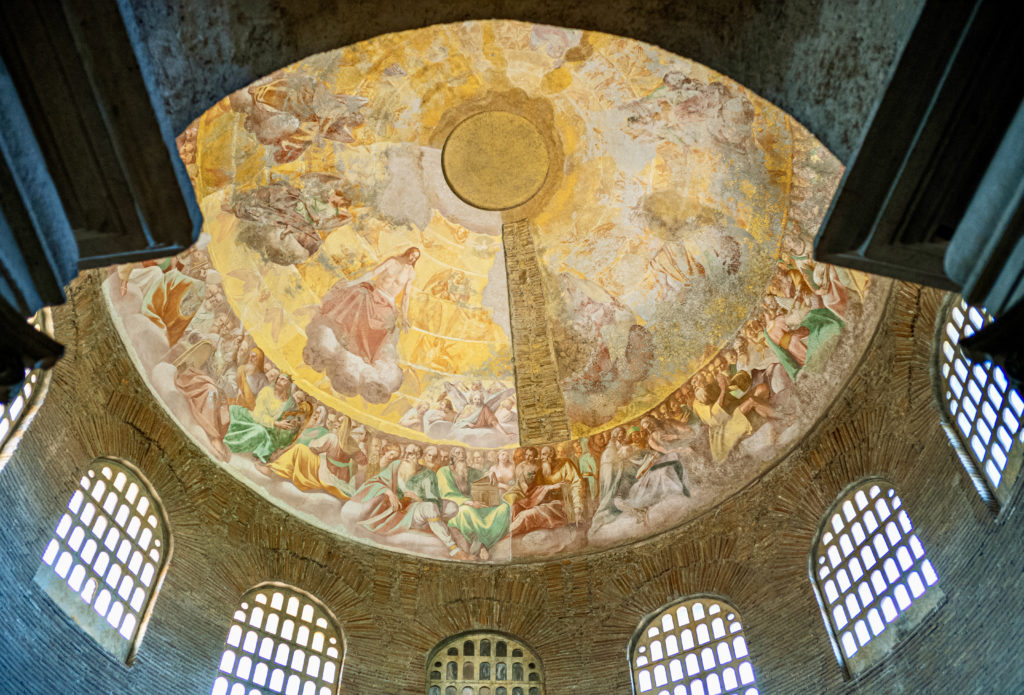
25. Church of Santa Costanza
This church is traditionally identified as the mausoleum of Constantina, the daughter of the Emperor Constantine. It was likely built by Constantine at the behest of his daughter.
But, after excavations in 1992, some historians speculate that the mausoleum may have been built 30 years later by Emperor Julian for his wife Helena. It officially became a church in the 13th century.
This 4th century mausoleum is considered a fine example of early Christian architecture. It is a circular brick rotunda covered by a dome with a vestibule porch.
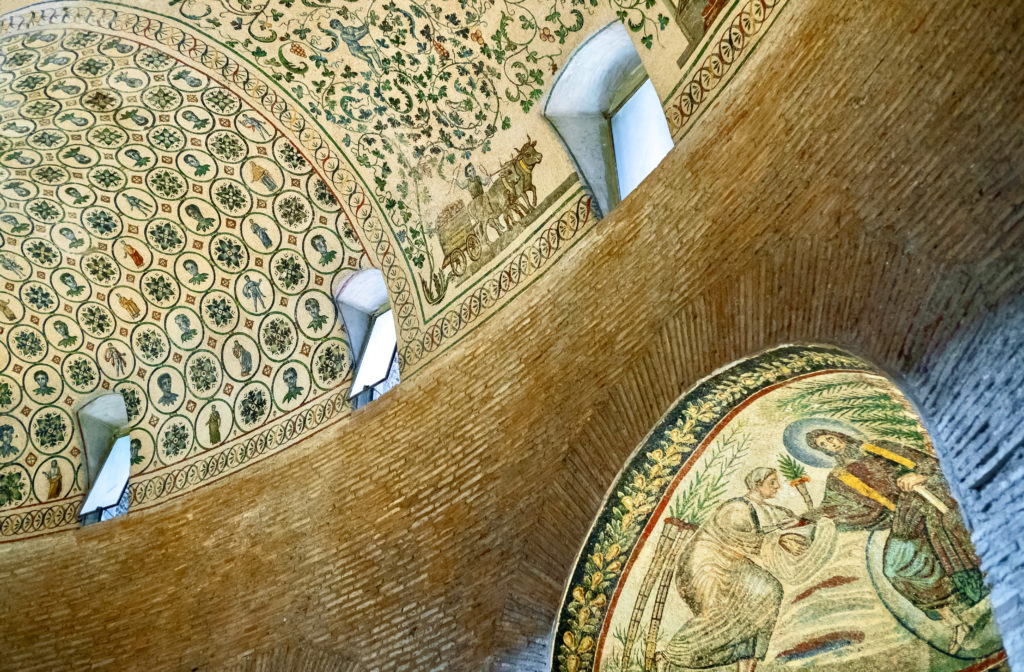
Inside, 12 pairs of Corinthian columns are arranged in a ring. 12 clerestory windows that let light into the interior.
The mausoleum was once elaborately decorated. Originally, the cupola, vault, and niches were covered with early Christian mosaics.
You can still see some in the vault and several niches. They were restored in 1840.
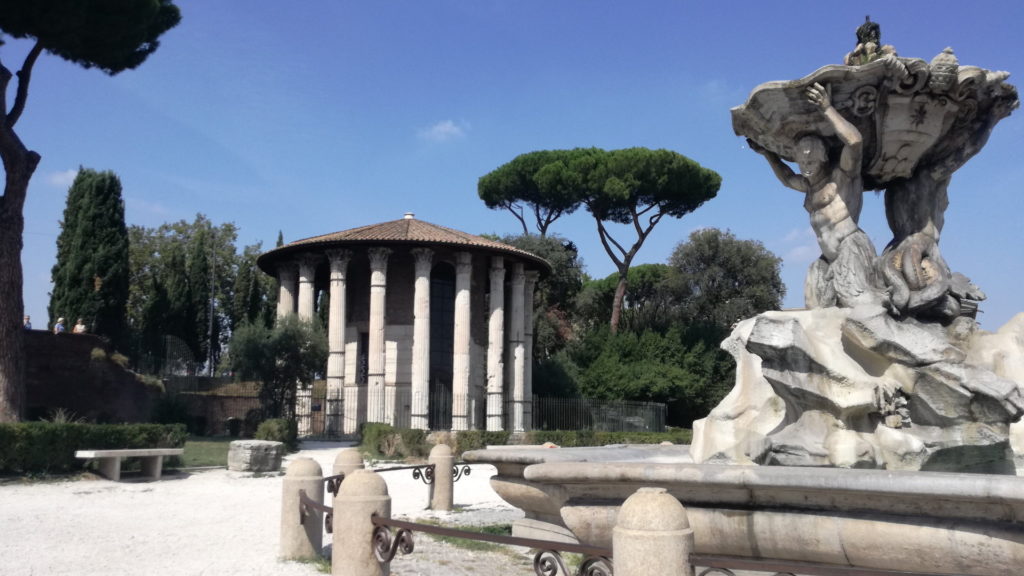
26. Forum Boarium
The other Roman forums get all the love, and so they should. Whereas these famous forums are named for emperors, the Forum Boarium is named … for cattle.
The forum is a Roman ruin that was once the true commercial heart of Ancient Rome. It was the working man’s forum where the docks were located.
The most notable buildings on this forum are the Temple of Hercules (shown above) and the Temple of Portunus.
The Temple of Hercules is the oldest surviving marble building in Rome. Hercules, of course, was the legendary hero of superhuman strength. The Mouth of Truth was likely once located in this temple.
Portunus was the god of gateways, locks and livestock. He might not be the most glamorous god of the Roman pantheon. But he did his job well, granting good luck to the all important merchants.
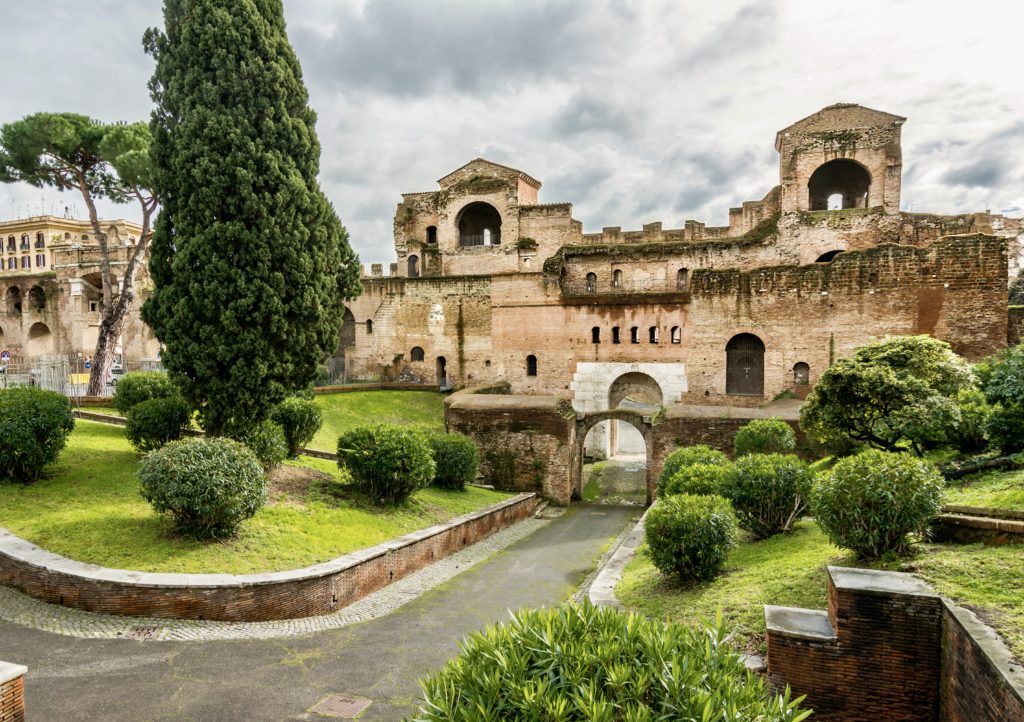
27. Aurelian Walls
The Aurelian Walls in Rome are the biggest, but most neglected, ruins from Ancient Rome.
The walls date from the 3rd century. They were 12 miles long and 26 feet high, with 14 gates and 380 watch towers.
The Aurelian Walls take their name from Emperor Aurelian, a warrior emperor who sought to protect Rome from barbarians when the empire teetered on collapse.
The emperors Arcadius and Honorius made further reinforcements. The two main gates were transformed into self sufficient fortresses. The height of the walls was increased to about 52 feet.
The walls survived the fall of Rome, though parts of the wall were later torn down during the Middle Ages. They continued to serve a defensive function, until they were breached in 1870. This marked the beginning of the unification of Italy.
Here’s my complete guide to the Aurelian Walls .
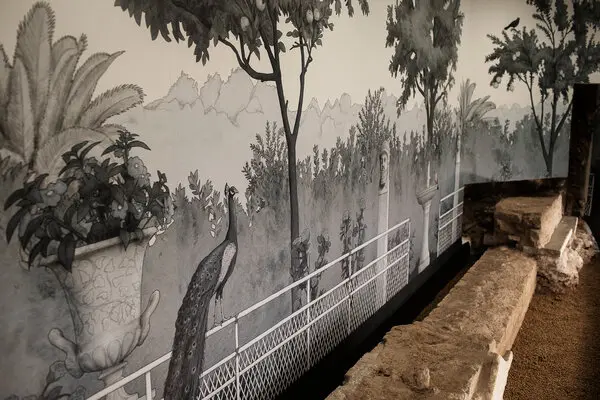
28. Caligula’s Garden Of Delights
Caligula was the fourth of the Caesarian emperors. He’s mostly known as a combustible lunatic and tyrannical ruler who married often and never forgot a slight.
During the four years he occupied the throne, Caligula had a favorite hideaway. It was an imperial garden called Hour Lamiani on Esquiline Hill.
The garden was essentially a wildlife park, filled with shrines, banqueting halls, orchards, and fountains. Exotic animals completed the tableaux. They were used for private circus games.
Archaeologists discovered the Roman ruins of the lavish garden complex under a 19th century apartment building during excavations in 2006-15.
In April 2021 the Nymphaeum Museum of Piazza Vittorio was opened. You can see highly decorative frescos, mosaics, ceramics, jewelry, pottery, and animal bones.
They paint a vivid picture of wealth and opulence of imperial Rome and the appetite for luxury of Caligula.
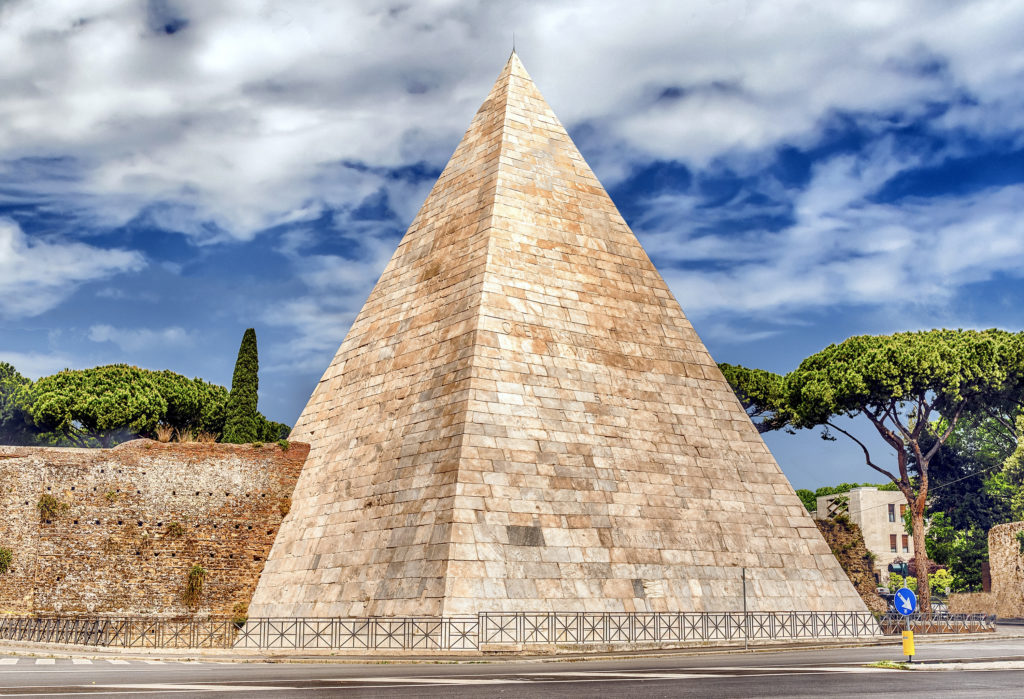
29. Pyramid of Cestius
Rome was a little obelisk crazy in its heyday. Egypt was downright fashionable and astonished wealthy and Rome aimed to emulate its example.
In fact, Rome has more obelisks than the country of Egypt. 8 are Roman and 5 are Egyptian. They’re a symbol of what Rome once was — the cultural hub of the known world.
The Roman pyramid was most likely built between 18 and 12 B.C. during the reign of Augustus. The pyramid is 120 feet high and covered in white Carrera marble.
You can tell it’s not the real deal. The pyramid is too steep and pointy, compared to the real Egyptian pyramids of Giza.
Cestius was built as a tomb for a wealthy Roman under the sway of all things Egyptian. The tomb was long ago ransacked.
The pyramid was excavated and restored in the 16th century. Many of the columns and sculptures that once surrounded it are in the Capitoline Museums .
You can visit the pyramid on a guided tour . If you want to visit solo, reservations must be made in advance.
30. Ara Pacis
Another Roman ruin to visit in Rome is the Ara Pacis monument. The Roman Senate commissioned this Altar of Peace in 13 BC to honor Emperor Augustus.
It’s a piece of Roman propaganda. Augustus had just defeated the barbarians. His victory marked the beginning of the Pax Romana, a 200 year golden age where arts and architecture flourished.
The altar was once part of a large complex. But the Ara Pacis Museum opened in 2006 and is dedicated to this single monument.
The museum is housed in a modern glass and steel pavilion designed by American architect Richard Meier. It’s light and airy.
The monument is adorned with imagery and wonderful relief carvings depicting the history of Rome and Augustus’ accomplishments. The message was clear. Rome was safe and stable under Augustus.
If you don’t want to pony up the rather outrageous entry fee, you can admire the ornate altar through the windows or take the museum’s virtual tour here .
But if you do want to go inside, click here to book a skip the line ticket for the museum.
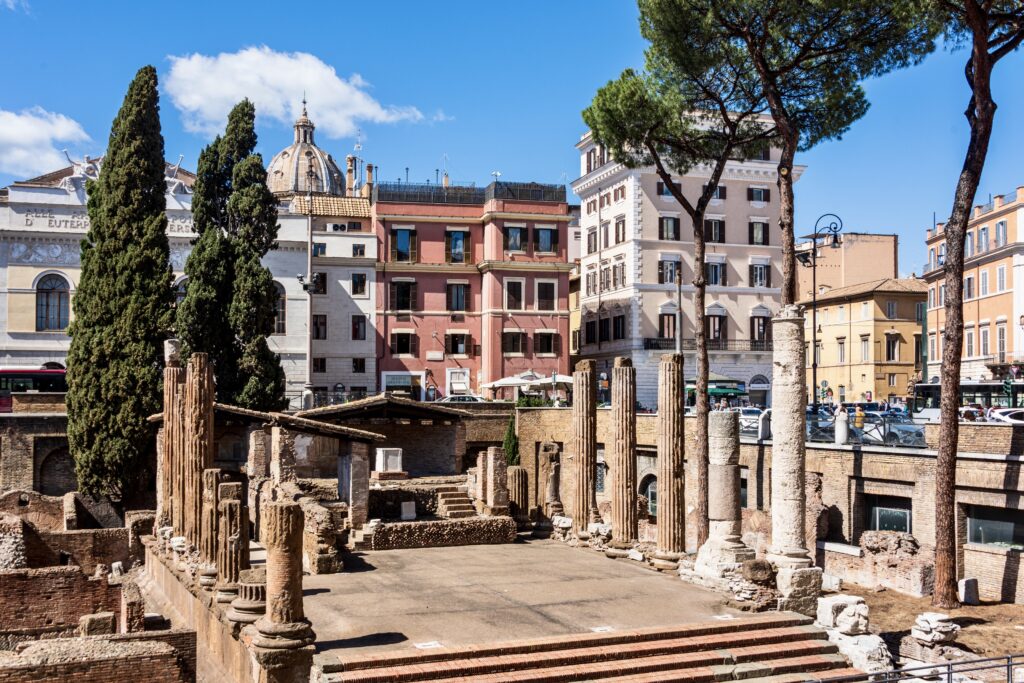
31. Largo di Torre Argentina
Largo di Torre Argentina is an archaeological site in the heart of Rome just minutes from Piazza Navona . Excavations have revealed the remains of four Republican-era Roman temples and part of the ancient Theatre of Pompey.
This is ancient stuff, dating from the 3rd century B.C. For history buffs, this is also the place where Julius Caesar was (most likely) assassinated in 44 BC.
Apart from its historical importance, Largo di Torre Argentina is also known for its association with cats. The square has become a sanctuary for stray cats. There is a designated area called the “Roman Cat Sanctuary.”
In the past, visitor could only gaze at the ruins from an observation platform at street level. But the ruins just opened to the public for the first time in June 2023. Now, you can go below and stroll along new walkways.
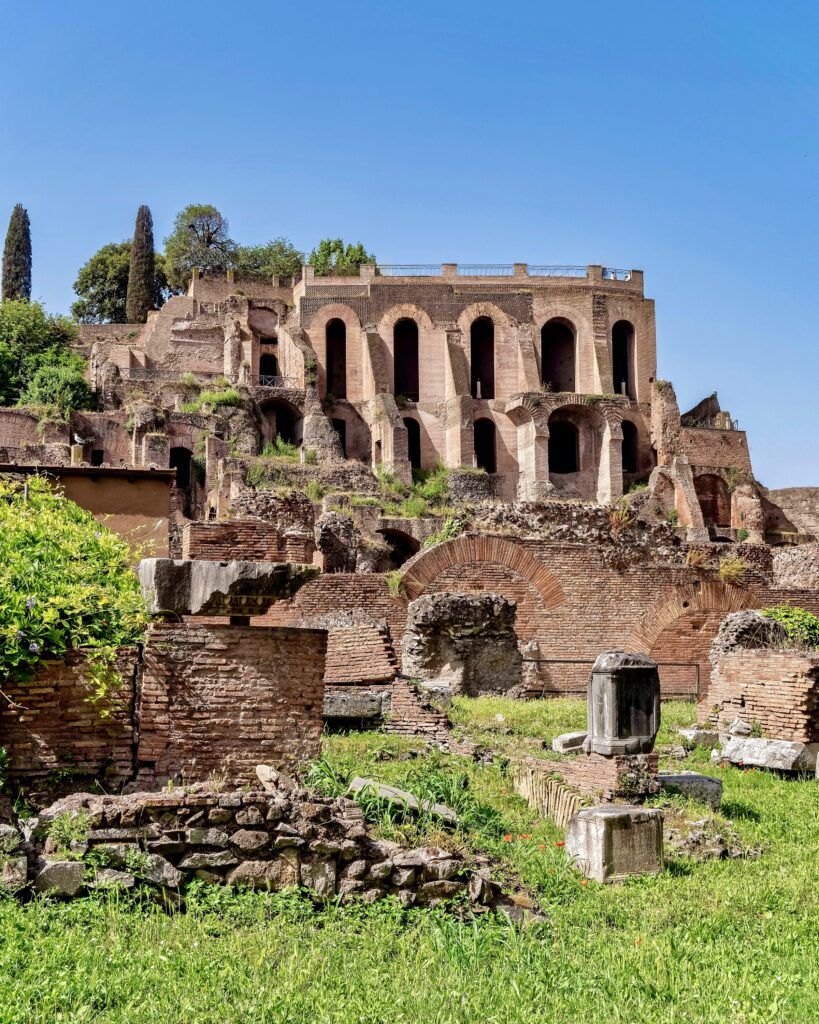
32. Domus Tiberiana
Another Roman ruin on Palatine Hill is Domus Tiberiana. It was the first official imperial palace in Rome.
The palace was built during the reign of the Roman Emperor Tiberius (14-37 AD). Tiberius used as a residence before he became emperor. And it became the designated abode of the designated heir to the empire.
Until recently, it had barely been excavated as it was overlaid by the Farnese Gardens in the 16th century. In September 2023, it will reopen to the public after more than 40 years of restoration.
I hope you’ve enjoyed my guide to the must visit ancient Roman ruins of Rome. You may enjoy these other Rome travel guides:
- 8 ways to spend 1 day in Rome
- 3 day itinerary for Rome
- 5 day itinerary for Rome
- 1 day itinerary for Vatican City
- Hidden gems in Rome
- Best museums in Rome
- Guide to the Borghese Gallery
- Guide to Palatine Hill
- Guide to the Roman Forum
- Guide to the Colosseum
- Walking tour of central Rome
If you’d like to visit must see ruins and historic landmarks in Rome, pin it for later.
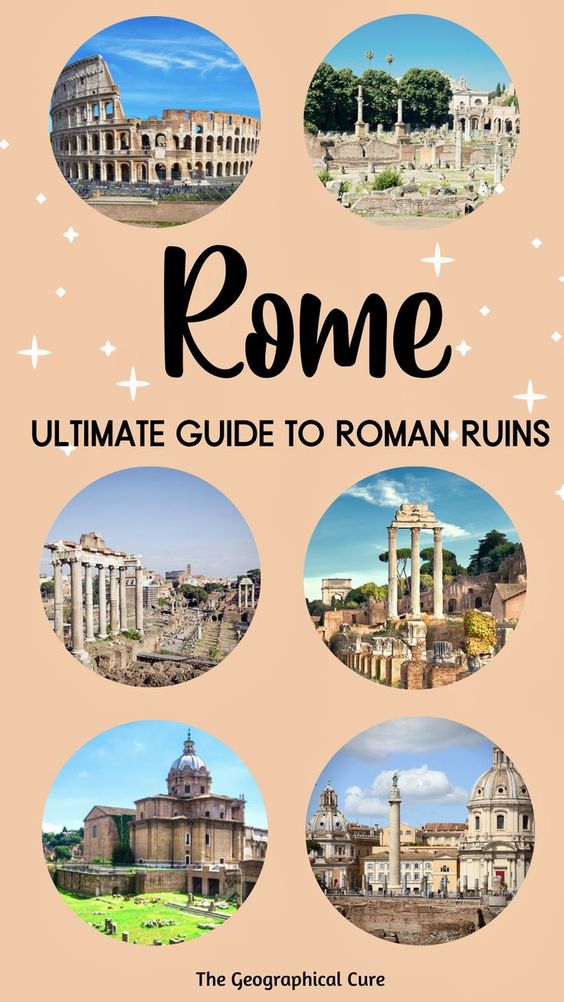
Leave a Comment Cancel reply
Save my name, email, and website in this browser for the next time I comment.
Last Updated on August 22, 2023 by Leslie Livingston

16 Ancient Rome Sites & Roman Landmarks to See in Rome, Italy (+Map)
By Author Jurga
Posted on Last updated: September 28, 2023

Ancient Rome – the civilization dating from the founding of the city of Rome in 753 BC until the collapse of the Roman Empire in the 5th century AD – has had a big influence on the world. It has inspired and influenced so many generations and continues to do so today…
No matter how many books you read and how many movies you saw, there is no better way to get acquainted with this fascinating culture than by visiting some of the ancient Roman landmarks in Rome, Italy!
In this guide, you can learn about the best Ancient Rome sites that you can still see in Rome today . Some of them – such as the Pantheon or the Colosseum – are world-known and are among the most popular places to see in Rome . Quite a few other remaining Roman landmarks are lesser-known and could be qualified as the hidden gems of Rome , often overlooked by tourists… But they are all worth seeing!
Whether you are fascinated by the Ancient Rome civilization, are interested in antique Roman architecture, or simply want to see some of the most impressive Roman landmarks and learn the stories behind them, this list will give you a good idea of the places that are worth visiting the most.
To help you plan your time, we also created a map indicating the best Ancient Rome landmarks in Rome . You can find this map at the bottom of the article.
Even if you just visit a few of these landmarks, you’ll appreciate so much better how special and unique Rome really is. It’s not for nothing that it’s called the Eternal City.
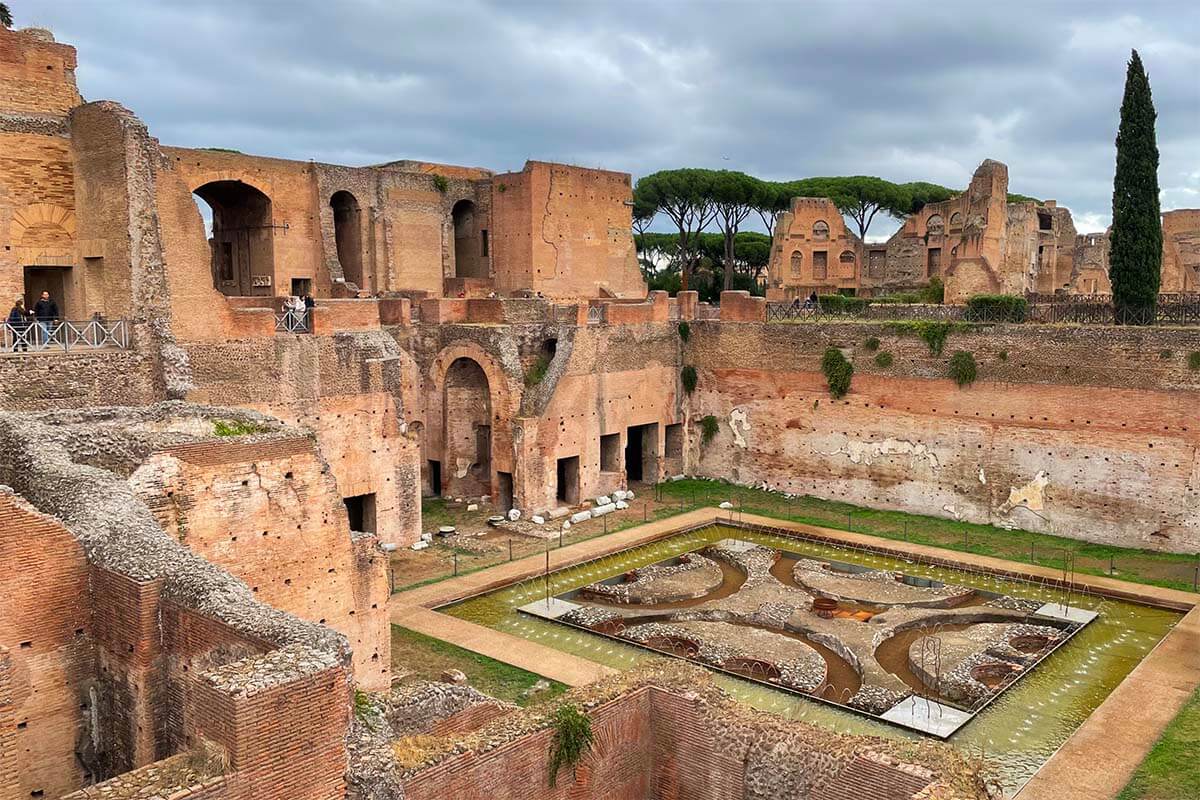
Good to know: Please note that in this guide we only mention some of the best-preserved and most important Ancient Rome landmarks that are located in or just near the city of Rome.
We also tried to sort this list by age, starting with the oldest Roman landmarks first. However, it’s not always possible to determine the exact dates. Furthermore, some archeological sites contain more than just one building (each dating from different periods), and others were built and rebuilt or their development spanned over several centuries…
So the timeline is only meant to give you an idea of how Ancient Rome developed over the centuries. It should give you a better insight into how old and unique these antique Roman sites really are…
Take a look!
Here are some of the best ancient Roman landmarks you can see in Rome today:
1. Palatine Hill & Roman Forum
The origins date from around the 10th century BC. Some of the oldest Roman temples (7-8th century BC) were located in this area as well.
The Roman Forum (Forum Romanum) and the Palatine Hill (Palatino) are among the oldest places in the city of Rome. It’s in this area that you’ll find most of the ancient Roman landmarks; too many to even try to list them here…
It’s believed that the founders of Rome – Remus and Romulus – were nursed by a she-wolf in a cave – Lupercal – that was located on the slopes of the Palatine. In 2007, this theory was once again confirmed when the archeologists found a vaulted sanctuary deep under the ground that could indeed be the Lupercal.
So if you are looking for the most ancient sites in Rome, this is as good as it gets. The Palatine is literally the birthplace of Rome !
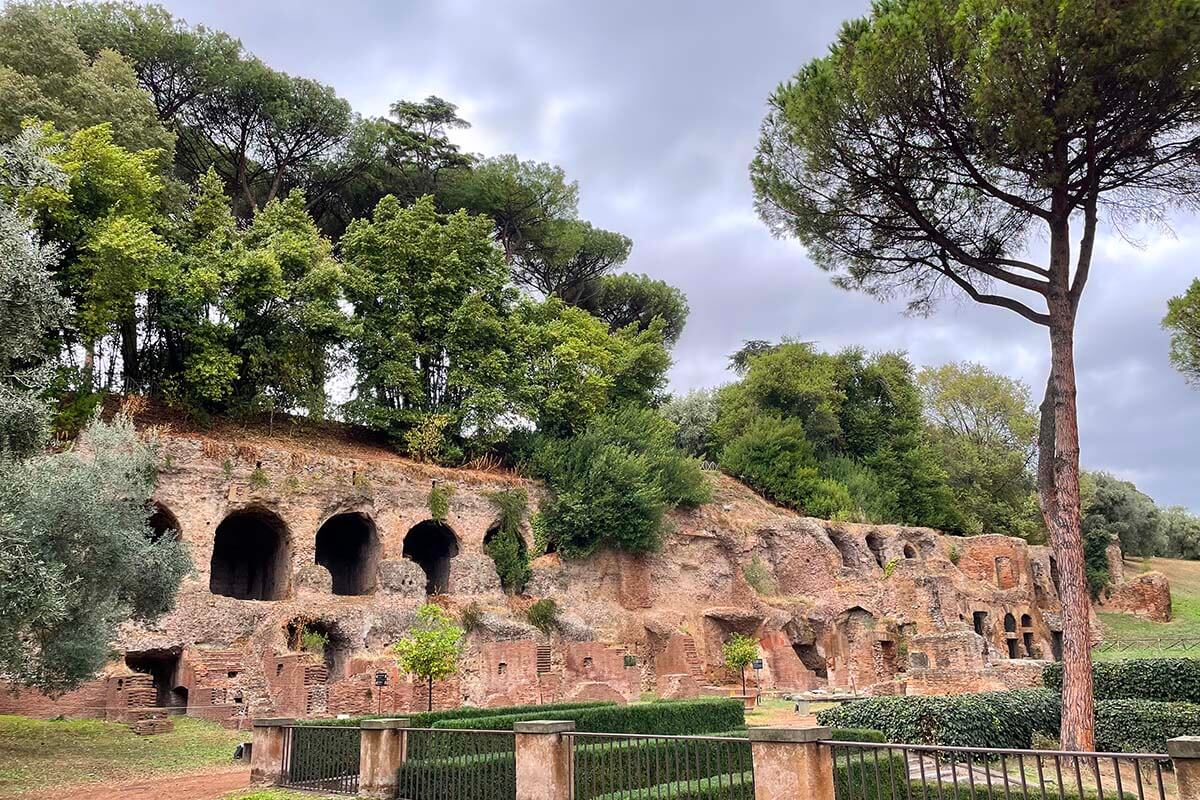
In Ancient Rome, the Palatine was one of the most desirable neighborhoods in the city. The rich and the famous built their palaces here and you can still see some very impressive ruins on the Palatine.
Right next to it is the Roman Forum, the bustling heart of ancient Rome. Today, this is a huge archeological site where you can see many of the oldest buildings and monuments of Rome.
How to visit: The Roman Forum and the Palatine are located right next to the Colosseum and an entrance to all these sites is included in the same ticket . You can just walk around on your own, but I highly recommend visiting here with a guided tour . There’s so much to see and it’s a fascinating site, but without knowing what you’re looking at, it’s just a bunch of ruins and stones…
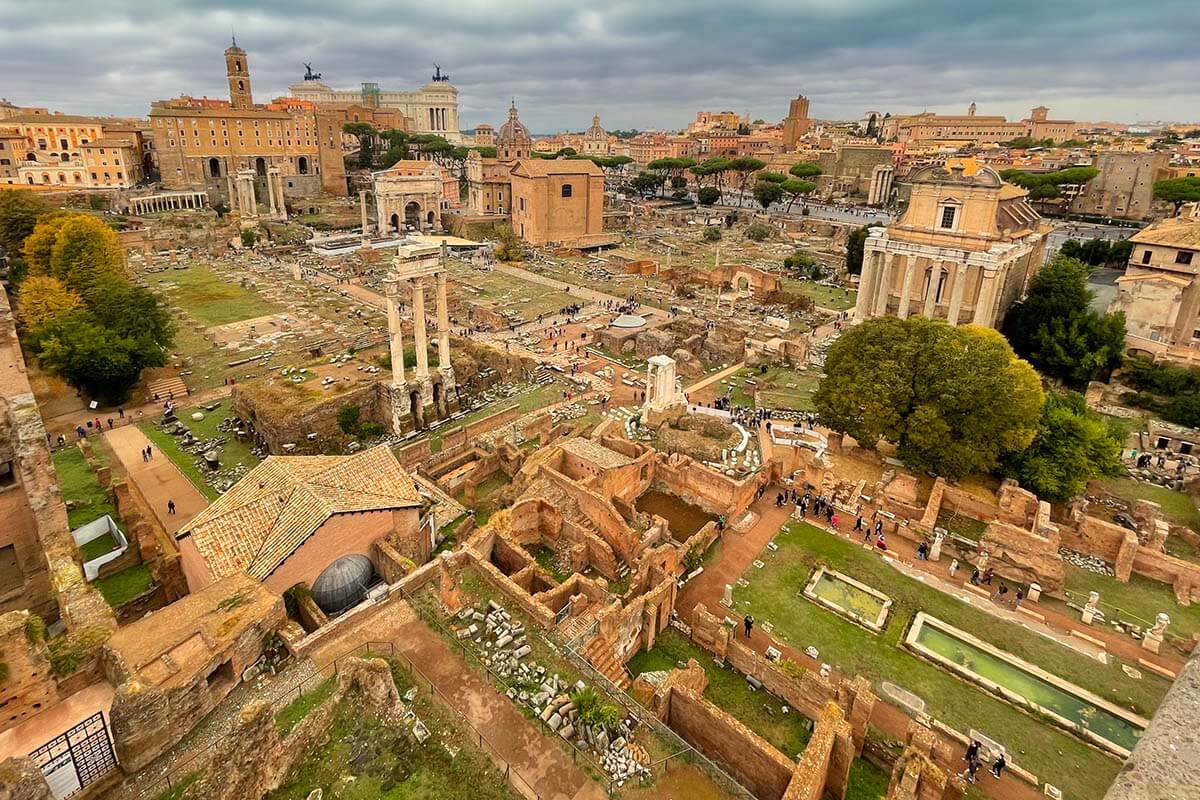
2. Ostia Antica
The origins date from the 7th century BC.
Ostia Antica was an old city, the commercial and military seaport of ancient Rome. The archeological remains found here date to the 3rd- 4th century BC, but some inscriptions are believed to be three centuries older than that.
This is one of the best-preserved ancient Roman cities and a great place to visit if you want to get a better idea of what life was like for ordinary folks in the old Roman times.
In its glory days (2-3rd century AD), over 100,000 people lived in Ostia. After the fall of the Western Roman Empire, the city slowly fell into decay. It was completely abandoned in the 9th century.
Big parts of the old city of Ostia are excavated and you can see the remains of old houses, shops, baths, but also docks and warehouses. One of the most impressive sites is the old Roman theater – Teatro di Ostia.
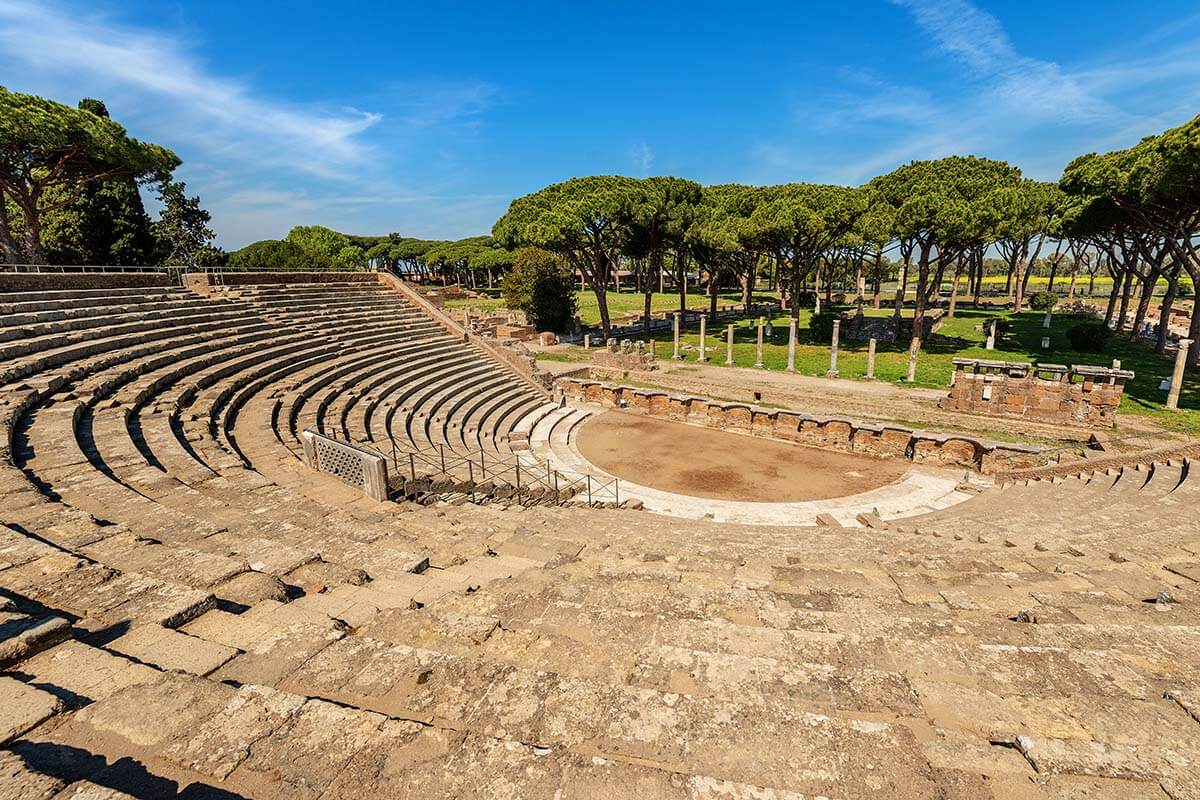
Ostia Antica is often compared to the more famous ancient Roman cities of Pompeii and Herculaneum.
However, these places are located close to Naples, a 2.5-3 hours drive from Rome (they can be visited as a day trip too , but you will need an entire day for that). Whereas Ostia Antica is just 45 minutes drive from the city center. In fact, it’s located very close to Leonardo da Vinci International Airport in Fiumicino.
How to visit: Ostia Antica is the only Roman landmark mentioned in this guide that is located quite a bit further from Rome’s city center. You can get here by taxi or by train, and there are also organized tours. The most popular option is this half-day guided tour by train .
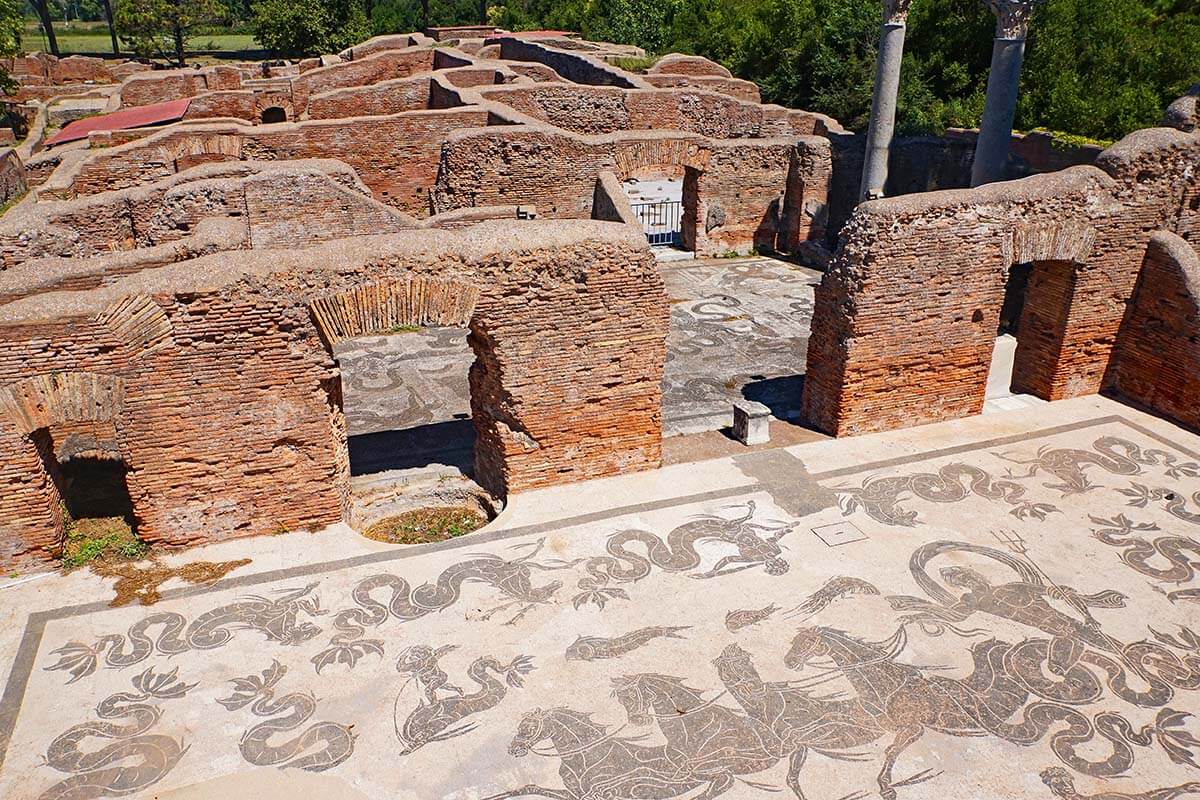
3. Circus Maximus
The origins of Circus Maximus date to Rome’s earliest days. The construction began around the 6th century BC.
Circus Maximus (Circo Massimo) was the largest stadium in Ancient Rome, mainly used for chariot races. It also served as the site of Roman Games, gladiator fights, animal hunts, etc.
Its current distinctive U-shape dates from the times of Julius Caesar who ordered the refurbishing of this arena at around 50 BC. At that time, the stadium could seat about 150,000 spectators.
After the Great Fire of Rome in 64 AD, Circus Maximus was rebuilt and reached its maximum capacity with place for about 250,000 people.
The last chariot races here were held in the 6th century, after which the ancient arena was pretty much abandoned. The area was cleared and turned into a park in the early 20th century and is nowadays sometimes used for concerts and other big outdoor gatherings. A small part of the ancient site is being excavated, but the majority remains under the ground.
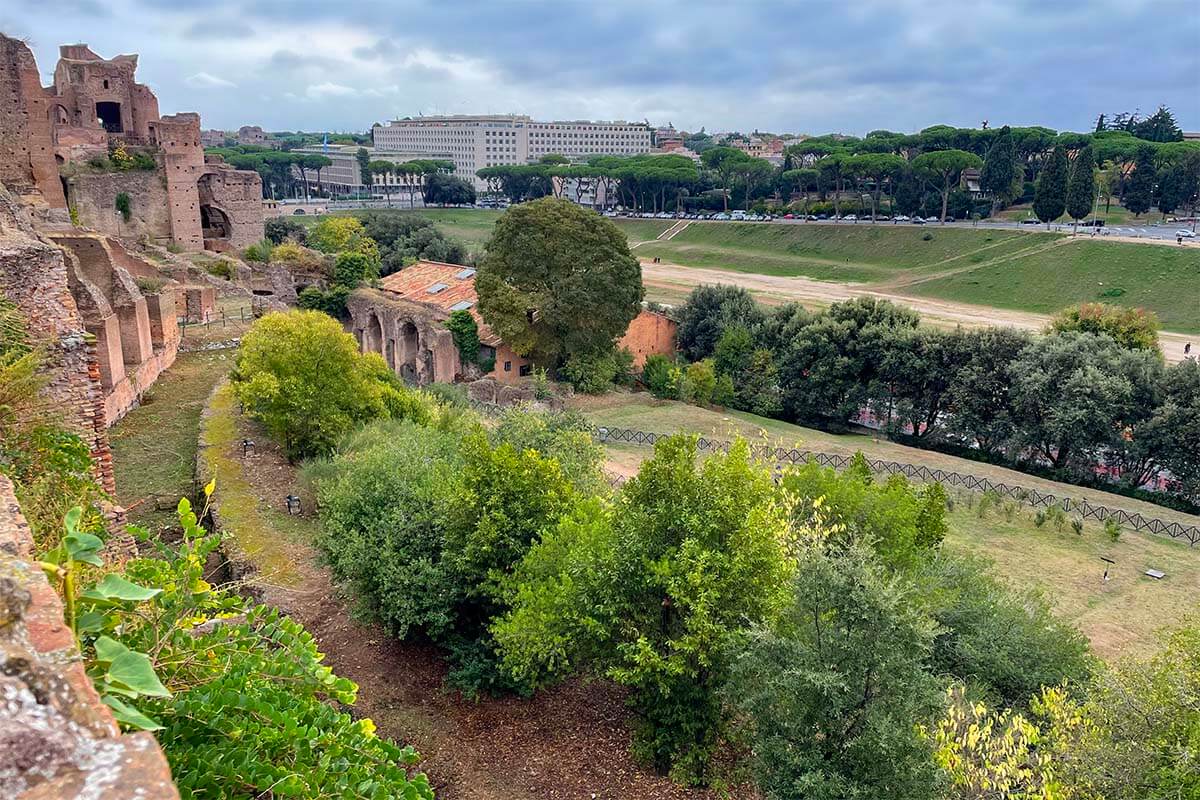
How to visit: Apart from the big open oval space in the middle of the city, there is actually not that much left of the ancient Circus Maximus nowadays. You can see it from an elevated angle from Palatine Hill, and you can also go for a walk here. Some tours also come here. It’s a good way to learn more about the place and the guides usually have pictures showing you what the place looked like, etc.
There may not be much left of it, but as you stand here, it’s easy to imagine a crowd of a quarter of a million people cheering at the chariot races: the noise, the dust, the excitement… It’s well worth seeing Circus Maximus, even if just from a distance. It’s yet another puzzle piece that gives you a better idea of what life was like in Ancient Rome.
TIP: If you are interested in a tour, we recommend this one that visits Circus Maximus and also the Baths of Caracalla (a very interesting ancient Roman site that you can read about further below).
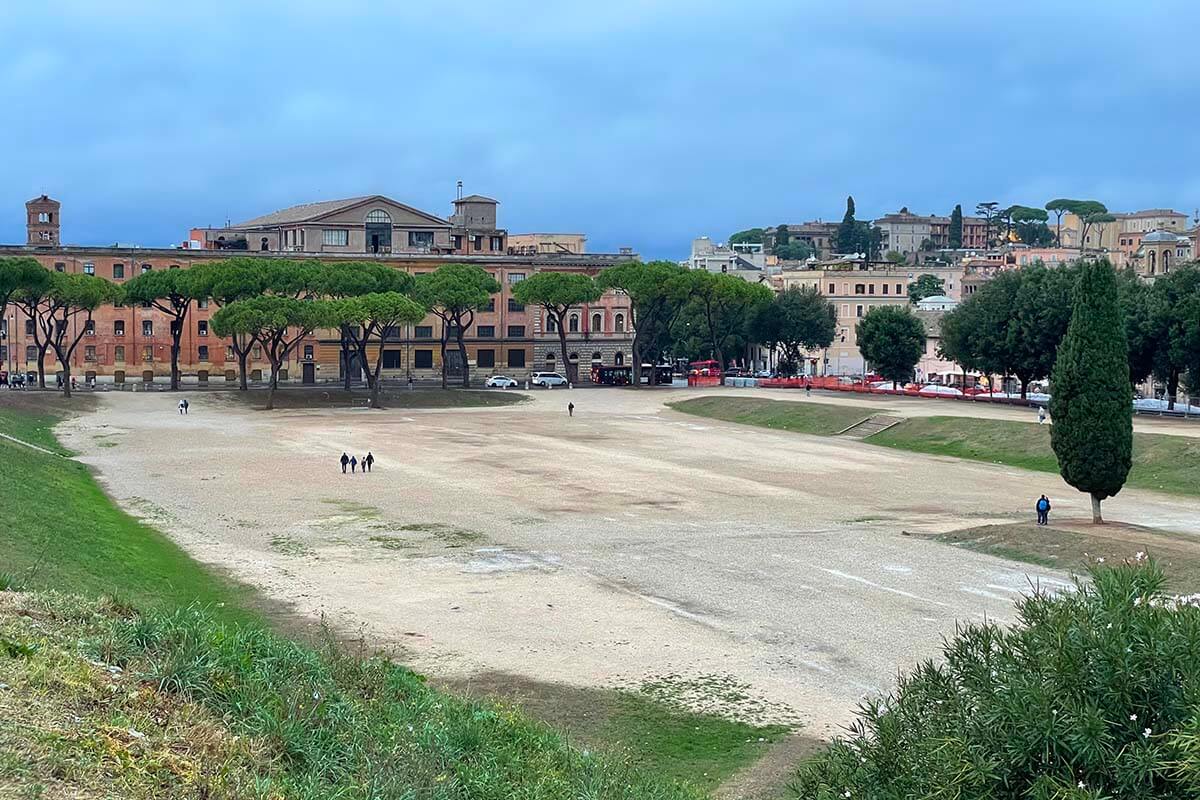
4. Appian Way
Built around 312-264 BC.
Appian Way (Via Appia Antica) is an ancient road that connected the city of Rome to Brindisi in Southern Italy, some 563 km (350 miles) away. Its main purpose was to help the army with the expansion of the Roman Empire.
To me, the Appian way feels the most authentic of all Ancient Rome sites that you can still see today. Built over 2300 years ago, some parts of this road look pretty much as they would have looked back in the old days. There are hardly any signs of modern-day life here, and if you’re lucky to visit on a quiet moment or go just a bit further from the city, you’ll likely be completely alone… It’s magical!
Appian Way is lined with ancient family graves and mausoleums, some of them still standing next to the road today (in the past, it was forbidden to bury people inside the city walls, and it was easy to have a family grave next to a major, easily-accessible way just outside the city).
As you walk or bike on Via Appia, you can easily imagine the Roman military marching here, horses and carriages driving up and down, and families visiting the graves of loved ones… If you’ve seen movies like Spartacus , vivid images of Ancient Rome come to life. It’s a really special place, and if you have a few hours extra, I highly recommend visiting here!
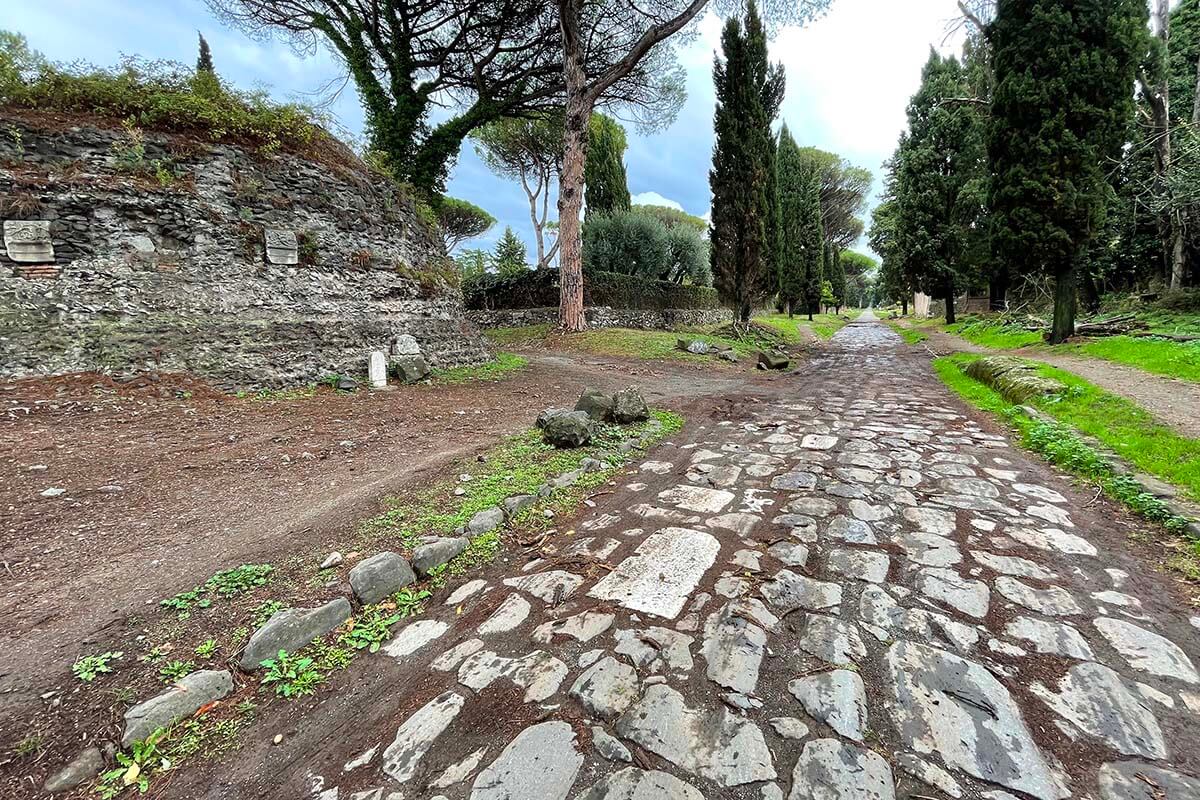
How to visit: The Appian Way is a long road that starts in Rome. The first part closest to the city has changed a lot and looks just pretty much like any other street. And while you don’t have to go very far to find some more authentic parts of this ancient way, it’s not really a place you can easily walk to. It’s best to come here by bus, on a tour, or by bike.
TIP: I highly recommend joining an e-bike tour . Not only is this the best way to get here and explore a bigger section of this unique road, but you’ll also see so much more! It’s also good to visit here with a local guide who knows exactly where to go and will bring you to the most authentic sights.
We visited the Appian Way with this great bike tour that also includes quite a few other ancient Roman landmarks mentioned further in this guide. Highly recommended!
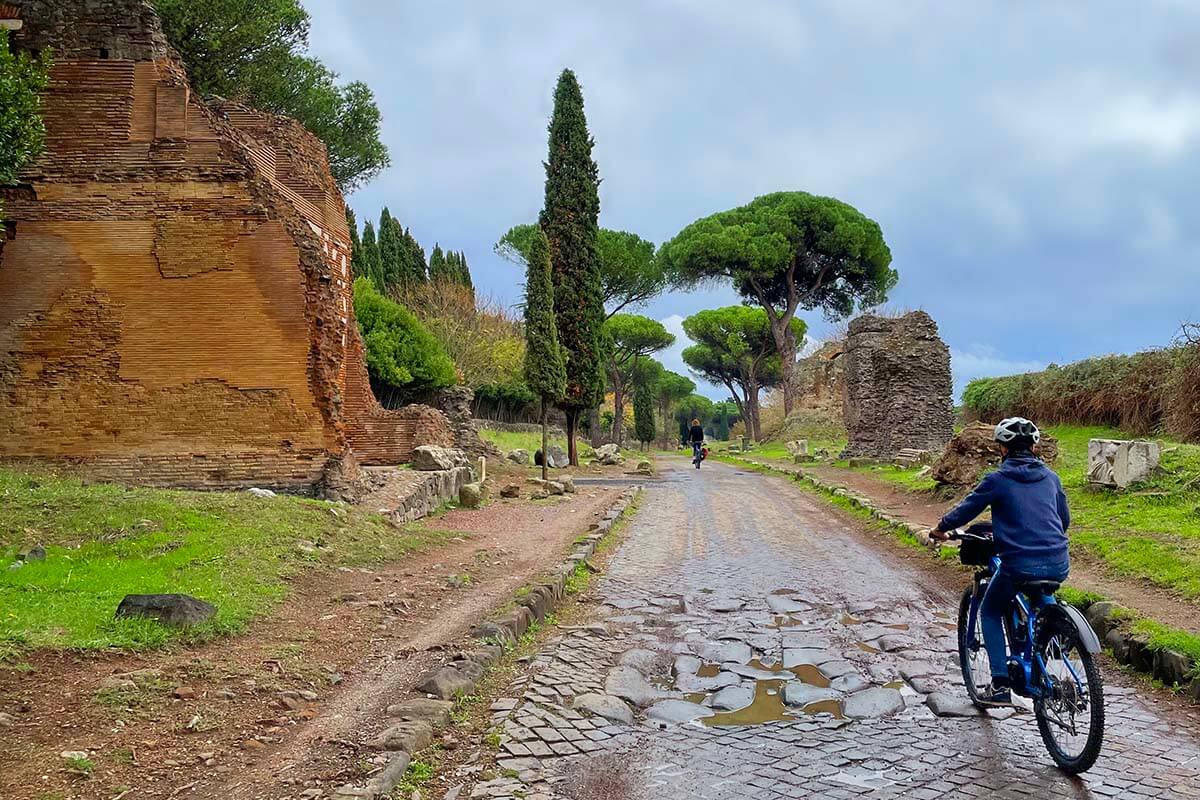
5. Park of the Aqueducts
Most Roman aqueducts date from the period between the 3rd century BC and 1st century AD. The oldest Roman aqueduct – Aqua Appia – was constructed around 312 BC, at around the same time as the Appian Way.
If you want to see more of the most authentic ancient Roman sights and get a bit more off the beaten path in Rome, definitely consider a visit to the Park of the Aqueducts (Parco degli Acquedotti) . This is antique Rome at its best, and without the crowds. In fact, you’ll likely have the park all to yourselves…
Here, you can see several ancient aqueducts dating from the glory days of the Roman Empire. Reliable water supply was of utmost importance for the quickly-growing cities, and a series of aqueducts were built in order to bring drinking water from the mountains into the city of Rome.
Parts of these ancient aqueducts survived to the present day, and you can admire some really fine examples of ancient engineering. Some aqueducts were tens of kilometers in length, and they were built with such a small gradient that was just enough to get the water flowing towards the city at a steady pace. It would be quite an achievement even nowadays…
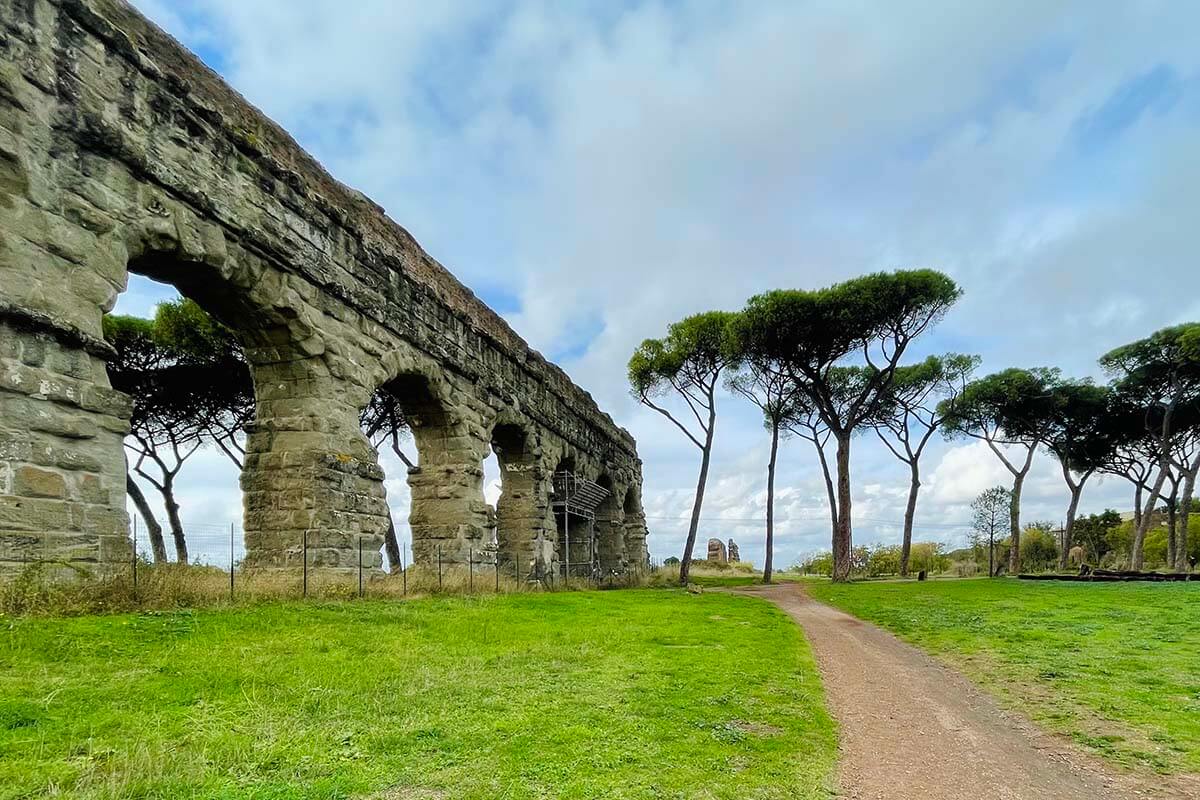
How to visit: Park of the Aqueducts is located on the outskirts of Rome, about 10 km from the city center. There’s a metro line running just nearby, so you could get here by public transport quite easily. However, it’s a massive park and so if you come on foot, you’ll need at least half a day to explore it. The best way to visit Parco degli Acquedotti is by bike.
We came here on the earlier-mentioned e-bike tour that also took us to Via Appia and ancient catacombs (see further below). It’s really one of the best ways to explore several of the best ancient landmarks in Rome in a short time!
TIP: One of these 2000-year-old aqueducts still supplies water to the famous Trevi Fountain today. If you don’t have the time to visit the Aqueducts Park, you could also opt to visit Vicus Caprarius (aka Trevi Underground) in the city center. Here, you can see one of the ancient aqueducts under the ground.
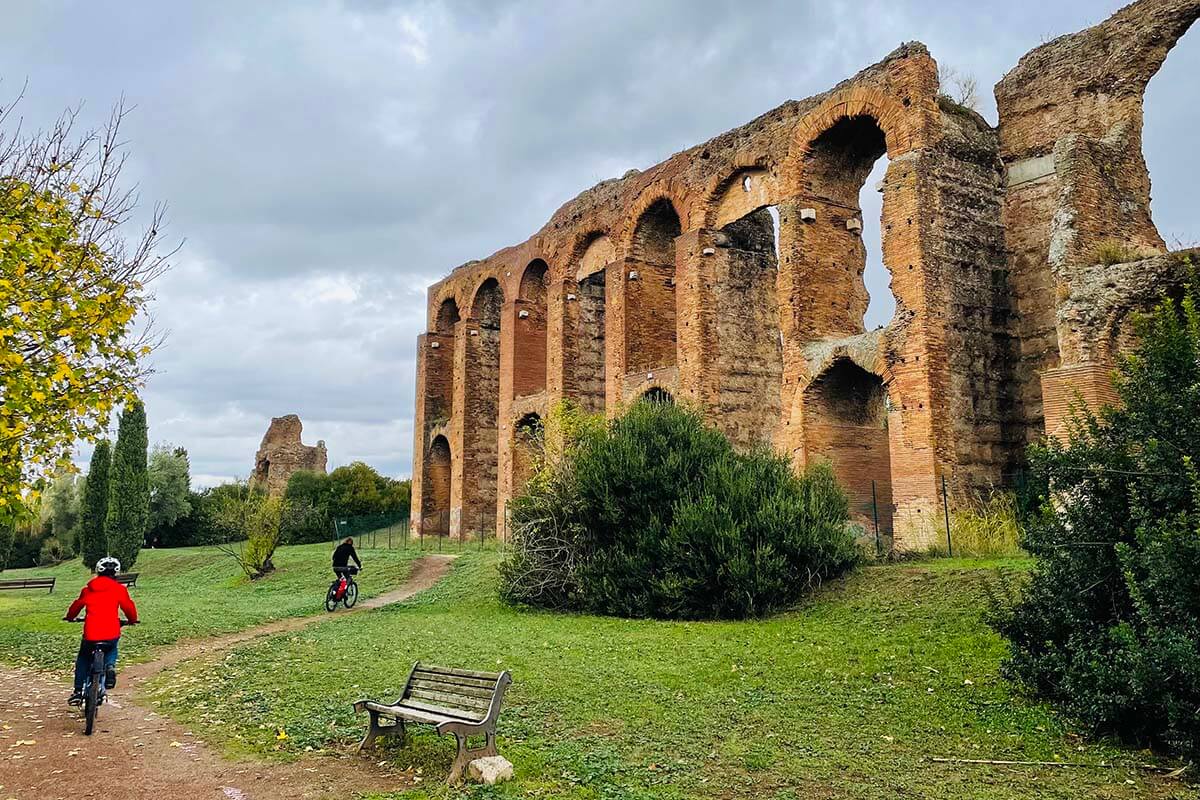
6. Largo di Torre Argentina
The ancient temples here date from the 2nd – 4th centuries BC.
Largo di Torre Argentina is a town square in the historic center of Rome. Some of the city’s most ancient temples are located here, and this was also the site of Rome’s 1st theater, the Theater of Pompey (55 BC).
The square is best known as the place where Julius Caesar was murdered by the members of the Roman Senate on the Ides of March (15 March) in 44 BC.
Most of the ancient buildings here are just ruins, but some of the remains of the temples can still be distinguished among the rest. The oldest temples are believed to date from the 4-3rd centuries BC, the others are from the 2nd century BC. They all date from pre-Christian times, but one of them was later rebuilt as a church.
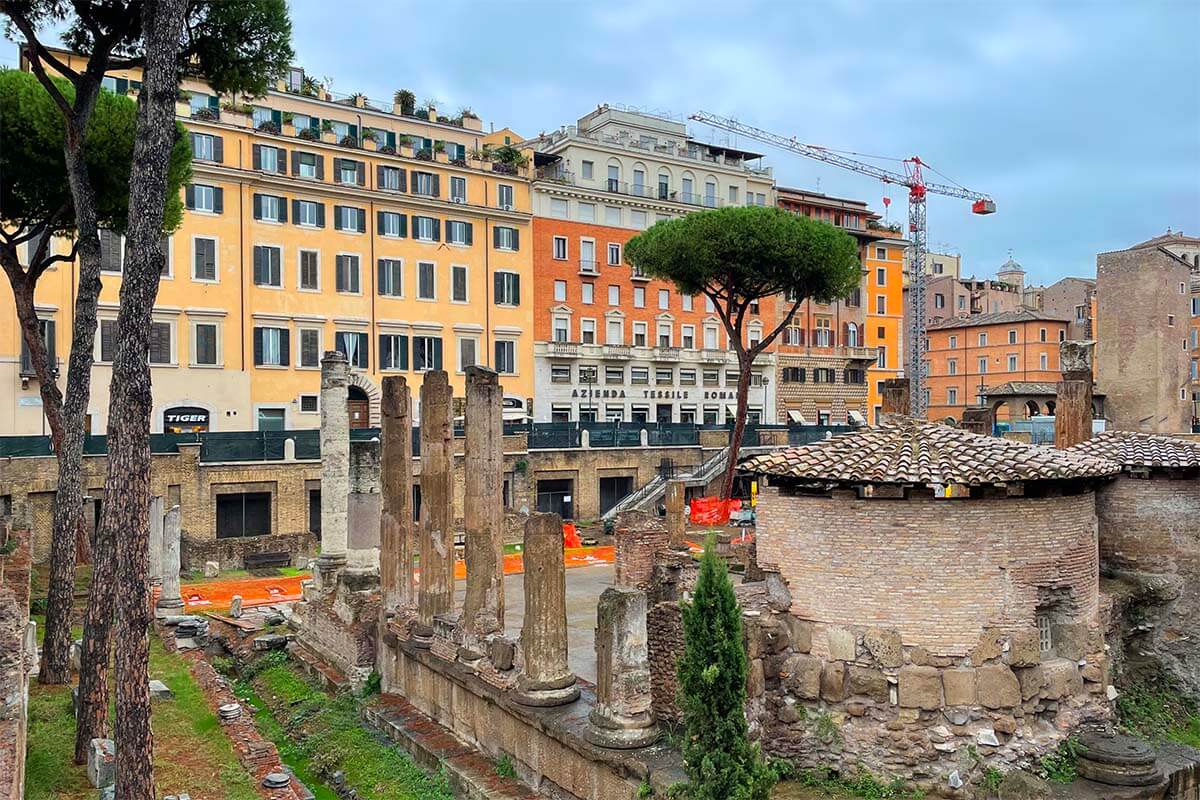
How to visit: Largo di Torre Argentina is a public square, just a few minutes walk from the Pantheon and other main sights in the city center. The archeological site has recently been made accessible to the public via a small walkway with several panels where you can learn about the history of this place. It’s free of charge and wheelchair-accessible.
You can also just walk all the way around the archeological site and easily see all the ancient buildings from the street. Some people come here to learn more about the death of Julius Caesar, others – for the ruins, and yet others for the cute cats that inhabit the area.
TIP: This amazing food tour we did in Rome also brings you to Largo di Torre Argentina and the guide gives some explanation about the sites you see.
LEARN MORE: Rome Street Food Tour with a Local Guide
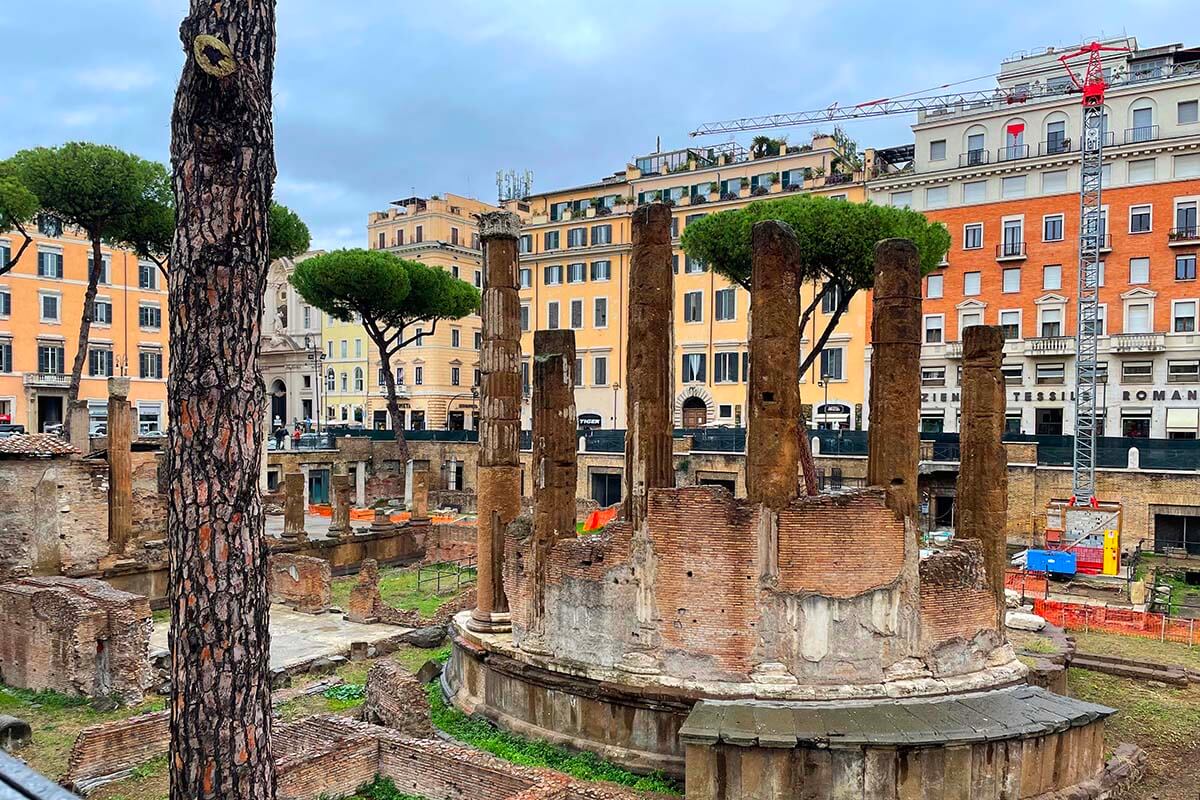
7. Pyramid of Caius Cestius
Built in 18-12 BC .
Looking somewhat out-of-place and totally different from anything else in Rome, the Pyramid of Cestius (Piramide di Caio Cestio) is one of the oldest and best-preserved landmarks in the city .
Just as the famous pyramids in Egypt, this one was also built as a mausoleum. Inside, is the tomb of Gaius Cestius, a wealthy Roman magistrate who died in 12 BC.
The pyramid of Cestius survived for over 20 centuries mainly because it was integrated into the city walls. You can still see one of the old city gates – Porta San Paolo (3rd century) – just next to the pyramid.

How to visit: You can see the pyramid from the outside at any time.
However, it is only open to the public a few days a month and if you want to visit inside, you’ll have to book it in advance. For more information, please consult the official website .
The chances that they are open just when you’re in Rome aren’t very high and it does require quite some planning, so this is one of those landmarks that you can best admire from the outside.

8. Theater of Marcellus
Built around 17-13 BC.
Marcello Theater (Teatro di Marcello) was the largest and most important theater in Ancient Rome, with space for almost 20,000 spectators. Its original construction looks a bit like the famous Colosseum, which was built almost 100 years later.
Built in the 1st century BC, this open-air theater remained in use until the early 4th century. Just like many old buildings in Rome, it was then looted and the stones were used for the construction of other buildings. What remained of it, was later used as a sort of an apartment building, and afterwards as a fortress.
Nowadays, the archeological site is a museum and it’s sometimes used for concerts as well. The upper part of the building still serves as residential apartments. Marcello Theater looks really impressive at night when it’s nicely lit.
In addition to the ancient theater, you can see lots of other ruins here as well that are yet several centuries older. The most notable is Portico of Octavia (2nd century BC) and also the Temples of Apollo Sosiano and Bellona (5th-1st centuries BC), plus Tempio di Giano (3rd century BC).

How to visit: You can see the theater of Marcellus from the street (the best view is from Via del Teatro di Marcello), but the archeological site can also be visited inside. It is normally open from morning to dusk and is free to visit.
There are informational panels and you can just walk through here when visiting the Jewish Ghetto or on your way from/to Circus Maximus or Bocca della Verità (Mouth of Truth).
TIP: Outside this archeological site, but also just near the theater, you’ll find several other lesser-known ancient Roman landmarks. This is the site of the cattle market Foro Boario (3rd century BC). Here, you can see the remains of two temples – Tempio di Portuno (2-3rd century BC) and Tempio di Ercole Vincitore (2nd century BC). If you’re in the area anyway, it’s worth checking them out as well.
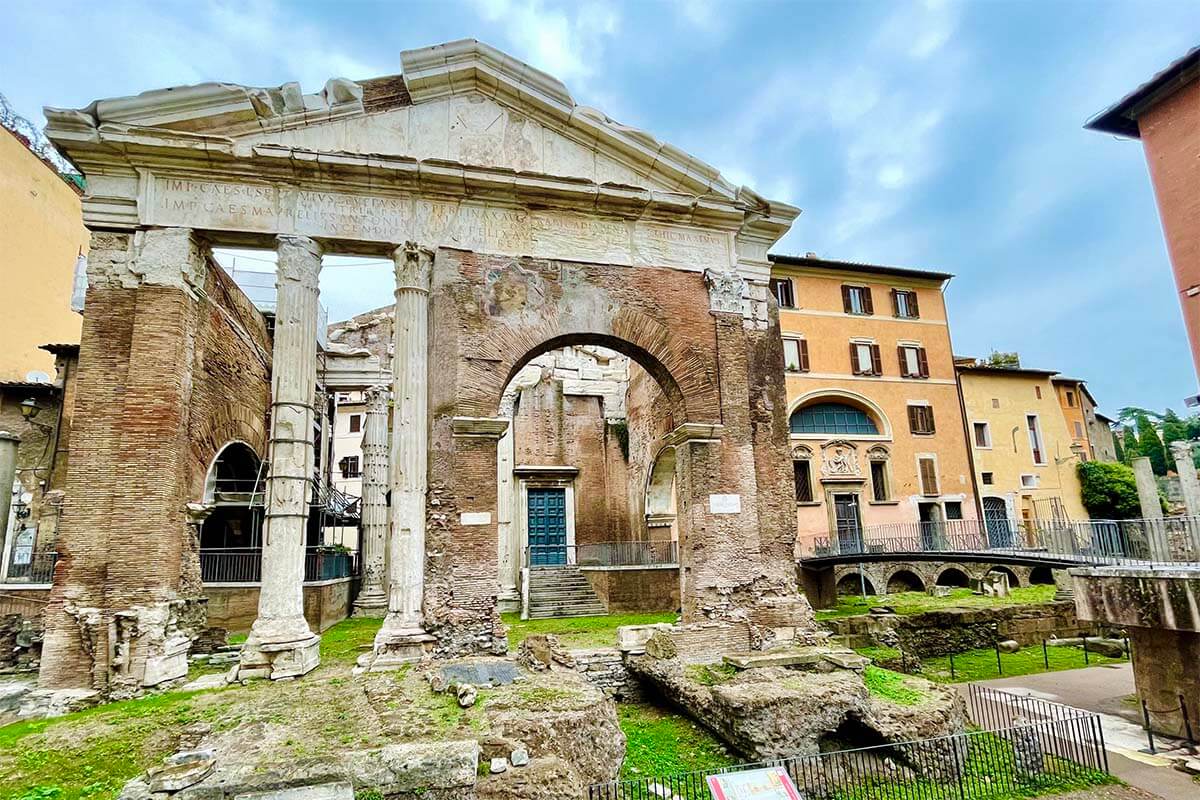
9. Domus Aurea
Built around 65-68 AD.
Domus Aurea , aka the Golden House of Nero , is another ancient landmark worth seeing in Rome. It’s located just a stone’s throw from the Colosseum that was built just a bit later.
After the Great Fire of Rome in 64 AD, Emperor Nero seized a huge centrally-located plot of land in order to build a lavish entertainment complex for himself and his guests. This started the rumors that he might have started the fire in the first place…
Domus Aurea was a lavish entertainment site with landscaped gardens, an artificial lake, fountains, pools, etc. The huge villa was richly decorated and had a rotating dining room with a golden dome with an oculus, a masterpiece of ancient engineering. The building materials included marble, gold, and mosaics made of precious stones and ivory, etc.
The Golden House represented the best of the Roman Empire’s art and engineering, but also the worst of its excesses. The project was hugely unpopular and after Nero’s death, a big part of the site was covered by ground. In fact, the Colosseum was built over the site of Nero’s artificial lake. The villa itself was still used by other emperors, but a few decades later it was also covered by ground and new bathhouses were built over it…
Covered by the earth, Domus Aurea remained very well preserved. It was rediscovered in the 15th century and became an inspiration to many Renaissance artists. However, the exposure to the elements has done a lot of damage, and because a large part of the site remains under what’s currently a park, it’s extremely difficult to preserve what’s left of it without causing a complete collapse.

How to visit: Domus Aurea is located at Colle Oppio Park; the entrance is on Via della Domus Aurea. You can visit a small part of the original site, partially underground.
The Golden Vault Room virtual reality experience gives a good idea of what this place must have looked like in the past. Here you can see the availability and book a guided tour.
TIP: If you have more time, we highly recommend opting for a guided tour that also includes the Virtual Reality experience !
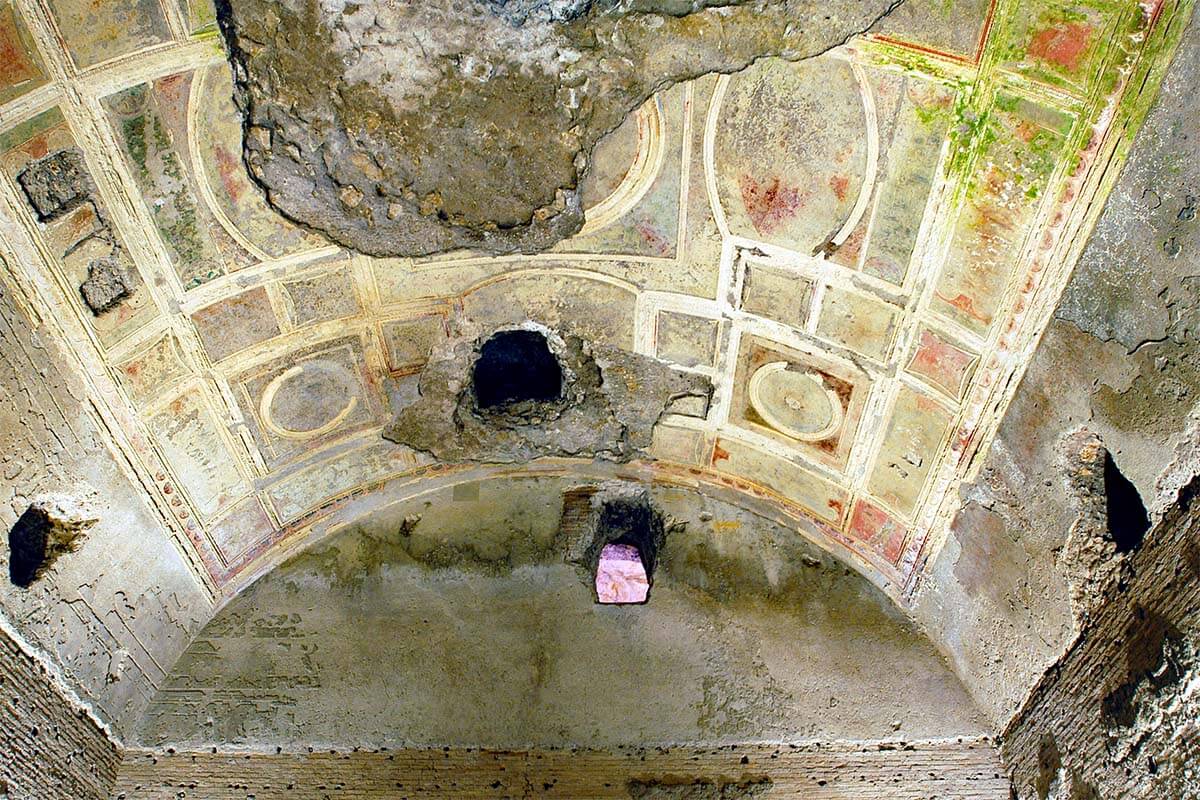
10. Colosseum
Built around 70-80 AD.
The Colosseum (Colosseo) is probably the most iconic and best-known of all Ancient Rome landmarks. Almost 2,000 years after it was built, it remains the symbol of the Roman Empire, but also of Rome as we know it today.
This was the largest and the most impressive ancient amphitheater. Despite being ruined by several earthquakes, plundering, and looting, the Colosseum still stands today. Built as an entertainment arena, it could seat some 50,000 – 80,000 spectators!
The main purpose of the Colosseum was to keep the regular people of Rome content by providing entertainment (remember the old Latin saying “panem et circenses” – bread and circuses). The amphitheater was used for public spectacles including gladiator fights, animal hunts, but also the recreation of sea battles and dramas based on ancient mythology.
A big part of this impressive building is quite well preserved and you can get a pretty good idea of what the original arena would have looked like. It’s really interesting to see all the different layers of the structure. So if you can, take the time to walk around it and explore deeper, – you’ll appreciate it so much more.
In addition to seeing the Colosseum from the outside, you really have to see the inside as well. Part of the arena floor has been restored and you can also take in the views from the upper levels.
It’s now also possible to visit the underground level which gives you a very unique insight into how the arena functioned. You can see where the wild animals were kept, where the gladiators waited for the fights, the mechanisms used to bring them upstairs, etc.
How to visit: You can see the Colosseum from the outside and walk all the way around it. But you’ll need a ticket in order to visit inside. This is one of the most popular Rome attractions in Rome and you really have to book your tickets or a guided tour in advance.
TIP: If you want to visit all the levels of the Colosseum including the underground, you’ll need to go with a guide. We opted for this tour which includes all the levels of the Colosseum, and also the earlier-mentioned Roman Forum and Palatine Hill, and I can highly recommend it.
LEARN MORE: Colosseum Levels & Best Ticket Options
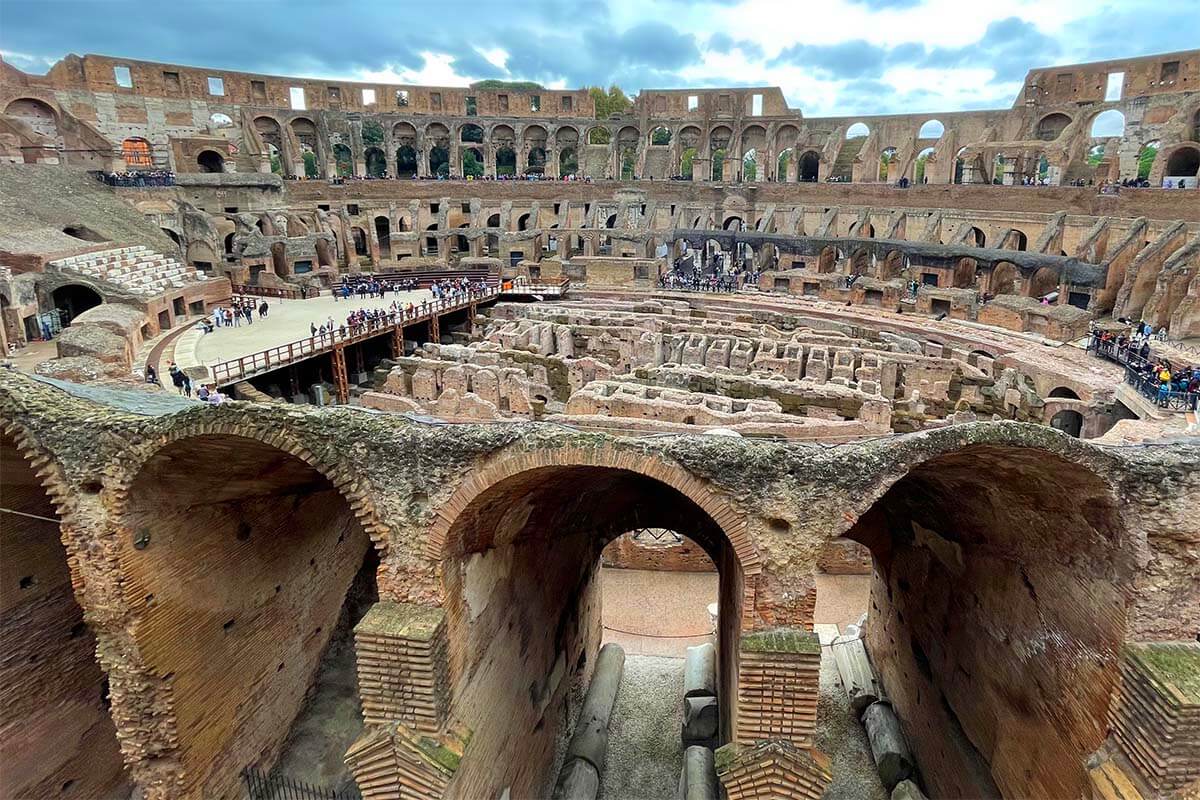
11. Trajan’s Market
Built around 100-110 AD.
Trajan’s Market (Mercati di Traiano) is a 2nd-century Roman market, often described as the oldest shopping mall in the world . It was part of a bigger complex – Trajan’s Forum – that was once the bustling center of the Roman Empire.
This architectural site is not only a fine example of ancient Roman architecture, but it also gives you a unique insight into the everyday life of the Roman people. It’s also a good place to see how the city has changed over the centuries.
The markets were mainly used in the 2-5th centuries. Later, new floor levels were added, a tower was built, and in the 16th century, there was a convent here… At the beginning of the 20th century, some of the recent additions have been demolished again, and an effort was made to restore Trajan’s Market and the surrounding area.
In 2007, the Museum of Imperial Fora was opened here, and you can now explore this unique site from close by. Walking on the original streets of ancient Rome – Via Biberatica and Via della Torre – is a really special experience. This is one of the places where you can truly feel the antique Rome around you. And despite its very central location, only very few tourists seem to find their way inside…
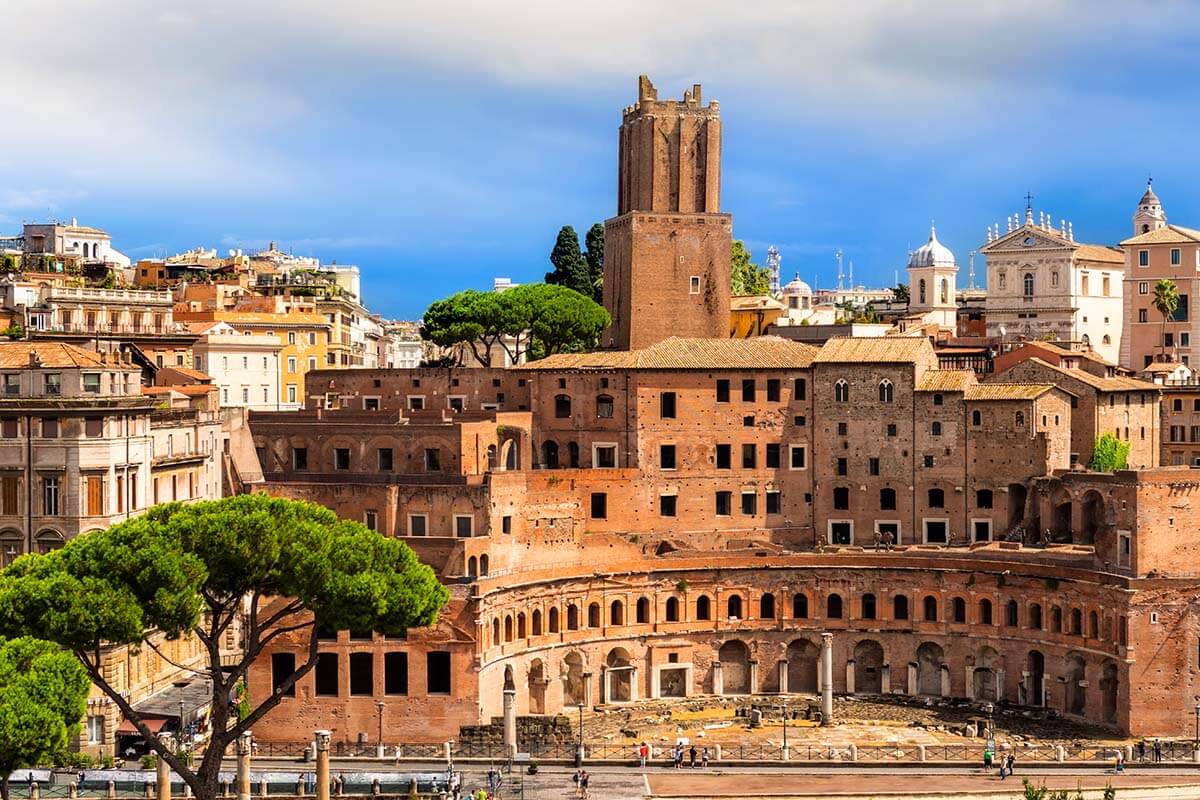
How to visit: You can see a big part of the Trajan’s Market archeological site from Via dei Fori Imperiali, the main street between Piazza Venezia and the Colosseum. However, if you want to learn more about it, walk on the ancient streets, and explore the most impressive parts, be sure to visit the Museum of the Imperial Fora in the Trajan’s Markets.
It’s open daily except for some public holidays. More info on the official website . The entrance here is included with this and several other city passes .
TIP: If you have more time to explore, get a ticket that includes a multimedia video . This video gives you a unique insight into what Trajan’s Markets looked like during the glory days of Imperial Rome.
In addition, as you walk on Via dei Fori Imperiali towards the Colosseum, you can see the ruins of the Forum of Augustus (2 BC) and too many other ancient ruins to even try to mention.
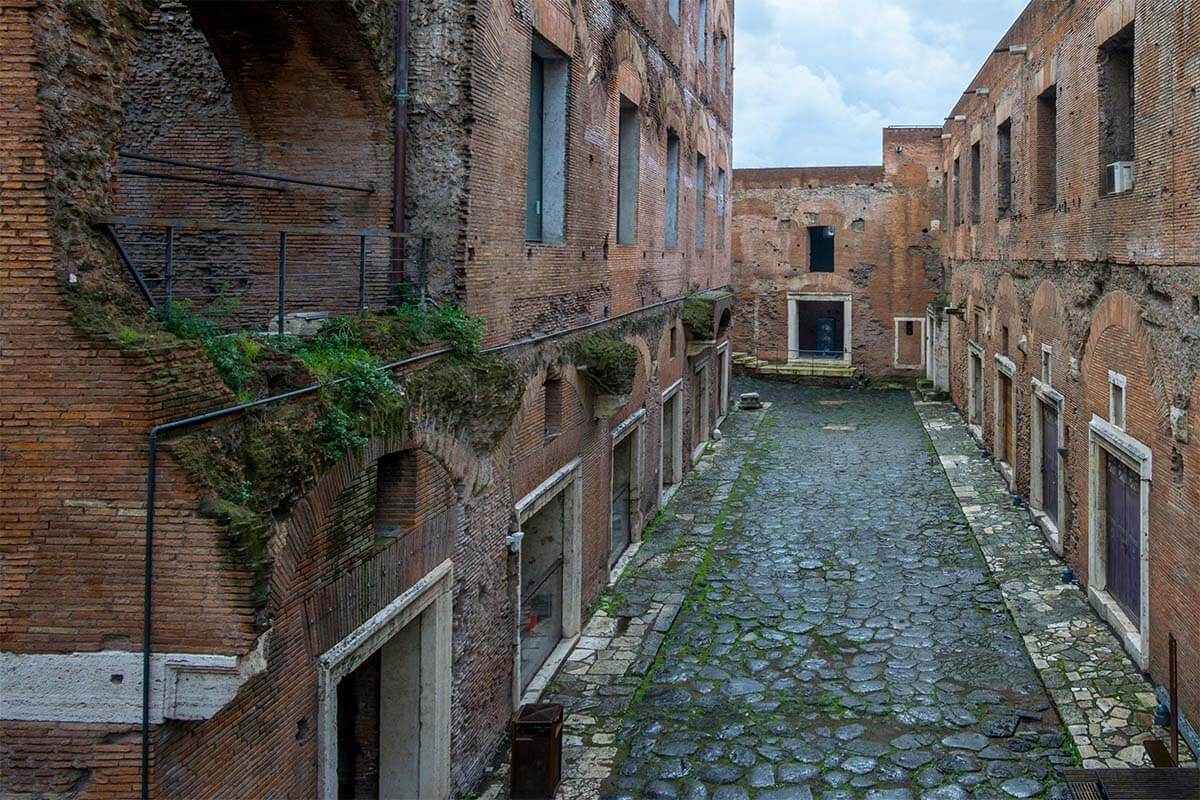
12. Pantheon
The origins go back to 27 BC, but the Pantheon as we know it today was built around 125-127 AD.
Built almost 2,000 years ago and still standing strong, the Pantheon is the best-preserved of all ancient monuments in Rome. In fact, the Pantheon is the oldest building in the world that is still in use today .
Dating from before Christianity, the Pantheon was originally built as a temple to all gods. However, it was later converted into a church (7th century). This saved the old temple from looters and plundering and helped preserve this unique monument through so many centuries.
The Pantheon has also served as the burial place for many artists and kings. Inside, you can see the tombs of Raphael, King Victor Emanuele II, King Umberto I, Queen Margherita of Savoy (after whom pizza Margherita was named), and several others.
World-known for its impressive oculus , the Pantheon has inspired many generations of architects and engineers, including Michelangelo who designed the dome of St. Peter’s Basilica in the Vatican. Michelangelo was so impressed by the unknown ancient architect and its genius dome structure that – out of respect – he made sure that his own construction was slightly smaller.
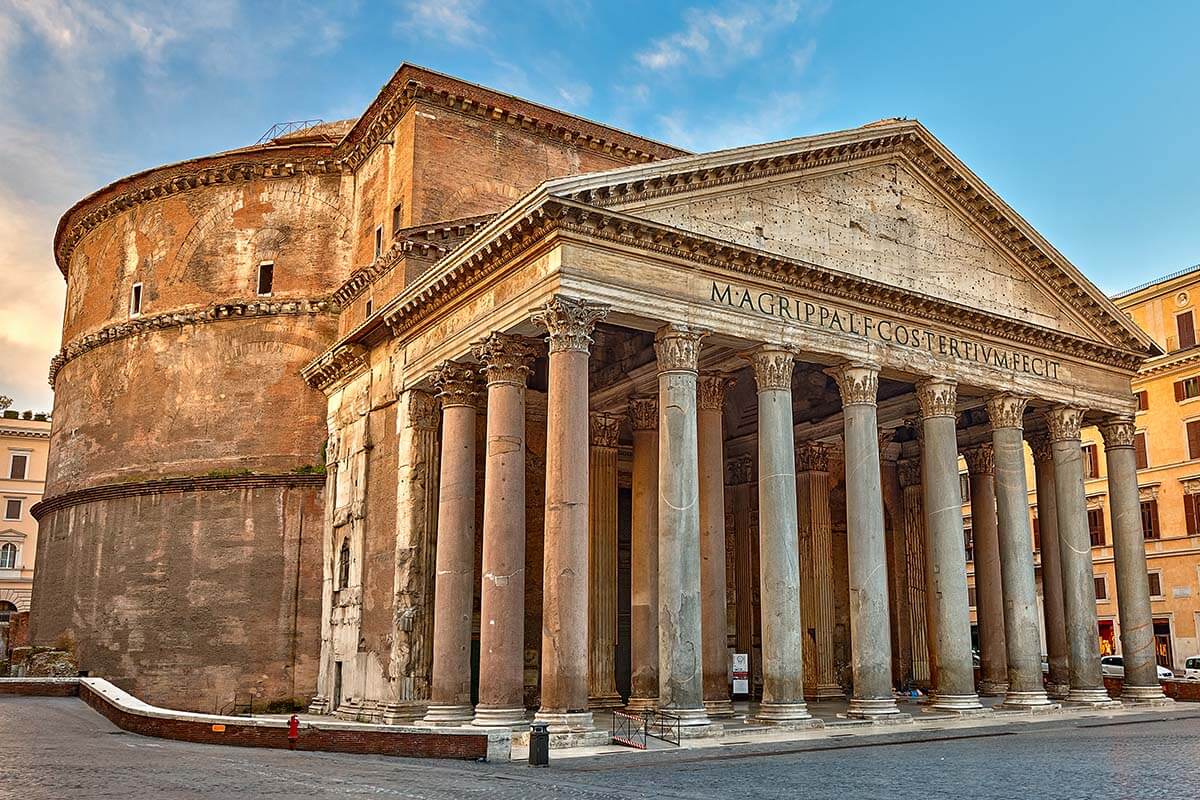
How to visit: The Pantheon is a working church, but it can only be visited for free during mass (and you won’t be able to walk around).
It’s open daily, and if you want to visit it as a tourist, you need to pay for a ticket. While you can ‘just’ queue at the entrance, we recommend getting a timed entry ticket in advance. The queues can be really long, there are multiple lines for cash and credit card payments, and it’s overall quite chaotic. Even with online reservation, you have to pick up an actual ticket at another location first (hopefully, they’ll change this in the future, but be sure to read the instructions!).
You can book the Pantheon tickets on the official website (which many of our readers find confusing), or on GetYourGuide or on Tiqets . GetYourGuide also offers free cancelation up to 24 hours before the visit. All online tickets include an audio guide.
TIP: If you want to learn more about this unique ancient landmark and visit without stress, you can also opt for a guided tour .
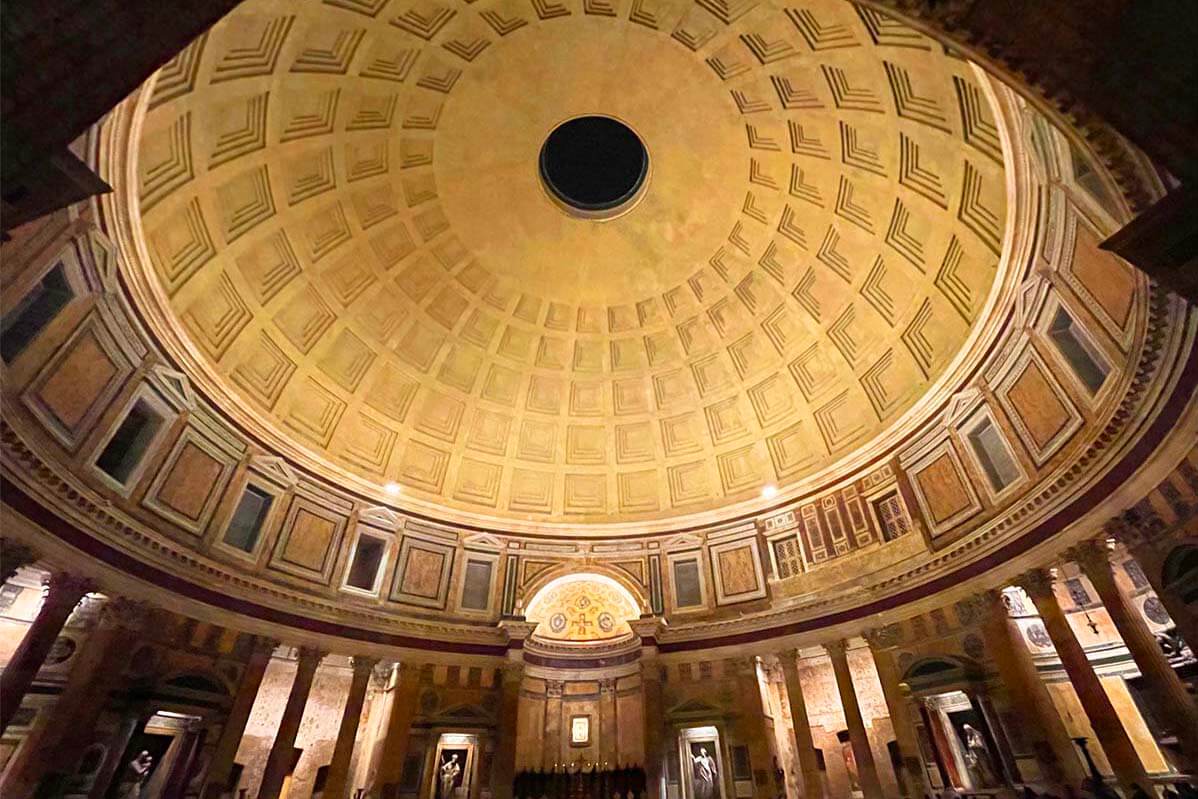
13. Castel Sant’Angelo
Built around 134-139 AD.
Castel Sant’Angelo (Mausoleum of Hadrian) is another ancient Roman landmark that you really can’t miss in Rome.
Once the tallest building in Rome, it might look a bit like a castle indeed, but it’s actually a tomb. This impressive mausoleum was built in the 2nd century for Emperor Hadrian and his family. The ashes of several other emperors were placed here as well, including Emperor Caracalla at the beginning of the 3rd century.
At the beginning of the 5th century, the mausoleum was looted and turned into a military fortress. In the 14th century, the building was turned into a castle and was subsequently used by various popes. A covered fortified corridor was built in order to connect Castel Sant’Angelo to the old St. Peter’s Basilica at the Vatican.
Nowadays, Castel Sant’Angelo serves as a museum. Inside, you can see some perfectly preserved frescoes from the Renaissance, visit the Chamber of Ashes where the emperors were incarcerated, and see the Papal Residence.
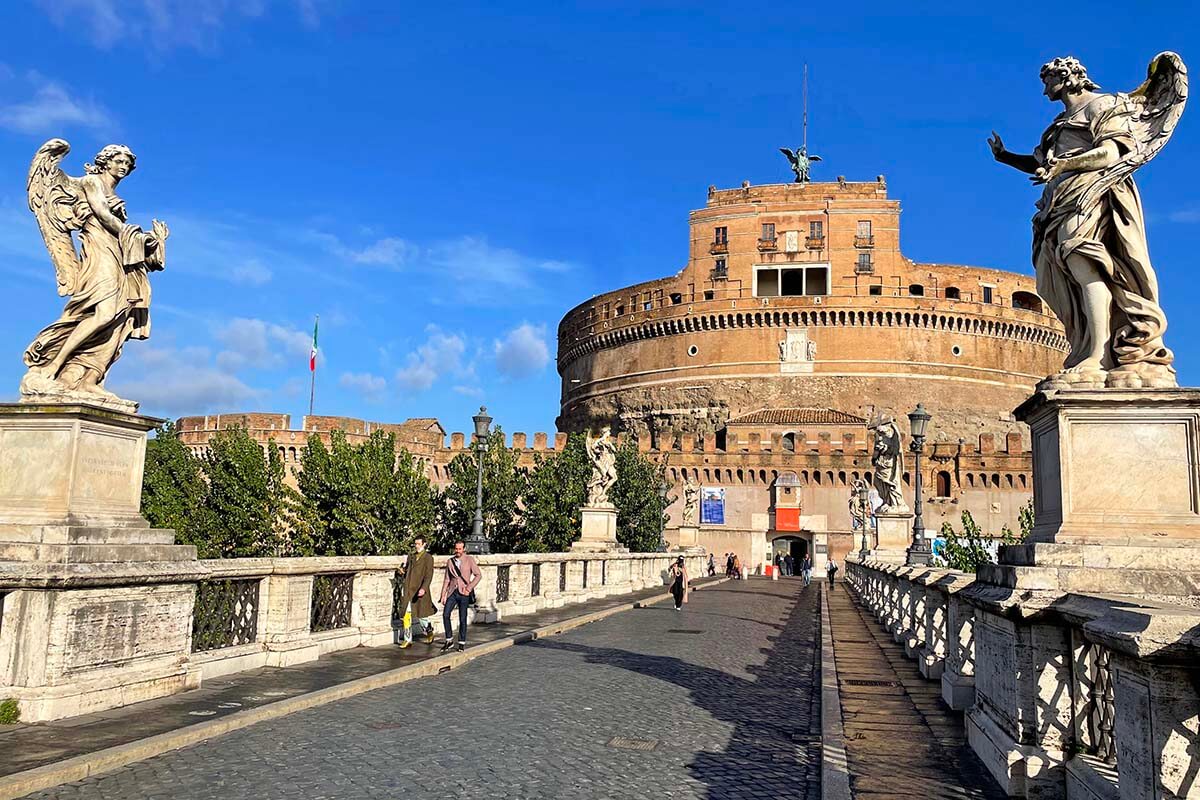
How to visit: You can just see the building from the outside, but you can also visit the inside. It’s located on the main route on your way to the Vatican.
You can get a fast-track ticket and visit on your own or join a guided tour. The entrance to the museum is also included with the Omnia Pass .
TIP: Don’t miss the panoramic views from the rooftop terrace of the museum. It’s one of the best viewpoints in Rome , offering amazing views of the River Tiber, the historic city center, and the Vatican.
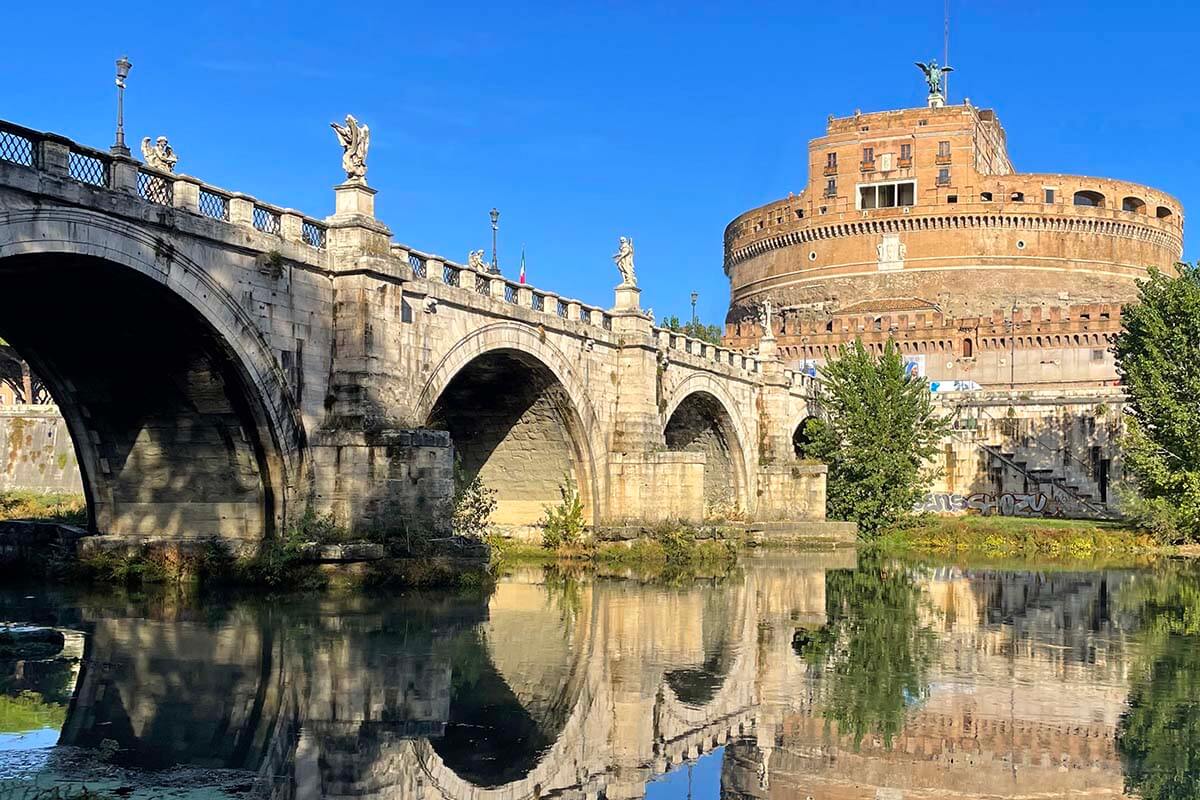
14. Catacombs of St. Callixtus
Built between the 2nd and the 5th century AD.
If you are looking for even-more unique sites to see in Rome, consider visiting some of the ancient catacombs (underground burial sites). There are over 60 known catacombs in Rome, with hundreds of kilometers of subterranean tunnels, and hundreds of thousands of graves. Some of these catacombs are open to the public.
Probably the most special and best-known are the Catacombs of St. Callixtus (Catacombe di San Callisto) , located next to the Appian Way mentioned earlier. This ancient site stretches for about 20 km (12 miles), is over 20 meters (65 ft) deep, and contains about half a million graves.
Several Popes were buried at this site and you can visit the crypt of the Popes . In addition, you can see the crypts of some early Christian martyrs, including the crypt of St. Cecilia . You can also walk around and explore underground galleries and see hundreds of – now empty – tombs around you.
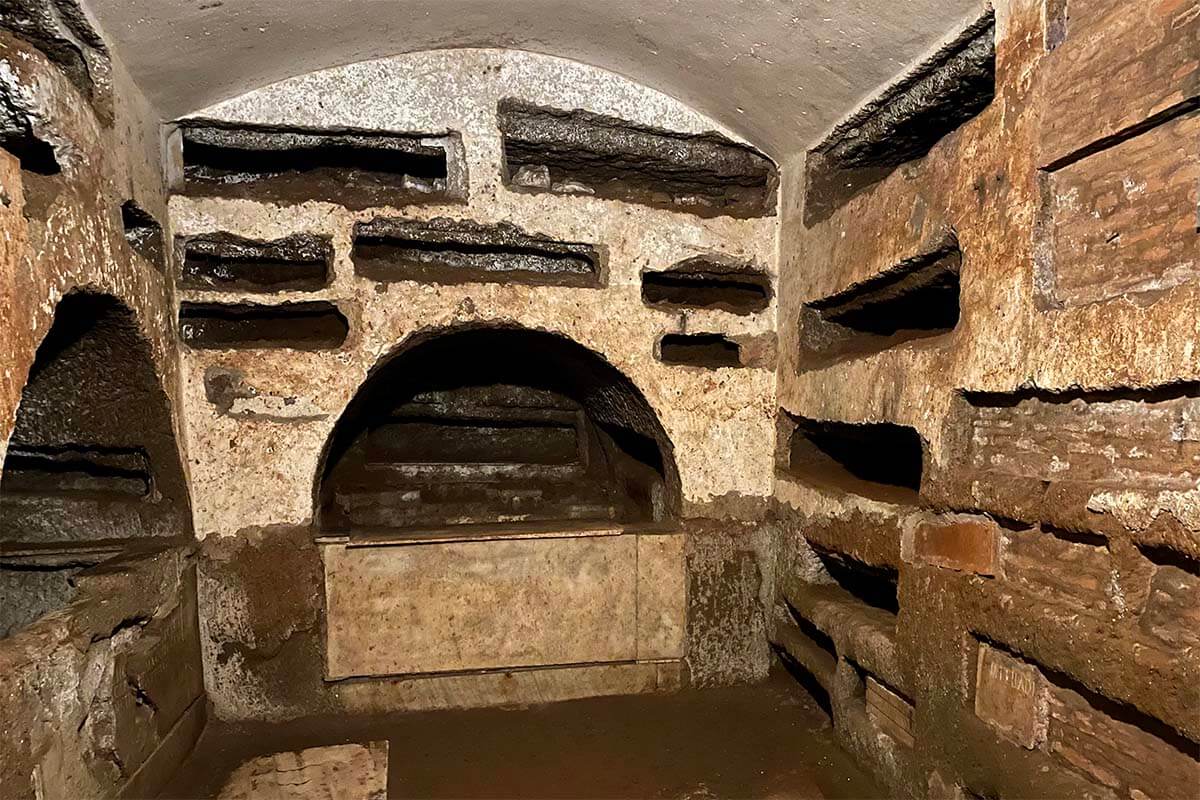
How to visit: You can only visit the Catacombs of St. Callixtus with an official guide (included in your entrance tickets ).
You have to make your own way to the catacombs (by car, by bike, or by public transport) and it’s essential to book a tour in advance or you risk not being able to visit. It’s a popular site.
TIP: There are also many guided tours from the city center that include a visit here, usually together with some other ancient sites. We visited St. Callixtus Catacombs with this e-bike tour that also took us to Via Appia and the Park of the Aqueducts.

15. Baths of Caracalla
Built around 212-216 AD.
Baths of Caracalla (Terme di Caracalla or Termae Anthoninianae) is one of my personal favorite ancient sites in Rome. This grand 3rd-century complex with remarkable ruins and some very well restored mosaics is absolutely impressive! You feel so tiny here and it makes you realize how advanced the Romans really were in architecture and engineering.
These public baths were built at the beginning of the 3rd century and were the second-largest bathhouse in Rome. In addition to the luxurious bathing houses, the complex also had several saunas, a sports center, and even an Olympic-size swimming pool. The site was surrounded by beautiful gardens and even had a library.
The baths were heated via a sophisticated underground oven system and you can still see the remains of it today. These Roman baths remained in use for about 300 years. Nowadays, it’s a working archeological site that is open to the public.
Visiting here gives you an amazing insight into yet another aspect of daily life in the glory days of the Roman Empire. And because the Baths of Caracalla are somewhat of a hidden gem and not many tourists come here, this is one of the ancient Roman sites with a more authentic feel.
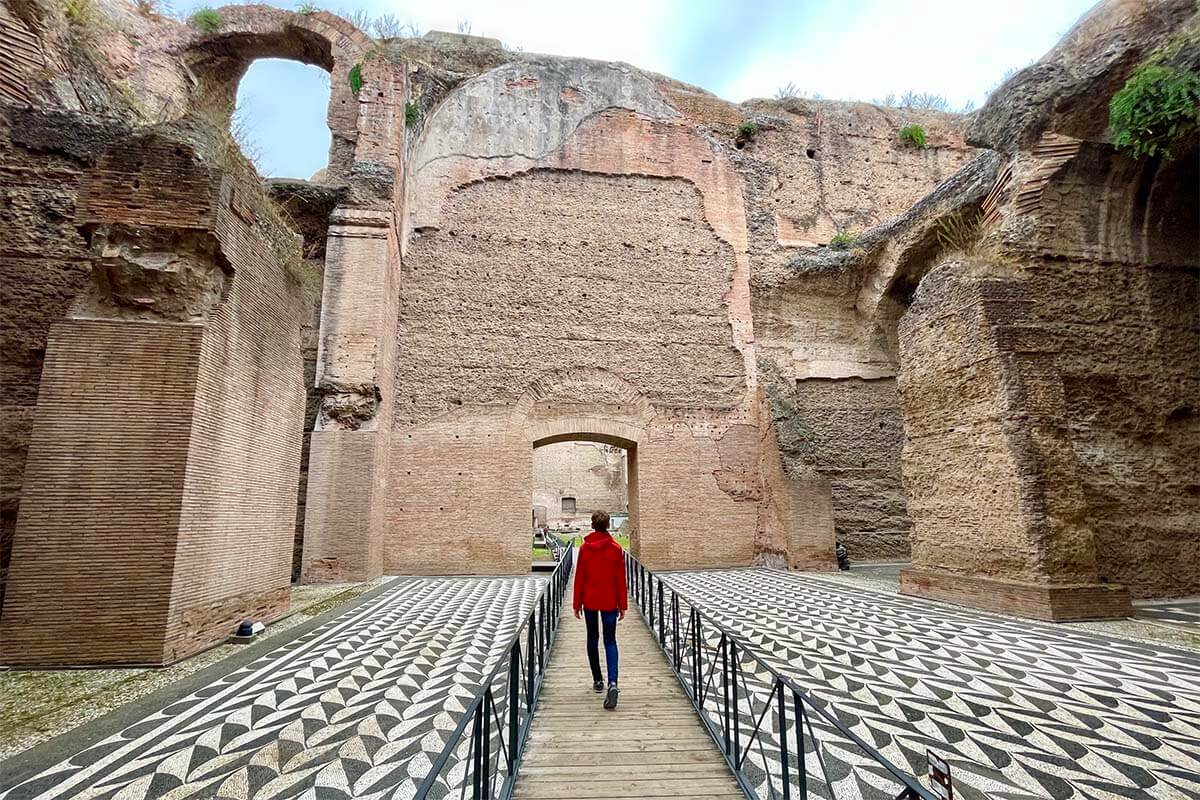
How to visit: The Baths of Caracalla are located a 10-15 minutes walk from the Circo Massimo metro station or about 20 minutes walk from the Colosseum.
You can see some ruins from the outside, but the best parts and the mosaics can only be admired if you actually visit inside.
Normally, you can just get your tickets on the spot. You can find more info on the official website (in Italian).
TIP: The earlier-mentioned guided tour is a great option if you want to visit the Caracalla Baths and Circus Maximus with a local guide.
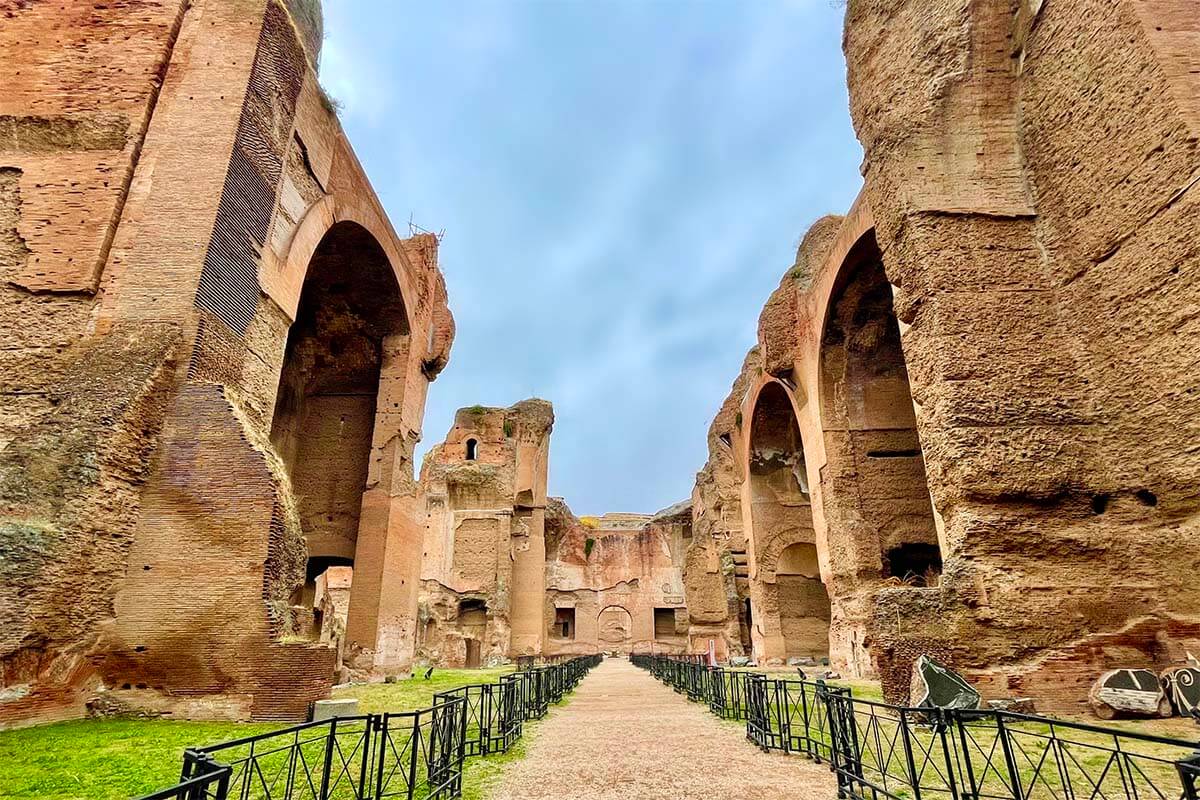
16. Baths of Diocletian
Built around 298-306 AD.
Baths of Diocletian (Terme di Diocleziano) were the largest and most impressive public baths in Rome. The site is just as grand as the above-mentioned Baths of Caracalla, and it also contained several hot and cold baths, but also open-air bathing pools, etc. It’s also believed to have housed a library.
Built at the turn of the 3rd – 4th centuries, the baths remained in use until the 6th century. Over the centuries, the site has been used for various purposes, with lots of construction in and around it shaping the new city of Rome. In the 16th century, a basilica was built here, and later a monastery was added as well. At a certain point, parts of the old bathhouse were used to store and sell grain and oil.
In the late 19th century, the monastery was abandoned. The Roma Termini railway station was built nearby, just as several hotels, palazzos, etc. In 1889, the remaining site of Diocletian’s Baths and the monastery was designated as a museum, part of the National Roman Museum .
This means that the site is quite well-preserved, many of the areas are covered with a roof, there are beautiful sculptures, mosaics, and other Ancient Rome artifacts. It has much more of a museum feel than the Baths of Caracalla, but is well worth visiting too!
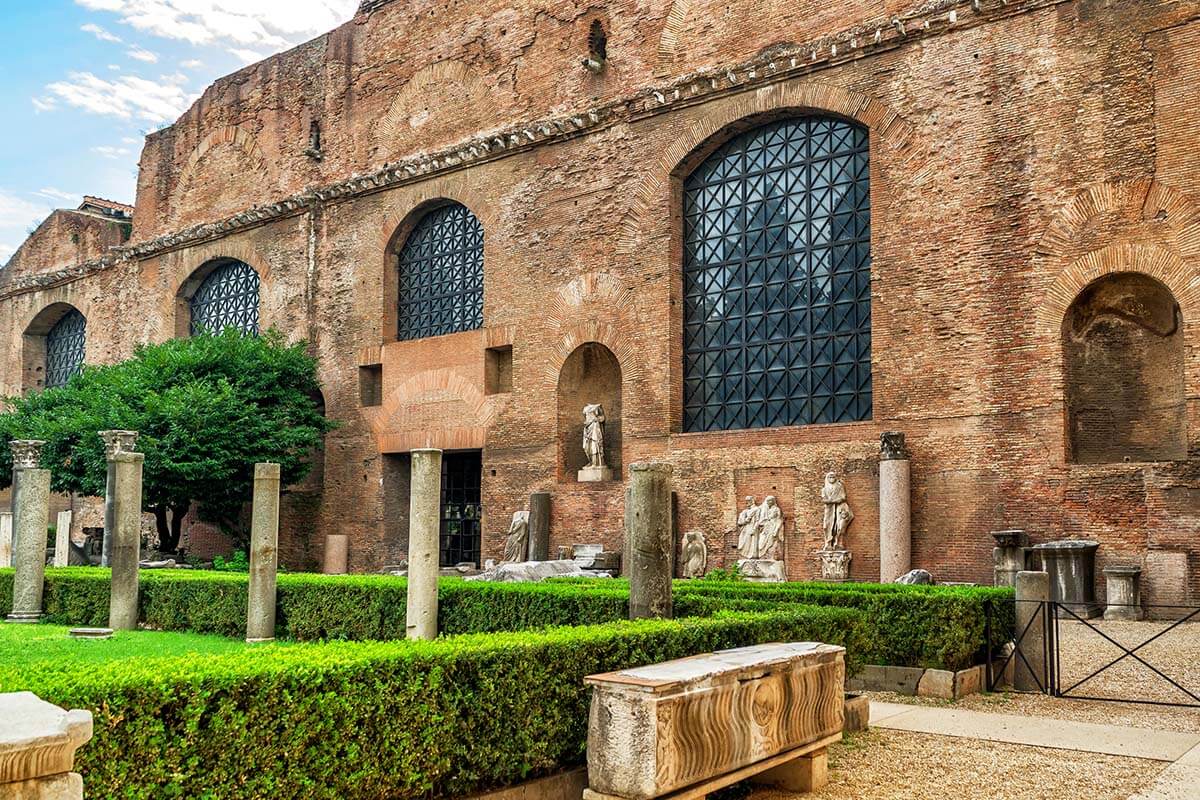
How to visit: The National Roman Museum – Baths of Diocletian section is quite centrally located, just next to the main train station in Rome.
It’s normally open daily except on Mondays, and you can just get a ticket on the spot. For more practical info, please see here .
TIP: The entrance here is also included with the Omnia Card .
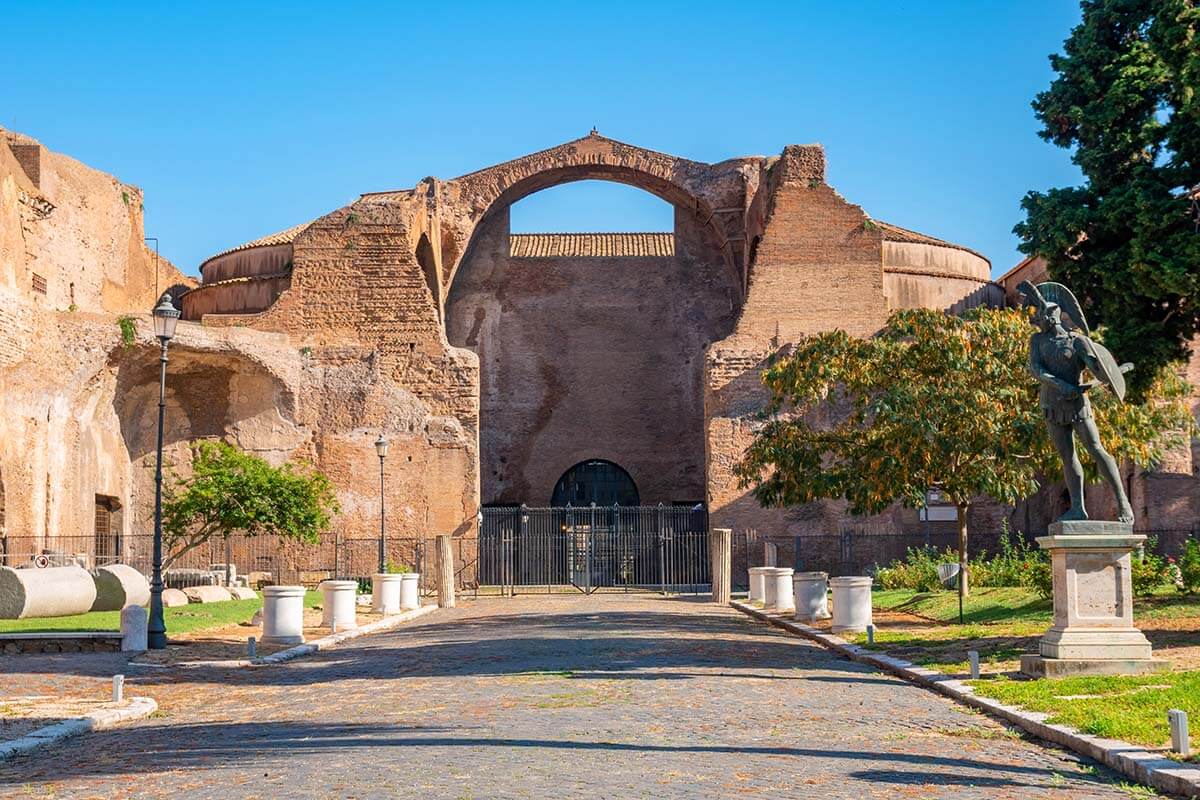
Map of the best ancient landmarks in Rome
To help you get a better idea of where all the sites mentioned in this guide are located, we created a map indicating the best ancient Roman landmarks in Rome.
This should help you plan your visit, and maybe you can include a few of these places in your itinerary when exploring the most popular sights and tourist attractions in Rome .
How to use this map: Use your computer mouse (or fingers) to zoom in or out. Click on the icons to get more information about each place. Click the arrow on the top left corner for the index. Click the star next to the map’s title to add it to your Google Maps account. To view the saved map on your smartphone or PC, open Google Maps, click the menu and go to ‘Your Places’/’Maps’. If you want to print the map or see it in a bigger window, click on ‘View larger map’ in the top right corner.
So, this is our guide to some of the most interesting ancient landmarks to see in Rome. I hope that this gives you a better understanding of when some of the oldest buildings were built, the stories behind the ruins you see, and inspires you to visit at least some of them.
There’s so much history and fascinating ancient sites everywhere you go in Rome, and that’s what makes the Eternal City one of a kind!
For more information and tips for your visit, please also see our itineraries and other guides to Rome via the links below.
Rome travel guides:
- Tips for Planning a Trip to Rome
- How to Get to Rome from the Airport
- How to Plan Your First Trip to Europe
- Must-sees: Best Things to Do in Rome
- Where to stay: Best Area to Stay in Rome
- Where to eat: How to find the best food in Rome
- Hidden Gems of Rome
- Best Views & Viewpoints in Rome
- Rome Underground Sites
- 1 Day in Rome (all the best places)
- 2 Days in Rome (the musts + a few hidden gems)
- 4 Days in Rome (top sights, hidden gems, a few more ancient landmarks)
If you found this post helpful, don’t forget to bookmark it and share it with your friends. Are you on Pinterest? Pin these images!
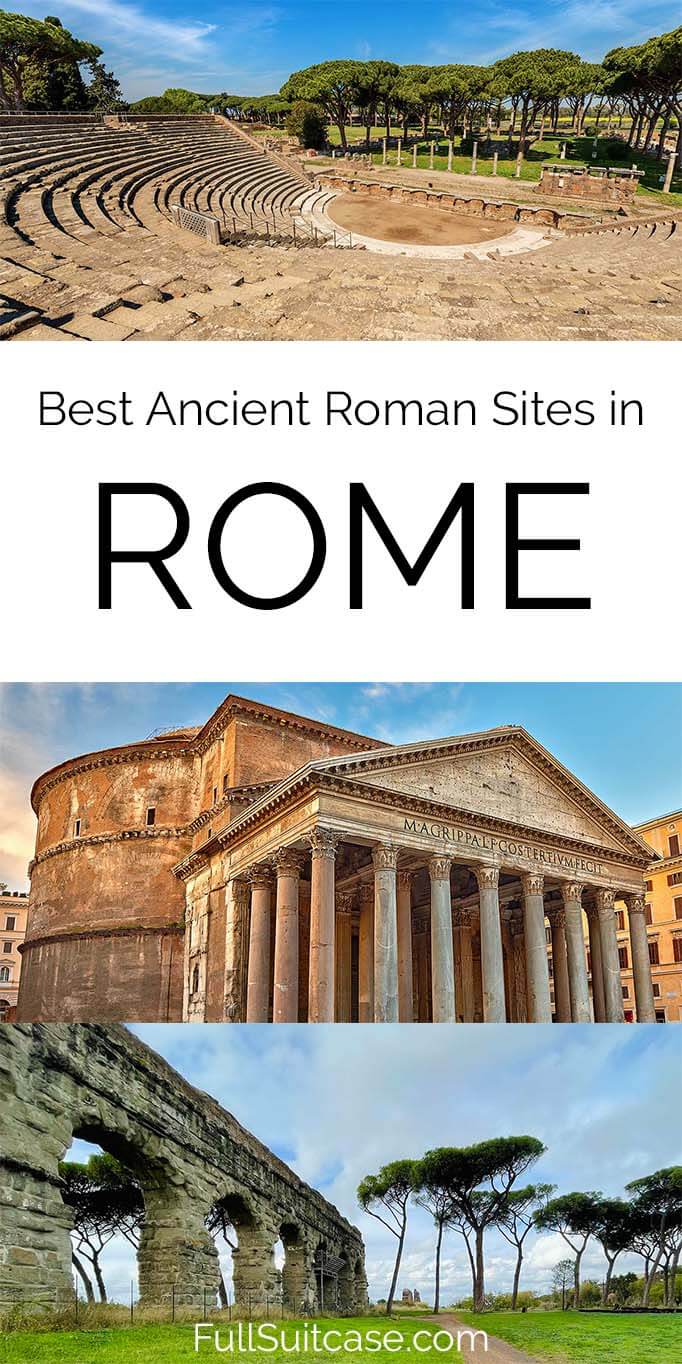
More travel inspiration and tips for Italy:
- What to see: Best Places to Visit in Italy & Most Beautiful Cathedrals in Italy
- Cities: Most Beautiful Cities in Italy
- Itinerary: How to See the Best of Italy in 2 Weeks
- Florence: Best Things to Do in Florence & One Day in Florence
- Milan: Best Things to Do in Milan & One Day in Milan
- Venice: Best Things to Do in Venice & One Day in Venice & Doge’s Palace (must-see!)
- Naples: Best Things to Do in Naples & One Day in Naples & Where to Stay in Naples & Best Day Trips from Naples
- Cinque Terre: One Day in Cinque Terre & Where to Stay in Cinque Terre & Info + Tips for Visiting Cinque Terre
- Tuscany: Most Beautiful Towns in Tuscany & Tuscany Itinerary & Montepulciano
- Siena: Best Things to Do in Siena & Siena Cathedral
- Amalfi Coast: Amalfi Coast Itinerary & Capri & Amalfi Coast Travel Tips
- Emilia Romagna: Emilia Romagna Itinerary & Best Things to Do in Bologna & Best Things to Do in Rimini
- San Marino: Complete Guide to Visiting San Marino
- Italian Lakes: Lake Garda & Lake Como & Bellagio & Best Lakes in the Dolomites
- Italian Mountains: Hiking in the Dolomites & Best Places in the Dolomites & Best Lakes in the Dolomites & Dolomites Accommodation Guide
- Food: Italian Food by Region
- … for many more guides and destinations, please see our Italy travel guide .
This site uses Akismet to reduce spam. Learn how your comment data is processed .
Friday 28th of April 2023
Thanks for this great guide, Jurga. It's so interesting to also see the timeline of the oldest places in Rome. I always thought that colosseum is the oldest building in Rome and had no idea about so many other places. I will try to visit Ostia Antica too and already booked the Appian Way bike tour that you recommended.
Thanks for the feedback, Evy, and have a great time in Rome!

Sign Up Today
Start your 14 day free trial today

The History Hit Miscellany of Facts, Figures and Fascinating Finds
10 Key Historic Sites to See in Rome
Explore the centre of the ancient world with our guide to the 10 key historic sites in rome, featuring the colosseum to the musei capitolini and beyond..

Peta Stamper
06 mar 2024.
From wonders such as the immense Colosseum to the legendary Palatine Hill, the impressive Pyramid of Cestius and the long history of San Clemente, Rome is brimming with amazing historic places. Other top archaeological sites to see tend to include the famous Ostia Antica and the beating heart of the city: the Roman Forum.
With a legacy that spans over 2,000 years of history, the eternal city has scintillating archaeological attractions around every corner. Whether you’re on a whistle-stop tour of the city or just don’t want to miss the essentials, we’ve put together a guide to the 10 Key Historical Sites in Rome.
History Hit Holidays
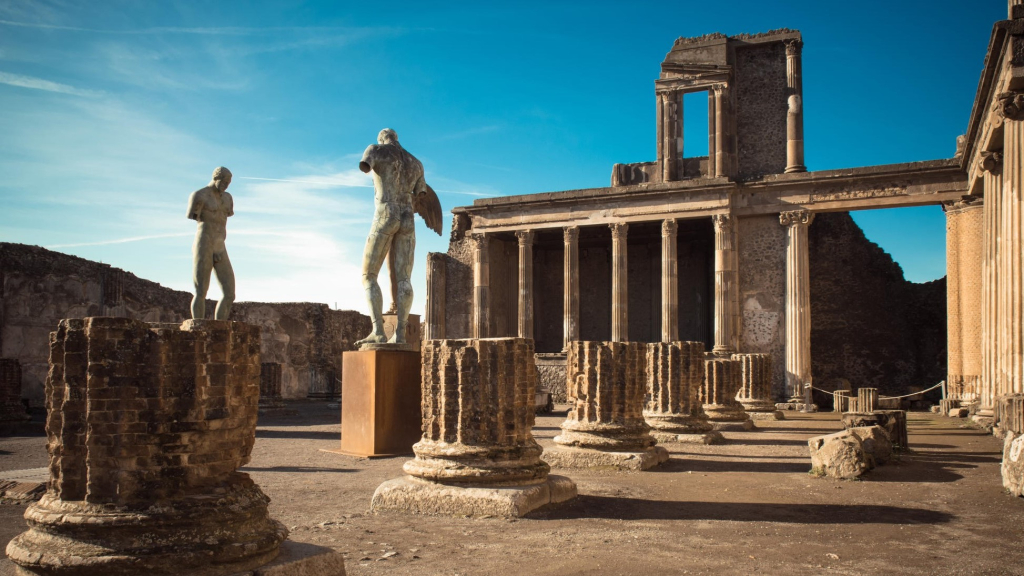
Uncover Pompeii with Sophie Hay and Tristan Hughes
What historical sites should i visit in rome the top 10.
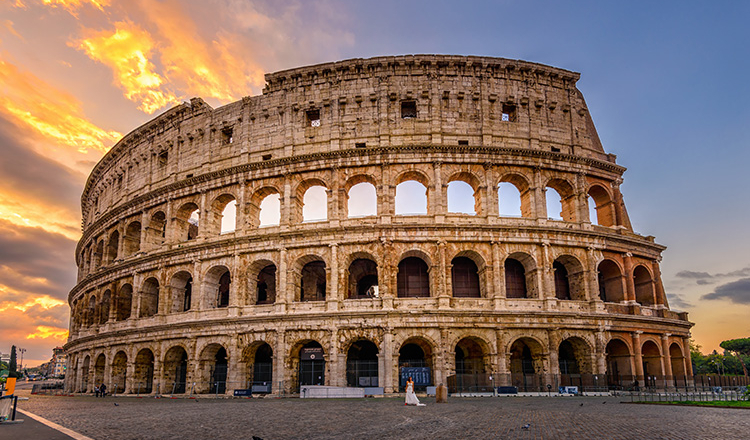
1. The Colosseum
The Colosseum is a site like no other. Beyond a shadow of a doubt, nothing represents the sheer power and magnificence of the Roman Empire like this stunning piece of ancient architecture.
The Colosseum, or ‘Colosseo’ in Italian, was once the largest amphitheatre in the Roman Empire. It was built in the 1st century AD by the Emperor Vespasian as a place for the people of Rome to enjoy. Originally named the Flavian Amphitheatre after Vespasian’s family name, the man who brought the Roman Empire back from the brink would not live to see its completion.
The Colosseum remained the amphitheatre of Rome until the end of the Roman Empire. This was the place where gladiators, lions and those accused of crimes were put to the test, often fighting to the death.
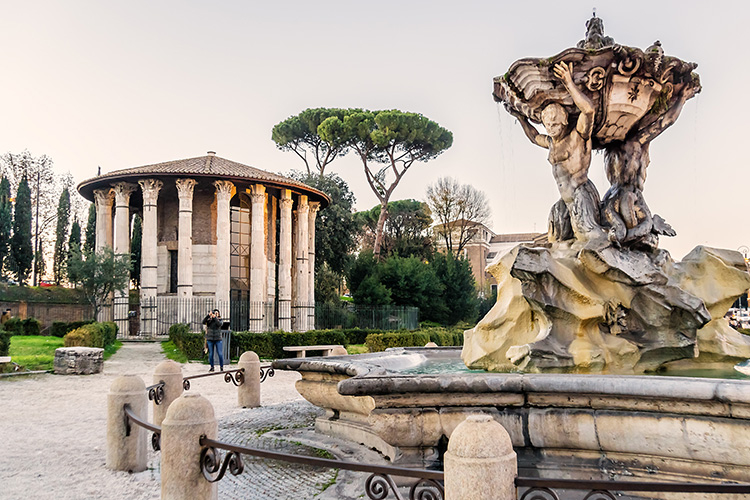
2. Temples of the Forum Boarium
The Temples of the Forum Boarium are two of the best preserved Roman temples to have survived from the Republican era, and together marked an important commercial and religious spot nestled by the Capitoline, Palatine and River Tiber. Comprised of two temples, the Temple of Hercules Victor and the Temple of Portunus, the Temples of the Forum Boarium date back to approximately the 2nd century BC.
Beginning in the late 1990s, the site saw new landscaping and conservation efforts towards both temples, resulting in the site we see today. Backed by tall trees and endless Roman blue skies, the temples are in fantastic condition, providing visitors with a sense of the bustling ancient cattle market dominated by these structures.
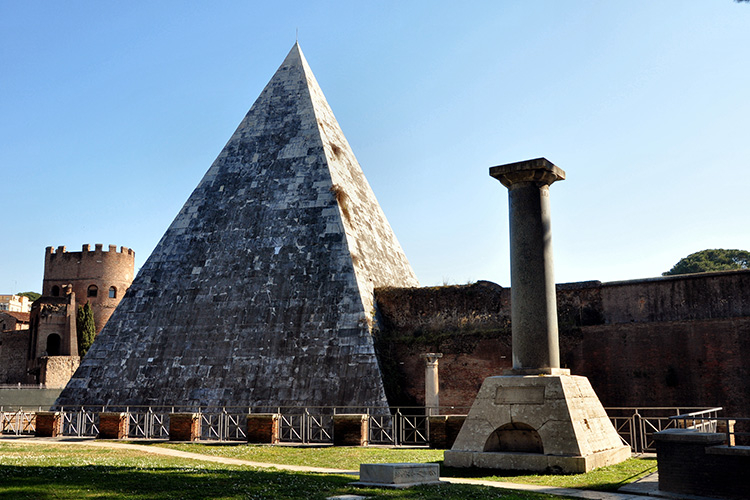
3. Pyramid of Cestius
The Pyramid of Cestius is the tomb of affluent magistrate Caius Cestius which was built in the 1st century BC in Rome, Italy. Constructed of white marble and brick, this ostentatious 35-metre high tomb was built in this style due to the popularity of all things Egyptian which swept through Rome after Egypt was incorporated into the Empire.
For those embarking on the Grand Tour during the 18th and 19th centuries, the Pyramid of Cestius was a must-see. Percy Shelley described it as “one keen pyramid with wedge sublime” in a 1821 elegy for the poet John Keats.
Ring-fenced by a guard railing, the Pyramid of Cestius continues to provide a dramatic, awe-inspiring feature to the ancient Roman landscape – a true feat when you consider the monuments it shares the city with.
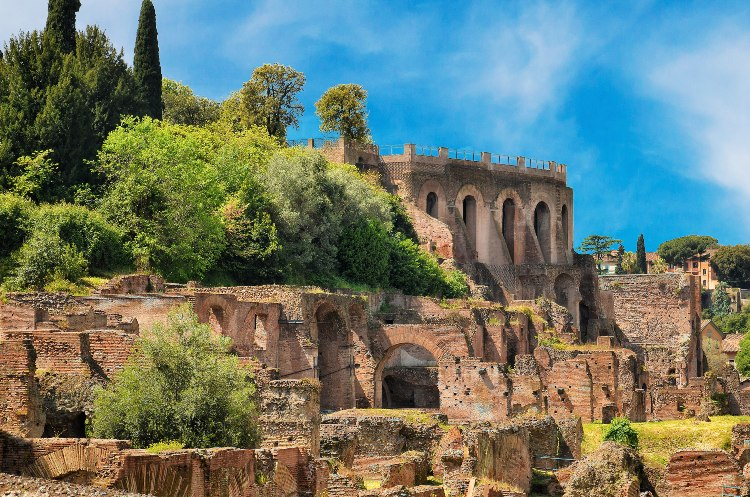
4. Palatine Hill
The Palatine Hill or Palatino is considered as the birthplace of Rome. One of Rome’s 7 hills, the Palatine Hill is closely linked with the city’s history and today houses some of its most ancient and important sites.
Legend has it that the twins Romulus and Remus were taken to Palatine Hill by the she-wolf who raised them , and here they founded a village which would become Rome .
In a dispute over who was the rightful leader of the new settlement, Romulus eventually killed his brother at the Palatine Hill, thus becoming the namesake of Rome. Indeed, the Palatine Hill is where the earliest huts of Rome were found, supposedly built under the remit of Romulus himself.
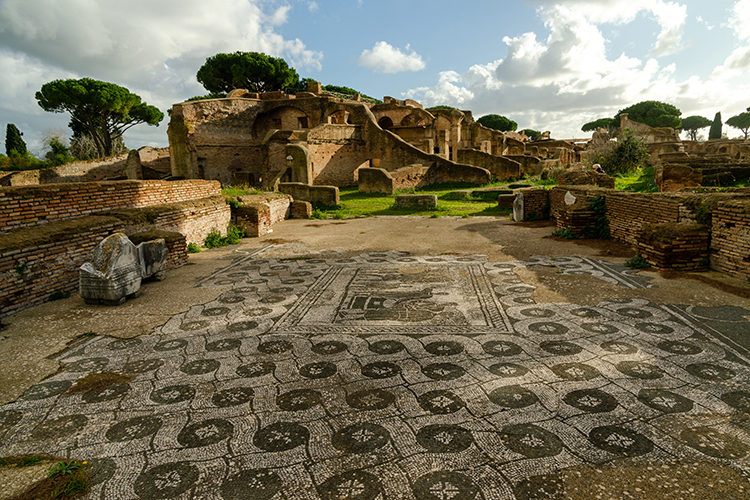
5. Ostia Antica
Ostia Antica is an extraordinary Roman site just outside the city centre that contains the ruins of the ancient port town that once served as the gateway to Rome. Tracing its roots back to at least the 4th century BC, Ostia Antica served as Rome’s principle port for hundreds of years: a witness and monument to the rise of the ancient superpower, its dominance and eventual decline.
Today, visitors can view a great many ruins from the ancient town including a well preserved Roman theatre, the Baths of Neptune, remains of the military camp, temples to ancient deities, the forum and even Ostia Synagogue, which is the oldest known synagogue site in Europe.
Yet Ostia Antica is so much more than these notable elements: it contains a huge range of well-preserved typical Roman dwellings, shops, flats and warehouses – even a Roman public toilet. These remains combine to provide visitors with a vivid picture of an ancient Roman town and allows you to get a real feel for day-to-day life in ancient Rome.
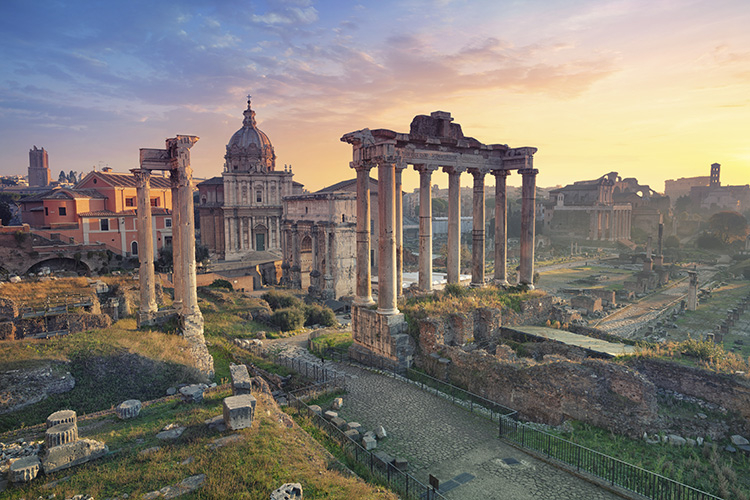
6. Roman Forum
The Roman Forum, or Forum Romanum, was the very centre of ancient Rome. Throughout the lifespan of Roman civilisation the Forum served as the focus of political, civic, and religious life.
For over a millennia the Forum’s changing nature reflected the constant shifting in the fortunes of the religious, military, and political natures of the Roman world . The Roman Forum witnessed elections , public speeches, criminal trials, social gatherings, and religious ceremonies among many others.
Today, though much of the grandeur of the Roman Forum has been lost to the ages, it is still a spectacular display of ancient Roman life.
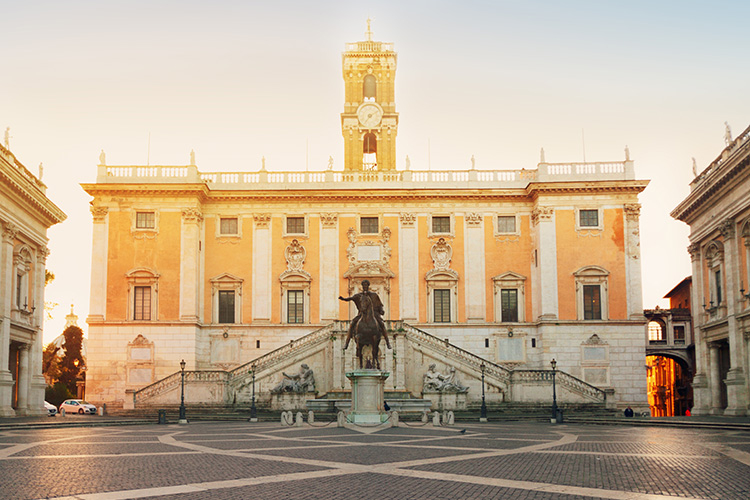
7. Capitoline Museums
Musei Capitolini – the Capitoline Museums – stand on the ancient Capitoline Hill in the centre of ancient and modern Rome , and host a huge wealth of artefacts from the ancient, medieval and renaissance periods.
Comprised of 3 main buildings, namely Palazzo Nuovo , Palazzo dei Conservatori and Palazzo Senatorio, the Musei Capitolini are located near the Roman Forum and a short walk from the Colosseum.
Current exhibitions include ‘The legacy of Caesar and the conquest of time’, exploring the marble timekeeping and history of Rome from its origins to the imperial age, and ‘The Torlonia Marbles’ which displays the world’s most prestigious private collection of ancient sculptures.
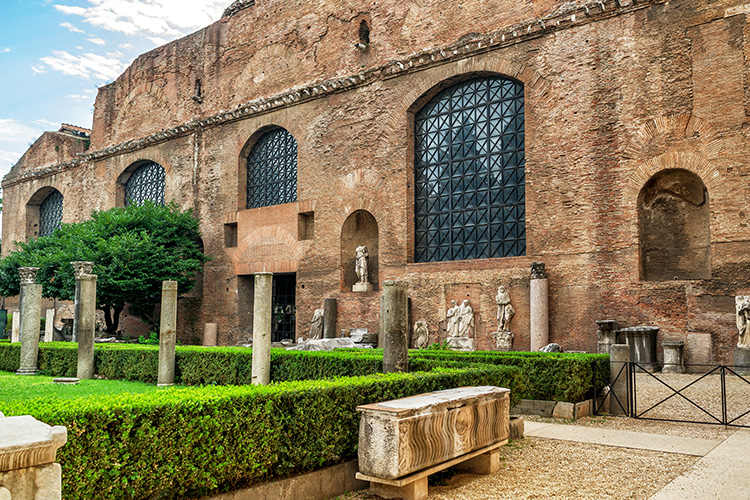
8. Baths of Diocletian
Once the largest ancient baths complex in the world, the Baths of Diocletian – or Terme di Diocleziano – was built between 298 AD and 306 AD in honour of the Roman Emperor Diocletian. Today, they are open to the public as part of the National Roman Museum in Rome, Italy.
One of the key tourist attractions for those wishing to view the baths is the Museo Nazionale Romano – Terme di Diocleziano – which is part of the Rome National Museum (shown on map, above). The museum, which opened in 1889, was built within the Baths of Diocletian and contains several collections from the ancient world. Although the museum contains many interesting exhibits, it gives little insight into the original baths themselves.
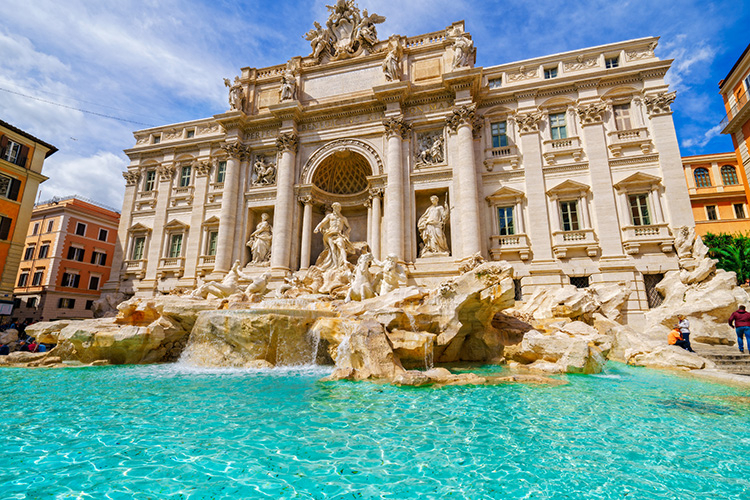
9. The Trevi Fountain
The Trevi Fountain is an iconic 18th century monument in Rome . A stunning depiction of ancient deities and resplendent with frescos of legends and myths, the Trevi Fountain attracts floods of tourists keen to throw their coins into its waters to assure their return to Rome – or so goes the myth.
Located in Rome’s Trevi district abutting the palazzo Poli, the Trevi Fountain was built on the site of an earlier fountain that was demolished in the 17th century. The Trevi Fountain marks the intersection of three major Roman roads – from which it gains the name ‘Trivium’ – and was the terminus of the Acqua Vergine. Revived from the Aqua Virgo of ancient Rome, this ancient aqueduct once served the Baths of Agrippa.
Any trip to Rome is not complete without visiting the 85 foot tall Trevi Fountain to throw a euro over your left shoulder into the fountain’s clear pool.
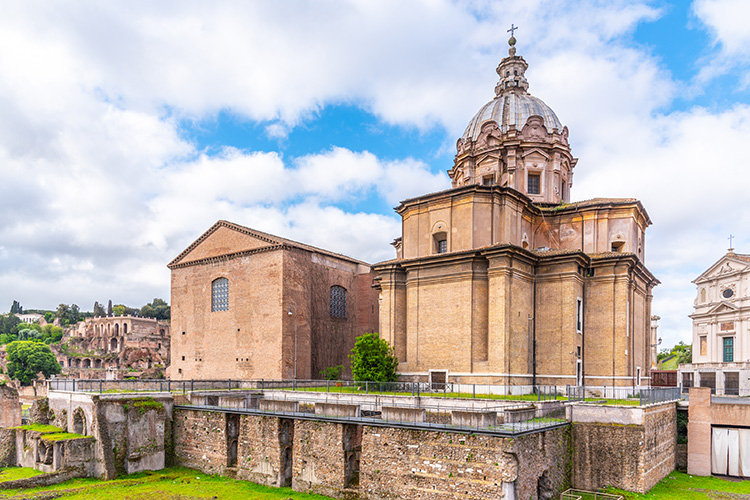
10. Curia Julia
The Curia Julia in the Roman Forum was the senate house in Ancient Rome, built under Julius Caesar and later restored by Diocletian after being damaged by fire. The Curia stood at the very heart of the ancient city, both physically and politically, and would have borne witness to some of Rome’s most famous events and figures.
Curia Julia is one of many curia – which roughly translates to ‘meeting house’ – which existed during the course of the Ancient Roman civilisation and was the administrative centre of the empire.
Unusually for an Ancient Roman building, the Curia Julia stands intact due to its conversion into the church of Saint Adriano in 623 AD by Pope Honorius I.
Essential Ancient Sites to Visit in Rome
:max_bytes(150000):strip_icc():format(webp)/martha_bio-56a3c8865f9b58b7d0d3b5fe.jpg)
The glories of ancient Rome are easily accessible to the visitor. Some sites can be visited for free while others are part of Rome Passes and Cards . Most ancient sites are in Rome's historic center so you can visit several places in one day. Even if you don't have time to take an in-depth look, just walking by some of these places is incredible and gives you an overview of ancient Rome's history.
The Colosseum of Rome
TripSavvy / Taylor McIntyre
Ancient Rome's huge amphitheater, holding up to 55,000 people, was built by Emperor Vespasian in 80 A.D. and was the scene of many deadly gladiatorial and wild animal fights. Today you may see men dressed in gladiatorial costume as you walk between the Colosseum and the nearby Arch of Constantine, built in 315 A.D. On Sundays, the Via dei Fori Imperiali leading to the Colosseum is closed to traffic so it's a great place for a stroll (if you don't mind the souvenir vendors).
Ticket lines can be long but there are several ways to buy Colosseum tickets faster including buying a Colosseum and Roman Forum pass online from Select Italy or booking a tour .
The Pantheon
TripSavvy / Stella Levantesi
Rome's Pantheon, the temple of all the gods, was built between 118-125 A.D. by Emperor Hadrian. In the 7th century it was made into a church by early Christians and now is lined with tombs. Go inside to see the spectacular dome. Admission is free. The Pantheon is the best-preserved building of ancient Rome and today is surrounded by a pleasant and lively piazza, a nice place to sit in the evening and enjoy a drink. A good nearby restaurant is Armando's, on a street coming off the piazza.
Roman Forum
The ancient Roman Forum is a huge complex of ruined temples, basilicas, and arches. It was the ceremonial, legal, social, and business center of ancient Rome (The food stalls and brothels were removed in the second century B.C.). To get a good view, walk up the Capitoline Hill behind the museums. Give yourself at least 1-2 hours to wander around, then continue up to the Palatine Hill, also included in the ticket.
The Palatine Hill
TripSavvy / Christopher Larson
The emperors and aristocrats of ancient Rome lived on the Palatine Hill starting in the first century B.C. The Domus Flavia and Domus Augustana, built in the first century A.D., where the official residence of the emperors for over 300 years. Admission also includes the Palatine Museum, the Roman Forum, and Colosseum.
The Capitoline Hill Museums
Above the Roman Forum, the Capitoline Hill was Rome's symbolic center and held the Temple of Jupiter. Today there are two museums, the oldest public museums in the world, the Palazzo Nuovo, with Greek and Roman sculptures, and the Palazzo dei Conservatori, with art galleries, sculptures, and frescoes. One ticket gives you admission to both. Just like in ancient Rome, the hill still has the best view of Rome's center.
Piazza Navona
Originally built as a stadium in the first century for athletic contests and chariot races, Piazza Navona is now lined with luxurious cafes and is the home to three lavish Baroque fountains. The much-touted ice-cream dessert, tartufo , is said to have originated here and you can still try it in the cafes as a splurge.
Baths of Diocletian
The Baths of Diocletian, once covering 32 acres, were the largest public baths or thermae in ancient Rome. Although much of the original structure has been destroyed, remains of the baths are now part of the National Roman Museum. Several painted tombs have been moved and reconstructed inside the baths. They can be seen when you visit the baths, open every day except Monday. The baths can be visited with the Four museums ticket and Rome archeology card.
Baths of Caracalla
At the foot of the Aventine hill are the monumental ruins of the Baths of Caracalla, used from the 2nd to 6th century A.D. Taking a bath was a social event for the people of ancient Rome and the huge complex could hold up to 1600 bathers! Besides baths, they held an array of facilities such as a gym, art galleries, gardens, and shops selling food and drinks.
Trajan's Market
Thought to be the world's oldest shopping mall, the arcades in Trajan's Market are now believed by many to be administrative offices for Emperor Trajan. The shops and apartments were built in a multi-level structure and you can visit several of the levels. Highlights include delicate marble floors and the remains of a library. The Museum of the Imperial Forums houses a wealth of artifacts from all of ancient Rome's forums.
Roman Houses Under Saints John and Paul Church
Under the Church of Saints John and Paul are excavations of Roman buildings, including what's believed to be the house of the two saints and an early Christian worship site. The Roman buildings were discovered during excavations to find the tombs of John and Paul and are now open to the public along with a small museum.
Via Appia Antica and Catacombs
The Via Appia was once the major road to ancient Rome with construction starting in 312 B.C. The Appian Way is now a 10-mile long archaeological park, lined with ruins of tombs and monuments. A good way to visit is by bike, although you may also enjoy walking it. Some of the catacombs, burial places of the early Christians, are open for public tours - check for the time of the English tour when you arrive.
The Roman Guy offers a good guided Appian Way Catacomb tour that includes a tour under San Clemente Church and transportation.
Ostia Antica
Although not actually in Rome, the ruins of the ancient Roman port of Ostia Antica, easily accessible from Rome on public transportation, are well worth a visit. It's a huge complex and you can easily spend several hours wandering around the old streets, shops, and houses. You should plan at least a half day for this trip.
3 Days in Rome: What to See and Do
What to Know About Visiting the Roman Colosseum
The 25 Top Attractions in Rome, Italy
Top 6 Tourist Attractions in Italy
10 Unique Guided Tours in Rome
Top Churches to Visit in Rome
Roman Amphitheaters in Italy
The 14 Best Day Trips from Rome
Buying Tickets for the Colosseum in Rome
The Top 23 Things to Do in Italy
A Visit to the Forum in Rome
12 Free Things to Do in Rome
Where to Go in Rome to Take the Best Photos
What to See in the Roman Forum
Rome's Palatine Hill: The Complete Guide
10 Neighborhoods You Need to Know in Rome

23 Top-Rated Tourist Attractions in Rome
Written by Barbara Radcliffe Rogers Updated Dec 25, 2023 We may earn a commission from affiliate links ( )
In a city so filled with icons of antiquity and the Christian faith, it's hard to know where to go first. Of course, your own interests will govern your choices, but there are certain sites that are almost obligatory landmarks of Italy and top attractions in the world , such as the Colosseum and the Pantheon.
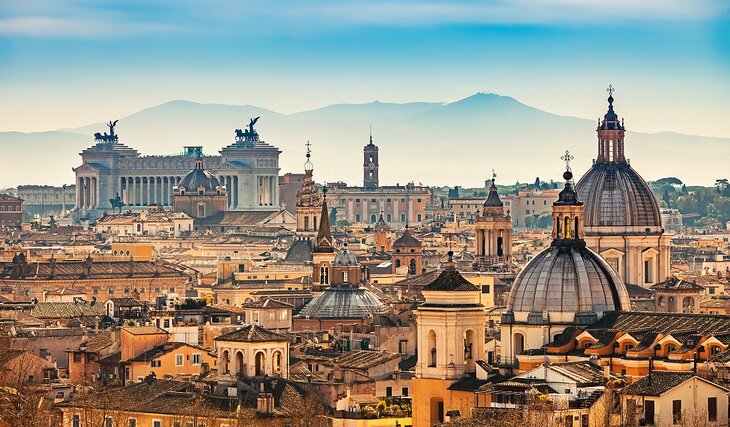
A word of caution: try to vary your experiences as you explore Rome, so that you don't visit too many ancient sites or churches in a row. And intersperse these more serious attractions with a few that are simply tourist icons: the Spanish Steps and that place all tourists must go to toss in their coin, the Trevi Fountain.
Rome is so big that it can overwhelm you, so even the most devoted sightseer needs to take some time to kick back and enjoy la dolce vita in a park or sidewalk café.
You'll be able to choose the best places to visit with this handy list of the top attractions in Rome.
1. The Colosseum and the Arch of Constantine
2. vatican city, 3. the pantheon, 4. roman forum, 5. trevi fountain, 6. vittorio emanuele ii monument, 7. centro storico & the spanish steps, 8. via del corso, rome's shopping street, 9. santa maria maggiore, 10. piazza navona, 11. piazza del popolo & santa maria del popolo, 12. palatine hill, 13. villa borghese gallery and gardens, 14. castel sant'angelo national museum, 15. trastevere, 16. capitoline museum, 17. baths of caracalla, 18. san giovanni in laterano (basilica of st. john lateran), 19. the catacombs and via appia antica (appian way), 20. palazzo doria pamphilj, 21. basilica of san clemente, 22. domus aurea: nero's golden house, 23. terme di diocleziano (baths of diocletian national museum), where to stay in rome for sightseeing, tips and tours: how to make the most of your visit to rome, rome, italy - climate chart, more things to see and do in rome.

As the Eiffel Tower is to Paris, the silhouette of the Flavian Amphitheatre is to Rome. The largest structure left to us by Roman antiquity , the Colosseum still provides the model for sports arenas - present-day football stadium design is clearly based on this oval Roman plan.
The building was begun by Vespasian in AD 72, and after his son Titus enlarged it by adding the fourth story, it was inaugurated in the year AD 80 with a series of splendid games. The Colosseum was large enough for theatrical performances, festivals, circuses, or games, which the Imperial Court and high officials watched from the lowest level, aristocratic Roman families on the second, the populace on the third and fourth.
Beside the Colosseum stands the Arch of Constantine , a triumphal arch erected by the Senate to honor the emperor as "liberator of the city and bringer of peace" after his victory in the battle of the Milvian Bridge in 312.
Lines are long and move slowly, so you can save time by joining the Skip the Line: Ancient Rome and Colosseum Half-Day Walking Tour and have a knowledgeable guide, as well.
Author's Tip: For an unforgettable experience, especially in the heat of mid-summer, visit the Colosseum on a special night tour. Not only is it cooler then, but the monument is magical with its interior bathed in golden light.
- Read More: Visiting the Colosseum: Highlights, Tips & Tours
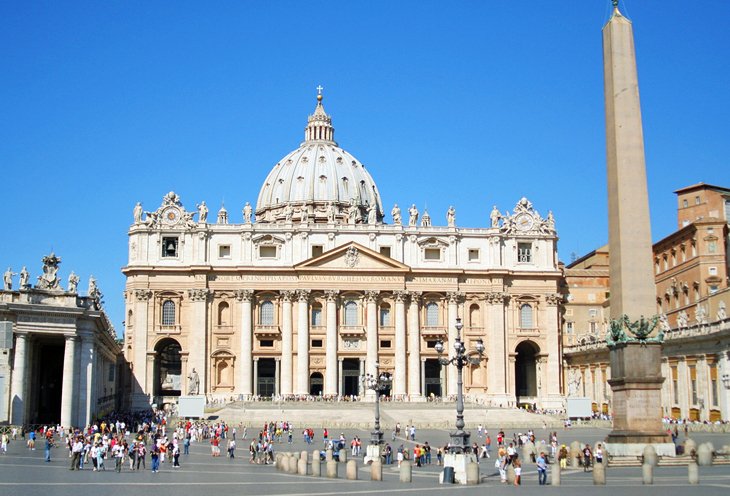
The Vatican is the smallest independent state in the world , with an area of less than half a square kilometer, most of it enclosed by the Vatican walls.
Inside are the Vatican palace and gardens, St. Peter's Basilica , and St. Peter's Square , an area ruled by the Pope, supreme head of the Roman Catholic Church. This compact space offers a lot of things to see, between its museums and the great basilica itself.
Inside St. Peter's Basilica is Michelangelo's masterpiece, Pieta , along with statuary and altars by Bernini and others.
The unquestioned highlight of the Vatican museums is the Sistine Chapel , whose magnificent frescoed ceiling is Michelangelo's most famous work.
In the Vatican Palace are the Raphael Rooms ; the Borgia Apartments ; the Vatican Library , and a number of museums that include the Picture Gallery, Museum of Secular Art, Etruscan Museum, and others. The collections you can see in these cover everything from papal coaches to 20th-century art reflecting religious themes.
Ticket lines for the Vatican's attractions are incredibly long, and you can spend several hours waiting in line. To save time, purchase a Skip the Line: Vatican Museums with St. Peter's, Sistine Chapel, and Small-Group Upgrade tour in advance. This three-hour tour allows you to bypass the long lines and walk straight into the museums with a knowledgeable guide. Headsets are provided, and you can choose from several different departure times or upgrade to an evening or small-group tour.

The Pantheon - the best-preserved monument of Roman antiquity - is remarkably intact for its 2000 years. This is despite the fact that Pope Gregory III removed the gilded bronze roof tiles, and Pope Urban VIII ordered its bronze roof stripped and melted down to cast the canopy over the altar in St. Peter's and cannons for Castel Sant'Angelo.
The Pantheon was rebuilt after damage by fire in AD 80, and the resulting brickwork shows the extraordinarily high technical mastery of Roman builders. Its 43-meter dome, the supreme achievement of Roman interior architecture , hangs suspended without visible supports – these are well hidden inside the walls – and its nine-meter central opening is the building's only light source.
The harmonious effect of the interior is a result of its proportions: the height is the same as the diameter.
Although the first Christian emperors forbade using this pagan temple for worship, in 609 Pope Boniface IV dedicated it to the Virgin and all the Christian martyrs, and since then, it has become the burial place of Italian kings (Victor Emmanuel II is in the second niche on the right) and other famous Italians, including the painter, Raphael.
Author's Tip: If you visit the Pantheon on a rainy day, be careful of the floor in the center. There is no umbrella over the hole in the roof, and the floor can get very slippery when wet.
- Read More: Visiting the Pantheon in Rome: Highlights, Tips & Tours
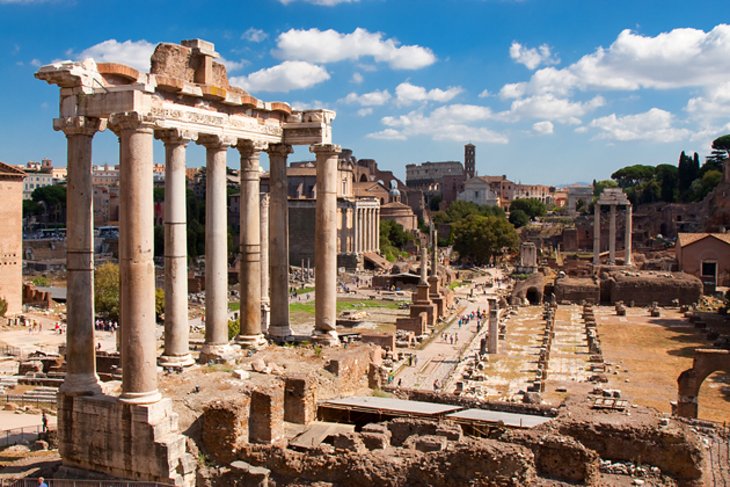
Walking through the forum, now in the middle of a throbbing modern city, is like stepping back two millennia into the heart of ancient Rome. Although what survives of this center of Roman life and government shows only a small fraction of its original splendor, the standing and fallen columns, its triumphal arches, and the remains of its walls still impress, especially when you consider that for centuries, the history of the Forum was the history of the Roman Empire and of the Western world.
Roman political and religious life was centered here, along with the courts, markets, and meeting places. After the seventh century, the buildings fell into ruin, and churches and fortresses were built amid the ancient remains. Its stones were quarried for other buildings and it was not until the 18th and 19th centuries that systematic excavations brought the ancient buildings to light from under a 10-meter layer of earth and rubble.
Highlights of the Roman Forum are the Temple of Antoninus Pius, the Temple of Castor and Pollux, the Temple of Saturn, the Arch of Septimus Severus, the Curia, the Temple of Vesta, and the Arch of Titus.
Tip for Parents: If you're traveling in Rome with children, unless they are fascinated by the Romans, the Forum might be a place best seen from above, instead of by walking through its five acres of largely ruined buildings. It is one of Rome's most popular and important tourist attractions, but it's a lot for kids to take in and it doesn't have the lure of the Colosseum's tales of lions and gladiators.
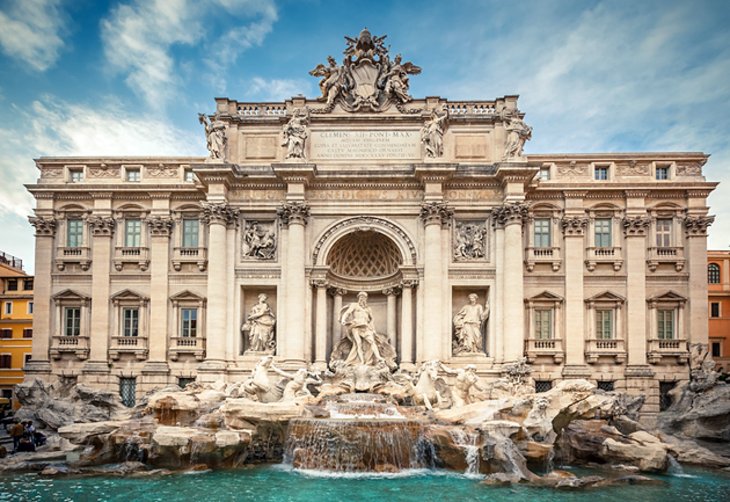
One of the city's most popular tourist attractions, this 17th-century masterpiece has been immortalized in films until it is almost a required visit. Throwing a coin (not three) into the Trevi Fountain (Fontana di Trevi) is a tradition that is supposed to assure your return to Rome.
Rome's largest fountain, Fontana di Trevi is supplied by an aqueduct originally constructed by Agrippa, the great art patron of the first century BC, to bring water to his baths. The fountain was created for Pope Clement XII between 1732 and 1751 by Nicolò Salvi, and built against the rear wall of the palace of the Dukes of Poli.
It depicts the sea god Oceanus (Neptune), with horses, tritons, and shells. The water swirls around the figures and the artificial rocks and collects in a large basin, always filled with coins.
What happens to all that money? Twice a year it is gathered using long-handled brushes, and donated to Caritas, Rome's Catholic charity.
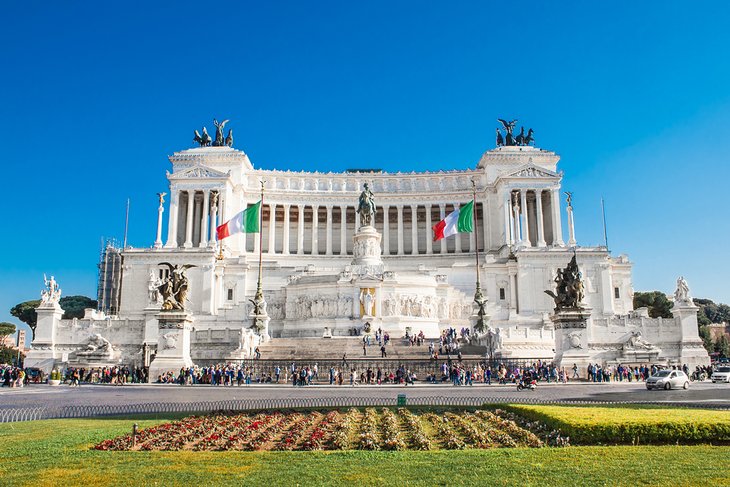
It's ironic that this grandiose monument, considered one of the national symbols of Italy, is rarely admired by Romans, who liken it to a wedding cake or a giant typewriter. Like it or not, the vast neo-classical structure crowns Capitoline Hill, the symbolic center of ancient Rome, overlooking the later city across Piazza Venezia.
Built between 1885 and 1935, it is a monument to King Vittorio Emanuele II, the first king of the unified Italy, represented here in an equestrian statue. Italy's tomb of the unknown soldier is here, along with a museum of the Italian unification. A lift will take you to the topmost terrace for 360-degree views of Rome.
Address: Piazza Venezia, Rome
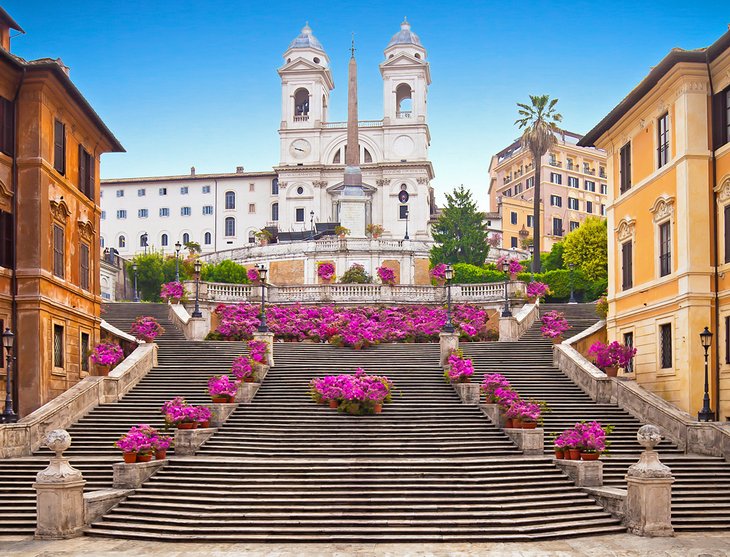
Take a look at a Rome tourist map, and you'll see one area so filled with things to do that it's hard to read the street names. This is the Centro Storico, the historic center of Rome , with so many art-filled churches, resplendent palaces, and lively squares that you could spend your whole vacation strolling its ancient streets and lanes.
Spend some time just to absorb the neighborhood's atmosphere instead of going from one of its must-see sights to the next. Along with Piazza Navona , the Trevi Fountain , and the Basilica of Santa Maria Maggiore , stop in less well-known churches, such as Santa Maria del Popolo, where you'll find works by Bernini and Caravaggio.
Pause at the Spanish Steps, the flight of irregular stairs and landings that lead up to the French church of Trinità dei Monti. The stairs take their name from Piazza di Spagna , the plaza at their base and one of Rome's most typical squares. The stairs have long been a favorite haunt of tourists.
You can no longer channel your inner Audrey Hepburn and eat gelato on the steps as she did in Roman Holiday . Sitting or eating on the steps is banned to protect them after a complete cleaning and restoration, and the ban is enforced.
The boat-shaped fountain at the foot of the Spanish Steps is known as the Barcaccia and was created by Pietro Bernini, father of the great Baroque architect Gian Lorenzo Bernini.
Via Condotti , leading southwest from Piazza di Spagna, is Rome's most fashionable shopping street , where the Caffè Greco is famous for the artists, writers, and musicians who have frequented it.
Address: Piazza di Spagna, Rome
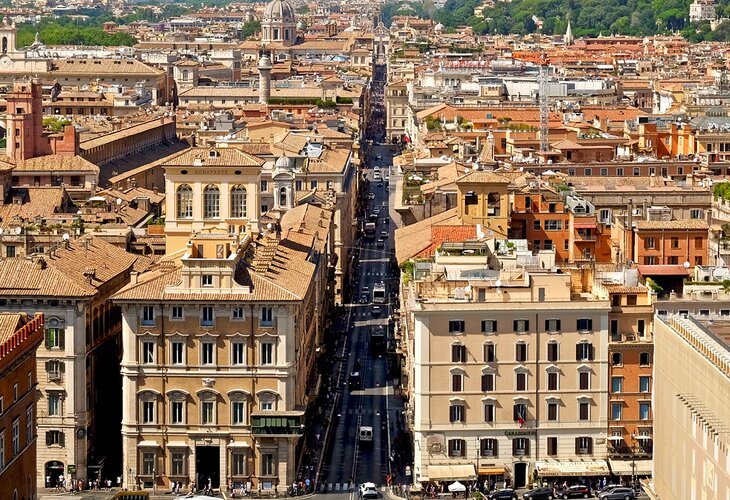
Marking a straight line from Piazza the Piazza Venezia to Piazza del Popolo, Via del Corso is Rome's Main Street . Lined with shops and places to eat, and a few palaces housing art museums, including the magnificent Palazzo Doria Pamphilj. Work is underway to restore and re-design the century-old landmark Alberto Sordi Gallery, which will reopen as Agorà, with fewer shops and more public space for arts and entertainment.
While the shops are mostly name brands, you'll find some designer boutiques here and on the radiating side streets. Not all of Italy's fashion comes from Milan's catwalks, and fashionistas will find more high-end boutiques and prestigious names on streets around Piazza di Spagna, especially Via Venizia and Via dei Condotti .
Between Piazza del Popolo, at the end of Via del Corso, and Piazza di Spagna, look for antique shops and art galleries on Via del Babuino . To mix charm and cinema history with shopping, and find small shops and galleries on the parallel Via Margutta .
Note to Movie Fans: Federico Fellini lived on Via Margutta and Gregory Peck's apartment scenes in Roman Holiday were filmed at No. 51.
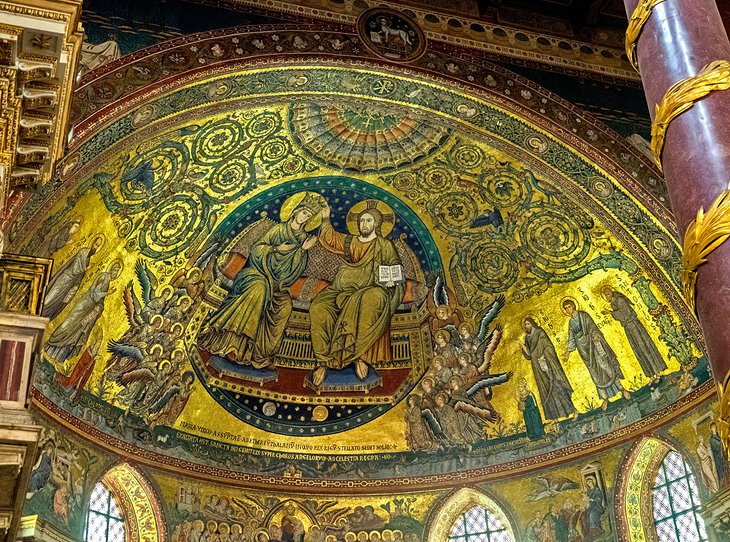
One of the most majestic of the churches in Rome , Santa Maria Maggiore has stood here since the fourth-century Pope Liberius had a vision of the Virgin directing him to build a church where snow fell the following day. Although it was August, snow did fall on the Esquiline hill the next morning, so here the great basilica was built.
Mass has been celebrated here every day since the fifth century. The three aisles of its 86-meter-long interior are separated by 40 columns of marble and four of granite, and the apse added in the 13th century is lined with mosaics of Old and New Testament themes, masterpieces of Rome's famous mosaic artists.
Rome's oldest mosaics, as old as the fourth century, decorate the upper walls, and the floor is inlaid with colored stone in the style of the expert 12th-century artisans of the Lake Como region. The first gold to reach Italy from the Americas shines on the coffered ceiling. Two popes are buried here; it's one of Rome's four papal basilicas, an important place of pilgrimage.
Author's Tip: Although admission to Rome's churches is free, you may need to put a euro in the meter to illuminate some artworks or chapels. Keep some coins handy for a better look at the mosaics in Santa Maria Maggiore. It is also a nice gesture to put a few coins in the offering boxes to help the churches maintain their priceless treasures.
Address: Piazza di Santa Maria Maggiore, Rome
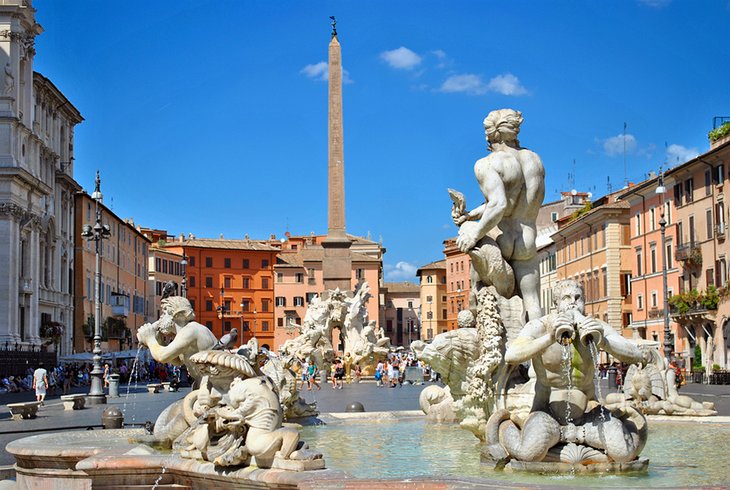
One of Rome's most characteristic Baroque squares, Piazza Navona still has the outline of the Roman stadium built here by Emperor Domitian. It was still used for festivals and horse races during the Middle Ages, and was rebuilt in the Baroque style by Borromini, who also designed the magnificent series of palaces and the church of Sant'Agnese, on its west side.
Its facade, campanile, and dome highlight the way Baroque architecture weaves convex and concave surfaces, gables, windows, columns, and piers into a unified design. In the crypt of Sant'Agnese are Alessandro Algardi's 1653 The Miracle of St. Agnes and the remains of a Roman mosaic floor. Sant'Agnese provided a model for Baroque and Rococo churches in Italy and elsewhere.
Although Borromini designed the square and its surrounding facades, it was his archrival, Bernini, who created its centerpiece, the beautiful Baroque fountain, Fontana dei Fiumi . The spirited fountain represents the four rivers then thought to be the largest on each of the known continents, with figures personifying the Nile, Ganges, Danube, and Rio de la Plata around the large basin, each accompanied by plants and animals of their respective regions.
The two other fountains in the square are the 16th-century Fontana del Moro in front of the Palazzo Pamphili, erected by Giacomo della Porta, and the 19th-century Fontana del Nettuno with its figure of Neptune. Today, the square is filled with Romans, tourists, street artists, musicians, souvenir kiosks, cafés, and during December, one of Rome's best Christmas markets.
Nearby, between the Piazza and the Pantheon, the church of San Luigi dei Francesi contains three major paintings by Caravaggio from the late 16th century, including one of his most famous, The Calling of St. Matthew. No information about the paintings is available in the church, but you can download an audio guide in English on the San Luigi dei Francesi website. The church itself is worth seeing for its elaborate ceiling and inlaid marble floors. Like others in Rome, the church is free to enter
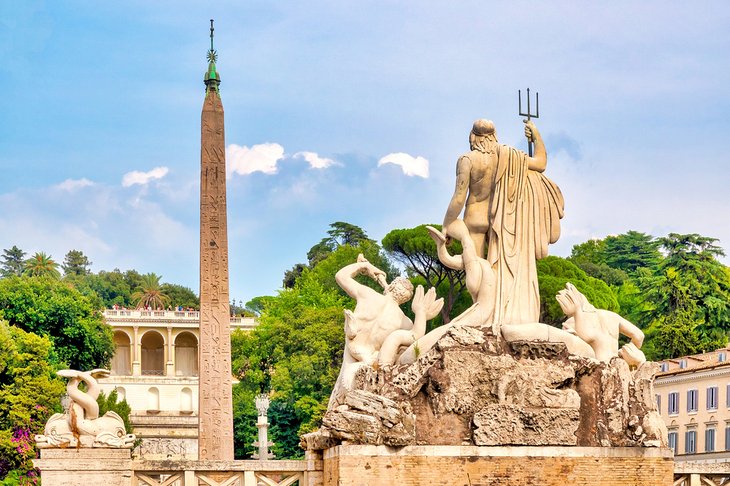
Symmetrically situated at the apex of a triangle of streets that include Via Corso, Rome's main shopping street, Piazza del Popolo was designed in the early 19 th century as the northern entrance to the city center. At its center, the Egyptian obelisk, called Flaminio, rises above a fountain, where four white marble lions spout fans of water into four round travertine pools.
Facing one side like mirror images at either side of Via della Corso are the twin churches of Santa Maria dei Miracoli and Santa Maria in Montesanto, and at the opposite side of the grand piazza is the Augustinian Basilica of Santa Maria del Popolo.
Inside, you'll find Pinturicchio frescoes and two tombs by Andrea Sansovino in the choir, and two beautiful chapels. The Chigi Chapel was designed by Raphael in 1515, and the Cesari Chapel holds two important Caravaggio paintings.
Next to the basilica, climb the steps to the Pincio Terrace for views down onto the piazza and across the city of Rome.
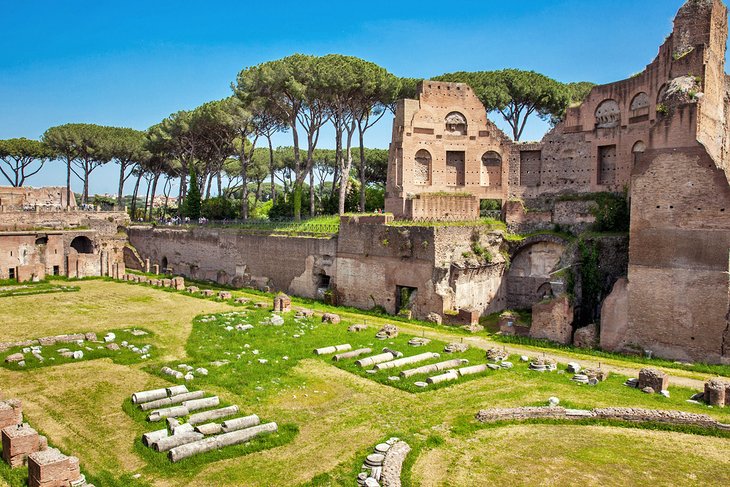
Strategically set 50 meters above the Tiber, the Palatine Hill shows evidence of Rome's earliest settlement: rock cuttings found in front of the Temple of Cybele show human activity as long ago as the ninth century BC. Later, this was the site chosen by the emperors and great aristocratic families for their palaces.
The Farnese Gardens were laid out on the hill in the 16th century for Cardinal Alessandro Farnese, a pleasure park of terraces, pavilions, lawns, flowerbeds, trees, and fountains designed as a kind of stage-setting for social gatherings.
Highlights of the Palatine Hill are the House of Livia (Augustus' wife), the semi-subterranean Cryptoporticus , Domus Flavia , Domus Augustana, and most imposing of all, the Baths of Septimius Severus. The Palatine Hill is a lovely place to explore, combining a park with magnificent and impressive ruins of ancient Rome.
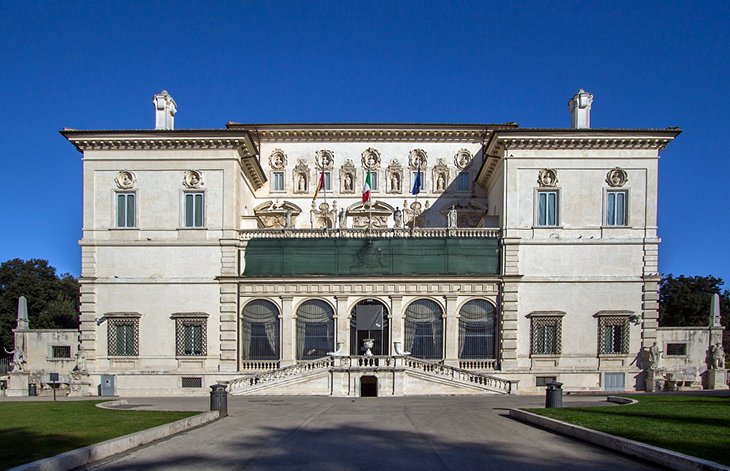
One of Rome's largest parks, the Borghese Gardens contain multiple attractions that include two museums, the most prominent of which is the Villa Borghese. Built as a party villa and to house the Borghese art collection, the gallery contains paintings, sculptures, mosaics, and reliefs, most from the 15th to the 18th century, and include works by Raphael, Titian, Caravaggio, Bernini, Dürer, and Rubens .
Elsewhere in the park, Villa Giulia was built as a summer residence for the 16th-century Pope Julius III and houses the Etruscan Museum . More villas are from the world exposition that was held in Rome in 1911.
The park is an English-style landscape garden, with walking paths and ponds where you can rent row boats. You can also rent bikes or a surrey to explore the park. There is a good zoo, Bioparco di Roma , with naturalized enclosures and a miniature trail connecting its various sections. A number of its attractions will appeal to children, including playgrounds, weekend pony rides, and occasional puppet shows.
Many of its attractions will appeal to children , including playgrounds, weekend pony rides, and occasional puppet shows, making it one of the most popular things to do in Rome for families .
One of the secrets of the Borghese Gardens is the replica of Shakespeare's Globe Theatre, where you can watch opera performances or Shakespeare plays. Plays are always in Italian, but an occasional opera is in English. You can rent a cushion and sit on the floor or you can sit in the balconies that ring the interior.
Address: Piazzale del Museo Borghese, 5
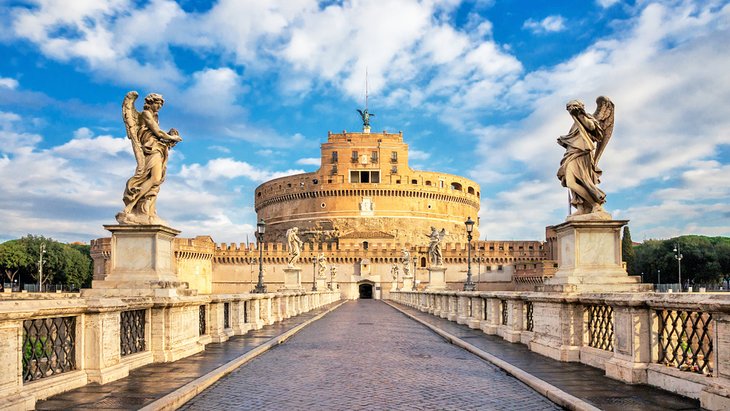
Begun in AD 135 as a mausoleum for the Emperor Hadrian and his family, Castel Sant'Angelo is a massive drum-shaped structure overlooking the Tiber near the Vatican. Over the millennia of its existence, Castel Sant'Angelo has been used as a papal residence and a fortress, and more recently as a National Museum.
In AD 271, Emperor Aurelian took advantage of its position guarding the northern approaches to the city and incorporated it into his new system of walls surrounding the city. As a bastion, it protected the city from barbarian attacks, and by the Middle Ages had become a substantial fortress. In times of peril, popes fled here across a secret elevated corridor, the Passetto di Borgo , and stored their most precious riches in the castle's treasury.
Visitors reach the castle across a pedestrian bridge lined with statues of angels (by Bernini), and ascend to its five floors on a spiral ramp. At its various levels are prison cells, a large collection of weapons, and splendidly decorated papal apartments covered in Renaissance frescoes. At the top is a terrace with stunning views of the city.
Address: Lungotevere Castello 50, Rome
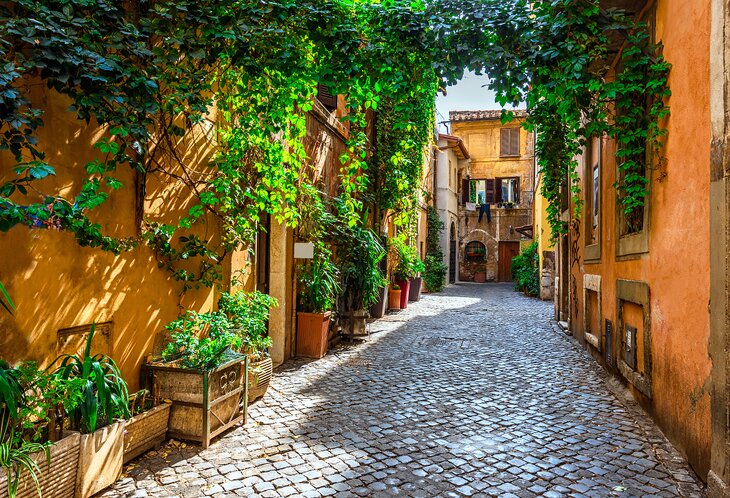
Across the Tiber River and off the most popular tourist routes, Trastevere feels like an earlier Rome, with its medieval lanes and narrow alleys . You'll find bits of Roman stonework in its old buildings, and occasional inscriptions that remind you that this was for three centuries the Jewish Ghetto, its gates closed and guarded at night.
Today it is a charming neighborhood with two outstanding churches that are rarely on tourist itineraries. In the third century, before Rome's Jewish population gravitated to this side of the river, Santa Maria in Trastevere was one of the first places where Christians could worship except in secret.
Renovated several times, the last in the Baroque period, the church interior is decorated with patterned marble floors, a gold-washed coffered ceiling, and exceptional medieval mosaics. Also with good mosaics, and a fine 13 th -century fresco, Santa Cecilia in Trastevere hides the foundations of a Roman home.
Author's Tip: It's no secret that Trastevere is a good place to find restaurants serving authentic Roman dishes, but you'll find them less crowded than those in the popular tourist areas.
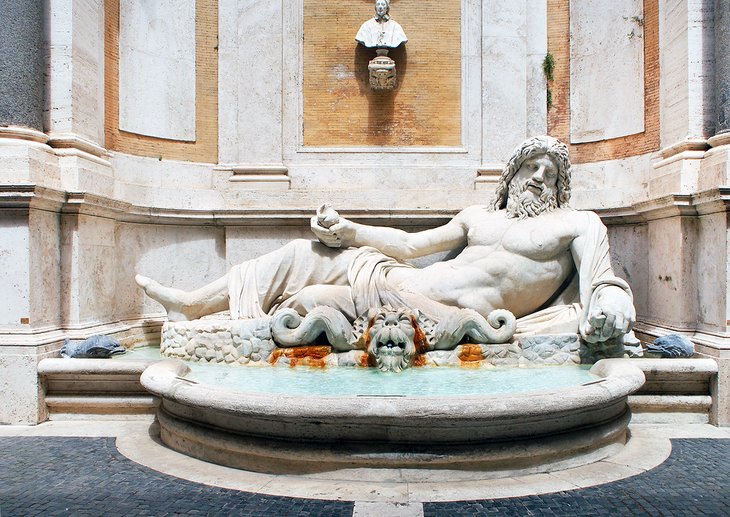
Two palaces on Piazza del Campidoglio house Europe's oldest public collection of art, founded in 1471. Primarily devoted to sculptures from across the ancient world, the highlights of the Capitoline Museum treasures include the realistic Hellenistic bronze Boy with a Thorn ; Capitoline Venus , from a 4 th -century BC original by Praxiteles; a 4.24-meter-tall Roman equestrian statue of Marcus Aurelius; a Roman sculpture of the Dying Gaul ; and the Capitoline She-Wolf , an Etruscan work from the 6th century BC.
More "modern" sculptures include a head of Medusa, by the 17 th -century Baroque sculptor Gian Lorenzo Bernini. Although the Capitoline Museum is best known for its outstanding collection of classical sculptures, its Capitoline Picture Gallery exhibits paintings by Titian, Veronese, and Rubens, along with Caravaggio's compelling John the Baptist.
Address: Piazza del Campidoglio, Rome
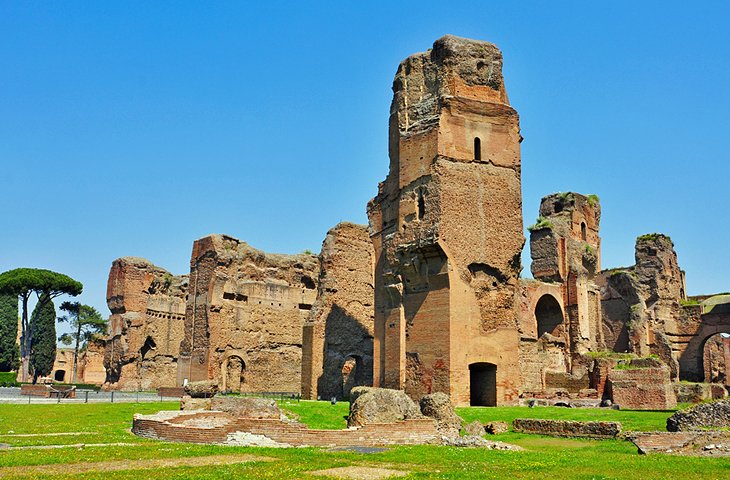
Completed by Caracalla in 216, these were much more than public baths. They were a complete sports center, with hot and cold baths, a swimming pool, dry and steam saunas, gymnastics and sports facilities, social rooms, gardens, libraries, hairdressers, and shops.
The massive and imposing structure covered an area of 300 square meters, a complex of gigantic halls whose domes and vaulting were supported by huge columns and piers. It could accommodate 1,500 people at a time. The floors and walls were covered with marble, mosaics, and frescoes; even in ruin, their splendor is still evident.
Address: Via delle Terme di Caracalla 52, Rome
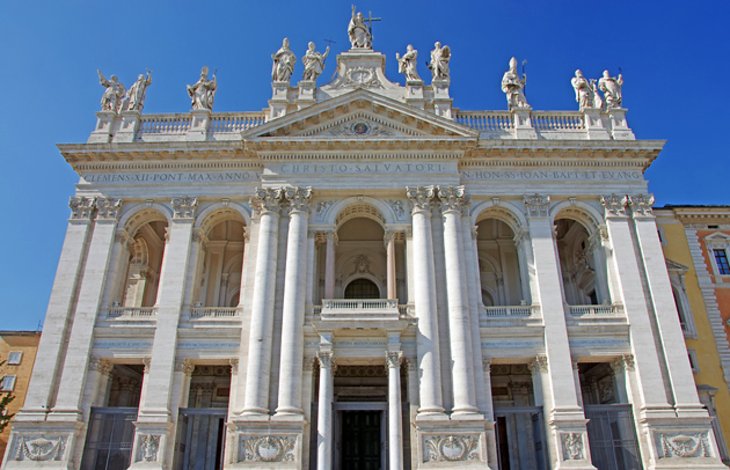
As you might expect for the episcopal church of the Pope, St. John Lateran is one of Rome's most impressive churches. After centuries of alterations, it still retains its original form from the age of Constantine, when it was built.
Its façade, by contrast, is a purely Baroque embellishment and a fine example of that period. Along with the mosaics in the apse, be sure to notice the beautiful 16th-century wooden ceiling. If the octagonal baptistery, San Giovanni in Fonte , looks a bit familiar, it's because it provided the model for later ones throughout Europe.
Built by Constantine, it is the world's oldest Christian baptistery. Across the piazza, in the church of the Scala Santa, is the Holy Staircase, 28 steps believed to have been brought to Rome in the fourth century by St. Helen, from Pilate's palace in Jerusalem.
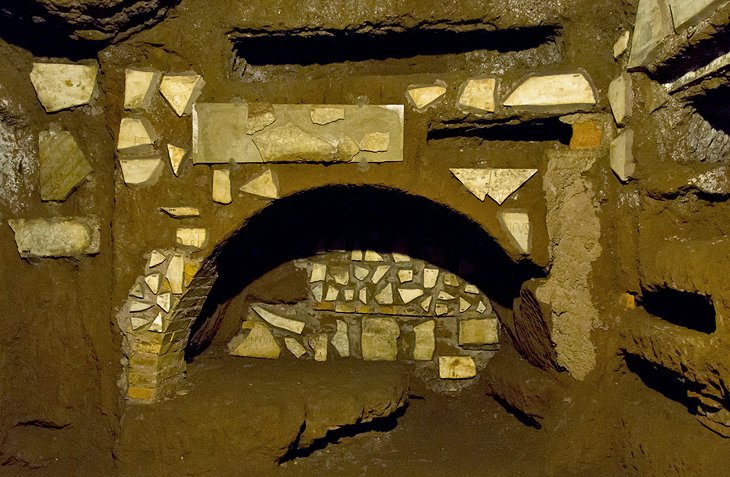
The Catacombs of San Callisto (St. Calixtus) and San Sebastiano , both underground burial places in the Via Appia Antica, are extensive — the San Callista Catacomb fills an area of 300 by 400 meters — with intricate multi-layered networks of passages and chambers carved into the soft tufa. In addition to the tombs, St. Calixtus has six sacramental chapels, constructed between 290 and 310, with both pagan and early Christian wall paintings.
In the Papal Crypt are the tombs of most of the martyred Popes of the third century identified by Greek inscriptions. San Sebastiano, one of Rome's seven pilgrimage churches, was built in the fourth century on the site of old cemeteries and catacombs that, along with the foundations of a Constantinian basilica, can be explored.
Tomb chambers are on several levels with fine paintings, stucco decorations, and inscriptions dating to the first century AD. Although venerated remains are thought to have been brought here for safekeeping during persecutions, these were cemeteries, not hiding places for Christians.
A little west of the Via Appia Antica, not far from the catacombs of San Callisto, the Catacombs of Domitilla are the largest and among the most impressive in Rome, with 15 kilometers of underground chambers and passages and a complete subterranean basilica.
Dedicated to the martyred saints entombed there, Nereus and Achilleus, the basilica was a major pilgrimage destination until the Middle Ages. More than 80 painted tombs and a second-century fresco of The Last Supper survive in its galleries.
Outside the Porta San Sebastiano, the Arch of Drusus is near the beginning of the Via Appia Antica, one of the oldest and most important of the Roman highways, built around 300 BC and extended to the port of Brindisi about 190 BC.
Running parallel with the road are the ruins of some of the aqueducts that supplied the city with water, and among the cypresses along its sides are remains of tombs belonging to aristocratic Roman families. The most prominent of these is the first-century tomb of Caecilia Metella and her husband.
Address: Via Appia Antica, Rome
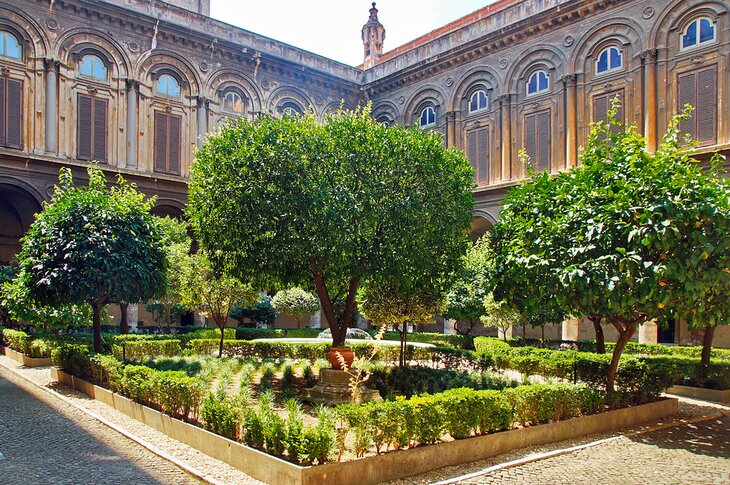
Rome's finest private collection of art is displayed in the magnificent Baroque galleries, state rooms, and chapel of the Palazzo Doria Pamphilj. Representing works by European masters from the 15 th through the 18 th centuries, the collections include paintings by Filippo Lippi, Brueghel the Elder, Correggio, and Raphael, along with major works by Caravaggio ( Rest in the Flight into Egypt) and Titian ( Salome with the Head of John the Baptist).
Velázquez's Portrait of Innocent X is one of the collection's highlights. Another image of the same Pope is a sculpture by Bernini. The palace itself almost outshines its contents, with frescoed ceilings and Baroque decoration; a good audio guide in English enlivens the tour. The gardens are beautiful, with an intricately patterned parterre with labyrinth elements.
Address: Via del Corso 305, Rome
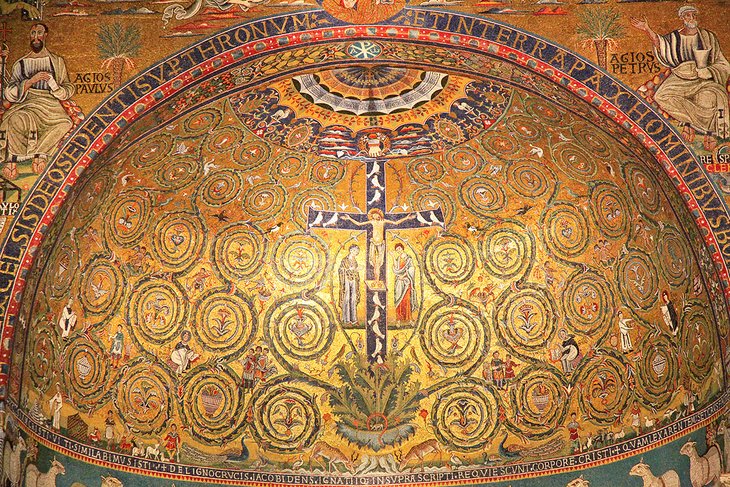
One of Rome's oldest churches and with the city's most beautifully decorated apse, covered in mosaics of Old and New Testament scenes, San Clemente has a further fascination: the multiple layers of its history as each era built upon the last.
You can descend from the 12 th -century church into a previous church, a 4 th -century basilica with Romanesque frescoes of New Testament scenes. Below that are the excavated foundations of a Roman home from the 2 nd century AD, with a shrine to the sun god Mithra, with a carved relief on the altar. From the foundations of the house, you can walk on the ancient streets of this former Roman neighborhood.
But do take time to look around the upper church, to see the mosaics, the inlaid marble floors, and the early Renaissance frescoes by Masolino in the St. Catherine's Chapel.
Address: Via San Giovanni in Laterano 108, Rome
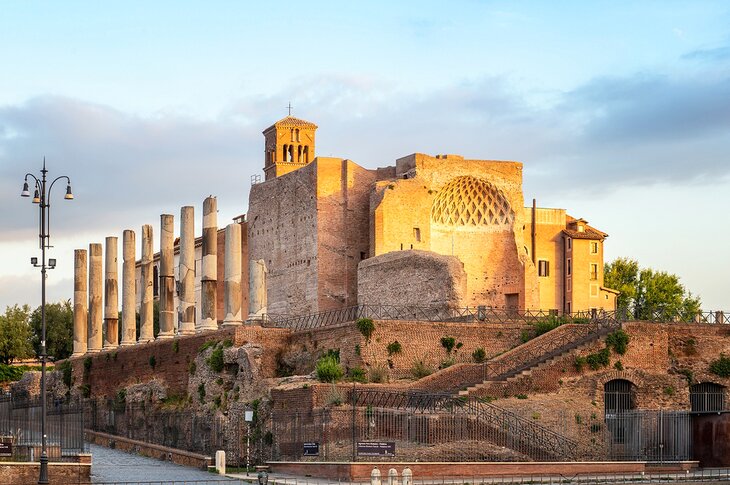
In July of 64 CE, a six-day fire destroyed almost three-fourths of the city. The cruel and unpopular emperor Nero took advantage of the cleared land to build a palace of unheard-of proportions, the Domus Aurea, or Golden House. Rooms were lined in rare marble and elaborately decorated in gold and precious stones.
The palace was never finished, and Nero's successors, attempting to erase all memory of the hated ruler and his reign, buried it, and Rome grew over it. Excavations continue to disclose more of its splendors, and you can tour the active archaeological site to see the halls and rooms that have been uncovered, some with excellent frescoes.
With the help of a video outlining the history and virtual reality technology that recreates the atrium and one hall , you can get a sense of what the palace looked like in Nero's time. Both are included in tours.
Tip: Even on the hottest days, bring something with long sleeves, as the underground excavations site is quite cold year-round.
Historical Note: Did Nero really fiddle while Rome burned? Although he took advantage of the destroyed city to build his extravagant villa, and there was disgruntled mumbling at the time that he had ordered the fire set to clear the land, no historical evidence or contemporary account mentions his playing any musical instrument.
Address: Via della Domus Aurea, Rome
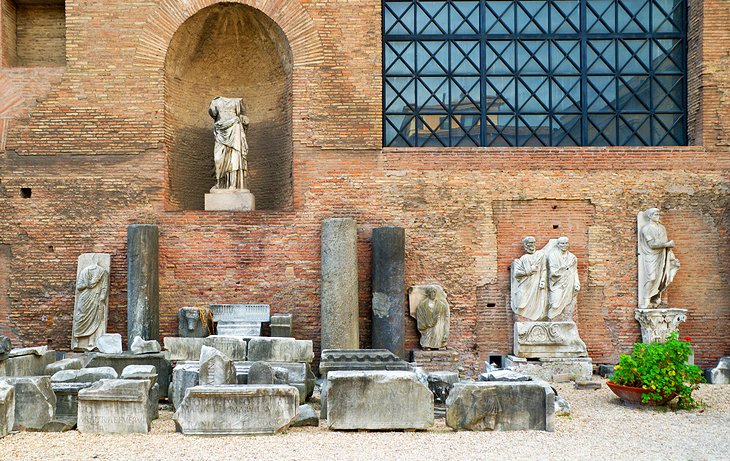
Diocletian's baths were so enormous that today, they contain two churches, large parts of a Carthusian monastery and a major museum. Michelangelo used the vast tepidarium (hot baths) as the shell for his church of Santa Maria degli Angeli , and the Museo Nazionale Romano , Rome's National Museum, fills another section with treasures of antiquity: Greek and Roman sculpture, pre-Christian and later sarcophagi, and beautiful mosaics and frescoes.
The late-16th-century church of San Bernardo alle Terme was built in a rotunda at the corner of the baths; its dome is like that of the Pantheon, but only half its size.
While Rome's main tourist attractions don't exactly cluster, most of the major ones are within a 20- to 30-minute walk of each other, so several areas are convenient for sightseeing. The Monti neighborhood is perhaps the most central to the Forum, Colosseum, Trevi Fountain, and even the Spanish Steps and Borghese Gardens. Here are some highly rated hotels in Rome's best locations for sightseeing:
Luxury Hotels :
- Palazzo Manfredi - Relais & Chateaux is next to the Colosseum, and you can overlook it while enjoying breakfast in the rooftop restaurant.
- Boutique Hotel Campo de Fiori has a rooftop garden overlooking the colorful daily market in one of Rome's most traditional neighborhoods, near the Pantheon and an easy walk from Palatine Hill and the Vatican.
- Two blocks from the Colosseum, Hotel Capo d'Africa is in a neighborhood filled with small restaurants.
Mid-Range Hotels:
- The four-star Mercure Roma Centro Colosseo is an easy walk from the Colosseum, which you can see from the hotel's rooftop swimming pool and from some of the guest rooms.
- In Monti, close to both the Colosseum and Forum, Hotel Fori Imperiali Cavalieri is surrounded by restaurants and shopping.
- Opposite the Opera House in Monti, iQ Hotel Roma has a covered rooftop terrace and modern décor.
Budget Hotels:
- Amid restaurants and shops in Monti, between the Forum and opera house, Hotel Artorius is not adjacent to any major attractions, but lies within a 20- to 30-minute walk from the Forum, Colosseum, Trevi Fountain, Vittoriano, and museums.
- Also in the lively Monte neighborhood, and an easy walk from the Colosseum and other attractions of ancient Rome, Hotel Grifo offers a rooftop terrace and free breakfast.
- On the west bank of the Tiber, south of Vatican City, Trastevere is one of the city's most colorful neighborhoods. Although Trastevere has several small B&Bs, Cassiodoro is one of its few hotels, surrounded by traditional restaurants and shops.
- Sightseeing Tour by Bus : For maximum flexibility while you're seeing all the top attractions, sign up for the Rome Hop-On Hop-Off Sightseeing Tour on an open-air double-decker bus. Accompanied by audio commentary, this convenient ticket covers all the top sights, with eight different stops, and you can hop on and off at your favorite attractions. You can choose a tour that's valid for either 24 or 48 hours and upgrade to packages that include time-saving skip-the-line admission to attractions like Palatine Hill, the Colosseum, and the Roman Forum.
- Segway Tour: Another way to see the top sights without worrying about navigating your way around the city is on the Rome Segway Tour . Included in this three-hour excursion are a brief orientation session, helmets, wet weather jackets (if needed), and audio commentary. Meet your guide near Piazza Venezia and see the sights of Ancient Rome, including the Colosseum, the Roman Forum, and Circus Maximus, learning all about them as you zoom around the city.
- Gladiator Experience : If you've always wondered what it's like to brandish a sword like Spartacus, consider signing up for the Roman Gladiator School: Learn How to Become a Gladiator experience on the Appian Way, near the Colosseum. This two-hour private lesson is suitable for anyone aged six years and older and includes entrance to the Gladiator School of Rome Museum as well as clothing and weapon hire.
- Tivoli Day Trip : Organized tours are a great way to explore the attractions in the beautiful countryside around Rome. You can relax and let a professional guide do the work without the hassle of driving, finding your way, and parking. On the Tivoli Day Trips from Rome: Villa d'Este and Hadrian's Villa tour, you can explore two World Heritage-listed historic villas, built as vacation homes for the Roman elite, as well as their gorgeous gardens. The tour includes transportation in a comfortable coach, villa admission, and headsets so you can easily hear the guide.
- Pompeii Day Trip : Another popular excursion is the Pompeii Day Trip from Rome . On this full-day tour, you can hike to the crater of Mt. Vesuvius (in summer) or visit the National Archeological Museum of Pompeii (November 16 through March 31), as well as see the sights of Pompeii. Entrance fees and lunch are included.
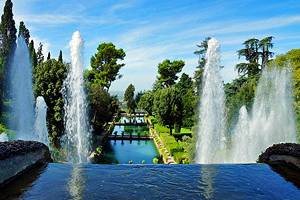
Where to Go near Rome: When you have seen Rome's ancient sites, you'll want to explore some of the city's surroundings. The town of Tivoli lies 30 kilometers east of Rome, with Hadrian's Villa and one of the most beautiful gardens in Italy .
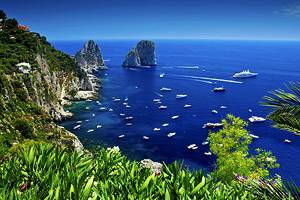
Places to Visit from Rome: In just over an hour by train, you can step into the exuberant street life of the vibrant city of Naples . From here, you are only a short ferry ride from the idyllic island of Capri , across the Bay of Naples. Or take a train the short distance to the ancient city of Pompeii , under the still smoldering cone of Mt. Vesuvius.
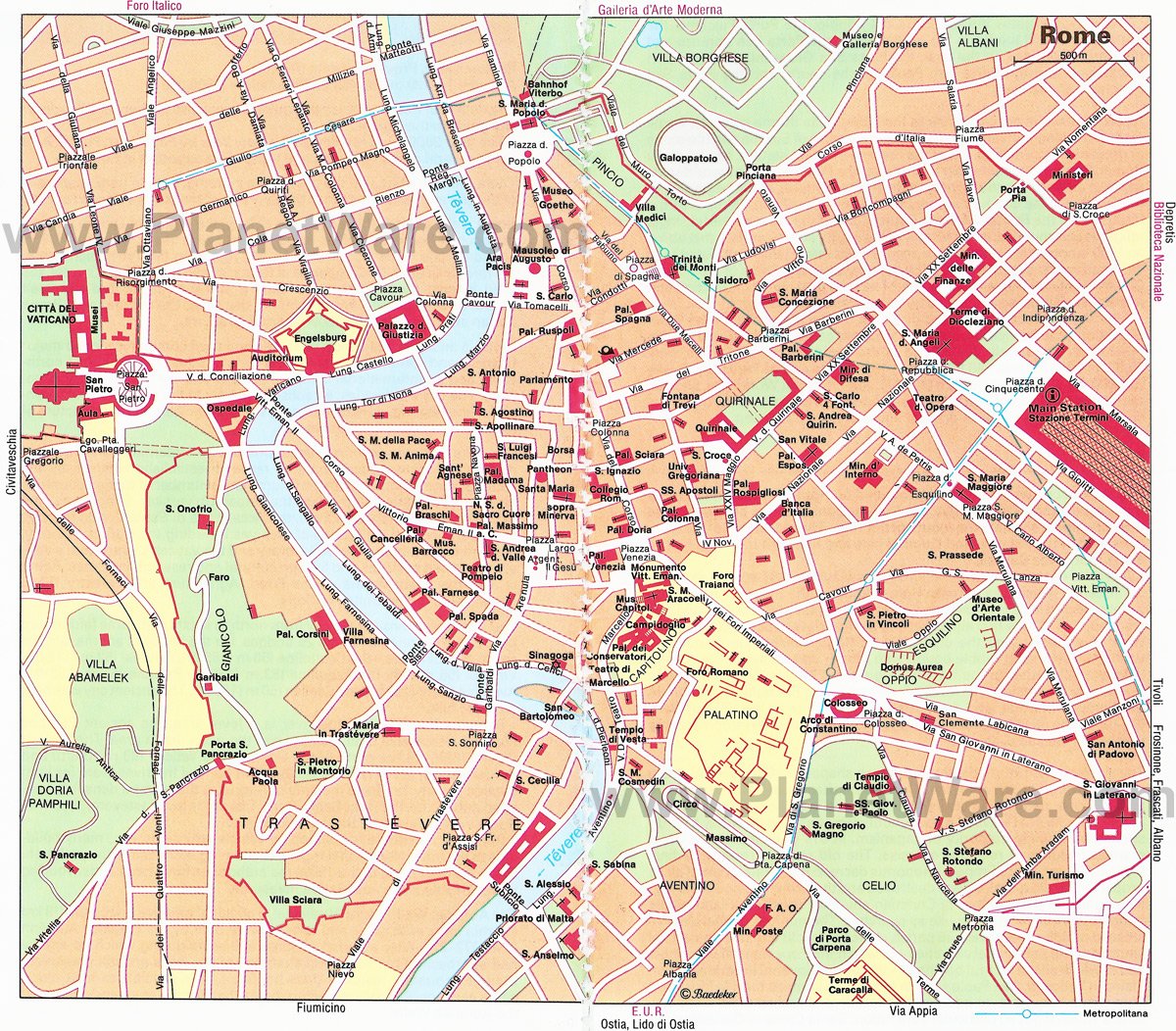
More on Italy

Must-see attractions in Ancient Rome
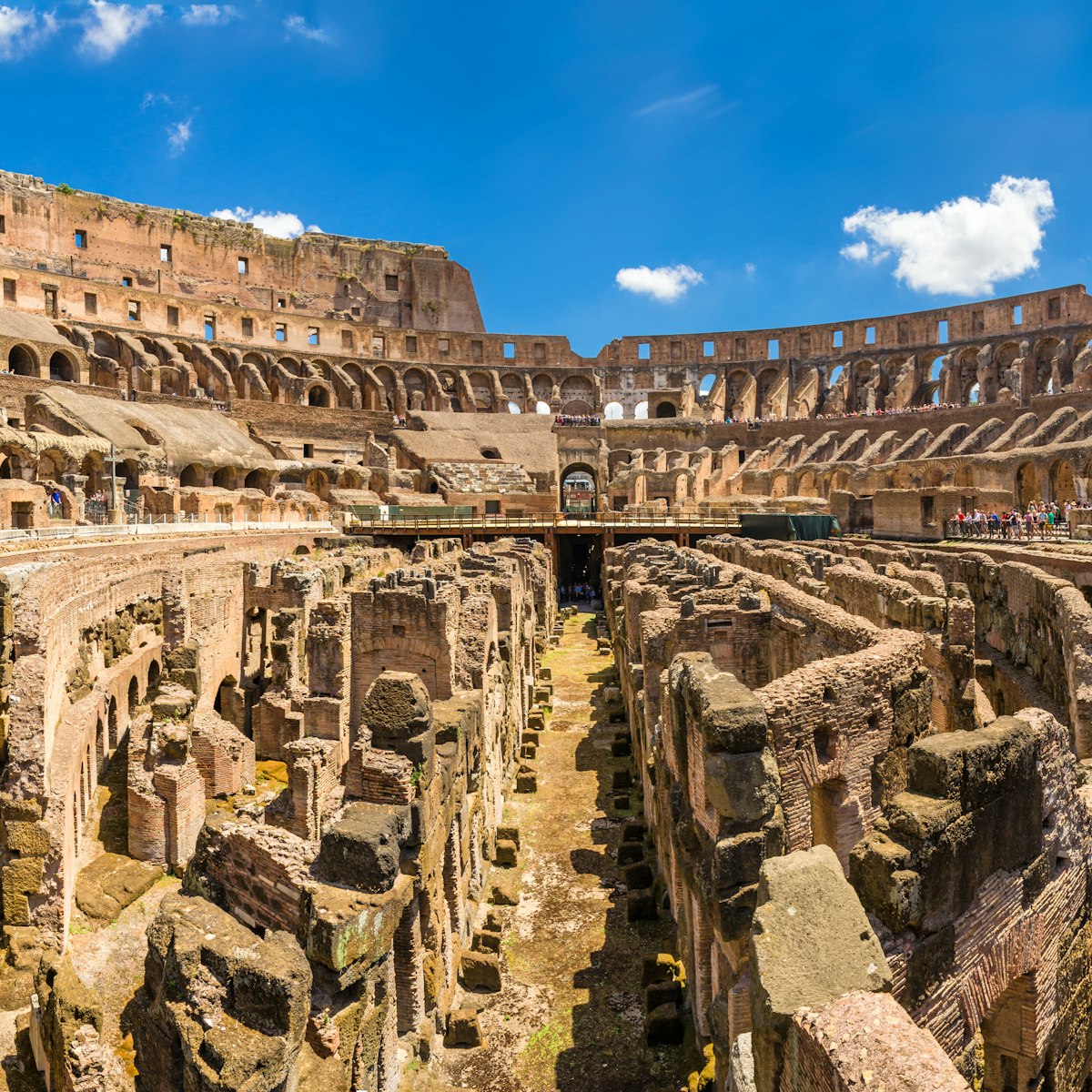
Ancient Rome
Everyone wants to see the Colosseum, and it doesn’t disappoint, especially if accompanied by tales of armored gladiators and hungry lions. More than any…
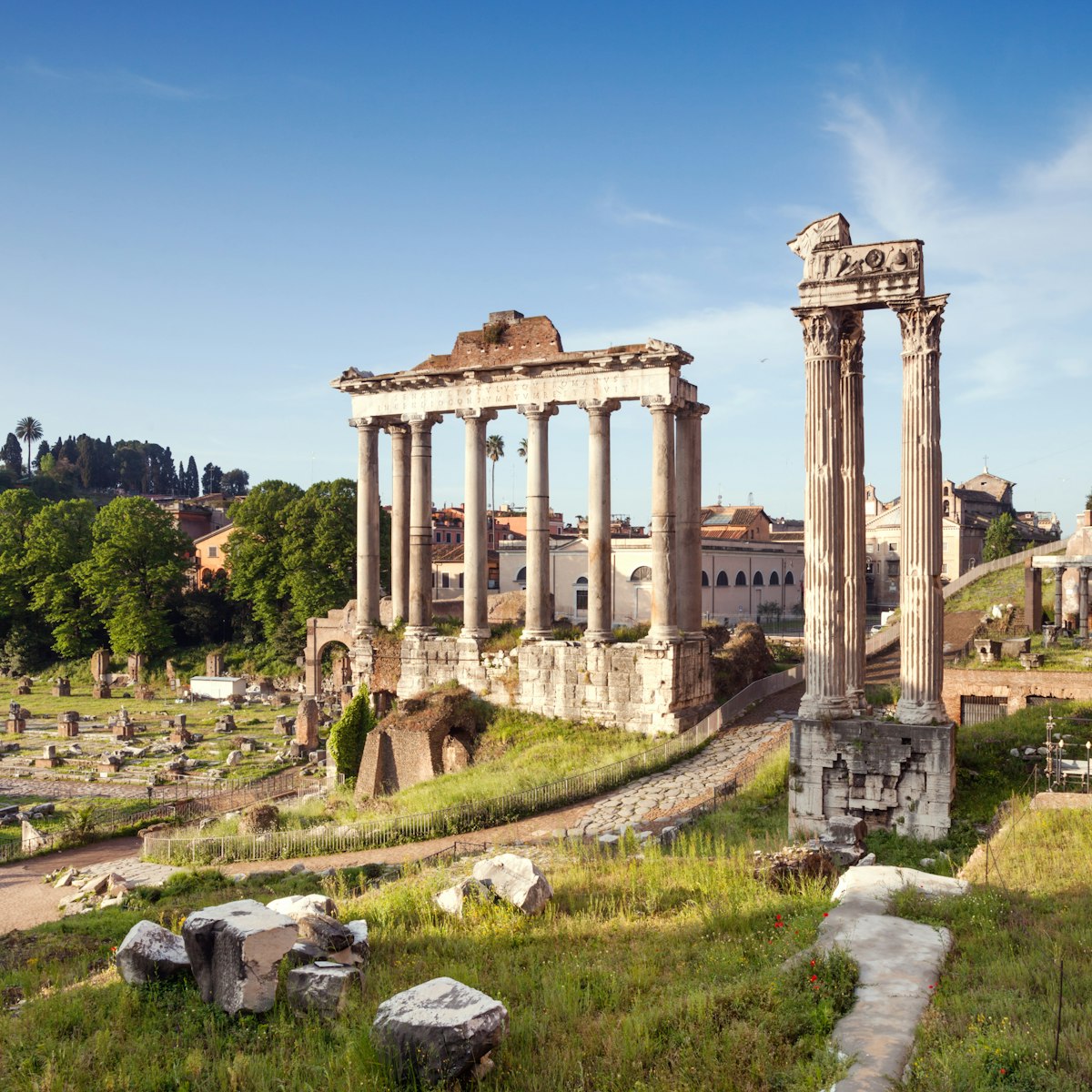
Roman Forum
An impressive – if rather confusing – sprawl of ruins, the Roman Forum was ancient Rome's showpiece center, a grandiose district of temples...

Sandwiched between the Roman Forum and the Circo Massimo, the Palatino (Palatine Hill) is one of Rome's most spectacular sights. It's a beautiful,…
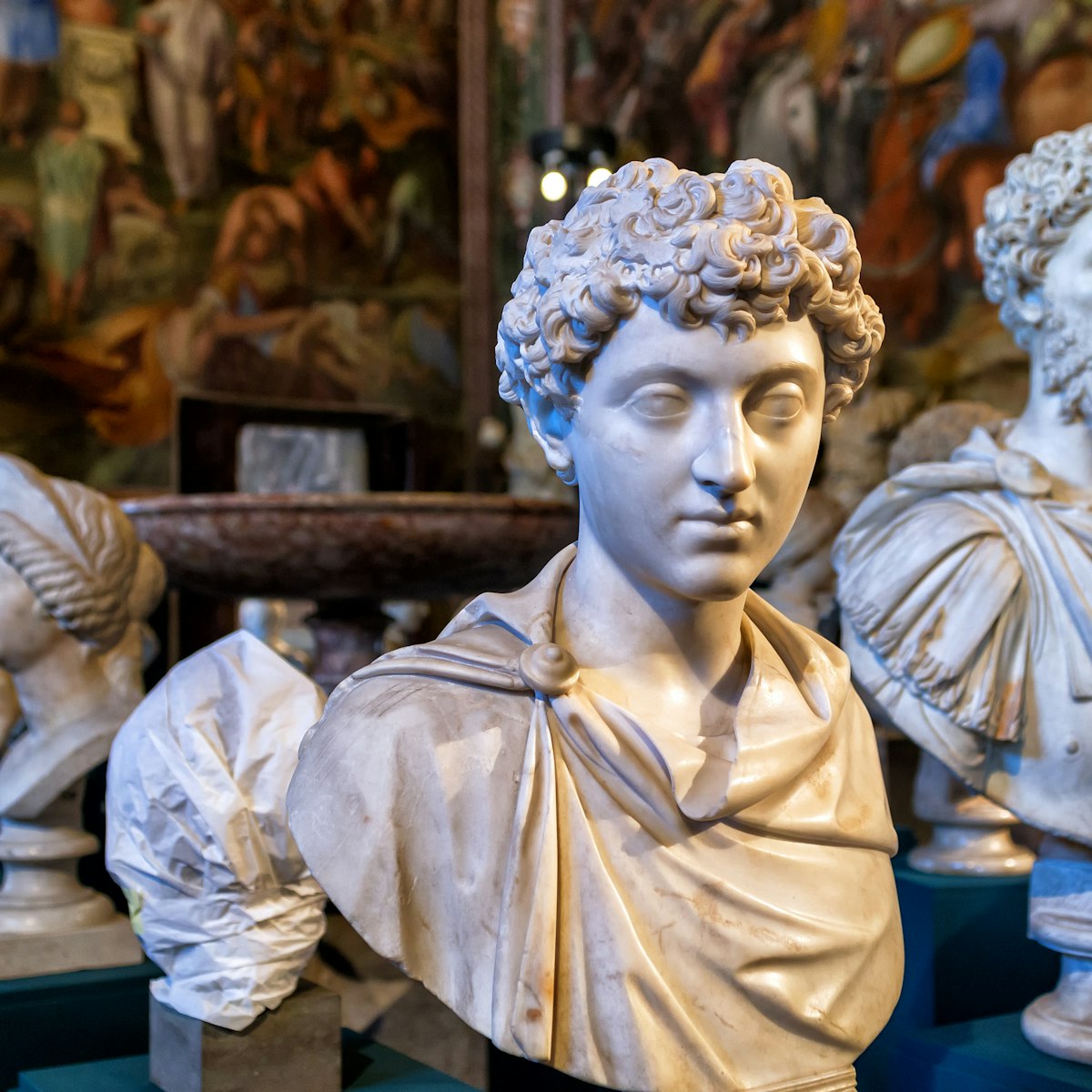
Capitoline Museums
Dating from 1471, the Capitoline Museums are the world's oldest public museums, with a fine collection of classical sculpture.

You can't ignore the Vittoriano, built at the turn of the 20th century to honor Italy's first king, Vittorio Emanuele II.
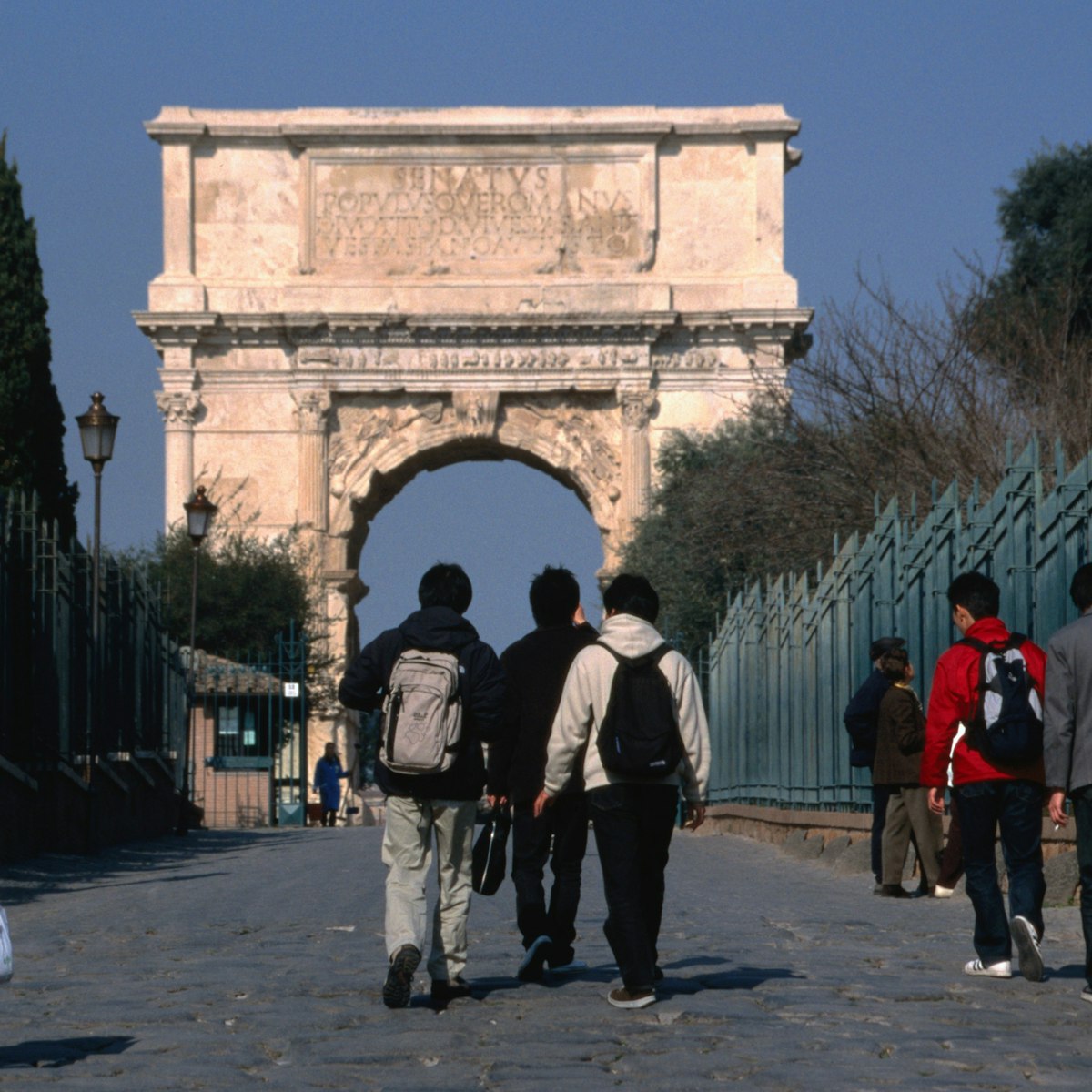
Arco di Tito
Said to be the inspiration for the Arc de Triomphe in Paris, this triumphal arch was built by the emperor Domitian in AD 81 to celebrate his brother Titus…

Mercati di Traiano Museo dei Fori Imperiali
This striking museum showcases the Mercati di Traiano (Trajan's Markets), the emperor Trajan's towering 2nd-century complex, while also providing a…
Palazzo Venezia
Built between 1455 and 1464, Palazzo Venezia was the first of Rome's great Renaissance palaces. For centuries it was the embassy of the Venetian Republic …
Chiesa di Santa Maria Antiqua
The oldest and most important Christian site on the Roman Forum, this ancient church is a unique treasure trove of early Christian art. Its cavernous…
Piazza del Campidoglio
This hilltop piazza, designed by Michelangelo in 1538, is one of Rome's most beautiful squares. There are several approaches but the most dramatic is the…
Bocca della Verità
A bearded face carved into a giant marble disc, the Bocca della Verità is one of Rome's most popular curiosities. Legend has it that if you put your hand…
Basilica dei SS Cosma e Damiano
Backing onto the Roman Forum, this 6th-century basilica incorporates parts of the Foro di Vespasiano and Tempio di Romolo, visible at the end of the nave…
Colonna Traiana
Towering over the Foro di Traiano, Trajan's column (AD 113) is adorned with a microscopically-detailed spiral frieze illustrating the Romans' victorious…
Casa di Livia
Home to the emperor Augustus' wife Livia, the Casa was built around an atrium leading onto what were once reception rooms, decorated with frescoes of…
Casa di Augusto
The Casa di Augusto, Augustus’ private residence, boasts superb ceiling and wall frescoes. These are further enhanced by audio narrations and video…
One of the few obviously recognisable buildings on the Palatino, the sunken stadio (stadium) was probably used by the emperors for private games and…
Orti Farnesiani
On the Palatino, the 16th-century Orti Farnesiani is one of Europe's earliest botanical gardens. A viewing balcony at the garden's northern flank commands…
Roma dal Cielo
This panoramic lift will whisk you to the top of the Vittoriano for sweeping 360-degree views of the city from the Terrazza delle Quadrighe.
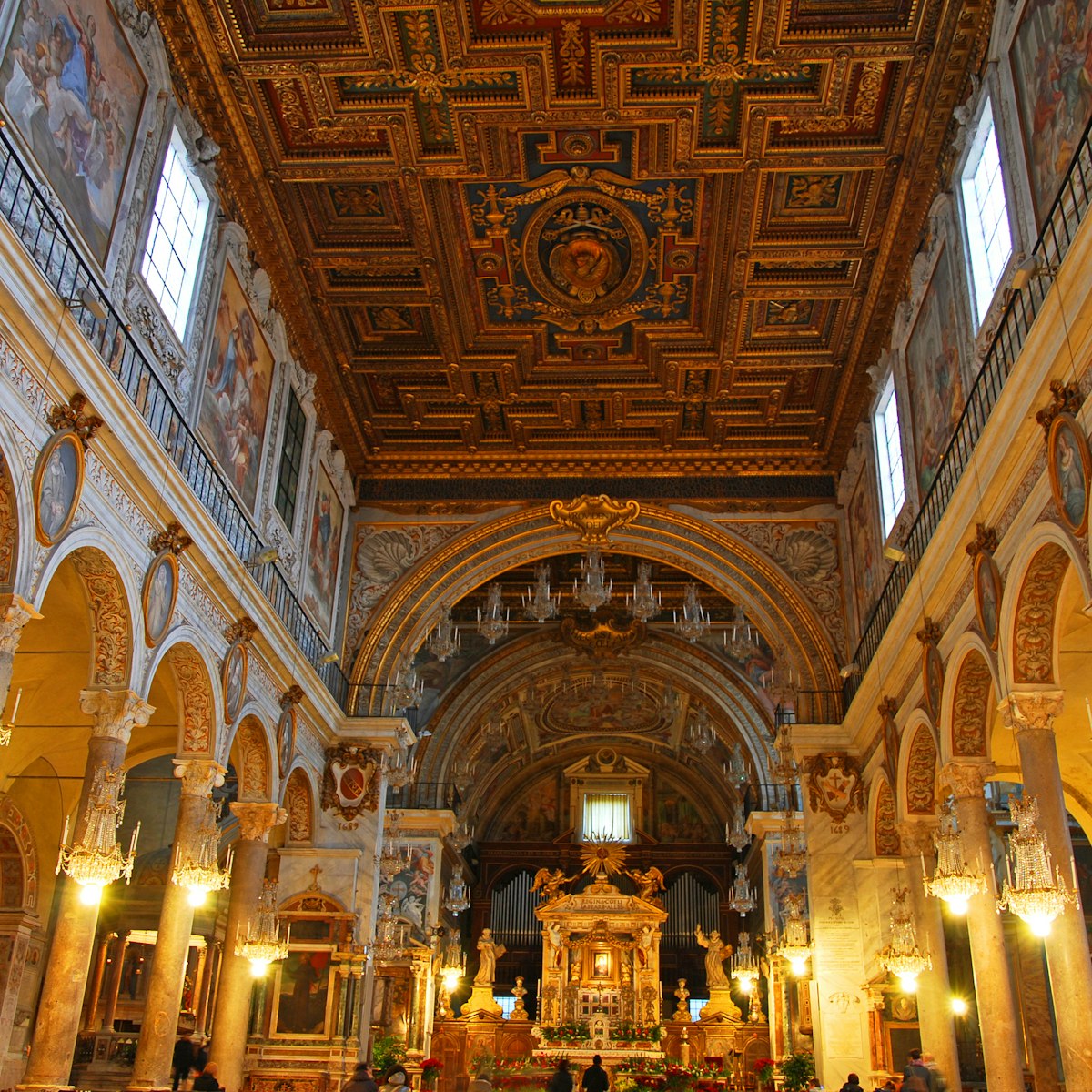
Chiesa di Santa Maria in Aracoeli
Atop the steep 124-step Aracoeli staircase, this 6th-century Romanesque church sits on the highest point of the Campidoglio. Its richly decorated interior…
Imperial Forums
The forums of Trajan, Augustus, Nerva and Caesar are known collectively as the Imperial Forums. They were largely buried when Mussolini bulldozed Via dei…
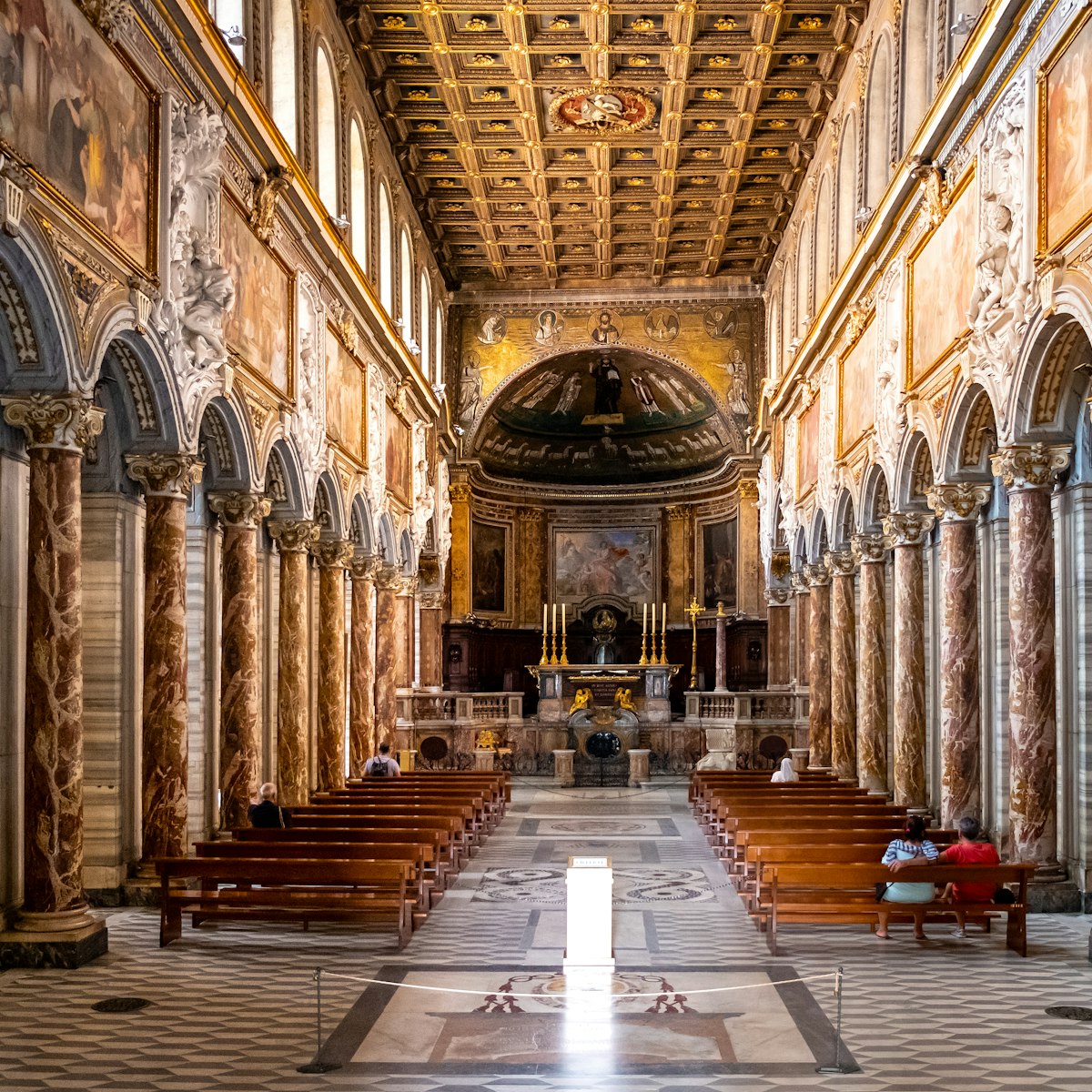
Basilica di San Marco
Now incorporated into Palazzo Venezia, the early-4th-century Basilica di San Marco stands over the house where St Mark the Evangelist is said to have…
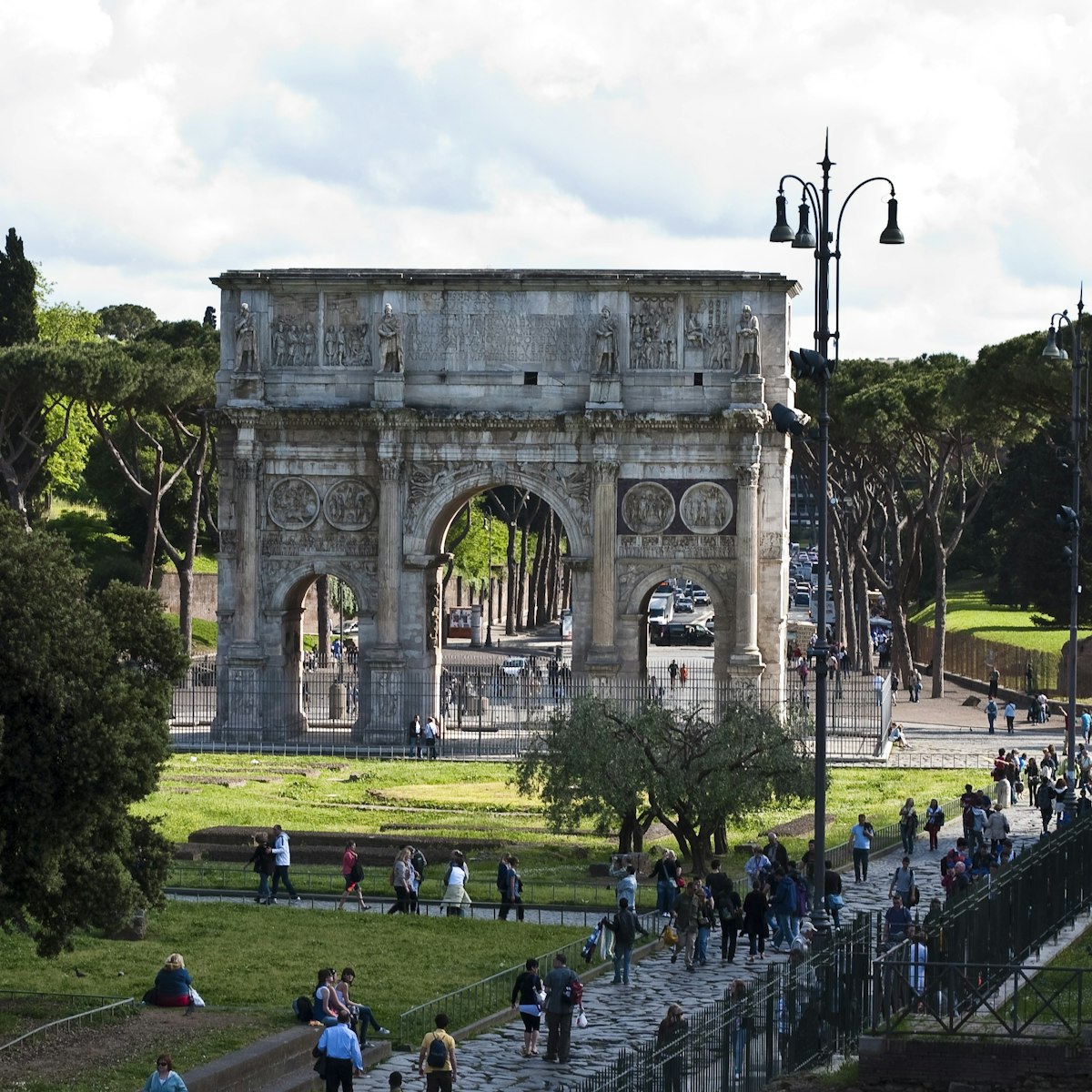
Arco di Costantino
On the western side of the Colosseum, this monumental triple arch was built in AD 315 to celebrate the emperor Constantine's victory over his rival…
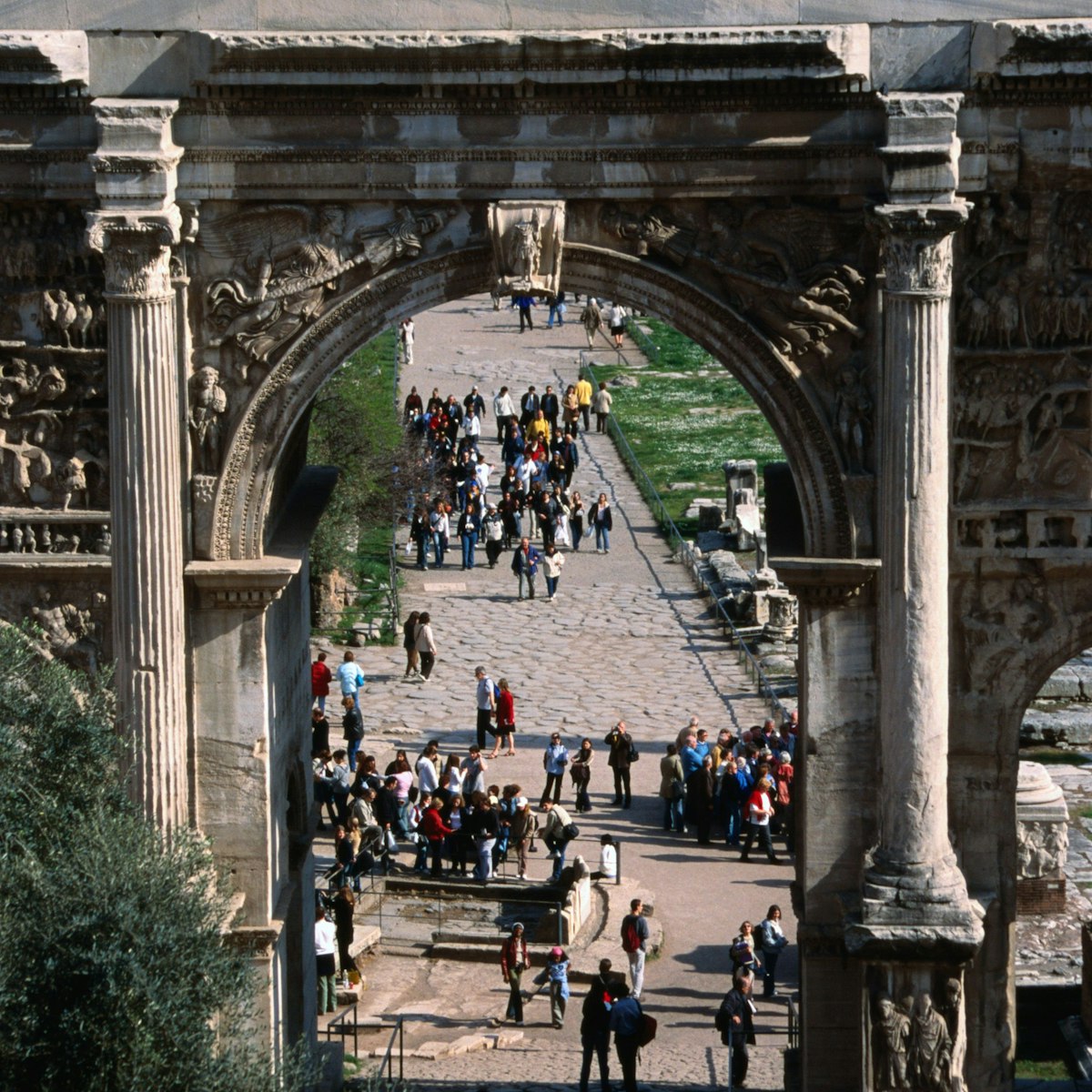
Arco di Settimio Severo
Dedicated to the eponymous emperor and his two sons, Caracalla and Geta, the 23m-high Arco di Settimio Severo was built in the Roman Forum in AD 203 to…

Statue of Marcus Aurelius
In the centre of Piazza del Campidoglio, this equestrian bronze statue is a copy of a 2nd-century sculpture in the Capitoline Museums.
Domus Augustana
On the Palatino, the Domus was the emperor's private residence in the imperial palace. It was built on two levels, with rooms leading off a peristilio …
Carcere Mamertino
Hidden beneath the 16th-century Chiesa di San Giuseppe dei Falegnami, the Mamertine Prison was ancient Rome's maximum-security jail. St Peter did time…
Casa delle Vestali
The Casa delle Vestali, situated in the heart of the Roman Forum, was home to the Vestal Virgins who tended the sacred flame in the adjoining Tempio di…
On the Roman Forum, the Curia was the meeting place of the Roman Senate. According to tradition, it was originally built by Tullo Ostilio, the third of…
Domus Flavia
Most of the Palatino as it appears today is covered by the ruins of Emperor Domitian's vast 1st-century complex, which served as the main imperial palace…
Tempio di Romolo
Also known as the Tempio del Divo Romolo, this 4th-century brick temple on the Roman Forum was once thought to have been dedicated to Valerio Romolo, the…
Basilica di Massenzio
With its vast arched vaults, this hulking brick construction is the largest building on the Roman Forum. Started by the Emperor Maxentius and finished by…
Foro di Traiano
Overshadowed by Trajan's towering administrative complex (the Mercati di Traiano), this was the last of the Imperial Forums to be built, dating to the…
Chiesa di San Giorgio in Velabro
The medieval Chiesa di San Giorgio in Velabro is a beautiful, atmospheric church whose original 7th-century portico was completely destroyed by a Mafia…
Hidden beneath Palazzo Senatorio, and accessible via a tunnel linking Palazzo dei Conservatori to Palazzo Nuovo, the Tabularium was ancient Rome's central…
Tempio di Antonino e Faustina
Entering the Roman Forum from Largo della Salara Vecchia – you can also enter directly from the Palatino or from the Arco di Tito – you’ll see the Tempio…
Rampa di Domiziano
Accessible through the Chiesa di Santa Maria Antiqua, this ramp is actually a vast passageway that allowed the emperors to enter the Roman Forum from…
The cobbled Via Sacra, the main road through the Roman Forum, traverses the site, running from the Capitoline Hill to the Arco di Tito at the forum's…
Museo Palatino
This small museum traces the development of the Palatino with video presentations, models and archaeological finds. Highlights include busts of the…
Tempio di Castore e Polluce
In the centre of the Roman Forum, three Corinthian columns are all that survive from the Tempio di Castore e Polluce, also known as the Tempio dei…
Tempio di Vesta
This circular temple on the Roman Forum was dedicated to Vesta, the popular goddess of home, hearth and family. The Vestal Virgins, who lived next door in…
More destinations you need to see
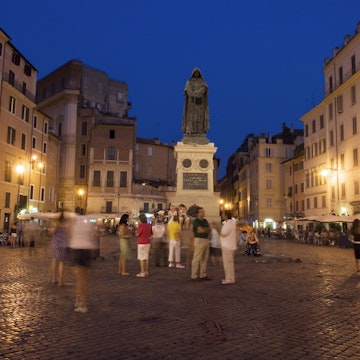
- TAXI FARES CALCULATOR
- BOOK PRIVATE TOUR
- Hotels near Termini
- 3 Star Hotels
- 4 Star Hotels
- 5 Star Hotels
- Apartments For Rent
- Best Hostels
- Hotels near the Colloseum
- Fiumicino Airport
- Ciampino Airport
- Termini Railway Station
- To Florence
- To Ostia Antica
- Famous Roman Dishes
- Best Pizza Places
- Best Pasta Places
- Local Italian Food
- Best Gelato Places
- Best Rooftop Bars
- Sistine Chapel
- Vatican Museums
- Borghese Gallery
Roman Forum
- Trevi Fountain
- Spanish Steps
- Castel Sant’Angelo
- Navona Square
- Ancient Sites and Ruins
- Galleries and Museums
- Parks and Gardens
- Squares and Fountains
- Beaches near Rome
- To Alberobello
- How to Choose a Hotel in Rome
- 2025 Pilgrims of Hope Jubilee
- Rainy Days in Rome
- What to See in 3 days
- Buying a Sim Card in Italy
- Tickets to Vatican museums
- Renting a Car in Rome
- Apps for Tourists
- Souvenirs from Rome
- Free Things to Do
- Unusual Things to do
- Public Transport
- Italian food and wine
- Sightseeing Tour at Sunrise
- Sightseeing Tour by Car
- St Peter’s Basilica
- Colosseum & Roman Forum
- Campo Marzio
- Jewish Ghetto Quarters
- Quartiere Coppedè
- Sant’Eustachio
- Marcus Aurelius
- Gaius Julius Caesar
- Octavian Augustus
Ancient Roman Sites and Ruins
Written by: Kate Zusmann
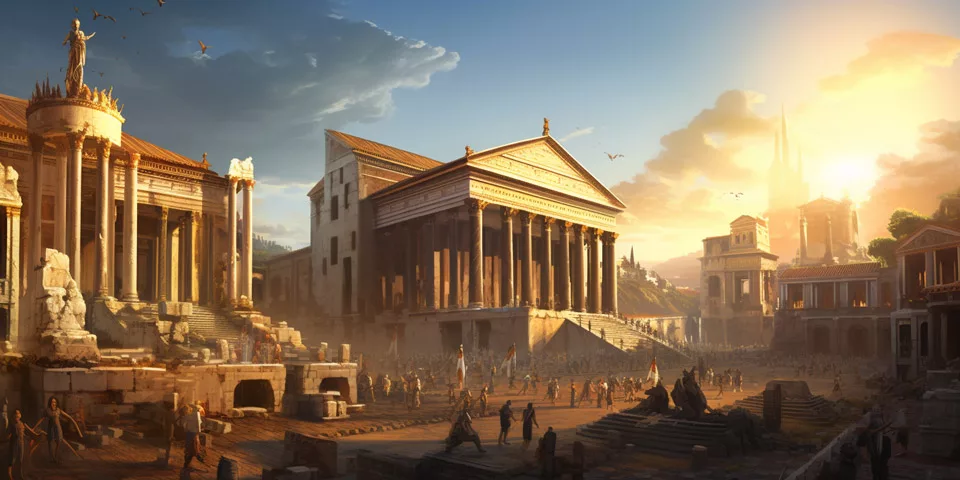
There are a lot of ancient Roman architecture sites, and they are full of history. For example, the Eternal City has existed since 753 BC, and its architecture and works of art influenced the whole world.
In addition, there are many dignities in the ancient city, most of which you can find in the historic center. Moreover, some of them are free, while others you can visit by using Rome Passes or tickets.
FAQ about Ancient Roman Sites and Ruins
Who founded ancient rome, what is the most famous place in ancient rome, where are located the oldest roman ruins, what are the oldest architectural sites in rome.
Here’s the list of famous Roman ancient sites:
The Colosseum
The Colosseum or Coliseum is perhaps the grandest construction in the history and culture of ancient Rome. It was created around 70-72 A.D. by Emperor Vespasian of the Flavian dynasty as a gift to the Roman people.
Moreover, the site had been the most prestigious place for entertainment in the capital and empire for four centuries.
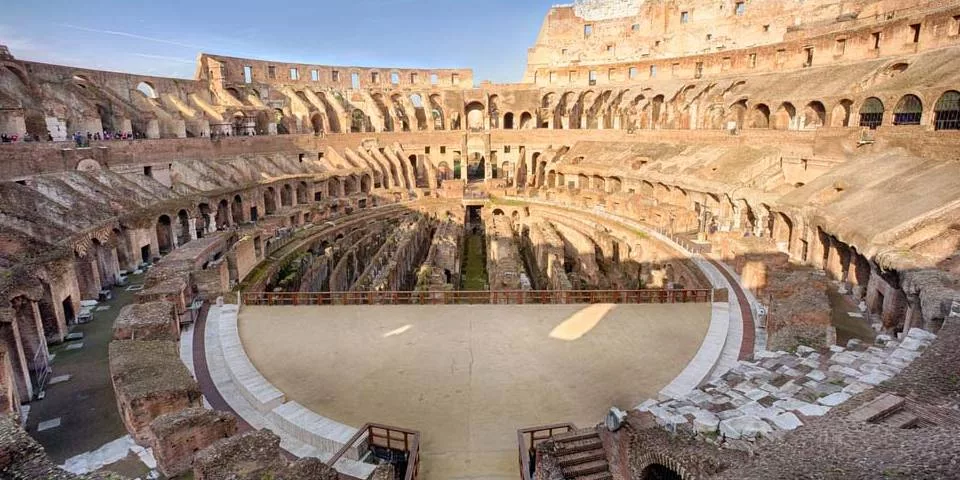
Throughout the theater’s existence, two-thirds of the original construction has been destroyed and renovated several times. However, it remains one of the most famous touristic destinations in the world and an iconic symbol of Rome.
The Pantheon
The Pantheon is an ancient temple dedicated to the Roman gods. Moreover , it is an embodiment of the greatness of the Roman Empire. It is assumed that the temple was built in 2 A.D. in the place of another temple, built in 27 B.C. by Marcus Agrippa Moreover, the Pantheon is one of the few buildings of ancient Rome which have survived unchanged to this day.
Nowadays, this ancient crowning glory can be found at Piazza della Rotonda.
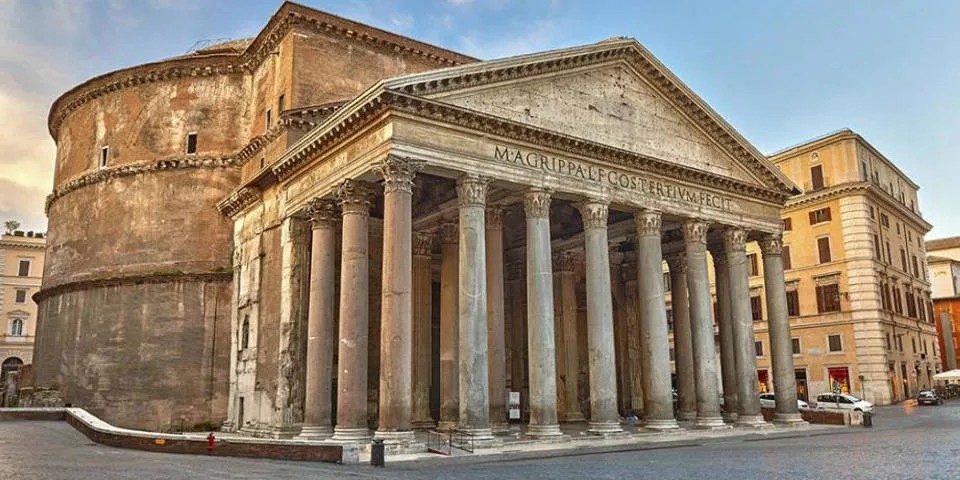
Interesting fact: Raphael wanted to be buried in the temple because according to him, it was a place where people and gods are united. The great artist was buried in the Pantheon. This event turned the temple into a burial place of great and famous people.
The Mausoleum of Hadrian
The Mausoleum of Hadrian , also known as Castel Sant’Angelo (The Castle of the Holy Angel), has a great view and impressive history. It was built at the dawn of Christianity on the banks of the Tiber River and served as the refuge for the Roman emperor, the residence of pontiffs, a fortress, then a prison, and later – the museum and treasury.
There is a legend that the Archangel Michael appeared above the mausoleum, putting his sword back into the sheath. Thus, the end of the plague in 590 A.D. was marked. To celebrate this, the tomb received its present name.
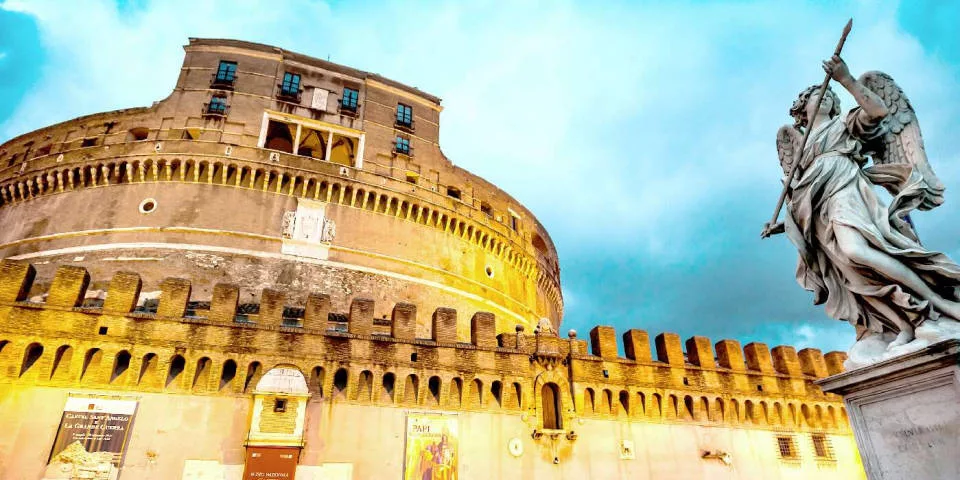
Interesting fact: in Italy and in many other European countries, you have to say “God bless you!” to any person who had just sneezed. In the Middle Ages, it was believed that the plague began with sneezing attacks and only God could heal the plague of a sick person
The Theater of Marcellus
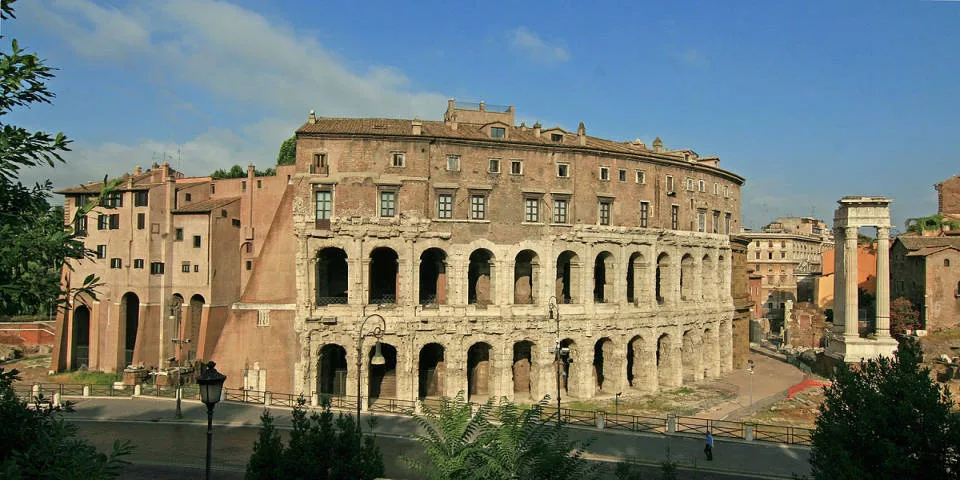
The Theater of Marcellus (Teatro di Marcello) is a structure whose construction was started by Julius Caesar . It was finished by Augustus and dedicated to his favorite nephew Marcellus. The building is one of the ancient examples of important entertainment venues for Romans.
Marcellus’s Theater is the primary version of the Colosseum, but it is not the Colosseum, which is the original Roman amphitheater
The Circus Maximus
The Circus Maximus is the giant racetrack of ancient Rome , situated on the left bank of the Tiber River, between the Palatine and Aventine hills, near the center of the modern city.
Moreover, Circo Massimo comes from the Latin Circus Maximus, where one of the meanings of the word “circus” is a hippodrome, a place for horse contests. Horse racing has been taking place for centuries in the valley between the hills.
However, the initial function of the racetrack was to host the Roman Games (Ludi Romani). The last race in the Circus Maximus was held in 549 AD, during the reign of Emperor Totila However, after it, the era of destruction began.
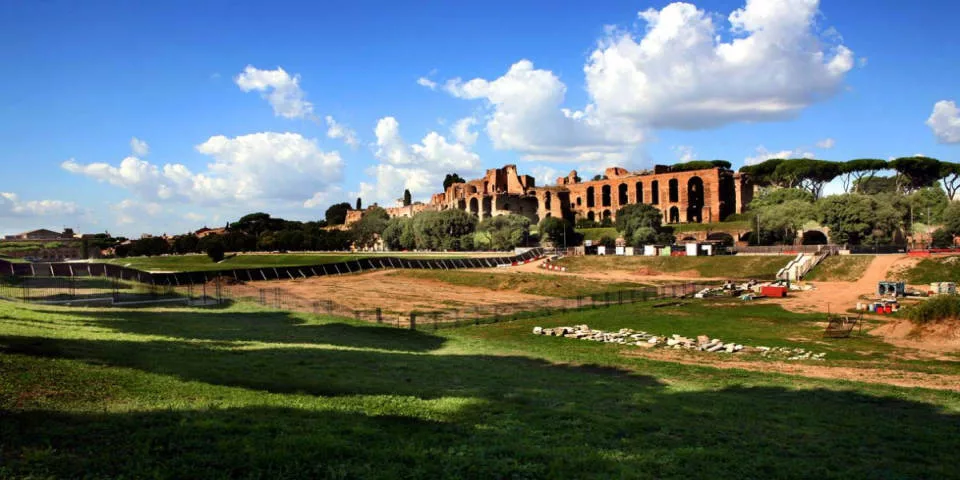
Interesting fact: In summer 2014, a concert of the legendary music band Rolling Stones during their world tour took place on the Circus Maximus, which brought together 65,000 rock fans
The Mouth of Truth
The Mouth of Truth (Bocca della Verita) is a Pavonazzo marble mask with a gloomy face of an unknown god set at the entrance of the Santa Maria church in Cosmedin. According to Medieval myth, the marble mask was used as a unique way of finding whether a person was telling the truth or not.
People, who had committed crimes or were accused of committing crimes unfairly, were brought in front of the mask. They were asked to take an oath and had to place their hand inside the sculpture’s open mouth while answering the executioner’s questions.
Ancient Romans believed that if a person was telling the truth, the mask would never move a muscle. However, if the person were telling a lie, the mouth would close and then cut off that person’s hand.
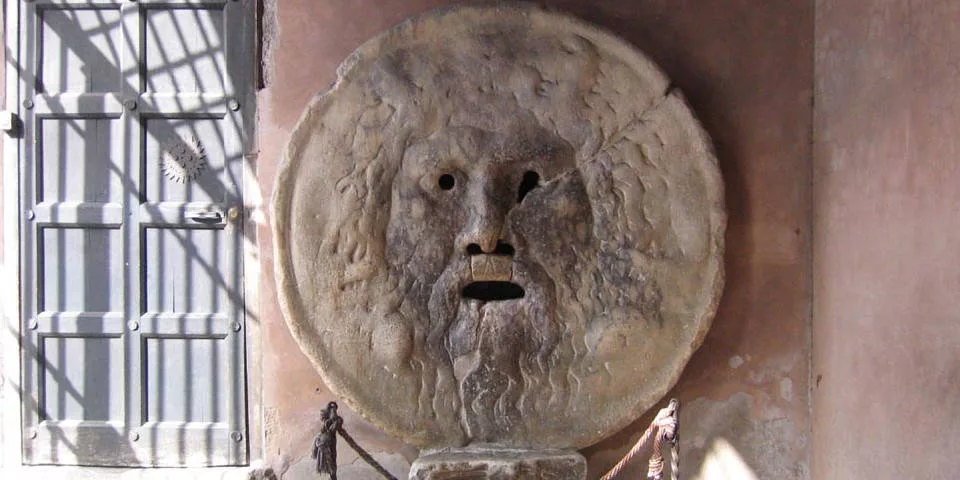
Interesting fact: The legend about the Mouth of Truth became famous when it was featured in “Roman Holiday” (1953) . The mask was used as a storytelling device in the movie and exposed the truth about the myth
The ancient Roman Forum is a vast complex of triumphal arches, marble fragments, basilicas, ruined temples, and other architectural elements from different periods. Moreover, it was ancient Rome’s ceremonial, political, religious, and business center.
The forum provides insight into the splendor that previously was the Roman Empire.
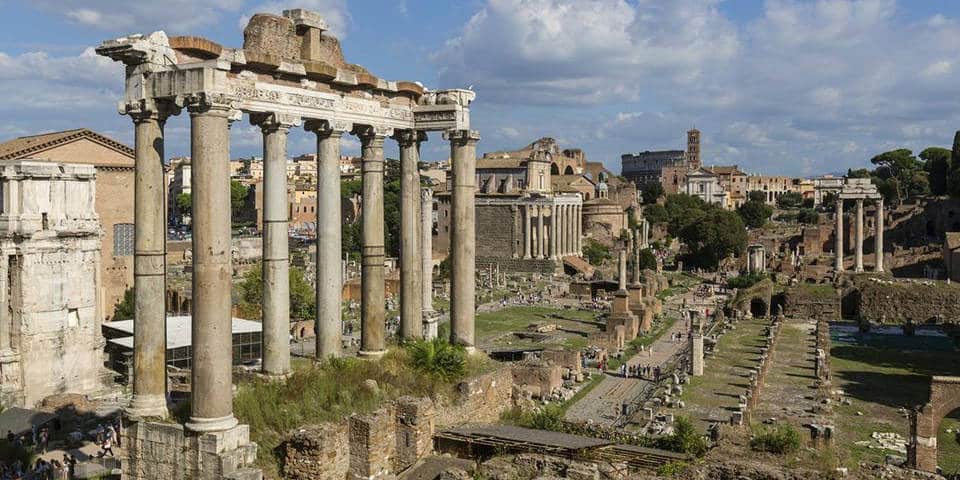
The Capitoline Hill
Located above the Roman Forum, Capitoline Hill was the symbolic center of ancient Roma and held the Temple of Jupiter.
Moreover, today you can find the two oldest public museums in the world. The first is Palazzo Nuovo with Greek and Roman sculptures, while the second is Palazzo dei Conservatori, where you will find art galleries, sculptures, and frescoes. The Capitoline Hills has the best view of the Eternal City’s historic center.
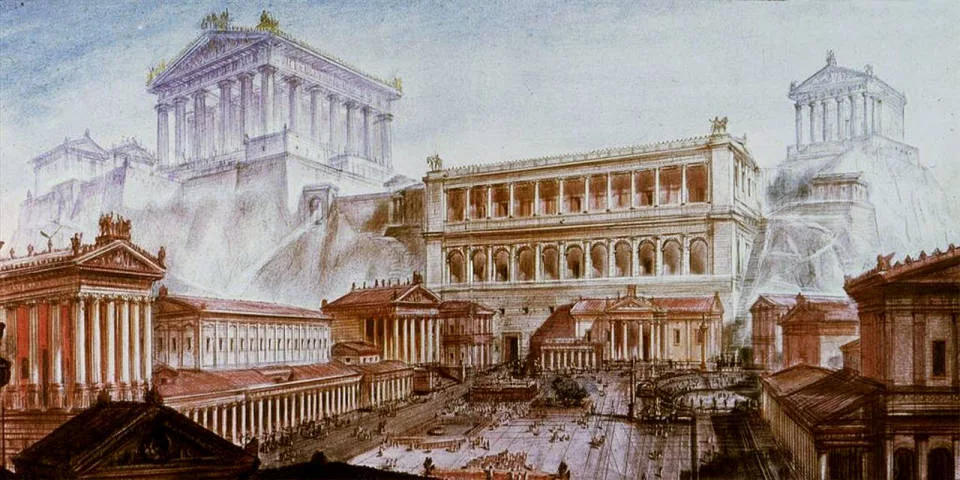
One ticket gives you admission to both museums
The Catacombs of the Appia Antica
Three of Rome’s most extensive and essential catacombs areSan Callisto, San Sebastiano, and Santa Domitilla.
Catacombs of San Callisto
Built between 250 and 300 A.D., the Catacombs of San Callisto (St. Callixtus) hold the graves of 500,000 Christians, including dozens of martyrs and 16 pontiffs.
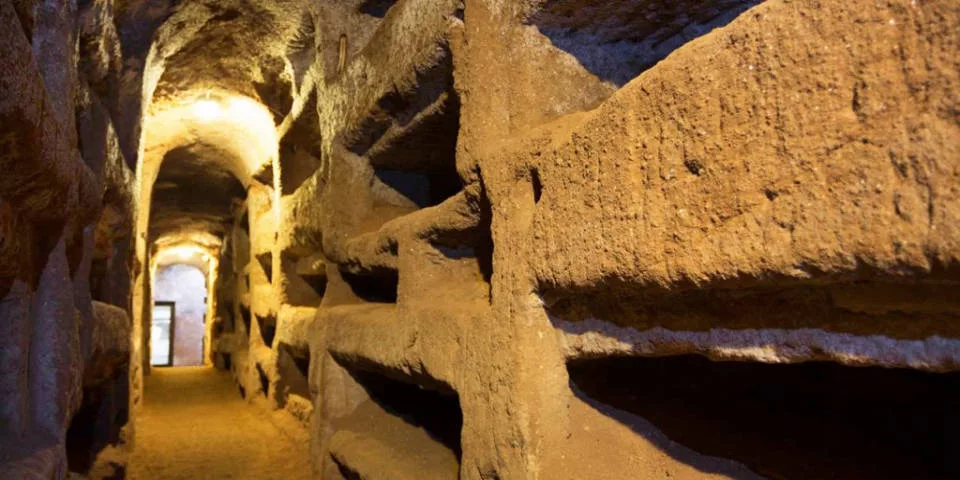
Catacombs of San Sebastiano
The Catacombs of San Sebastiano are similar to the catacombs of San Calisto. There are four floors with different paintings from the rise of Christianity, graffiti, and mosaics.
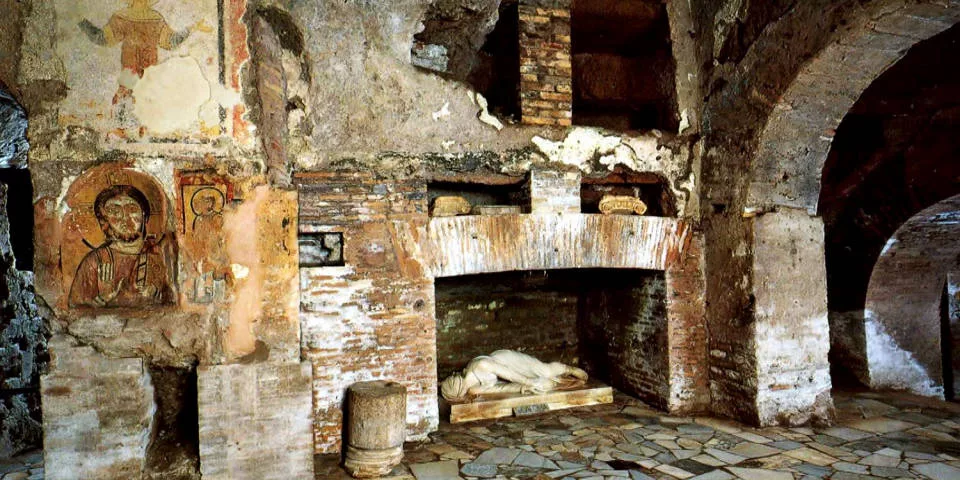
Catacombs of Santa Domitilla
These are one of the most significant and most ancient catacombs Catacombs of Santa Domitilla have four levels of graves and comprise 15 km (9.3 mi). Moreover, rich people were buried in decorated tombs of bigger size, individually or with their family members.
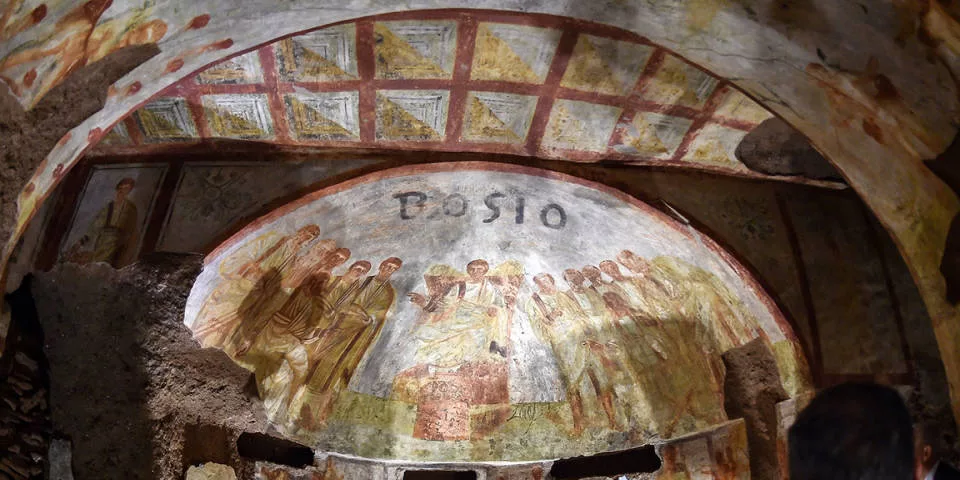
The domus of Romulus and Remus
The Domus of Romulus and Remus was created in the second century B.C. It consists of the entrance which leads to the atrium (open-roofed entrance hall) with an impluvium (the square basin in the center of the atrium, which receives rainwater from an opening in the roof) surrounded by private rooms.
The house was excavated in the years 1871-72.
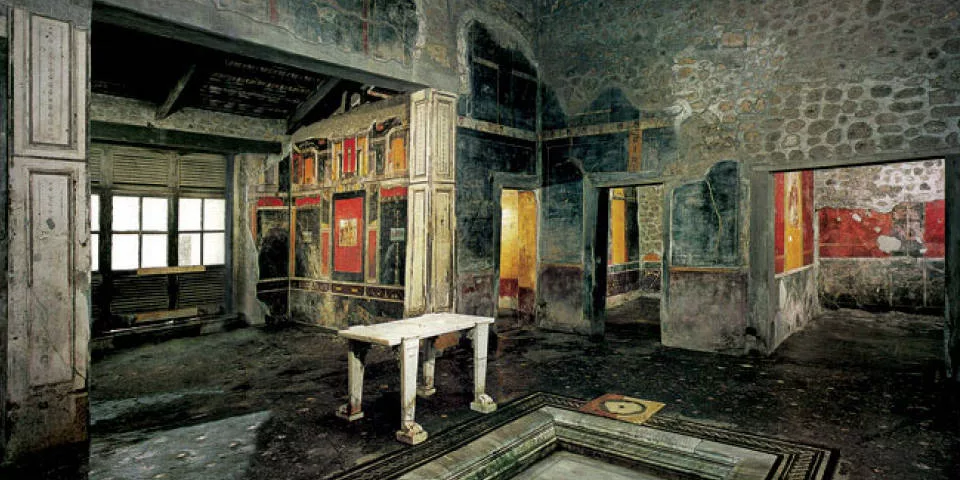
Interesting fact: during the excavation of the house, the bodies of five people were discovered. One of them died during the attempt to escape. He held numerous gold, silver and bronze coins and rings in his hands
Baths of Diocletian
The Baths of Diocletian were commissioned by Emperor Diocletian in 298 AD and had a capacity of more than 3000 people. Moreover, this bath complex was the largest in ancient Rome, and its structure was similar to that of the Baths of Caracalla.
Also, the Roman public baths worked until 537, when the Goths cut off the aqueducts trying to conquer Rome.
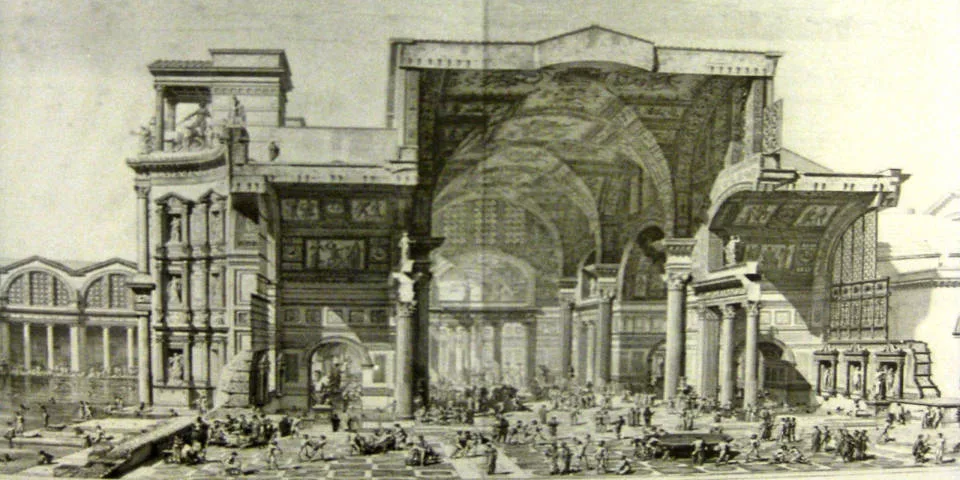
Interesting fact: During the construction of the Baths of Diocletian, thousands of Christian slaves died, while the Emeror Diocletian died in 305 because he was too tired and ill
Baths of Caracalla
The construction of the Baths of Caracalla started in the year 212 by Emperor Caracalla . It took about 5 years to finish them because a new aqueduct was built especially for the baths. The spa was not simply a place for bathing, sport, and health, but also for relaxing and studying.
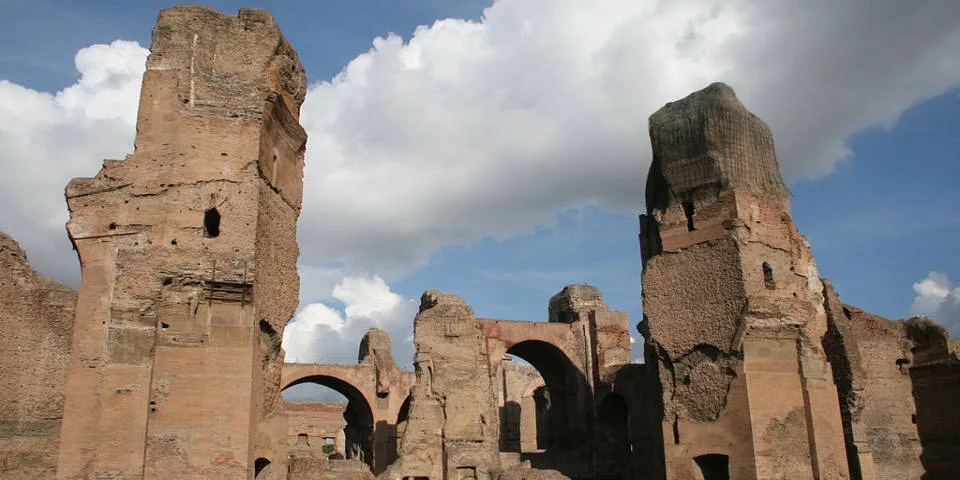
Trajan’s Markets
The Trajan’s Markets is a large complex of ruins created in the 2 nd century A.D., and it is part of the Trajan’s Forum Moreover, Trajan’s Forum, along with the forums of Julius Caesar , Augustus , Nerva , and the Templum Pacis, were constituted the center of the Roman Empire.
Moreover, it is considered the world’s first shopping mall – all the shops and apartments were built in a multi-level structure; even nowadays, you can visit several levels.
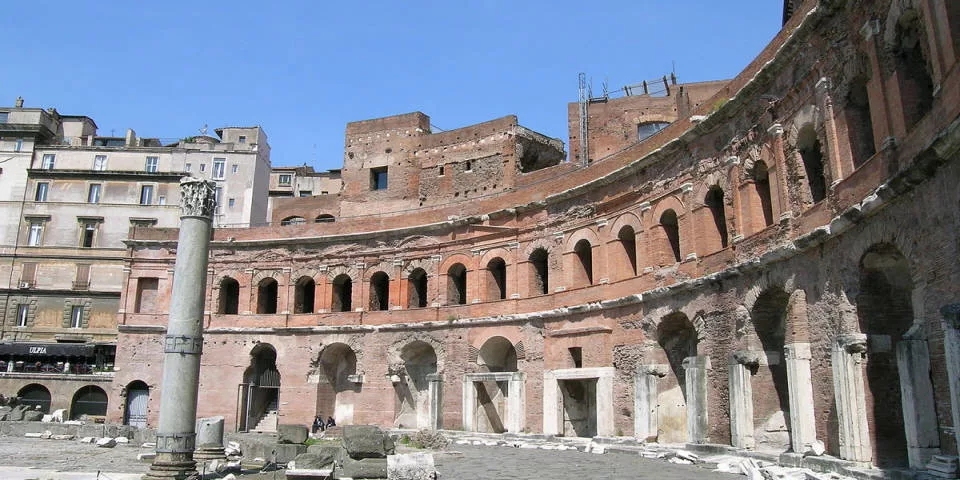
Pyramid of Cestius
The Pyramid of Cestius is the tomb of praetor Caius Cestius Epulone. It was built in the year of his death, in 12 B.C. Its height of 36.40 meters and 30 square meters at the base.
It took 330 days to build the pyramid. Nowadays, the Pyramid of Cestius is located right near the metro station “Piramide.”
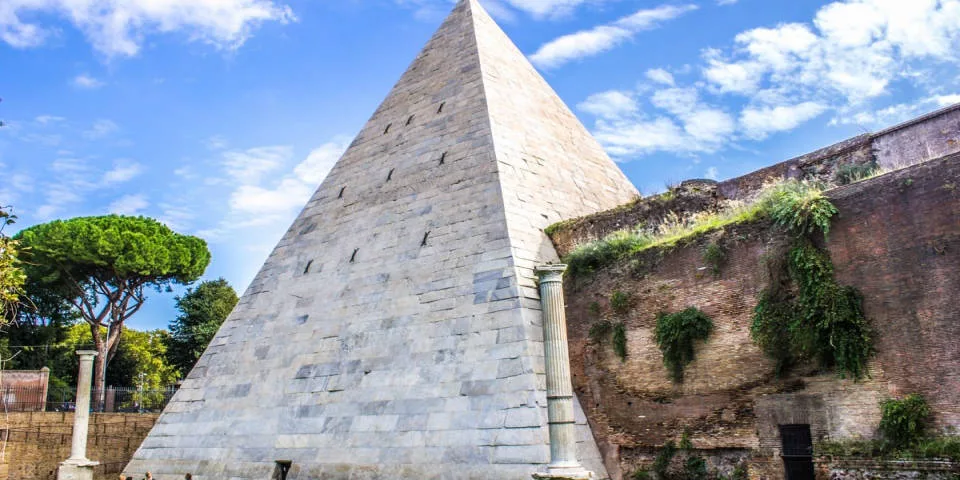
Stadium of Domitian
The stadium of Domitian (Stadio di Domoziano) was built in Rome as Tit Flaviy’s gift to Roman citizens and was used for conducting different sports events.
Here, the second name of the stadium is Agons arena, and Navona Square got its name thanks to this term. In the 1st century A.D., the stadium was called “Campus Agonis,” while closer to the Middle Ages this form transformed into “n’agone” Lastly, the name of the place was simplified to “Navona” So that, nowadays, this spot became one of the most famous Roman squares – Piazza Navona .
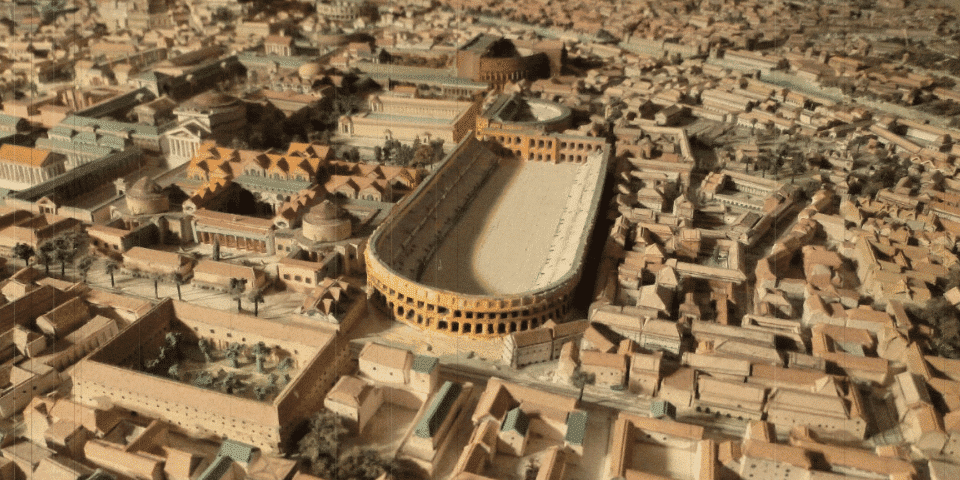
Rome is full of ancient sites with rich history and exceptional beauty.
The city represents its story in every corner. Undoubtedly, it is worth discovering all these sites for yourself, but it will take several months or even years.
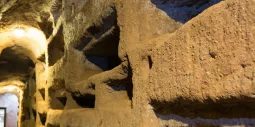
The Catacombs of St. Callixtus
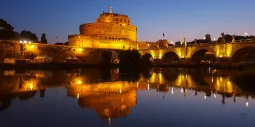
16003 views
Castel Sant’Angelo in Rome
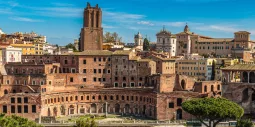
Trajan’s Market
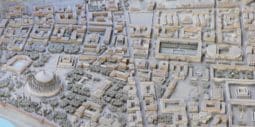
11539 views
Field of Mars in Rome (Campus Martius)
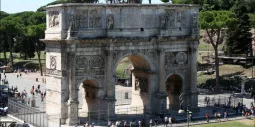
14484 views
Triumphal Arch of Constantine
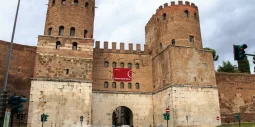
20874 views
The Aurelian Walls
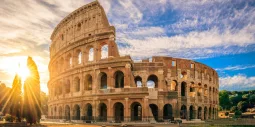
103977 views
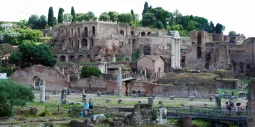
10381 views
Palatine Hill
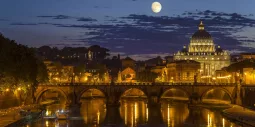
30470 views
The Tiber River in Rome
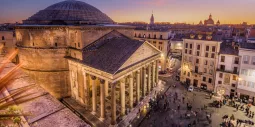
30644 views
Pantheon in Rome – All You Need to Know before Visiting in 2024
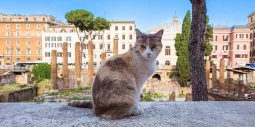
10642 views
Rome Cat Sanctuary Ruins – Largo di Torre Argentina
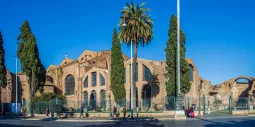
Roman Thermal Baths of Diocletian
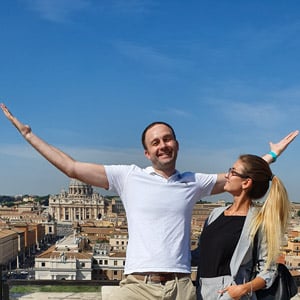
Read more about Rome

The Church of St. Ignatius of Loyola at Campus Martius

Five Good Emperors of Rome

Capitoline Hill
Rome.us © 2024. Created with love by Roman experts and guides.
Privacy Policy
- Shop Now! 🚚 Free Shipping on all orders in Europe, UK, Canada & US!
- 🇮🇹 Explore Italy on Foot
What are the best places to see Roman ruins and ancient historical sites in Rome
Rome is a treasure trove of ancient history, with every corner and alley whispering tales of a bygone era. Unveiling its storied past requires exploring the myriad of Roman ruins and historical sites scattered throughout the city. To navigate these historical wonders efficiently, consider utilizing a walking map of Rome , which can guide you through the city’s labyrinthine streets and ensure you don’t miss any significant landmarks.
The Colosseum
The great Flavian Amphitheatre, better known as the Colosseum, stands as a testament to ancient Roman engineering and love for grand spectacles. Erected under Emperor Vespasian’s rule, this enormous structure could house tens of thousands of spectators eager to watch gladiatorial contests and wild beast fights. Although ravaged by time, the Colosseum remains a formidable sight and an icon of ancient Rome’s might.
Arch of Constantine
In the shadow of the Colosseum towers the Arch of Constantine. This triumphal monument solidified Emperor Constantine’s victory in 312 AD. Its massive size remains an enduring symbol of the Roman Empire’s heyday. Though it incorporates pieces from older monuments, it retains its grandeur and is considered one of the most intact of its kind.
The Roman Forum
Vibrant and bustling in its prime, the Roman Forum was once the nucleus of Rome. However, centuries of plundering have taken their toll. Now standing as a patchwork of ruins, the Forum reveals the remnants of once magnificent temples and public buildings, such as the Curia, Temple of Vesta, and Basilica Julia, echoing the power that once emanated from this historical center.
Palatine Hill
Palatine Hill’s significance in Roman history cannot be overstated; it’s where Romulus is said to have founded Rome, where Emperor Augustus was born, and where Caligula met his end. Despite many structures now lying in ruins, certain edifices, notably the Domus Augustana, display well-preserved frescoes giving a glimpse into opulent ancient lives.
Domus Aurea
Emperor Nero’s Golden House epitomized luxury in Rome. Occupying an expanse of over 300 acres, the Domus Aurea included an array of rooms with high ceilings adorned with gold and precious stones. Though much has been lost to history, the frescoes and stuccos that remain offer insight into the opulence Nero favored.
Trajan’s Markets
Trajan’s Markets, constructed following Trajan’s Dacian victory, was a complex shopping district comprising numerous storefronts, bars, and the central hub, Trajan’s column. An exploration of its main artery, the Via Biberatica, allows visitors to traverse the same paths once trodden by ancient Romans.
Teatro Marcello
Teatro Marcello, which may seem like a cousin to the Colosseum, predates it and is believed to have influenced its design. This theater was later converted into a fortified palace and is still utilized today for open-air summer concerts.
The Pantheon
The Pantheon, a remarkably preserved example of Ancient Roman architecture, commands attention with its impressively proportioned dome and oculus. A feat of ancient engineering, this building has weathered the centuries remarkably well and now serves as a final resting place for celebrated Italians, including the artisan Raphael.
View this post on Instagram A post shared by #romeonfoot (@romeonfoot)
Baths of Caracalla
Rome’s Baths of Caracalla were monumental, not just in terms of their size but also as centers of social life. With its varying temperature pools, gymnasiums, and gardens, the complex served as both a bathhouse and a social venue. Although no longer operational, the ruins provide an impression of their ancient grandeur.

Stadium of Domitian
Piazza Navona’s iconic shape mimics the ancient Stadium of Domitian that lies beneath. The ruins reveal a chapter of Roman history devoted to athletic pursuits and public entertainment, a striking contrast to the blood-soaked spectacles of the Colosseum.
Archaeological Area of Santa Croce in Gerusalemme
Venture beyond the Aurelian walls to explore the area surrounding the church of the Holy Cross in Jerusalem. Here, amidst the ruins of gardens and temples, mosaic and fresco fragments reveal aspects of the past, showcasing the architectural evolution over centuries.
Tempio Rotondo and Area Surrounding Piazza della Verità
From a meat market to a historical goldmine, Piazza della Verita is home to architectural marvels like Tempio Rotondo and the Temple of Portunus, perfectly exemplifying the Roman’s architectural prowess with their Greek marble constructions. Additionally, the legendary Bocca della Verita awaits those daring to test the truthfulness of their words.
Villa dei Quintili
On the city’s periphery, Villa dei Quintili, which once belonged to two influential brothers, remains a striking symbol of Roman residential architecture. Visitors will find remnants of elaborate water features and vast courtyards, giving insights into the luxurious lives of Rome’s elite.
Underground Basilica of Porta Maggiore
Descend below the earth to discover the enigmatic Underground Basilica of Porta Maggiore, a sanctuary to an ancient cult. Unearthed by chance in 1917, its ceilings are lavishly adorned with stucco reliefs that astound in their complexity and artistry.
San Clemente Basilica
Journey below the Basilica di San Clemente to uncover layers of religious and cultural heritage, including a fourth-century basilica and remnants of earlier Roman buildings. This site illustrates the complex stratification of Roman history, with periods ranging from pagan Roman times through the early Christian era.
Santa Cecilia in Trastevere Basilica
The Basilica di Santa Cecilia in Trastevere mesmerizes visitors not only with its stunning frescoes and artworks but also with its underground chambers, where an ancient Roman house and its baths can be observed. Exploring this space offers an intimate perspective on the everyday lives of Romans and the early Christian community.
Vatican Necropolis
The Vatican Necropolis is a deeply hallowed site beneath St. Peter’s Basilica. The necropolis, filled with elaborate tombs and relics, provides a sacred connection to early Christianity, encapsulating the devotion and artistry of a bygone era.
St. Paul Outside the Walls Undergrounds
Beneath the monumental Basilica of San Paolo Fuori le Mura lies a vast archaeological area ripe for exploration. Discover remnants of an ancient past, including structures affiliated with early Christianity, attesting to the city’s enduring spiritual legacy.
Mausoleum of Augustus
The recently restored Mausoleum of Augustus allows visitors to encounter an imperial funerary monument of unparalleled grandeur. As the resting place of one of Rome’s greatest emperors, the circular structure serves as a monumental tribute to the Julio-Claudian dynasty. A visit to the Mausoleum offers a captivating look at Imperial Rome’s funerary customs and architectural preferences.
Portico di Ottavia
Nestled in the heart of Rome’s Jewish Quarter, the Portico di Ottavia is infused with the history of a bustling marketplace that once catered to ancient Romans. Despite enduring numerous restorations and transformations over time, the remnants offer valuable insights into Rome’s architectural evolution.
Vicus Caprarius – the City of Water
A hidden subterranean treasure, Vicus Caprarius reveals Rome’s intricate water management system. Found near the iconic Trevi Fountain, the underground archaeological complex provides an intriguing glimpse into how water played a central role in the ancient city’s functioning.
The Pyramid of Caius Cestus
An Egyptian-inspired edifice, the marble-clad Pyramid of Caius Cestus, stands out in Rome’s landscape as an unusual but arresting sight. This unique tomb dates to a period when Egyptian architecture enamoured the Romans, making it a distinctive historical point of interest.
Tivoli – Villa Adriana (Hadrian’s Villa)
In the tranquil town of Tivoli lies the sprawling estate that once served as Emperor Hadrian’s retreat. Inspired by his travels and passion for architecture, Hadrian incorporated diverse design elements from around the Empire. The site today, scattered with the remains of luxurious gardens and palatial structures, gives us a snapshot of Hadrian’s vision and the elaborate lifestyle of a Roman Emperor.
Ostia Antica
The ancient port city of Ostia Antica is a lesser-known gem offering a detailed look at Roman urban life. Far from simply being a city of ruins, Ostia’s well-preserved cityscape features baths, temples, and theaters standing as silent narrators of everyday life in an affluent Roman city.
Ostia Antica provides an extensive view into the commercial activities and domestic architecture dating back to the fourth century AD. The city’s decline came not from catastrophe but from changing trade routes and the gradual desertion of its inhabitants. Walking through this archaeological site is like stepping back in time, fitting together the pieces of Roman civilization.
Navigating the historical labyrinth of Rome’s ancient sites is not only a journey through time but a testament to the enduring legacy of Roman civilization. Each ruin and landmark tells a story, offering a vivid window into the past and an understanding of the foundation upon which modern Rome stands. Whether you are a history enthusiast or simply seeking to immerse yourself in the awe of ancient architecture, Rome holds an enduring appeal that has captivated travelers for centuries.
Explore our walking maps of Rome:
Rome in a day.
📌 Allotted Time: 1 day 🐾 Walking time: 3-4 hours
Panoramic Views in Rome
📌 Allotted Time: 1 day 🐾 Walking time: Flexible
Fountains of Rome
📌 Allotted Time: 5 hrs 🐾 Walking time: 4-5 hours
You might be interested in …
Acquiring a travel visa for italy & eu in 2024: a comprehensive guide, rome’s best rooftop bars: enjoy cocktails with a view, can you drink tap water in rome, basilica papale di santa maria maggiore.
- Most Popular
- Special Tours
- Small Groups
- Florence tours
- Venice Tours
- Pompeii and Amalfi Tours
- Rome culinary experiences
- Cinque Terre
- Alba and Langhe
- Amalfi Coast, Capri and Pompeii
- Puglia and Matera
- Sicily and Pantelleria
- Rome Kids & Families Experiences
- Rome Kids & Families Tours
- Vatican Kids and Families Tours
- Venice Kids & Families Experiences
- Venice Kids and Families Tours
- Cooking Classes for Kids in Rome
- Sustainability
- Via Giustiniani, 23, 00186 Roma RM
(0039) 06 6624626
(0039) 338 7791615
(0039) 334 7243374
- [email protected]
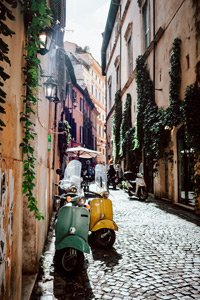
- Rome Kids & Families Tours
Famous places in ancient Rome: landmarks, monuments and historical sites
Home / Blog / Famous places in ancient Rome: landmarks, monuments and historical sites
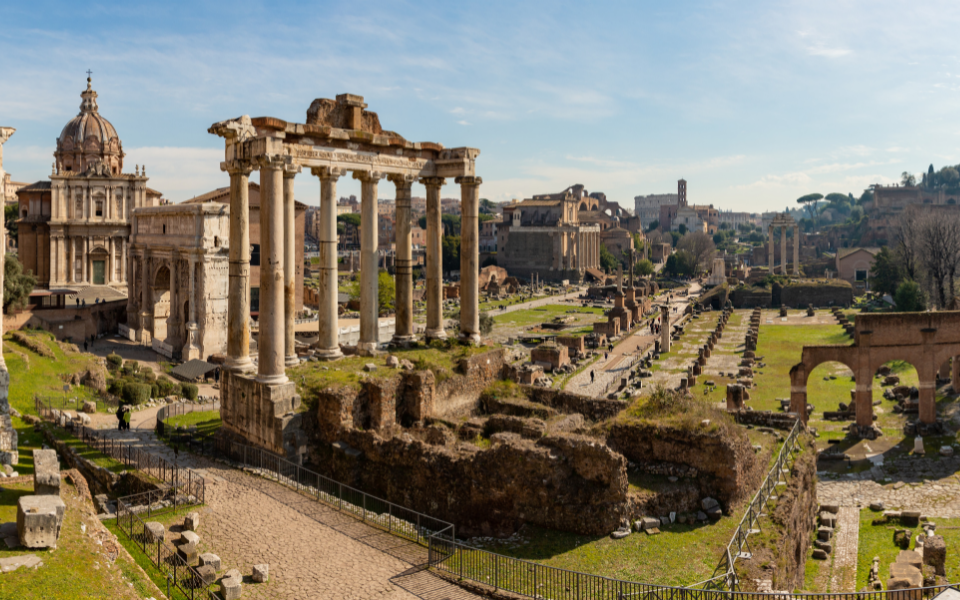
Italy with its vast historical landscape is home to numerous ancient Roman sites. These remnants are a testament to the far-reaching influence of the Roman Empire, which spanned over both continents and centuries.
While evidence of this remarkable civilization can be found in various regions it is in Italy – the heart of the empire – where some of the most iconic and well-preserved sites are harbored. Among these treasures the capital city of Rome stands out. It was the epicenter of the Roman world, adorned with awe-inspiring architecture, forums, temples, and arenas. Many of these f amous places in ancient Rome have withstood the test of time offering a remarkable glimpse into the past.
In the upcoming sections we will delve into what makes ancient Rome truly exceptional by exploring some of the famous places in ancient Rome.
These are the iconic sites that beckon travelers and history enthusiasts alike, urging them to embark on a journey of discovery. These are the destinations that one should aspire to visit at least once in a lifetime. As we help you uncover the stories, histories and significance behind each of these renowned sites you will gain a deeper appreciation for the treasures that Rome has preserved throughout the ages.
So prepare to embark on a virtual pilgrimage through time as we guide you through the must-visit landmarks of ancient Rome, each holding a piece of the city’s extraordinary past.
Top 3 historical sites in Rome, Italy
The ancient Roman landmarks are not mere historical relics but integral components of the city’s urban fabric. Each of these sites whether it be the Colosseum, Roman Forum, or the Pantheon bear the weight of a millennia of history, and together they embody an unrivaled artistic and cultural heritage. Born from the humble origins of a small settlement in 753 BC, the Roman Empire expanded to become a colossal superpower reaching its zenith in the 2nd century AD under the rule of emperors like Augustus and Trajan. However, it eventually succumbed to internal strife and external pressures leading to its gradual decline and eventual fall in the 5th century AD. Throughout this rise and fall these landmarks have stood as witnesses to the empire’s glory and its eventual transformation into the eternal city we know today, offering a tangible link to Rome’s enduring legacy.

Among the plethora of Italy monuments, Rome stands as a city that boasts an impressive array of historical treasures. Perhaps the most iconic of them all is the Colosseum, a majestic marvel that continues to leave visitors in awe with its sheer grandeur and impeccable state of preservation.
This enormous amphitheater is accessible through one of our unforgettable tours and stands as an enduring symbol of ancient Rome’s architectural prowess and entertainment extravagance. Its immense scale and intricate design are a testament to the engineering genius of the time and its history, filled with gladiatorial contests and epic spectacles, is as captivating as the structure itself. The Colosseum’s monumental presence in the heart of Rome makes it an indispensable stop for anyone seeking to immerse themselves in the city’s rich history and culture.
The Pantheon, one of the most famous buildings in ancient Rome , is a true marvel nestled in the heart of the city. Accessible through one of our carefully guided tours it seamlessly integrates into the modern urban architecture surrounding it making it a timeless masterpiece.
This architectural gem – originally built by Emperor Augustus’s son il law Agrippa and later reconstructed by Emperor Hadrian in the 2nd century AD – boasts a stunning dome that was a revolutionary feat of engineering for its time. What sets the Pantheon apart is its enduring legacy as a place of worship, transforming from a pagan temple to a Christian church, and its remarkable state of preservation, with its iconic dome still standing as the world’s largest unreinforced concrete dome. Its breathtaking interior illuminated by the oculus continues to captivate visitors, making the Pantheon an essential stop for those seeking a glimpse into ancient Rome’s architectural genius and spiritual history.

Roman Forum
For those in search of famous sites in ancient Rome the Roman Forum is an absolute must-see during your stay in the city. Do not miss the opportunity to explore it through our offered curated experience .
This historical treasure offers a captivating journey into the heart of ancient Roman life and politics. Once the bustling center of commerce, politics, and culture the Roman Forum is now a sprawling archaeological site that preserves the remnants of temples, government buildings, and monuments that were integral to the life of the empire. By strolling through its ancient pathways you’ll be transported back in time, and the ruins will come alive with stories of emperors, senators, and citizens who once walked these very streets. It is an important destination for anyone eager to explore the rich history and vibrant past of ancient Rome.

Other famous sites in Ancient Rome:
Certainly when we discuss ancient sites it is important to clarify that these three famous landmarks are not the sole attractions that were popular in ancient Rome . Ancient Rome was brimming with a multitude of remarkable sites each with its own unique historical and cultural significance.
While the Colosseum, Pantheon, and Roman Forum are undoubtedly iconic and continue to capture our imagination today, they are just a fraction of the wealth of historical and architectural treasures that existed in the ancient city. Throughout Rome and its vast empire, there were countless other temples, theaters, bathhouses, villas, and monuments that enriched the daily life and culture of the time. Exploring these lesser-known gems can provide a more comprehensive understanding of the grandeur and diversity of ancient Rome’s heritage.
Circus Maximus:
The Circus Maximus, often referred to as the most important place in ancient Rome , is steeped in history and mythology as it is said to have been commissioned by the legendary first king of Rome, Romulus. This vast, ancient stadium was a centerpiece of Roman entertainment, hosting chariot races, athletic competitions and various public events for centuries.
Situated in the valley between the Aventine and Palatine hills the Circus Maximus offered a sprawling arena that could accommodate tens of thousands of spectators making it one of the largest venues of its kind in the ancient world. Its long, rectangular shape and distinctive obelisks at both ends added to its grandeur. To truly appreciate the historical significance and scale of the Circus Maximus it is best to visit it during a calm morning or a late afternoon. These quieter times allow you to envision the ancient chariots thundering along the tracks and the enthusiastic crowds filling the stands. While much of the original structure has been lost to time the site itself still carries a powerful sense of the past, providing a unique glimpse into the entertainment and communal life of ancient Roman time.
Palatine Hill:
The Palatine Hill, a famous landmark in ancient Rome , holds immense historical significance central to the empire’s history. You can explore this ancient site with our tour to experience a captivating blend of history and archaeology. Visiting the Palatine Hill is most enjoyable during the morning or late afternoon when the weather is pleasant, and sunlight illuminates the ancient ruins. Allocate 1 to 2 hours for a fulfilling visit or more, if you are a history enthusiast or deeply interested in archaeology. This site offers a fascinating journey through time, shedding light on the empire’s history and the lives of its emperors and elites.
The Catacombs, reflecting the complex relationship between Christianity and the Roman Empire, are a network of underground burial sites scattered across Rome. Visit the catacombs with us to get a fascinating glimpse into early Christian history and the challenges faced by the faith during Roman times.
The Catacombs are of great interest due to their historical and religious significance. These subterranean chambers served as burial places for early Christians, showcasing intricate frescoes and carvings that depict the art and symbols of the era. The most renowned catacombs include San Callisto, San Sebastiano, and Domitilla, each offering a unique perspective on early Christian life.
Baths of Caracalla:
The Baths of Caracalla are a significant site in ancient Rome and have a fascinating history that is worth knowing. Emperor Caracalla, who ruled from 211 to 217 AD, commissioned these baths, which were completed around 216 AD. These baths were massive, covering about 25 acres and offering a wide range of amenities such as baths, pools, gyms, gardens, and libraries. They reflect the opulence of Roman society at the time and are a testament to the Romans’ passion for communal leisure. Today, their impressive ruins provide a glimpse into ancient Rome’s architectural and luxurious lifestyle.
The Via Appia , also known as the Appian Way, is a captivating ancient Roman road dating back to 312 BC, connecting Rome to the south of Italy. It offers a unique blend of history and physical activity making it an intriguing destination. You can rent a bike to explore its well preserved sections, passing scenic countryside and historic sites like the Tomb of Cecilia Metella and the Catacombs of San Callisto. For a memorable visit plan a half-day excursion, wear comfortable clothing, and bring water and sunscreen, especially in warm weather. It is a must-visit for history enthusiasts and active travelers.
Visiting Ancient Rome:
Why settle for just one dose of ancient Rome’s magic when you can embark on a journey through time with Walks Inside Rome’s captivating tours?
Picture yourself strolling the iconic landmarks of ancient Rome , from the awe-inspiring Colosseum to the grandeur of the Roman Forum and beyond.
But wait, there is more!
You don’t have to limit yourself to just one tour. With the option to organize multiple tours over several days you can truly immerse yourself in the rich history and culture of this remarkable city. Or, for those seeking a whirlwind adventure, take advantage of our offers that allow you to visit multiple famous Roman places in a single day, like a time-traveler on a mission to explore the past.
Even with limited days at your disposal you can unlock the secrets of ancient Rome and create memories that will transport you back to a bygone era. So why wait? Join us for an unforgettable journey through the heart of history, and let us make your Roman adventure a time-traveling delight!
Related Tours

Farmers’ Market Shopping with Roman Full Course Class | Shared
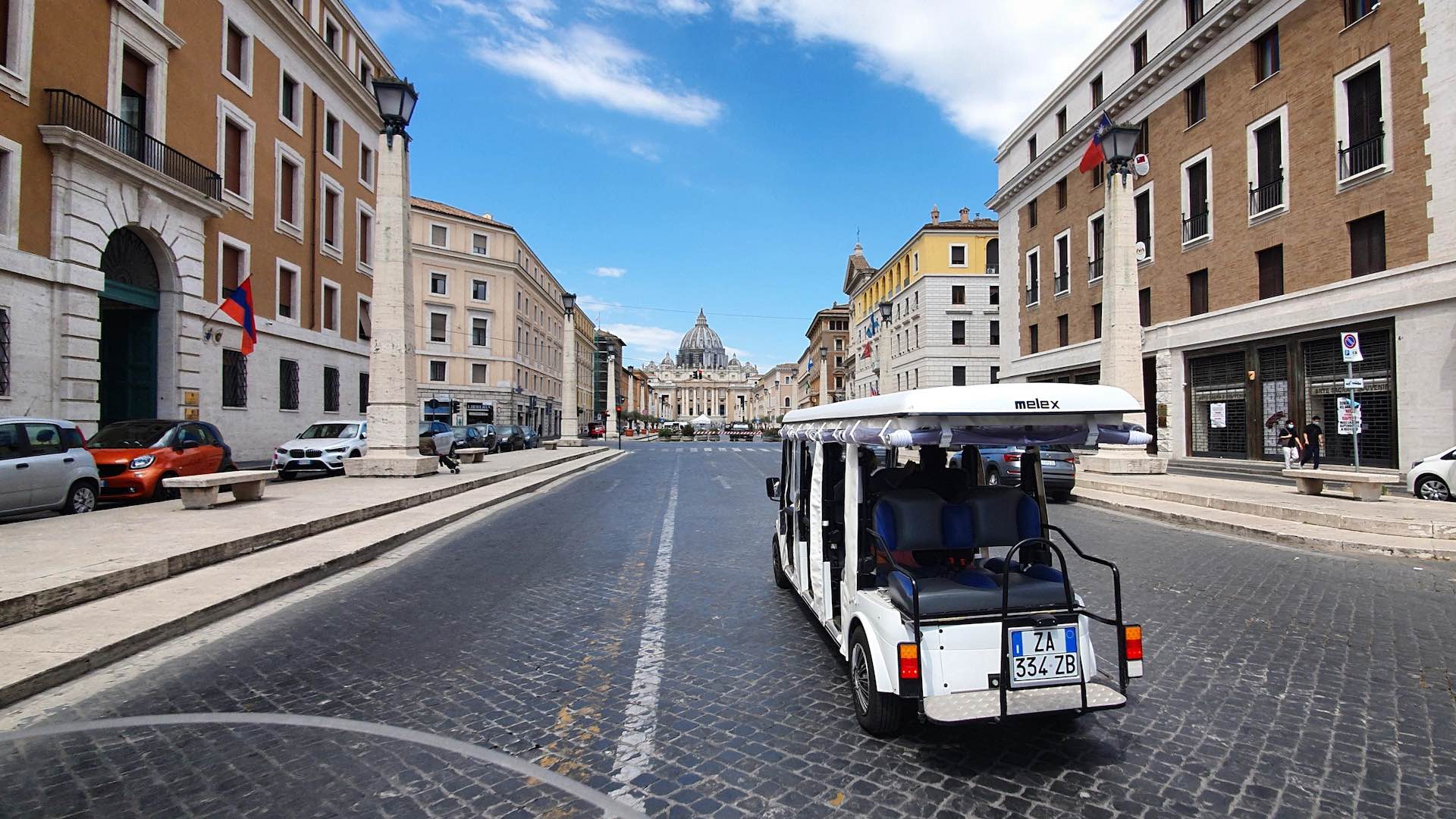
Golf Cart Tour of Rome | Private

Testaccio Food Tour | Private
- Rome Guided Tours
- Cooking Classes in Rome
- Rome for Kids Tours
- Rome Small Group Tours
- Walks Inside Rome
- +39066624626
- +393387791615
- Privacy Policy
- Cookie Policy
Forgot your password?
Lost your password? Please enter your email address. You will receive mail with link to set new password.
Back to login

Guide: the historical places in Rome (itinerary)
Rome, the capital of Italy, is an ancient city filled with treasuries of history and culture; With a history spanning more than 2,500 years, Rome is home to some of the world’s most iconic and historical places. From the Colosseum’s grandeur to the intricacies of the Roman Forum, the city is a testament to the achievements of one of the world’s greatest civilizations. The ancient Romans left a lasting legacy of historical places that continues to fascinate people to this day.
This itinerary is filled with the most historical places in Rome, such as the St. Clement Basilica, the Villa Gregoriana, and the Colosseum. These places will give you a deeper understanding of the history and culture of ancient Rome and the impact it had on the world today. I am excited to take you on this journey and share my knowledge and passion for this incredible city. Let’s get started!
Page Contents
Tips for visiting Ancient Rome
- Rome is known for its waiting in lines, so don’t try and attempt to visit every landmark in Rome during your trip unless you’re staying for a week or longer. Instead, savor the city’s atmosphere and try to discover some more unique landmarks.
- Try to visit the historical places in Rome during the off-peak season: it can get very crowded, especially during the summer months. Visiting during the off-peak season (spring or autumn) will give you a more pleasant experience.
- Ancient Rome has a rich history, with many layers of history to uncover. Consider taking a guided tour from an archaeologist, as they will be able to give you a deeper understanding of the history and significance of the sites you are visiting.
- When it comes to food, Rome is a true paradise for travelers. The city is renowned for its delicious traditional Italian cuisine , so we created a Foodie’s Guide that lists the best places to eat in Rome .
- One tip is to pick a place to stay in the city’s historic center when visiting ancient Rome. This will allow you to easily visit popular landmarks such as the Colosseum, the Roman Forum, and the Pantheon, all of which are located within a few kilometers of each other.
Rome Itinerary day 1: Ancient Rome from Above
We start our journey through some of the historical places in Rome from above by visiting some places that are off the beaten path.
Our first stop on this itinerary is the neighborhood of Trastevere, one of the oldest and most charming neighborhoods in Rome. Trastevere is known for its narrow, winding streets, colorful buildings, and lively atmosphere. It’s a great place to wander and discover the city’s hidden gems. Here you can find some of the best restaurants, bars, and pubs in town. We will also visit the beautiful church of Santa Maria in Trastevere, one of the oldest churches in Rome and a must-see for any history buff.
We start this journey by venturing away from the Tiber River to discover the charming area around Trastevere. You’ll recognize this region by its picturesque and medieval streets. In the western part of the neighborhood, you’ll find the Vicolo della Frustra steps, guiding you to the top of the hill.

Tempietto del Bramante
Before arriving at the top, we’ll come across the Tempietto del Bramante, a small circular temple built in the early 16th century by the famous Italian architect Donato Bramante. It is known for its architectural and artistic significance as one of the most important examples of High Renaissance architecture. It is a masterpiece of architectural harmony, proportion, and symmetry.
According to the legends, Saint Paul (the most influential apostle of Jesus Christ) was beheaded on the site where the Tempietto del Bramante now stands because of his efforts to spread the message of Christianity.
Janiculum Hill
When we continue our hike, we arrive at Janiculum Hill, one of the most charming and panoramic spots in Rome; here, we can see the entire city and get a sense of the ancient Roman’s lay of the land.
Next to its view, Janiculum Hill is also home to several important monuments and landmarks; The most famous one is the Fontana dell’Acqua Paola, a beautiful fountain built in 1612 – the perfect spot to take a break, enjoy the view and take some pictures.
Janiculum Hill is also famous for the “Gianicolo cannon” which is fired every day at noon, following a tradition that dates back to 1847. The cannon fire signals the city and the surrounding hills that it’s noon and also a way of testing the cannon.
Janiculum Terrace
On the top of this hill, we also find the Janiculum Terrace, one of the most panoramic terraces in Rome. From here, you can enjoy a beautiful view of the city and the surrounding hills. It’s a perfect spot to end our first day and take one last look at the ancient city of Rome before heading back down.
Rome Itinerary day 2: Ancient Rome from Below
On our second day visiting the historical places in Rome, we explore the ancient ruins and structures that lie beneath the modern city.
Because when we walk through the city, we notice that many of the buildings and monuments have a certain aged appearance. This is because they are built on top of ancient ruins or made of ancient materials. This is because Rome has been built, rebuilt, and repurposed many times throughout its history.
For instance, let’s take the example of the Domus Aurea or “Golden House” of Emperor Nero, a palace complex built after the fire of 64 AD, that was later covered with earth and debris. It was rediscovered in the 15th century after being buried and forgotten for centuries.
The city of Rome is covered with these ancient catacombs, subterranean tombs, and underground structures that lie beneath the city. The Catacombs of San Callisto and the Catacombs of San Sebastiano are two of the most famous and well-preserved examples.
Stazione San Giovanni Metro C
We start our second day in Rome on The Metro C train, also known as the Rome Metro Line C. It is a relatively new metro line in Rome, as it only has been in operation since 2014. But what makes it special are the several important archaeological discoveries that were made during the construction!
The metro line construction required digging deep beneath the city of Rome, which allowed archaeologists to study the layers of history beneath Rome.
Many of the discoveries made during the construction of the Metro C train were ancient Roman ruins and artifacts. Some of the most notable finds include the remains of an ancient Roman theater from the 2nd century AD, the remains of an ancient Roman market, a Roman road, an ancient Roman bath, and a Roman tomb from the 1st century AD.
Most of the ruins and artifacts discovered during the metro line construction are on display in museums or in situ. Still, the station is covered with giant infographics that show and explain the history of this part of the city.
St. Clement Basilica
Another location where you can admire these ruins is the Basilica of Saint Clement, as it is known for its rich history and cultural significance; It has been a place of worship for over 1800 years and has witnessed many important events in the history of Rome and Christianity.
This is because the church was built on the site of an earlier church that was constructed in the 1st century AD, making it one of the oldest churches in Rome. The current church, which dates back to the 12th century, is built on top of the remains of the earlier church, as well as a 4th-century church and a 1st-century Roman house.
This church is named after Saint Clement, the third pope of Rome and one of the early Christian martyrs. According to legends, Saint Clement was exiled to the Black Sea region and was martyred there. His remains were later brought back to Rome and buried in this church.
However – the most notable feature of the Basilica of Saint Clement is its subterranean levels, which reveal the layers of history beneath the church. Visitors can explore the remains of the 1st-century Roman house, which was discovered during excavations in the 19th century. The house features frescoes, mosaics, and an underground cistern, providing a glimpse into the daily life of ancient Romans.
The 4th-century church, which was discovered during excavations in the 20th century, features well-preserved frescoes and mosaics, which are considered some of the most important examples of early Christian art.
The 12th-century church, which is the current church, features beautiful frescoes, mosaics, and a reliquary containing Saint Clement’s skull. The church also has a beautiful cloister, a peaceful and quiet place to reflect and admire the architecture.
Domus Aurea
The last location to spend our day between these ancient catacombs and underground structures underneath the city, is Domus Aurea.
The Domus Aurea , or “Golden House”, was a palace complex built by Emperor Nero in 64 AD, after the “Great fire of Rome” destroyed much of the city of Rome. The palace was known for its grandeur, and it covered an area of over 100 acres, including part of the Palatine Hill and the Oppian Hill, stretching as far as the Colosseum. It was a grand palace with frescoes, mosaics, and sculptures in every room, and it was said to have included artificial lakes, fountains, and a great golden statue of Nero himself.
The palace was abandoned after the death of Nero in 68 AD and was later covered with earth and debris and thus lost to history. The palace was rediscovered in the late 15th century by the Italian scholar Raphael and his friends, who stumbled upon a cave-like space while digging in the area. The artist was fascinated by the frescoes and decorations he found, and he started to explore the space and he began to spread the word about the discovery, attracting a lot of attention.
This rediscovery of the Domus Aurea marked a turning point in the history of art and architecture. The frescoes and decorations of the palace, which were preserved for centuries, profoundly influenced the development of Renaissance art.
The Domus Aurea was opened to the public in 1999 after a long and complex restoration process aimed to preserve the frescoes and decorations while making them safe for visitors. Today, visitors can take guided tours of the palace to admire the frescoes and decorations and to understand the grandeur and opulence of the palace of Emperor Nero.
Rome Itinerary day 3: Ancient Rome through Borromini’s Baroque Masterpieces
On our third day wandering around Rome, we plan to discover some of the most beautiful and significant Baroque masterpieces made by Francesco Borromini , one of the most important Baroque architects in Rome in the 17th century.
He left a significant architectural legacy in the city, and today we’re visiting his notable Baroque masterpieces in Rome.
Chiesa di San Carlino alle Quattro Fontane
First, we will visit the Church of San Carlino alle Quattro Fontane, also known as the Church of St. Charles at the Four Fountains. This church is considered one of the masterpieces of the Baroque architect Francesco Borromini.
The church was built in the 17th century, during the Baroque period, and it is known for its striking curved facade, which is adorned with four fountains, and its beautiful dome. The church is also known for its unique and innovative design, incorporating Renaissance and Baroque elements.
Inside, the church is equally impressive, with its ornate decoration, frescoes, and sculptures. Borromini himself made the church’s decoration, which is also famous for its beautiful dome, adorned with frescoes and sculptures.
The church is open to visitors throughout the year, and guided tours are available to help visitors understand the historical and cultural significance of the church.
St. Ivo alla Sapienza
Next, we will visit the St. Ivo alla Sapienza. This church is known for its striking and unique design, incorporating elements of both the Renaissance and the Baroque. The church was built for the University of Rome and was used as a place of worship for the students and as a theater.
Nowadays, the church is known for its striking and unique design, which incorporates Renaissance and Baroque elements. One of the most notable features of St. Ivo alla Sapienza is its dome, which is adorned with frescoes and sculptures. The dome is one of the most beautiful examples of Baroque architecture in Rome, and it is a must-see for anyone interested in the history of architecture. The church’s courtyard is also famous for its geometric design and is a notable example of Baroque architecture in Rome.
The Oratory of Saint Philip Neri
Finally, we visit the Oratory of Saint Philip Neri, another church designed by Borromini. This church is known for its striking and unique design, incorporating Renaissance and Baroque elements.
One of the most notable features of The Oratory of Saint Philip Neri is its dome, which is adorned with frescoes and sculptures. The dome is one of the most beautiful examples of Baroque architecture in Rome, and it is a must-see for anyone interested in the history of architecture. Additionally, the church’s facade is impressive as it is adorned with statues.
The church was built by Saint Philip Neri, an Italian priest and founder of the Congregation of the Oratory, a society of secular priests dedicated to a life of apostolic poverty and the spiritual formation of laypeople. The church is still an active place of worship and is open to visitors throughout the year.
Rome Itinerary day 4: Ancient Rome through the Piazzas
Ancient Rome was one of the world’s most powerful and influential empires, and its legacy can still be seen in the city’s piazzas today. These piazzas were the center of political, social, and economic life in ancient Rome and were the sites of many important historical events.
Piazza del Campidoglio
First, we will start our journey by visiting the Piazza del Campidoglio, one of the most famous historical places in Rome. This piazza is located on top of Capitoline Hill, which is the smallest of the seven hills of Rome.
Michelangelo designed the Piazza del Campidoglio in the 16th century and is a beautiful example of Renaissance architecture in Rome. From here, you can enjoy a panoramic view of the Roman Forum, one of Rome’s most important historical places.
The piazza is rectangular, surrounded by three palaces: The Palazzo dei Conservatori, The Palazzo Nuovo, and the Palazzo Senatorio. These palaces are home to some of the most important museums in Rome, including the Capitoline Museums, which house many important works of art and sculptures from ancient Rome.
Saint Peter’s Square
Next, we will head to Saint Peter’s Square, one of the world’s most famous piazzas. This piazza is located in front of Vatican City and is one of the most important historical places in Rome.
The piazza’s centerpiece is the obelisk, an ancient Egyptian monolithic monument; it is 25 meters tall and was brought to Rome by Emperor Caligula in 37 AD. The obelisk was originally erected in the Circus of Nero. Pope Sixtus V moved it to its current location in the 16th century.
The piazza is also home to Saint Peter’s Basilica, which is one of the most important historical places in Rome. The basilica is the mother church of the Roman Catholic Church, the largest church in the world, and is one of the most important examples of Renaissance architecture in Rome.
The Saint Peter’s Square is not only an architectural masterpiece but also an important religious and cultural site, it is the site of many important events in the Catholic Church, such as canonizations, beatifications, and papal elections.
Piazza Navona
Next, we will make our way to Piazza Navona, one of the most famous piazzas in Rome. This is because it houses three beautiful Baroque fountains (Fontana dei Quattro Fiumi, Fontana del Moro, and Fontana del Nettuno) . These fountains are surrounded by beautiful buildings and historic churches, which showcase the beauty and grandeur of Baroque architecture.
The piazza is surrounded by beautiful buildings and historic churches, which showcase the beauty and grandeur of the Baroque architecture. It is also home to several important historical buildings, such as the Church of Saint Agnes in Agony and the Church of Saint Luigi dei Francesi.

Piazza S. Ignazio
Finally, we will visit Piazza S. Ignazio, located on the corner of the Piazza Navona. This piazza is home to the church of Saint Ignatius of Loyola, another example of Baroque architecture. The fresco creates the illusion of a three-dimensional space, which is an architectural and artistic achievement.
Rome Itinerary day 5: Ancient Rome, the ruins.
There are many ancient ruins between the historical places in Rome, as the city has a long and rich history dating back over 2,500 years. These ruins offer a glimpse into the past and provide insight into the daily lives of the ancient Romans.
Rome’s most famous ruins include the Roman Forum, the Colosseum, the Pantheon, and the Baths of Caracalla. Which we’ll all visit today.
Our first stop on our tour of Rome’s ruins is the Colosseum, one of the most iconic and recognizable historical places in Rome, attracting over 7 million people each year.
The Colosseum is an ancient amphitheater built in 80 AD and is one of the greatest engineering feats of the ancient world. It was used for gladiatorial contests and public spectacles such as animal hunts, mock sea battles, and dramas based on classical mythology.
As you enter the Colosseum, you’ll notice the impressive scale of the structure. With a capacity of up to 50,000 spectators, it was the largest amphitheater in the world at the time of its construction. The Colosseum was built using a combination of concrete and stone and still stands today as a testament to the engineering skills of the ancient Romans.
As you make your way around the Colosseum, you’ll learn about the different parts of the structure, including the arena floor, the seating tiers, and the underground chambers. You’ll also learn about the various uses of the Colosseum throughout its history, from gladiatorial contests to public spectacles and even as a quarry for building materials in the Middle Ages.
The Colosseum offers a unique opportunity to gain a deeper understanding of the grandeur and spectacle of ancient Roman culture. It’s not only a must-see destination for anyone visiting Rome, but also it’s one of the most important historical places in Rome. That’s why we would advise you to take a guided tour, as those allow you to visit the underground of the Colosseum. It’s a unique opportunity to see the Colosseum’s hidden parts and better understand how the gladiatorial games were organized.

Roman Forum
Next, we will make our way to the Roman Forum, which is located just a short walk from the Colosseum. The Roman Forum was the center of political and social life in ancient Rome and was once the heart of the Roman Republic and Empire.
The Forum was home to the city’s most important political and religious buildings, including the Temple of Saturn, the Temple of Vesta, and the Curia. It was also the site of many important public speeches and ceremonies.
As you make your way through the Roman Forum, you will see the remains of some of the most significant buildings of ancient Rome. The Temple of Saturn, for example, was the oldest temple in the Roman Forum, dating back to the early days of the Roman Republic. The Temple of Vesta is another important site, it was the goddess of the hearth and home and the most important temple of the Roman state religion. The Curia, which was the meeting place of the Roman Senate, is another notable building.
The Roman Forum is not only an important historical place in Rome but also a great place to explore ancient Roman architecture, it’s a great place to take a stroll and imagine what life was like in ancient Rome. The Roman Forum offers a unique opportunity to gain a deeper understanding of ancient Rome’s political and social life.

Insula Romana
We will then head to Insula Romana, which is located in the Monti neighborhood. The Insula Romana is a group of ancient Roman apartment buildings and is one of the best-preserved examples of ancient Roman domestic architecture. These apartment buildings, also known as insulae, were the homes of the lower and middle classes in ancient Rome and were typically built around a central courtyard.
As you make your way through the Insula Romana, you will see the remains of ancient Roman apartments, which offer a unique glimpse into the daily life of ancient Romans. These apartments were typically three or four stories high and were home to multiple families, each with their own living quarters.
Villa Gregoriana
Finally, we will end our tour at the Villa Gregoriana, a nature park located in Tivoli. The Villa Gregoriana is a beautiful park that was created in the 19th century by Pope Gregory XVI , who wanted to create a public park to showcase the natural beauty of the area and to provide a place for the public to enjoy.
As you make your way through the Villa Gregoriana, you will see a beautiful combination of nature and art. The park features a variety of natural landscapes, including waterfalls, caves, and grottoes, as well as man-made features such as terraces, grottoes, and statues. One of the most impressive features of the park is the Grotta Grande, a large cave that was created by the erosion of a tufa rock, it’s a natural wonder that will leave you in awe.
The park is also a great place to explore the works of art and architecture created by Pope Gregory XVI, who wanted to create a public park to showcase the natural beauty of the area and provide a place for the public to enjoy. It’s a great place to explore the natural beauty of the area and enjoy the works of art and architecture that Pope Gregory XVI created.
Save for later …

Share this:
Hey there! I'm Elliot Clennam, a passionate photographer based in Brussels, Belgium. My love for capturing the essence of my surroundings has led me on countless adventures, from exciting road trips to bustling city escapes.
Similar Posts
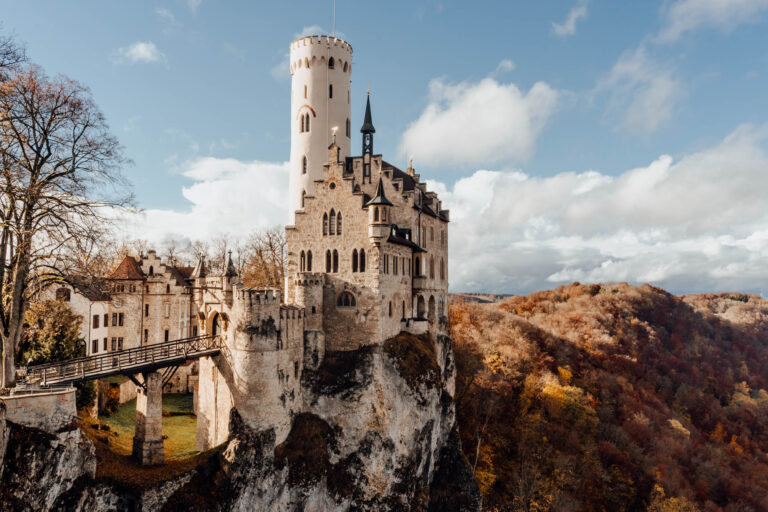
Schloss Lichtenstein, The Fairytale Castle of Württemberg
Schloss Lichtenstein was built by Count Wilhelm, inspired by the novel Lichtenstein. Its unique location – the top of…
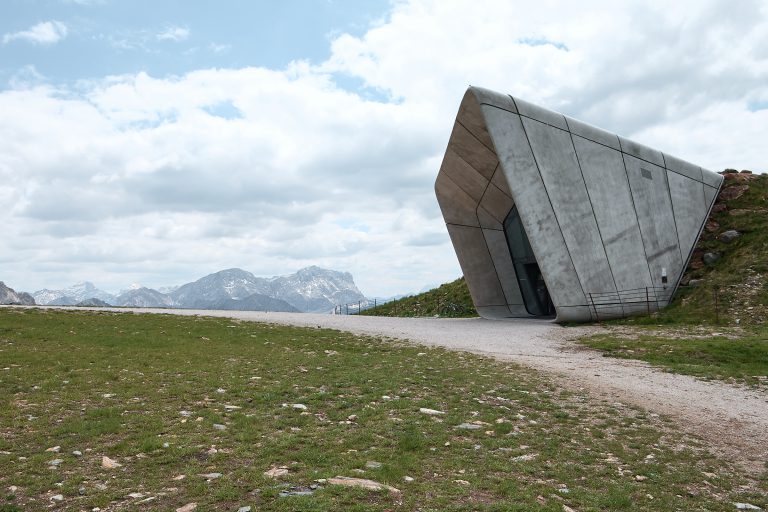
MMM Corones, a museum with a sublime view over the Dolomites
MMM Corones is a museum with an astonishing panoramic view over the Dolomites. In this blog post, we explain…
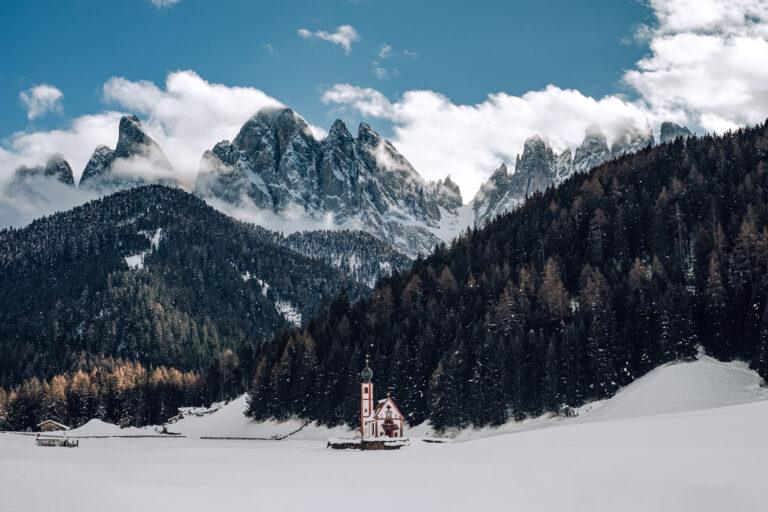
St Johann in Ranui Church, a symbol of the beauty
Hidden in the overwhelming mountains of the Dolomites lies a 1744 century church. We visited this St Johann in…

Travel guide to the Blue Lagoon Geothermal Spa in Iceland
If you’re planning on visiting Iceland, one of the must-see attractions on your Iceland Attractions Map is the Blue…
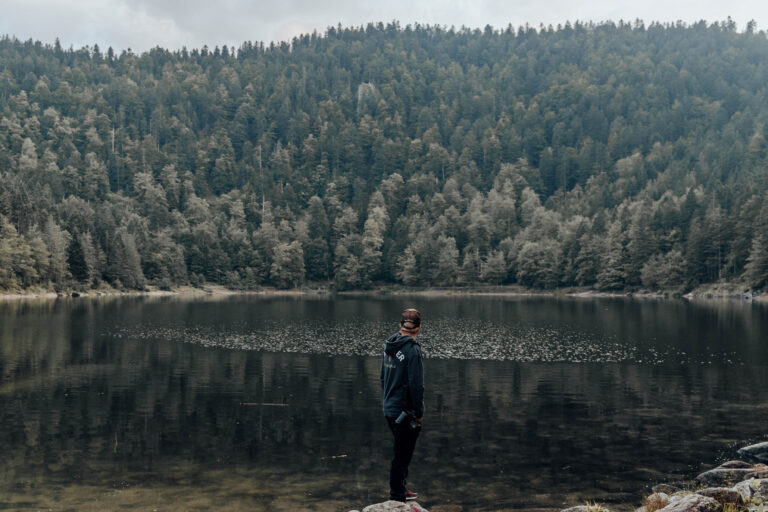
Lac des Corbeaux, the The Black Eye of the Vosges
In the heart of the Vosges mountains, you’ll find a mountain lake called Lac des Corbeaux, surrounded by beautiful…
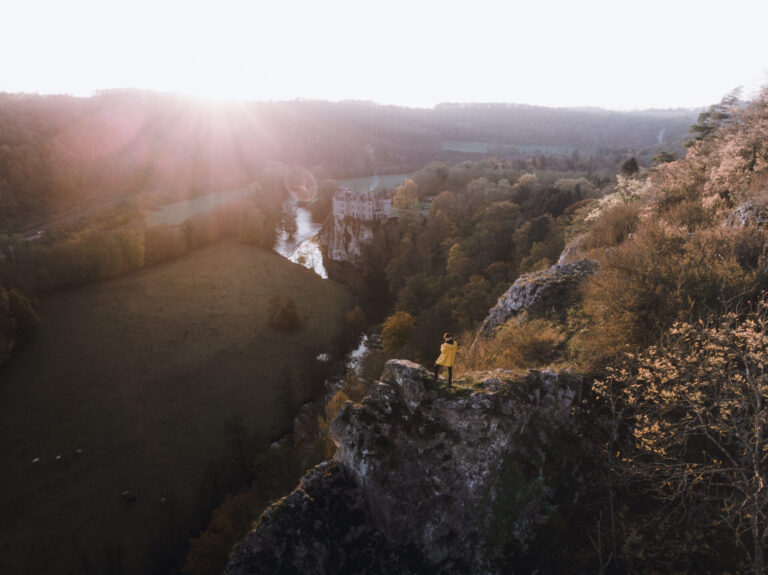
Exploring Walzin Castle: A Hidden Gem in Belgium’s Countryside
Nestled along the winding path of the Lesse River in Belgium, Walzin Castle emerged as an unexpected gem during…

25 Roman Ruins in Rome That You Have To See
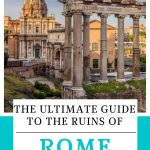
For as long as I can remember if anyone asked me what my dream destination was, I would say “Italy!”
I imagined creating the perfect Italy itinerary , seeing Ancient Rome , especially the Colosseum and Roman Forum , walking down the Appian Way , drinking lots of wine, and eating delicious pasta.
In my imagination, everyone talked passionately while gesturing with their hands, and lovers kissed in the middle of grand piazzas.
What I found in Rome wasn’t far from what I had imagined, and there were so many awesome things to do in Rome .
I discovered this tremendous collision of ancient and modern .
A place where two worlds seemed to meld seamlessly together to create this exciting fusion that not only works but is perfectly normal.
The Rome I found was full of life and passion just like I imagined. A city that engulfs you in history while the modern world continues around it.
I found Rome, the Eternal City!
And I couldn’t wait to explore the Roman history and this ancient city firsthand! There is no better way to do that than by exploring the ancient ruins in Rome!
In a city with so many UNESCO World Heritage sites, you are in for a treat for sure!
*This post contains affiliate links. By purchasing through these links, we get a small commission at no additional cost to you. That Texas Couple is also a participant in the Amazon Services LLC Associates Program. As an Amazon Associate, we earn from qualifying purchases.
Let’s Connect on Social Media!
- Instagram Follow
- Pinterest Follow
- TikTok follow
- Twitter follow
- YouTube follow
- Flickr follow
- facebook link
Love Freebies? Sign Up!
Sign up to receive your free travel printables including:
-Carry-on Only Packing List
-Ultimate Packing List
-40 Useful Travel Apps
-Weekly Vacation Planner
-10 Things to do Every Time You Travel
Roman Ruins in Rome
1. roman colosseum.

The Colosseum is the icon of Rome.
Standing for almost 2,000 years, the Colosseum , once named the Flavian Amphitheater, is probably one of the most recognizable monuments in the Roman world and in the world today, which stands to reason that it is a valuable piece of Roman history.
Of course, the structure that you see before you today is not the Colosseum that Titus saw in 80 AD during his rule of the Roman Empire. The Colosseum was a bright white structure with painted trim. The interior housed colorful frescos and statues of gods.
An awesome fact about the Colosseum is that the design of the building would allow 50,000 fans to enter and exit in about 15 minutes!
During the middle ages, chariot races and gladiator fights are some of the “games” that would be shown in the Colosseum to entertain the Roman people.
Sadly, the gladiators would fight one another or the wild animals, “the beasts,” to death.
The beasts here were from all over the world, especially North Africa, and included bears, lions, crocodiles, giraffes, and more, all of which were housed in the tunnels below the Colosseum, waiting for their turn to enter the ring.
Today, you can make your way to the stands and look down into the arena to see the underground tunnels , and personally witness this piece of ancient history.
We highly recommend taking an underground guided tour. This tour will take you into the underground tunnels to see them firsthand. You cannot get to the underground tunnels of the Colosseum without a guided tour , so book yours today, as they often sell out!
The Colosseum in Rome is truly a wonder of Ancient Rome! Consider doing this tour:
Getting Colosseum Rome Tickets
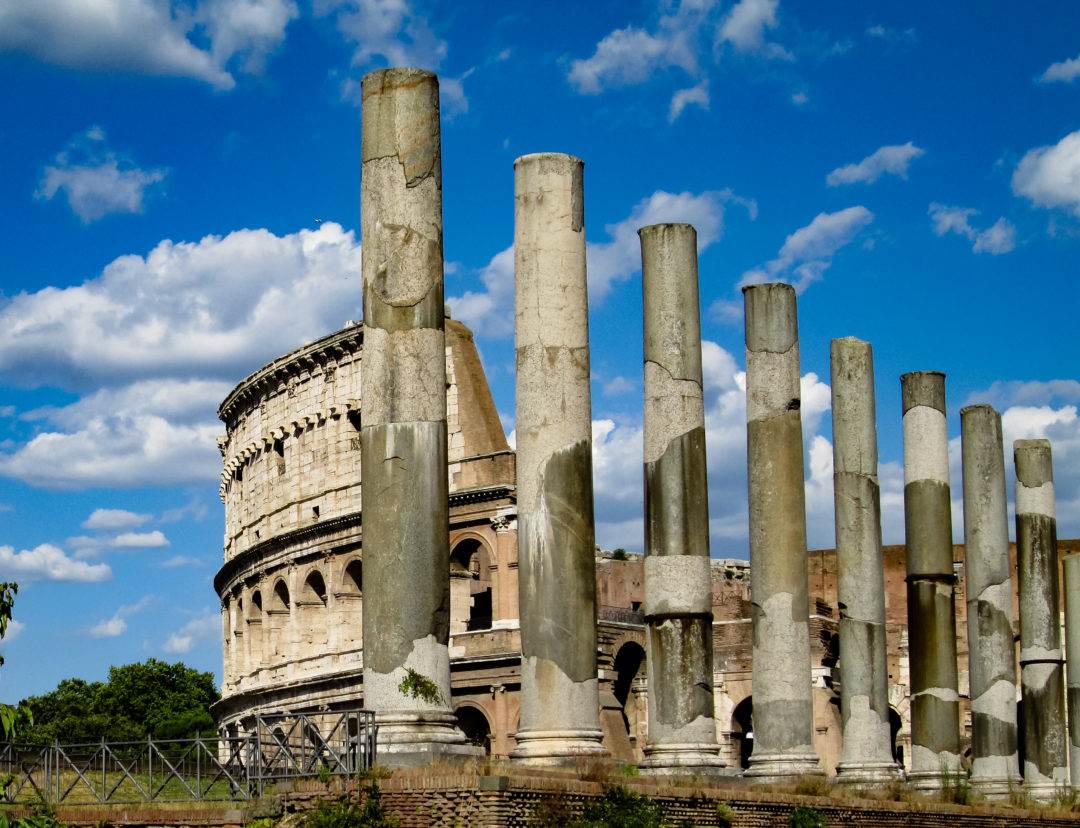
As one of the major attractions in Rome, the Colosseum is always busy. You can save time and money by following our tips for getting Colosseum Rome tickets.
Don’t waste your valuable vacation time standing in the long lines outside of the Colosseum. Instead, opt for one of the “skip the line at the Colosseum” options.
To skip the line, you can purchase your ticket in advance online at www.coopculture.it , buy a Roma Pass at the tobacco shop in the Metro station, or purchase a ticket at the entrance of Palatine Hill.
Of course, if it were me, I would pay for a guided tour to ensure that I learned all I could about the Colosseum.
If you purchase your ticket in advance at Palatine Hill or online, or if you buy a Roma pass, grab your ticket and look for the entrance marked ticket holders or Roma Pass. This allows you to bypass the line and just walk right up to the entrance!
Of course, if you purchase a guided tour that includes entry, then follow the instructions from your tour guide to see this piece of ancient history.
Recommended Colosseum Tours:
2. palatine hill.
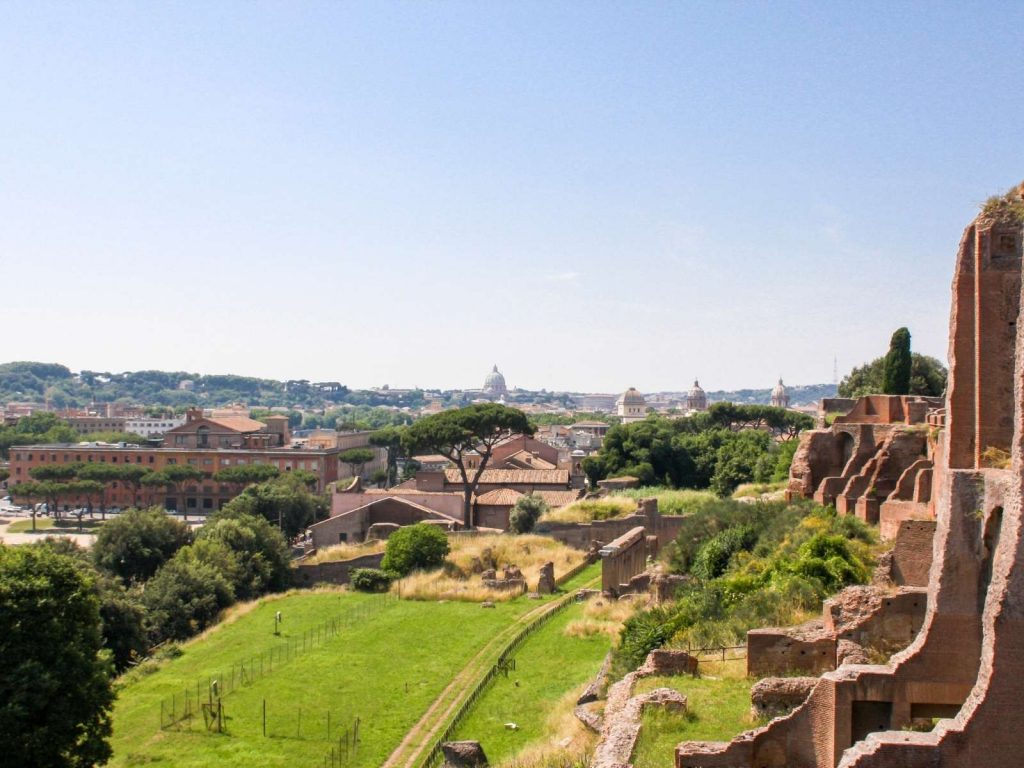
Located above the Roman Forum and across the street from the Colosseum in Rome, Palatine Hill is one of the city’s oldest parts, making it a genuine part of Ancient Rome and Roman history.
Inhabited since 1000 B.C., this area is a treasure trove of history.
According to the legend of Ancient Rome, there were two brothers, Romulus and Remus, who were raised by a she-wolf in a cave on this hill. The brothers grew up and decided to start a city by the river, but when they disagreed, Romulus killed Remus and then founded the city of Rome.
Thus how the ancient city of Rome got its name. It dates back to ancient times.
During the Republic, this area was regarded as one of the most prestigious neighborhoods in Rome and the Roman world.
Palatine allowed the residents to escape the noise and dirt while still in the city’s center. The remains of these luxury villas, including that of Rome’s first Emporer, Augustus, can still be seen today.
You can take this tour which includes access to the Colosseum arena floor, Roman Forum, and Palatine Hill if you would like a guide during your visit to these ancient Roman sites.
3. House of Augustus-Palatine Hill
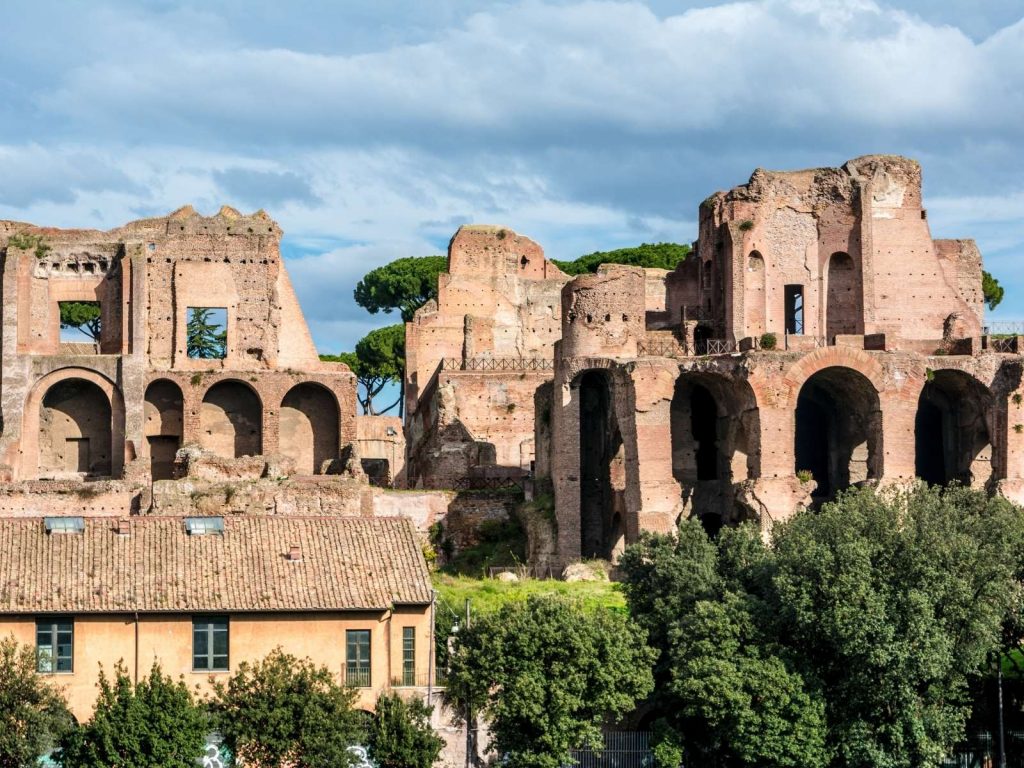
The House of Augustus was one of the most prestigious houses in ancient times.
The two-story home was located on a sacred hill area near the Temple of Appollo and on top of the Cave of Lupercal, where the She-Wolf of Rome is said to have nursed the twins Romulus and Remus.
This was the primary home of Emperor Augustus during his reign.
The two-story house was centered around two courtyards and is still strikingly beautiful.
While touring, notice how the home is separated into different areas. The western portion of the home housed the domestic rooms, and the eastern portion the reception rooms, a common theme in Roman times.
Behind the glass covering the walls, you can still see many of the vibrant-colored frescos that adorned the lavish home. These frescos highlight the home and are one of the highlights of these Roman ruins in Rome.
4. House of Livia-Palatine Hill
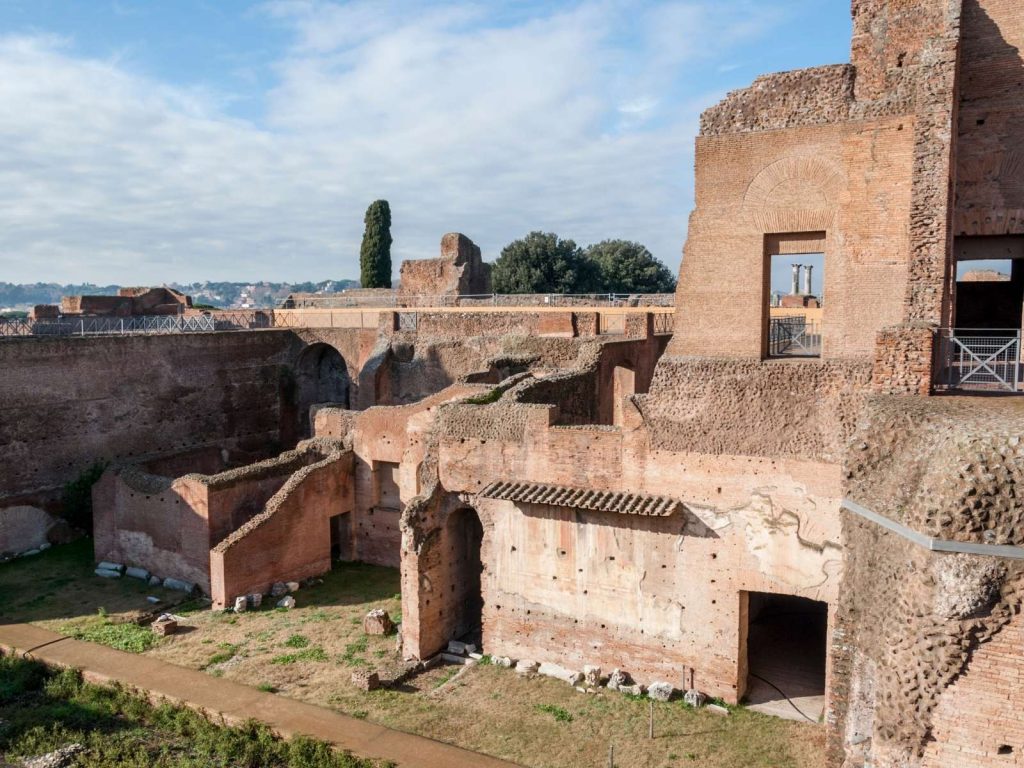
Livia was the third wife of Augustus, and if you bought a ticket to see the House of Augustus, you could also see the House of Livia.
The House of Livia was built in the 1st century B.C.
Surprisingly, Livia’s house was a bit larger than Augustus’ house. If the house is open, go inside and see the mosaics and frescoes painted on the walls and ceiling. You can still peek in the windows if the house is not open.
The most notable is the fresco in the central room showing Mercury kidnapping the nymph lo. Another notable fresco is the garden scene in the dining room which depicts flowering trees and birds.
It is important to note that the 1st century BC garden fresco was moved to the Palazzo Massimo all Terme Museum.
5. Domitian’s Palace-Palatine Hill
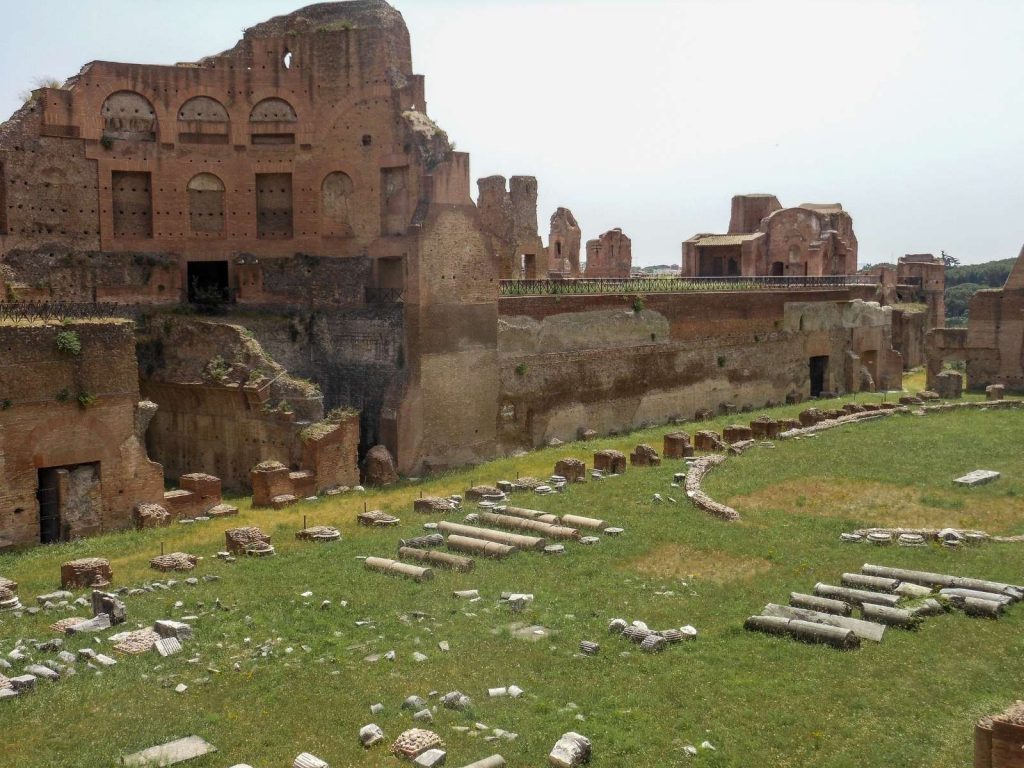
Domitian’s Palaces is an imperial palace built around 81 AD by Emperor Domitian.
This ancient ruin was so grand that it was home to the emperors of Rome for three centuries!
The palace was different than other palaces as Emperor Domitian wanted to show his status as, in his words, “lord and god.”
Domitian’s Palace was grand, for sure. It included a basilica, a stadium, an audience hall, a sunken garden, and baths!
Notice that there is even part of the palace above Circus Maximus. The Circus Maximus is a grassy area that was once the area where the chariot races were once held. It is said that people would often visit the Circus Maximus when the Colosseum in Rome wasn’t in session or was filled.
Emperor Severus added this portion of the palace.
Exploring this part of ancient Rome is so intriguing. They are such excellently preserved ancient sites showcasing Roman history.
6. Arch of Titus-The Roman Forum
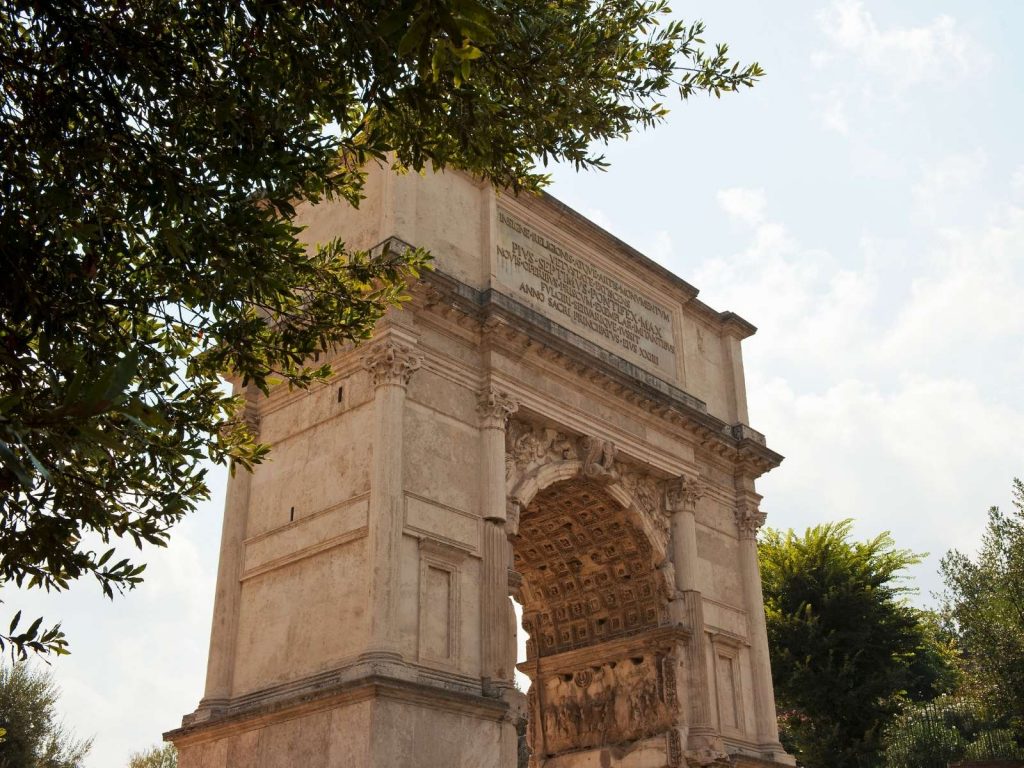
The triumphal Arch of Titus was erected to commemorate the Romans conquering Judea (Israel) and serves as the entrance to the Roman Forum.
Notice all of the reliefs inside the Arch of Titus that celebrates the leader, Titus.
Today, the scenes of the Roman troops conquering and ransacking Jerusalem seem anti-Semitic, but in ancient Rome, this was just the business of expanding their empire.
These graphic scenes made many Jews refuse to walk under the Arch of Titus.
While standing in this part of the Roman Forum, try to imagine the arch over a thousand years of age. It, like most ancient Roman ruins, would have been ornately decorated with colored marble and bronze during the height of the Roman Empire.
7. The Roman Forum

The Roman Forum was the hub of activity during Caesar’s time, housing political, religious, and commercial entities for imperial Rome. You can feel the strength of the Roman Empire surrounding you while visiting the Imperial Forums.
A little fun modern side note, check out the Forum on Google maps before your visit to see the complexity of it still today.
Still today it is one of the greatest tributes to the splendor of ancient Roman society. Unfortunately, after the fall of the Empire, the Roman Forum was pillaged and later forgotten.
It wasn’t until the 20th century that archaeologists began excavating the Roman Forum and uncovering this amazing area, and excavations are still ongoing today.
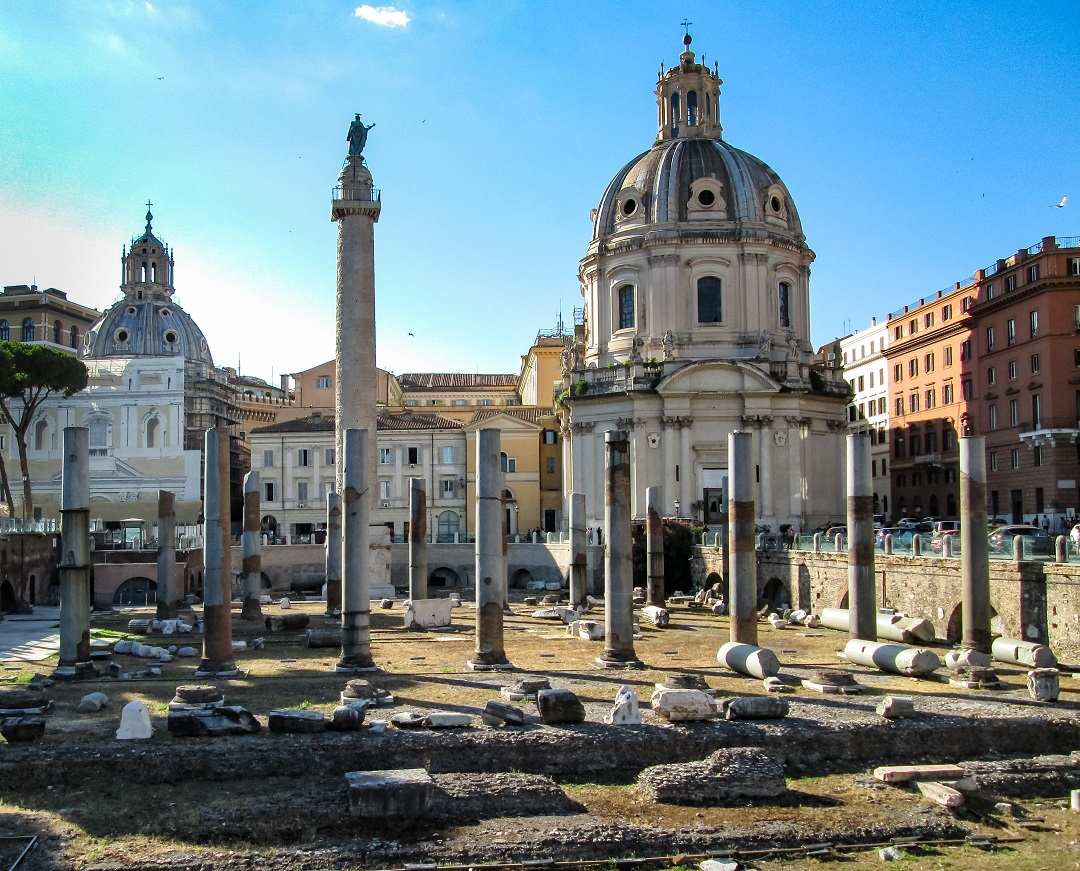
Walk down the Via Sacra , the main road leading into the Roman Forum, and realize that you are walking in the same area that Julius Caesar walked!
Notice the triumphal Arch of Septimius Severus , the Basilica of Constantine, which served as the Roman hall of justice and one of the most significant buildings in the Roman Empire.
The Temple of Vesta is a circular hut in the Roman Forum with columns surrounding it. This was said to be a sacred spot for Romans as they believed that as long as the sacred eternal flame burned inside, then Rome would stand. To ensure that the flame burned, priestesses tended the fire 24/7.
Also, see the Temple of Castor and Pollux , the temple dedicated to the twins of Gemini. these ancient ruins are one of the city’s oldest temples, built in the 5th century B.C. and also served as a meeting place for the Senate
Be sure to visit the Temple of Julius Caesar . The Temple of Julius Caesar is easy to spot; look for the metal-roofed structure with crowds of people and head in that direction.
In the Roman Forum on March 15, 44 B.C., the famous Emperor, Julius Caesar, was cremated after being stabbed to death.
You will also find the Curia (Senate House) was once the site of Rome’s official government and the heart of the Roman Empire.
The Temple of Divus Romulus is an excellent example of a well-preserved monument. I loved that the bronze door was original still on its original hinges. I bet it will last another thousand years or more!
These are all significant landmarks in Rome.
8. Trajan’s Forum & Trajan’s Market
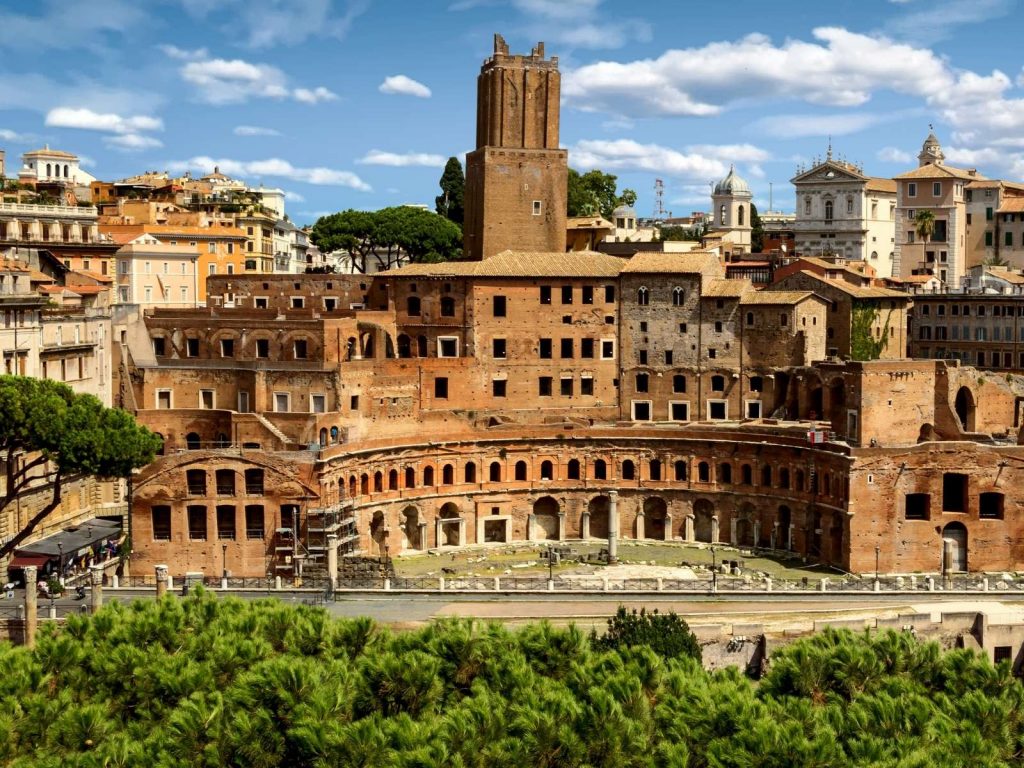
Across from the Roman Forum is another of the imperial forums built as Rome outgrew the Roman Forum that was added onto by many Roman rulers.
Most of what you see today can be attributed to Trajan, starting with the vast column erected in his honor, similar to the column dedicated to Marcus Aurelius in Piazza Colonna.
You will recognize it by the bronze statue of Emperor Trajan at the top, which is still in good condition.
The Forum of Trajan is actually the final Imperial Forum from ancient Rome.
Built in the 2nd century AD, Trajan’s Market is considered the world’s first shopping mall.
This building was a dense complex that stood six stories tall and contained over 150 shops and offices in Imperial Rome.
The column is hollow, and a staircase leads up to the balcony! In this area, you will also find Trajan’s Market, statues of Roman Emporers, and the remains of a medieval tower.
Take the time to explore this 2nd-century area and these interesting Roman ruins while you’re in the area.
This private tour of the area is so informative and well worth the extra money as your guide caters completely to you and your needs. We also prefer private tours or tours with small groups.
9. Domus Aurea
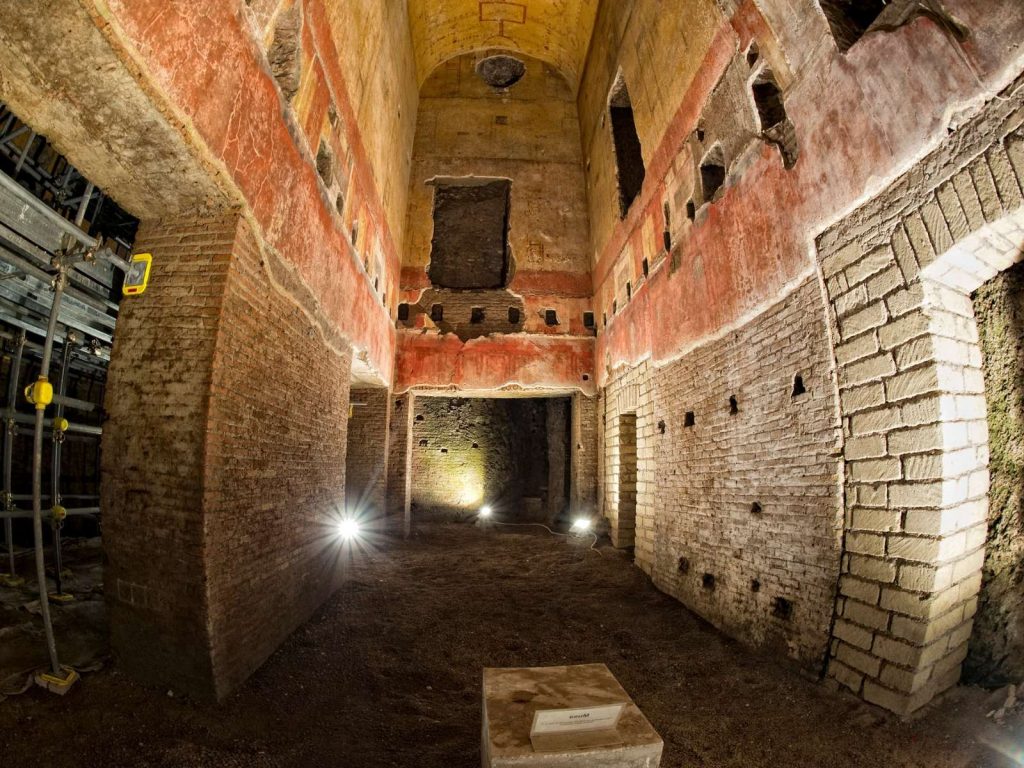
The Domus Aurea, also known as Nero’s Golden House, is a sight that is easily overlooked by tourists but trust us when we tell you that it is well worth visiting these Roman ruins in Rome.
Domus Aurea was built by Emperor Nero around 68 AD; this property once covered over 300 acres and was considered one of the grandest properties in the world.
Legend says that the walls seemed of Domus Aurea to have a golden hue to them. This is thanks to the frescos, pearl, gold leaf, and glass mosaics adorning the walls.
Of course, much of this did not survive the fall of Nero, but you can still witness the beautiful frescos.
The Domus Aurea is open for weekend tours and is still an active Roman archaeological site today. Book your tour in advance, so they don’t sell out!
This is a must-see, so you want to add this to your list of Roman ruins.
10. The Pantheon
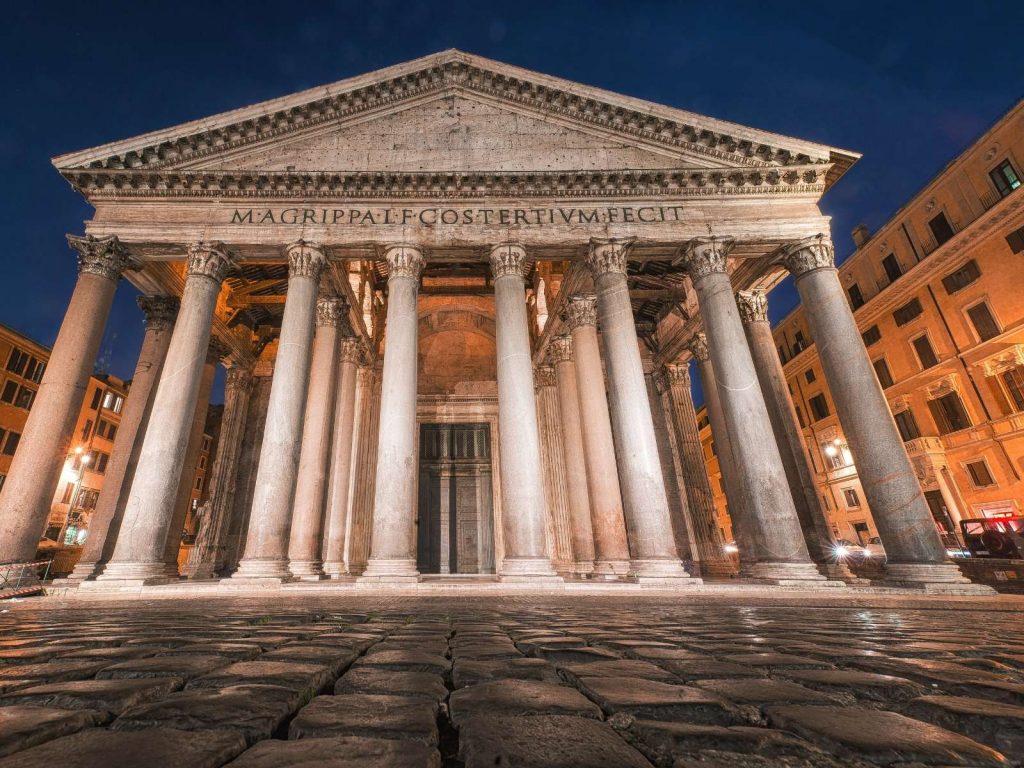
When you first visit the Pantheon, you might wonder why it is on our list of Roman ruins. Believe it or not, it is one of the Roman ruins, it is just one of the very well-preserved Roman ruins in Rome.
The Pantheon was first erected as an ancient temple and was constructed in the 27th century BC. The original structure was destroyed in a fire before the Pantheon you see today was created.
The Pantheon is said to be an engineering marvel. Still, to this day, engineers are perplexed at how the unsupported dome structure was created.
The dome, modeled after Michelangelo’s dome at St. Peter’s Basilica, is made from lightweight concrete and covered inside in a beautiful coffered ceiling.
Nonetheless, it worked. The magnificent dome contains an oculus or eye directly in the center, allowing light to enter the Pantheon.
The incredible marble floor and walls and the beautiful coffered ceiling only add to the grandeur of this Roman ruin.
Lining the walls of the Pantheon are the tombs of several prominent ancient Romans, including the artist Raphael.
While the Pantheon is one of the free things to do in Rome, I recommend visiting it on a tour so that you can learn more about this incredible Roman ruin.
This is one of the best landmarks in Rome and a must-see.
Consider taking the Wonders of Ancient Rome at Dusk tour to see these amazing structures at night with a fantastic tour guide.
11. Baths of Diocletian
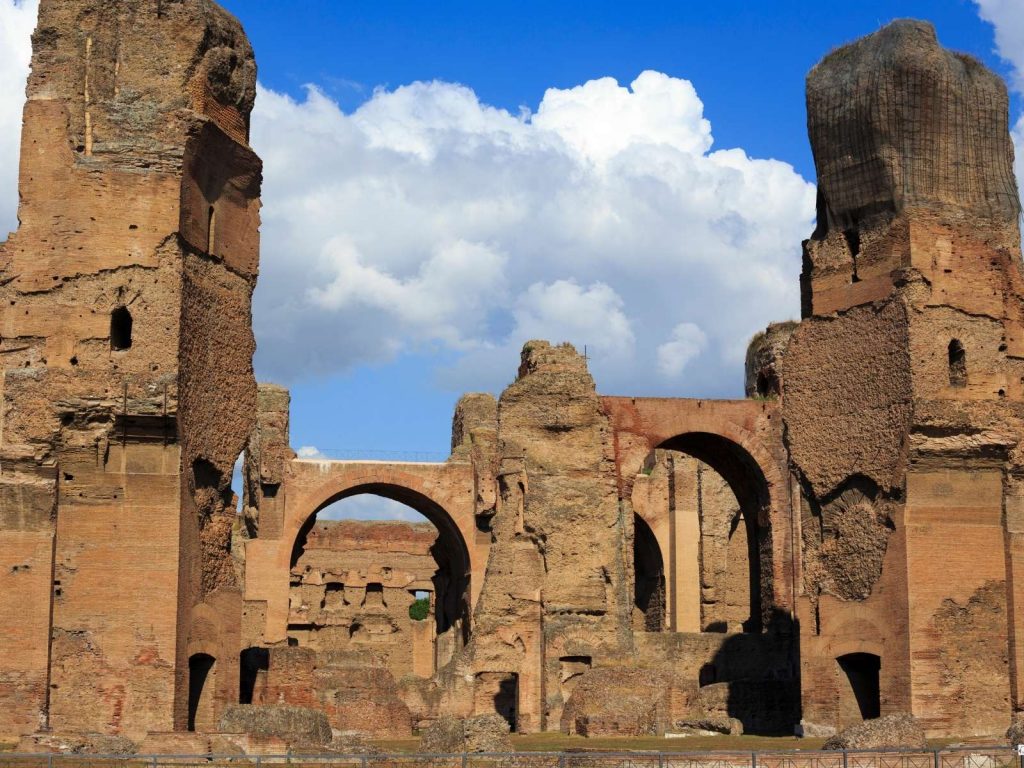
You cannot have a list of Roman ruins and not include the Roman Baths of Diocletian.
Constructed between 298 and 306, the thermal Baths of Diocletian were a place to bathe, swim, and socialize for the ancient Romans.
As one of the largest bathhouses in Rome, the Diocletian Baths could accommodate 3,000 people!
As part of the National Roman Museum, you can visit these Roman ruins in Rome today.
The Baths of Diocletian are built in the typical Roman bath style, with cold, warm, and hot water flowing. The water was used to fill the large bath complex and the small, private bathing rooms.
There is also a gymnasium and changing rooms in the complex.
During your visit, we recommend taking a guided tour of the Baths of Diocletian and the Museo Nazionale Romano.
This is one of the best Roman ruins to visit.
12. Ostia Antica
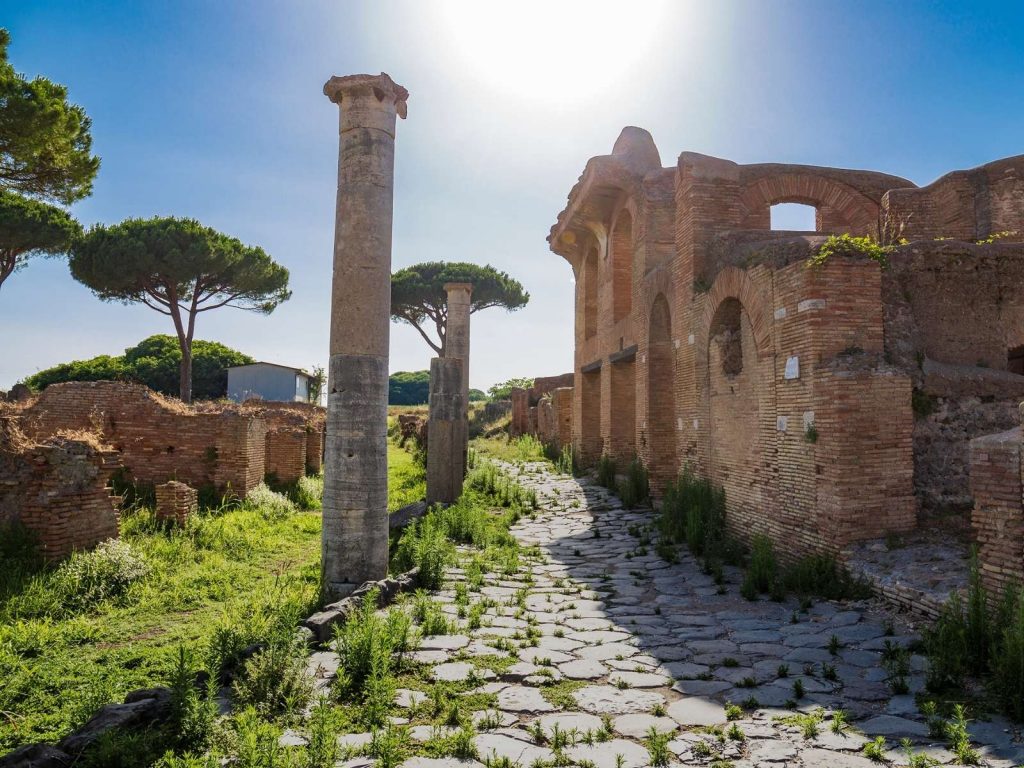
Ostia Antica is an ancient harbor town located about 40 minutes outside Rome, Italy, and contains some impressive Roman ruins.
Founded in the 4th century BC, Ostia Antica was an essential commercial hub that helped transport food and grain to Rome’s citizens.
The 4th-century ancient town of Ostia Antica has been meticulously excavated and contains some of the best Roman ruins in Rome, Italy.
During your visit to the historic ruins, you can see the Baths of Neptune, gorgeous mosaic floors, ancient temples, a necropolis, an amphitheater, and more!
You can imagine how it looked in its former grandeur during the 4th century.
For the best experience while visiting these Roman ruins, book one of the guided tours offered.
Read Next : 20 Incredible Things To Do In Sorrento, Italy
13. Baths of Caracalla
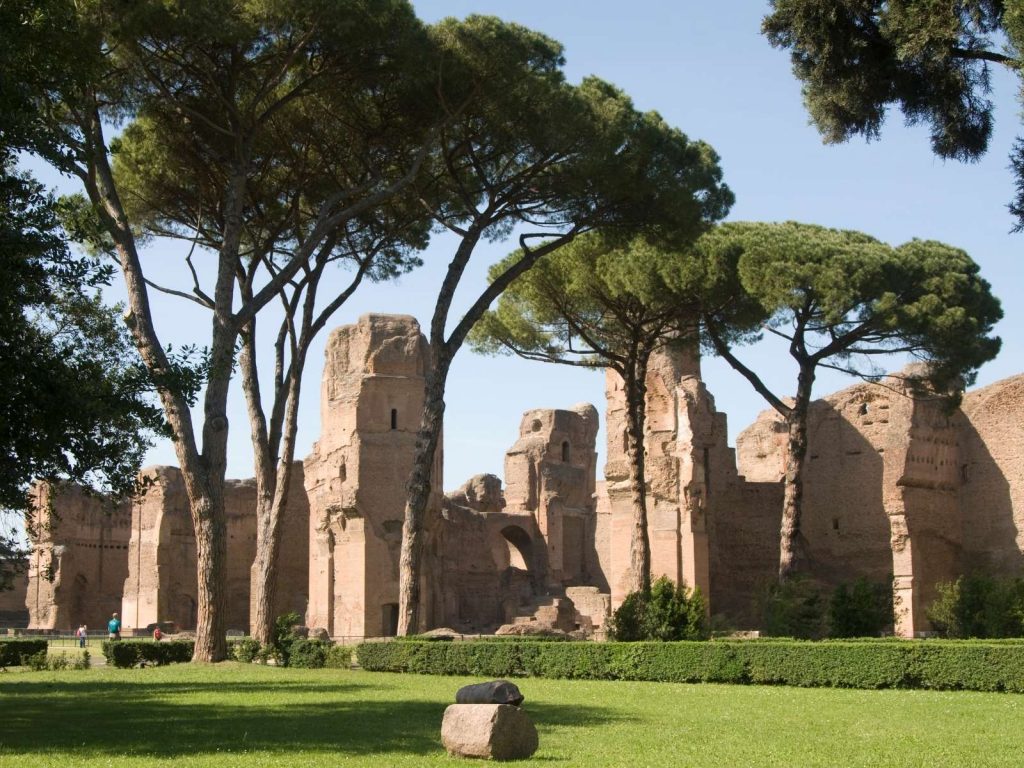
Another of the Roman ruins in Rome, Italy that is worth your time is the Baths of Caracalla.
Commissioned in 206 AD by Emperor Septimius Severus, the baths could hold 1600 people.
Looking at the original brick walls, use your imagination to picture how they looked in their inception, covered with beautiful stucco and marble. Unfortunately, like many Roman ruins, looters made off with those materials long ago.
However, many of the mosaics and statues from the Baths of Caracalla could be saved. You can see them in museums throughout Rome, including the Vatican.
During your visit, you can still see the black and white floor mosaics and visit the underground tunnels of the bath complex.
As one of the best ancient Roman ruins, the Baths of Caracalla has to be on your list of Roman ruins to visit.
This tour not only gives you a guide to the Baths of Caracalla but also includes Circus Maximus.
14. Castel Sant’Angelo

Another of the well-preserved ancient Roman ruins that sit standing guard by the Tiber River is Castel Sant’Angelo.
Standing tall on the banks of the Tiber River is the Castel Sant’Angelo, also known as Hadrian’s Mausoleum.
Initially built in 139 to serve as a final resting place for Emperor Hadrian, Castel Sant’Angelo has served many purposes throughout its history.
Emperor Hadrian also commissioned the beautiful Bridge of Angels that spans the Tiber River and connects central Rome to his mausoleum. Emperor Hadrian had big plans!
Since its construction, Pope Clementine IX commissioned the artist Bernini to create the ten angels you see on the bridge, each of which holds an object of Christ’s passion.
During its history, Castel Sant’Angelo has served as a military fortress, a papal residence, and a museum.
When you visit, visit the Terrace of the Angel for magnificent views of Rome and Saint Peter’s Basilica .
If you would like, consider this tour which gives you a guided tour of Castel Sant’Angelo and allows you fast-track entry.
This is one of the Roman ruins that you will want to visit!
Read Next : 20 Dubrovnik Game of Thrones Filming Locations (& A Map)
15. Catacombs of Priscilla
The Catacombs of Priscilla dated back over two thousand years and were built by the early Christians in Rome.
Hidden under Villa Ada Park, the Catacombs of Priscilla house the bones of many early Christian martyrs and many early popes.
After a meticulous restoration and excavation, the catacombs were opened to the public in 2018.
You can book a guided tour to visit the catacombs and see the incredible frescos housed inside.
16. Hadrian’s Villa
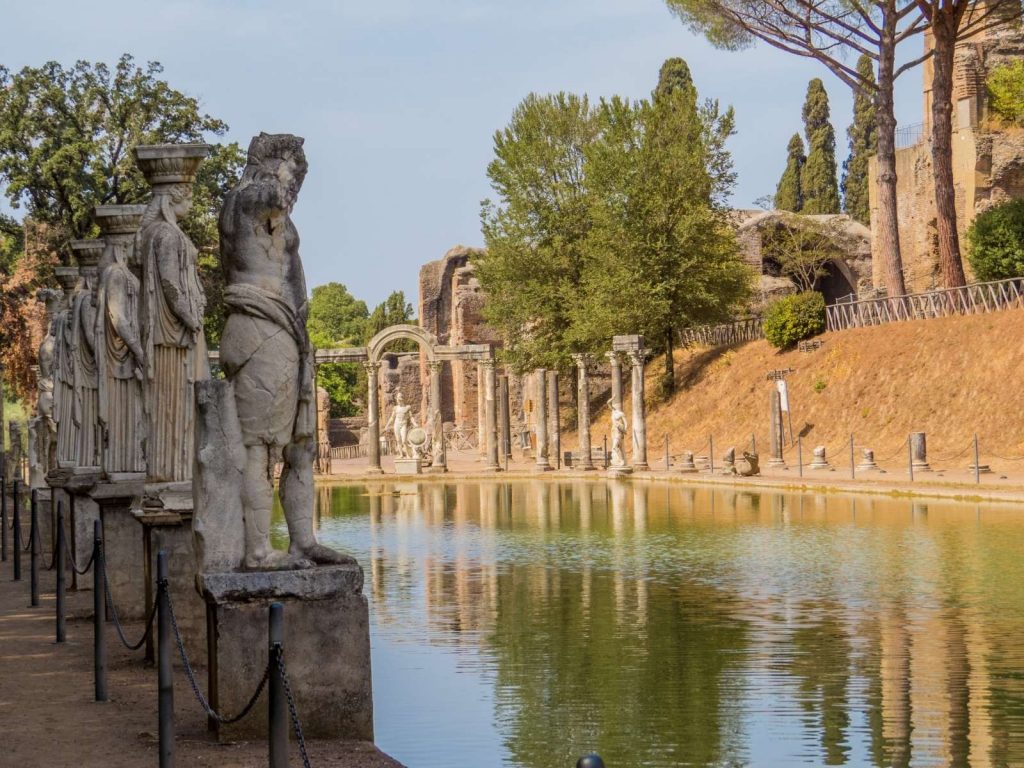
Located about 30 minutes outside Rome, in Tivoli’s town, is the incredible Roman ruins of Hadrian’s Villa.
Built in 118-133 A.D., Hadrian’s Villa is one of the most extensive and most incredible villas of ancient Rome. To put the size into perspective, it is three times the size of the city of Pompeii!
Just like the Pantheon, the villa was designed by Emperor Hadrian himself. The scale and luxury here still showcase the wealth of the vast Roman Empire during ancient times.
Covering more than 300 acres, Hadrian’s Villa is much more than a villa. It is more like a city.
Here you will find libraries, baths, palaces, and incredible gardens.
You can book a tour of Hadrian’s Villa and the Villa d’Este using this link .
Be sure to read our guide outlining the Villa d’Este before you visit. It is a fascinating place also.
17. Church of Santa Costanza
Emperor Constantine originally built this church as a mausoleum for his daughter, Constantina.
The Church of Santa Constanza was excavated in the early 90s. It was discovered that Emperor Constantine might not have built it at all, but instead by Emperor Julian for his wife, Helena.
Regardless, the 4th-century mausoleum is a testament to the grandeur of the ancient Roman architecture.
The interior houses 12 pairs of Corinthian columns arranged in a ring. To accompany the Corinthian columns are 12 windows that allow light into the space.
The mosaics that you see before you today are mostly restorations, but they do give you an idea of the beauty and artistry that went into the structure.
18. Arch of Constantine
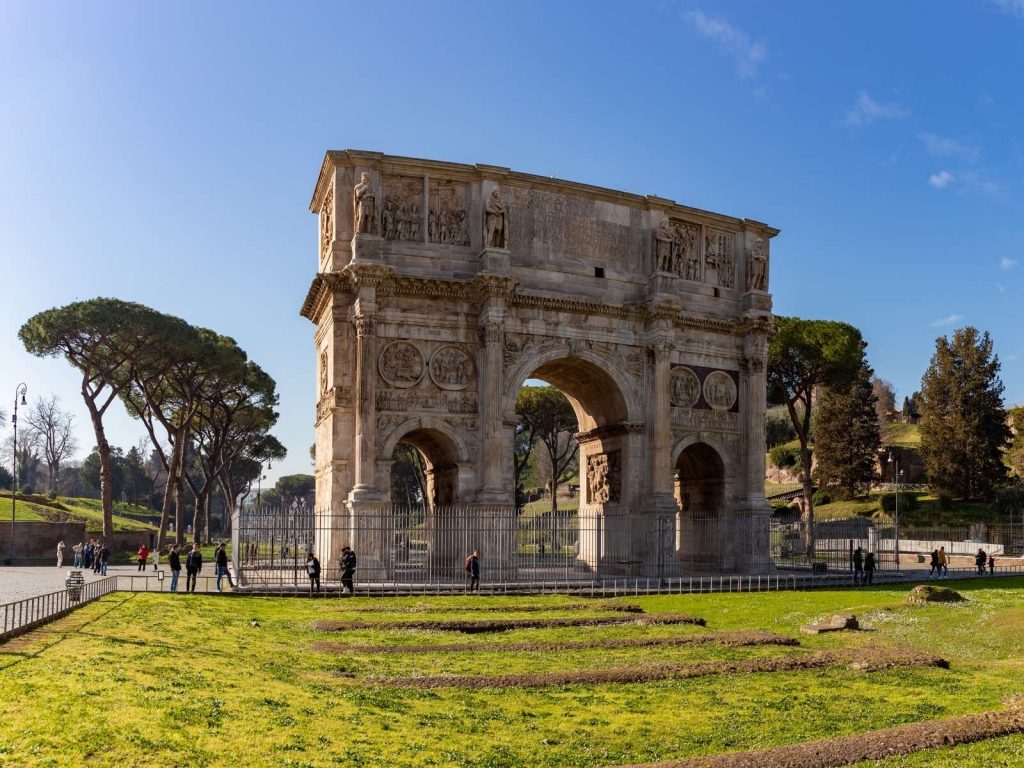
Outside the Colosseum, you will see a large, imposing arch. This is the Arch of Constantine.
Dedicated to Emperor Constantine the Great, this arch carries significant historical value as this was when the western world switched to Christianity.
It was in 312 AD that Emperor Constantine saw a vision in the sky. Based on this vision, he legalized Christianity.
The Arch of Constantine was constructed to show this historical shift and glorify Constantine as one of the great leaders in ancient Rome.
19. Aqua Marcia
The Aqua Marcia is one of seven aqueducts in Rome and is fantastic to see.
This large stone structure was built between 44 and 42 B.C. Although today, it is not much more than ancient ruins, it is still an essential piece of ancient Roman history as it helped to get water into the city.
This guided tour allows you to see some Roman aqueducts and takes you underground to the Roman catacombs.
20. Area Sacra di Largo Argentina
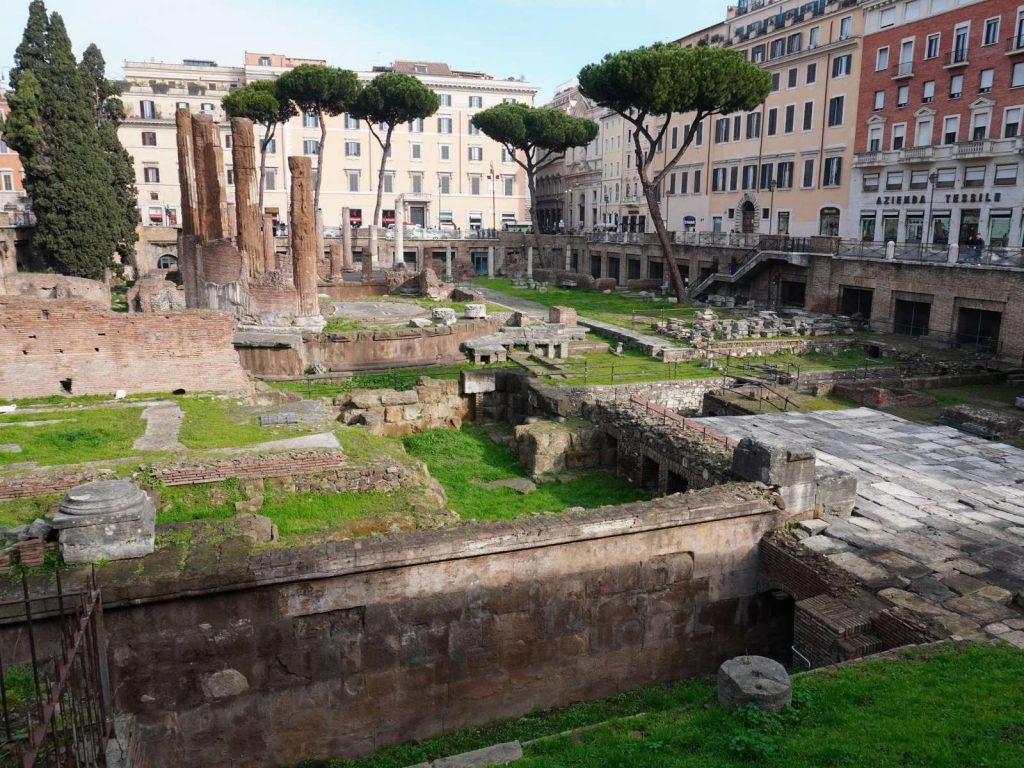
The Area Sacra di Largo Argentina is the name given to one of the many active archaeological sites in Rome.
Located in the square of Largo di Torre Argentina, this site is home to four ancient temples named A, B, C, and D.
Each temple consists of gorgeous columns, and the oldest one, temple C, dates back to the 3rd century B.C.
21. Catacombs of San Callisto
The Catacombs of San Callisto date back to around 150 AD. These 1st-century underground tunnels served as the burial place for Christians.
The fascinating thing about the Catacombs of San Callisto is the size of the complex. Housed on over five floors, archaeologists have found over 500,000 bodies here.
22. Circus Maximus
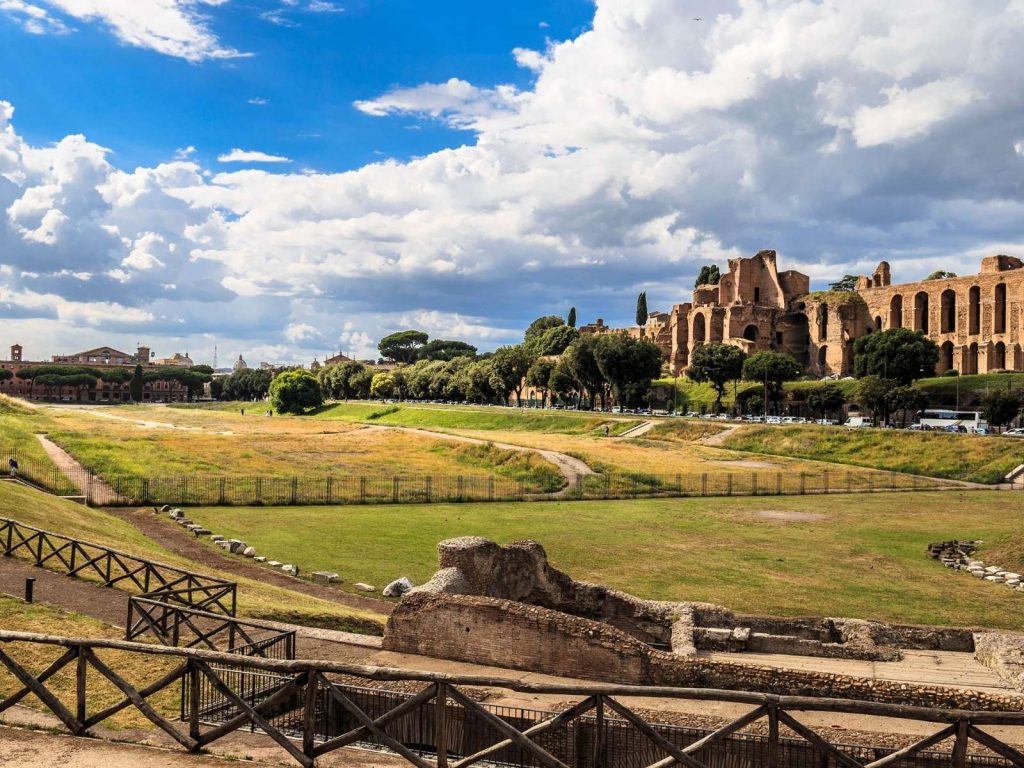
We mentioned Circus Maximus above, but if you have time, you should visit it.
Circus Maximus served as the most prominent sports stadium in Ancient Rome. Although it was mainly used for chariot races, there is historical evidence to show that other events also took place here.
Today, you can see the arena, which dates back as far as the 4th century BC during your time touring Roman ruins.
23. Claudio Aqueduct
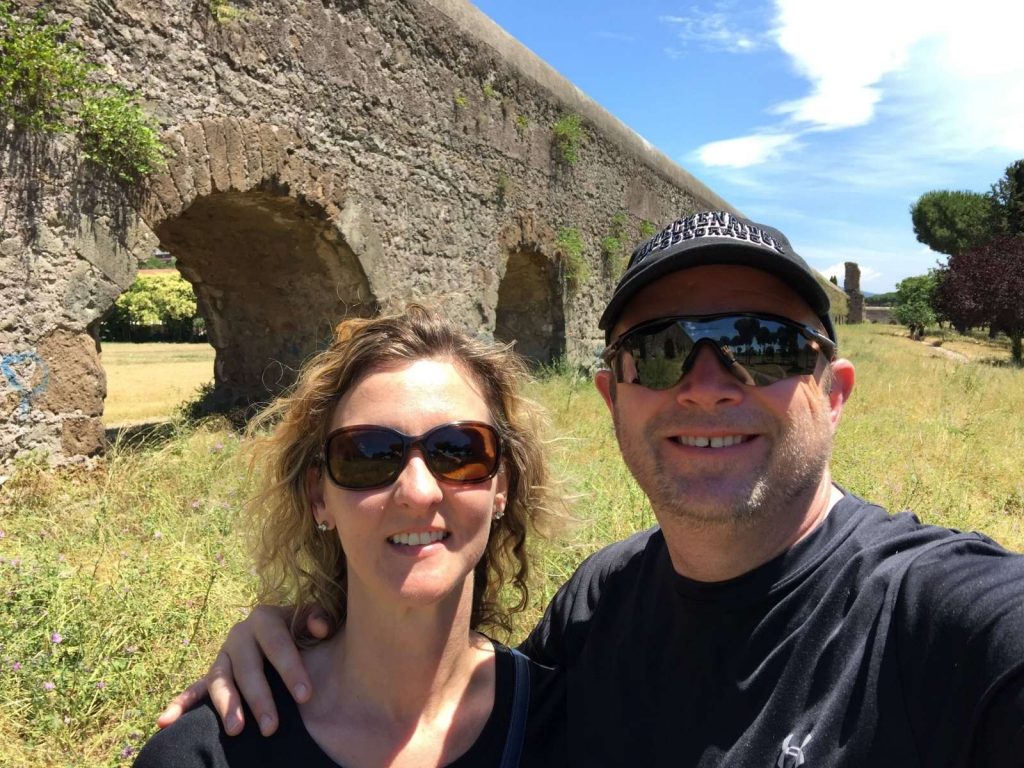
During our visit to Rome, we made the journey out to the Appia Antica Regional Park to see the remains of the Claudio Aqueduct. (Don’t judge the photo; this was in our pre-blogging days. LOL!)
The Claudio Aqueducts were started in 38 AD by Emperor Caligula.
The sections of aqueducts that remain are incredible to see. We were amazed at their size!
24. Ludus Magnus
The Ludus Magus is the famous gladiator training school.
Built between 81 and 96 AD, the Ludus Magnus was commissioned by Emperor Domitian and was later added on to by Emperor Trajan.
The ruins of Ludus Magnus are located near the Colosseum. Today, you can see the foundation of the spectator stands, the arena and gladiator barracks, and the gladiator cells.
25. Mausoleum of Augustus
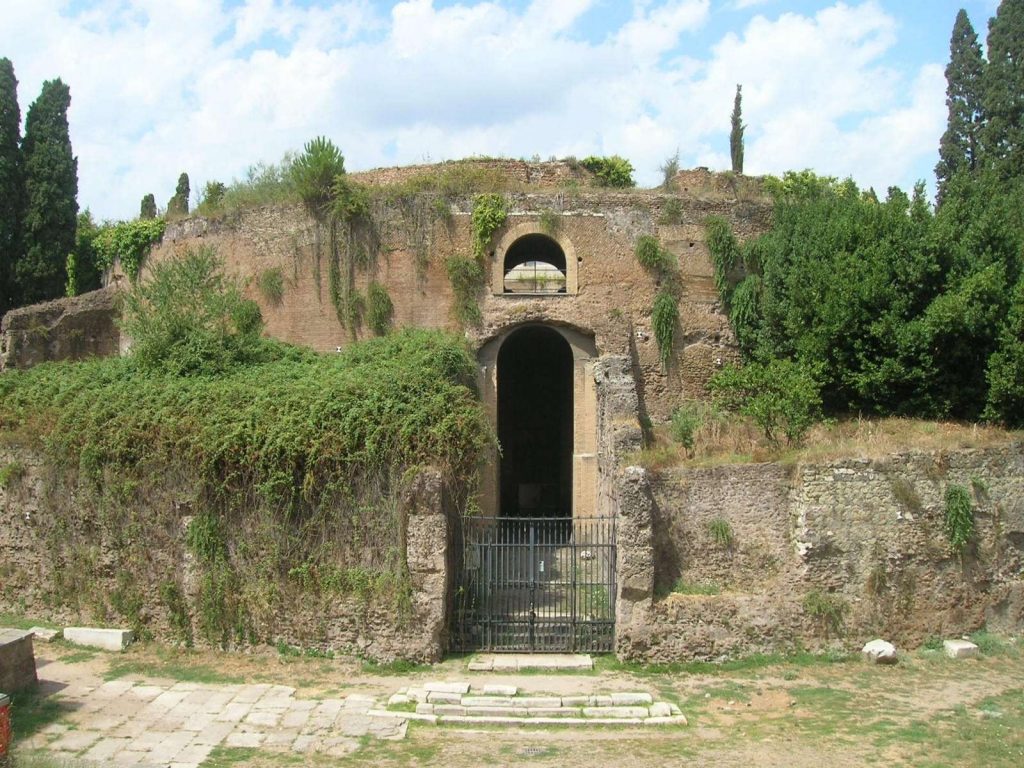
Emperor Augustus was the first emperor of Rome and the great nephew of Julius Caesar. Augustus ruled between 63 BC and 14 AD.
His mausoleum was built around 28 BC and became the final resting place for Emperor Augustus, his wife, Livia, and several other Roman Emperors and prominent figures of ancient Rome.
While the ruins are closed to the public, you can still admire the grandeur of the ancient structure and image its former beauty.
Well, there you have it, our guide to some of the famous Roman ruins in Rome. I hope you will consider booking one of the tours that we mentioned. Also, be sure to check out our other Italy posts listed below.
Happy Travels, friends!
Here are some other great tours in Rome that we suggest!
Check out our other italy posts:.
50 Italian Drinks That You Must Try in Italy
3 Days in Venice: A Great Venice Itinerary 3 Days
20 Dubrovnik Game of Thrones Filming Locations
Exploring Old Town Prague: What to See & Do in Prague’s Old Town
Capri, Italy: The Ultimate Guide to the Isle of Capri
The Perfect 2 Day Rome Itinerary
How to Spend One Day in Rome
Where to Stay in Rome: Best Areas and Places to Stay in Rome
12 Must-See Towns in Tuscany
85 Quotes About Italy to Inspire Your Wanderlust
25 Incredible Things to Do in Prague
Venice Itinerary-2 Days of Bliss
50 Things to Do In Venice On a Budget
72 Hours in Venice
How to Easily Get From Florence to Cinque Terre
2 Days in Florence: A Great Florence Itinerary
Sorrento to Capri: All You Need to Know for the Perfect Day Trip to Capri
The Perfect 10 Day Italy Itinerary
Ultimate Guide to Burano Italy
Tivoli-The Perfect Day Trip from Rome
How to Spend 24 Hours In Capri
17 Fun Day Trips From Dubrovnik
Like This Post? Please Pin It!
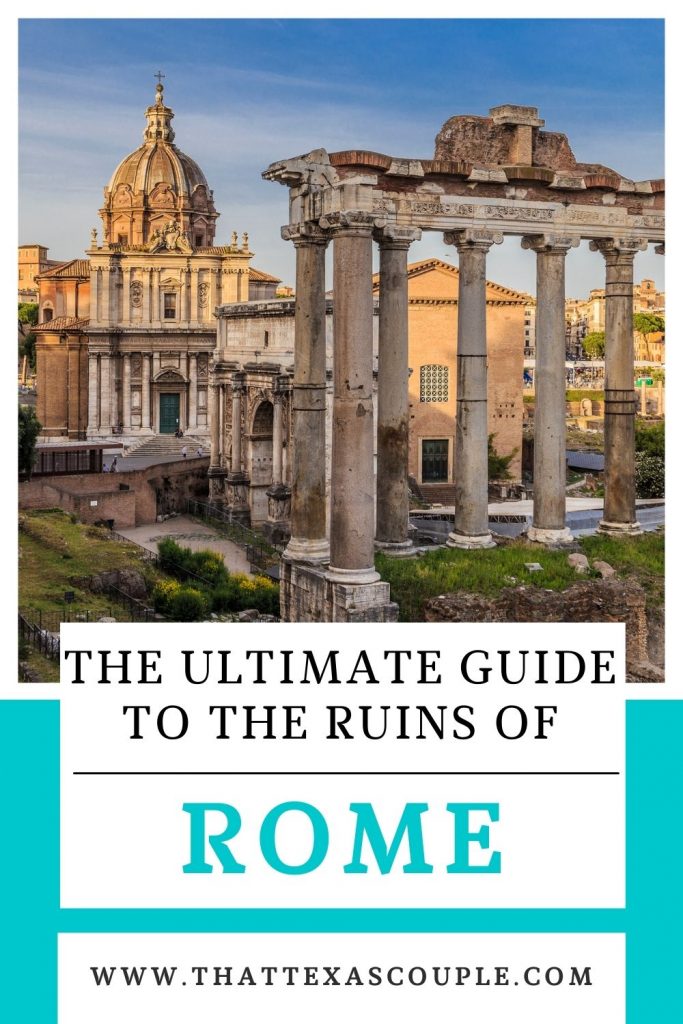
About the Author
Michelle Snell is a travel writer, history buff, wine lover, and enthusiast of different cultures. Michelle enjoys bringing places to life through creative content creation and her informative writing style on her blogs, That Texas Couple and Totally Texas Travel and accompanying social media accounts. She is happiest sipping wine in Italy or chilling on a beach with her husband, Marty.
Book Your Trip: Logistical Tips and Tricks
Book Your Flight:
We love using CheapOAir, Kayak, and Kiwi to search for the best flight prices. We love using these search engines because they search the web for airlines worldwide to ensure you get the best deal! In addition to flights, you can also find great hotel prices on Kayak and Kiwi.
Book Your Vacation Package:
If you want to book an entire vacation package, we suggest using Expedia. We love how easy Expedia is to use, and we always find good deals on entire vacation packages on their site.
Another great site for vacation packages is BookVIP . BookVIP offers super cheap vacation packages to incredible destinations. You are sure to save money using their site!
For full guided vacations, including hotels, some meals, transportation, and guides, then we book with Trafalgar. Trafalgar is a trusted tour company that will meet all your needs while ensuring a great experience.
Trip.com allows you to book flights, hotels, train tickets, rental cars, airport transfers, tours, and more all on one site. Owned by the parent company that also owns Skyscanner, this is a trusted resource for travel booking and a great “one-stop shop.”
Book Your Accommodations:
We always begin our search by checking out honest reviews on TripAdvisor hotels. This allows us to narrow our search for specific properties once we are ready to book. Of course, you can also book directly on the TripAdvisor site!
There are several accommodation sites that we like to use. One of our favorites is Booking.com because it offers a wide variety of hotels and guesthouses at a good price.
Another “go-to” hotel booking site for us is Hotels.com . We love their loyalty program that allows you to earn free nights, and their “secret prices” for members are fabulous deals!
HotelsCombined is another cool site. They allow you to compare all the top travel sites with one search to ensure you find the best deal out there. Kayak works in this way as well.
If you want a luxurious all-inclusive vacation, consider checking out the Sandals/Beaches properties. Sandals properties are for couples only and Beaches are for families. We have visited Sandals in the past and absolutely love the attention to detail and the service they provide.
Tour Companies We Trust:
We love taking guided tours when visiting new places. Our go-to tour companies are Viator.com and Get Your Guide . Both of these companies have been in business for years and provide excellent customer service. You can trust booking tours from their sites for sure!
For a guided city tour, check out City Sightseeing and BigBus Tours . These bus tours are so much fun and easy to hop on and hop off at top attractions in cities around the world.
CityPass is a great way to save money when visiting large cities. CityPass allows you to get free admission to major attractions once you buy their pass. The savings add up quickly with this pass, often saving 50% with combined admissions.
Another great pass to save money in larger cities is the Sightseeing Pass . This pass allows you to save valuable time and money by combining admissions to major attractions. They also have a handy app that keeps everything you need at your fingertips.
Looking to Save Time and Money?
Check out our resource page for all of our favorite vendors. These companies help us to save time and money on our travels!
Catherine - Savvy Family Travel
Sunday 31st of July 2022
Nero’s Golden House was not on my radar before reading your post. I look forward to visiting in the future. Thank you for all the inspiration and historical background you've compiled here.
thattexascouple
Friday 5th of August 2022
I am so happy to add something to your list! Thanks for reading the post and taking the time to comment!
Tuesday 10th of December 2019
Marty and Michelle, I am really enjoying reading your articles about Rome. We have never been there, although I have spent quite a bit of time in Europe. 3 years in France as a kid and 9 years in Germany in the Army. We are planning a trip to Rome for our 27 Anniversary next Spring (May 1, 2020). Right now the hotel that I'm leaning towards is the Ambasciatori Place in the City Center. It seems to be within walking distance to many attractions and is on the metro and hop on-hop off bus route. My questions revolve about eating. Will we have problems finding restaurants that won't cost an arm and a leg and have regular dining rather than fine dining. I continue to read you articles and any information you can provide will be greatly appreciated. Thanks a bunch. P.S., I have Texas ties. I spent 6 years in San Angelo while I was in the Army teaching at the tri-service intell school at Goodfellow AFB. Also, my son works the oil fields in Breckenridge and my grandson is a junior at Texas Tech.
Wednesday 11th of December 2019
First off, thank you so much for reading our posts it truly means so much to us that you find our information helpful. That is the whole reason we do our blog! I love that we have a TX connection! ;)
Honestly, Marty and I found that you can spend as much or as little as you want in Rome, even in this area around the city center. We tend to eat our larger meal at lunch as you can find great deals on really good food during this time. Then for dinner, we like to participate in apertivo where you get nibbles with your drink. Kinda like American happy hours but the small food servings are generally included in the price of your drink. If we are still hungry, then we grab a slice of pizza or a gelato :)
Ask the locals that you meet where they would go to eat with their family. This is generally how we find the best food at a good price as well :). Lastly, consider purchasing the Rick Steves guide books we referred to as he is more of an expert on Italy, and provides suggestions for all price ranges in all areas of Rome.
I hope this helps, and please reach out with any other questions. I know you all are going to have a wonderful trip--and HAPPY ANNIVERSARY!
Friday 12th of January 2018
Are you sure one day is enough to visit those three ancient sights? Because wherever we go, my family like to stop at every information and talked about it before we moved to the next sight. I went to Rome once - with a choir group long time ago - but nobody wanted to go to the Colosseum. They just wanted to shop! :-( I do hope to visit Rome one day with my family while my junior in high school still lives there. So, I will ask him to take us around with all the information you wrote in this article. It's so detailed and helpful.
Saturday 13th of January 2018
Hi Umiko! Of course, everyone travels at their own pace, but my husband and I were able to do it in a day and he stops at every nook to take photos. LOL! You may want to consider breaking it into two days if that works better for your family. I hate that you didn't get to go see the Colosseum on your first trip, that's way better than shopping! You will have to go to all the ancient sights on your next trip for sure. Happy Travels!!
Amanda Goldston
What an awesome place. Rome has been on my husband's bucket list to visit for some time. I had not realized how much there is to see and how much of those beautiful structures are still in place. You can only image what a magnificent place it must have been in its hey-day. Thank you for such a detailed guide to the City.
Thanks for reading Amanda. Rome is such an amazing place. Pictures just don't do it justice. We were constantly in awe of the size of things and how in the world were they created before modern technology!
Darla @FunFitnessFam
I loved visiting ancient Rome and definitely second the hop on/off bus! It was also great to get lots of tips while en route to destinations. We went in October and euros were up, while we were young and poor. We didn't do the tour guide, but used my book and found it amusing that the tour guide almost went word for word with what was in the book :) I hope to return someday to show our kids where their ancestors are from, so I will definitely pin for our next visit!
Hi Darla! That is so funny that the tour guide followed your book so closely. I guess the information is the information. LOL! I hope you get to return with your kids. I feel it's so important to show our heritage to our children-what a great experience!!

Paul Passing Through is a travel blog designed to give you travel tips, travel recommendations and travel itineraries to help make the most of your travel time!
Places to Visit in Ancient Rome in One Day

With so many places to visit in Ancient Rome, it can be hard to decide how to plan your trip to the Eternal City. This gets even more difficult if you are limited to how much time you have in Rome.
Of course, you have to see the Roman Colosseum and the Forum. Those two are the obvious choices, but how else can you spend a single day visiting Ancient Rome? Fortunately, many of the best sights, including the Colosseum and Forum, all sit in close proximity to each other, making it easy to see a lot in a day.
In this guide, I’ll take you around my recommendations of the best places to visit in Ancient Rome. By the end of the day, you’ll feel like you walked a mile (or a few miles, maybe) in the sandals of some long-lost Roman senator!
Disclaimer: This post may contain affiliate links. If you make a purchase through one of these links, I will earn a small commission. This occurs at no added cost to you.
Table of Contents
Places to Visit in Ancient Rome #1 – The Roman Colosseum
The first of my places to visit in Ancient Rome has to be the Roman Colosseum. For practical reasons, visiting this monolith of the human spirit early in the day is ideal if you want to avoid crowds. More importantly, this is the Roman ruin that is most commonly associated with this significant civilization. Like the Greek Parthenon and the Great Wall of China, almost everyone in the world knows what the Colosseum is.
Almost no matter what direction you approach the Roman Colosseum, you’re likely to start getting glimpses of it long before you actually get to it. This is a testament to the size of this 2,000-year-old structure. Most likely, you’ll approach the Colosseum along Via dei Fori Imperiali, where you can also see the ruins of the Imperial Forums underneath you.
Once you arrive at the Colosseum, you’re basically free to explore the amphitheater at your own pace. I recommend purchasing the Full Experience Ticket . This ticket gives you access to the arena floor of the Colosseum. From here, you can get closer views of the Underground area where gladiators prepared and animals were kept for different events.
Besides that, it’s a wondrous feeling to imagine that you’re walking on the same grounds where Roman gladiators once waged battle!
After you’re done in the Arena, your visit takes you to the first level of the Colosseum. Take your time walking around the concourse as you look out onto the Arena. The seats you’re walking through could sit up to 50,000 Roman citizens who came to watch the violent spectacle of the Colosseum’s events. Along the arcade are also some great views of the Arch of Constantine.
Take a moment to linger on the western end of the Colosseum. From here, you can look back at the eastern entrance to the Arena. It’s from this gateway that gladiators and other large animals would be enter the amphitheater.
The last part of your tour is on the Roman Colosseum’s second level. This part of the Colosseum houses a museum detailing the amphitheater’s history. The most interesting exhibits in the museum describe how the Colosseum was used in medieval times. During this era, it saw several iterations including use as housing and later as a sort of castle by a wealthy family.

Did you know ? The Roman Colosseum’s actual name is the Flavian Amphitheatre. It wasn’t referred to as the Colosseum till some time after its construction. The Flavian Amphitheatre refers to the ruling dynasty of Rome who had it built.
Places to Visit in Ancient Rome #2 – The Roman Forum
If the Roman Colosseum is the most recognizable of the places to visit in Ancient Rome, the Roman Forum is a very close second. Whereas the Colosseum was where Romans went to be entertained, the Forum was where they went to get things done.
You can enter the Roman Forum from three different entrances, but the most common entrance is right next to the Colosseum under the Arch of Titus. As you walk from the Colosseum to the Forum, take a moment to admire the humongous Arch of Constantine. This triumphal arch was built to commemorate an important military victory by Emperor Constantine in 312 A.D.
Once you enter the Forum, you’re more or less free to walk around the ruins in any direction you want. The Forum is filled with Roman ruins in various states of disrepair. It’s a history lover’s playland of columns, temples and grand arches! Cutting through it all is the Via Sacra, the main road through the Roman Forum. Amid the ruins, it’s not hard to imagine yourself walking on the same stones as Roman emperors 2,000 years ago.
Much like Pompeii , visiting the Roman Forum is the type of time warp experience that gives you an idea of what life was like in Ancient Rome.
Make sure to have an audioguide or guidebook handy as you visit the Roman Forum. While the ruins aren’t as sprawling as Pompeii, it’s still easy to get overwhelmed by everything. Further, just visiting the Forum is an experience unto itself, but it will be that much better knowing what you’re looking at along the way.
Also, take advantage of the free water fountains throughout the Roman Forum. Once you leave the entrance area near the Arch of Titus, there is very little shade here. Try to cool yourself down with water as much as you can to make your visit an enjoyable one.

The Roman Forum has so much to see that it’s impossible to cover in an overview like this one. Be on the lookout for a post later this month with a much more comprehensive guide dedicated just to the Forum!
Places to Visit in Ancient Rome #3 – Palatine Hill
Rising over the Roman Forum’s western edge is Palatine Hill. While it may seem like it’s part of the Roman Forum, it technically isn’t.
Starting with Emperor Augustus in 27 B.C., Palatine Hill is where Roman emperors lived. Ruins of buildings created by these emperors can still be seen today.
Perhaps more importantly, this hill is considered to be where Rome had its start. Excavations have found ruins dating to 1,000 B.C. around when the city is believed to have been founded. In fact, the mythological figures of Romulus and Remus, the supposed founders of Rome, have strong ties to Palatine Hill. Two locations from the legend are believed to be here: the cave where the twins were suckled by a wolf and the ruins of a hut where Romulus lived.
Whether you believe all that or not, it’s still worth visiting for great views of the Forum and the Colosseum, as well as to walk around the evocative ruins largely devoid of other visitors. Some of the things you can see are the emperor’s private stadium, the Circus Maximus where chariot races were held, and a museum housing objects found on the hill.
And remember, entrance to Palatine Hill is included in your ticket to the Roman Forum, so you may as well check it out!

If you have anything in particular you want to see, find it on a map and head to it first. We visited Palatine Hill right after doing both the Colosseum and the Roman Forum. I wanted to see the Circus Maximus, but we didn’t plan very well and just ended up wandering around. The heat and fatigue from earlier in the day prevented us from seeing the one thing I most wanted to visit.
Places to Visit in Ancient Rome #4 – Capitoline Hill and Museum
After spending the morning walking among Ancient Rome’s ruins, the Capitoline Museum is the next of my places to visit in Ancient Rome. Overlooking the northwestern end of the Roman Forum, this museum contains many of Ancient Rome’s best statues and artworks.
One of the best parts of visiting the museum is just the walk up to the entrance. You ascend a dramatic staircase, appropriately named Michelangelo’s Grand Staircase, to the top of Capitoline Hill. At the top, you’re met with three palatial buildings surrounding a large replica statue of Emperor Marcus Aurelius on his horse. It’s the type of grandiose design that Italy has mastered over the centuries.
The museum itself comprises the two buildings on the left and right of the equestrian statue plus an underground tunnel that connects the two. From this underground passage, you’ll visit the Tabularium. The Tabularium was built in the 1st century B.C. to act as Rome’s archives, but today visitors pass through here to see great views of the Roman Forum below.
Once you enter the museum, take your time and focus on the highlights. The museum’s layout is a bit confusing, but the best pieces are generally housed in large, central spaces. The first of these spaces is a courtyard housing remnants of the Colossus of Constantine , a 4th century A.D., 12-meter-high statue of Emperor Constantine.
Shortly after this courtyard, you’ll enter a large room containing several of the Capitoline Museum’s best statues. This room includes the famous Capitoline She-Wolf , the Boy Extracting a Thorn , and the original statue of Marcus Aurelius atop his horse.

Places to Visit in Ancient Rome #5 – Imperial Forums
Finally, the last of my places to visit in Ancient Rome. This stretch of Ancient Roman ruins extends along Via dei Fori Imperiali, the road that goes from the Victor Emmanuel Monument to the Colosseum.
These ruins contain the remains of various public areas from Ancient Rome. They’re similar to the Roman Forum but no single one is as large or as culturally significant. Still, if you have time, the Imperial Forums may be worth visiting since they’re included in any ticket that includes the Roman Forum.
On the other hand, you can easily see these ruins without a ticket as you walk along Via dei Fori Imperiali. This is how I experienced the Imperial Forums, and considering everything else there is to see in Rome, I’m not sure I would recommend actually walking among the ruins unless this is a repeat visit for you.
Probably the most popular of the Imperial Forums is Trajan’s Market. Walking towards the Colosseum, Trajan’s Market will be one of the first sections of ruins on your left, just a little past Trajan’s Column. These market ruins contained various shops for Roman citizens and offices for bureaucrats of the empire. It’s a remarkably well-preserved semicircular building that gives a brief look into the daily life of Ancient Romans.

Return to Visit Ancient Rome at Night
Whether this is your visit to Rome or your hundredth, I recommend coming to these Ancient Rome sites at night. These places to visit in Ancient Rome are perhaps best seen at this time of day. Seeing the ruins at night when they’re aglow with floodlighting is a totally different experience than seeing them in daylight.
Besides being empty of the throngs of daytime visitors, the ruins have a magical feeling about them at night. It’s a romantic atmosphere that makes the ruins come alive. You can almost hear the chatter of Romans from centuries gone by as you walk through the area under the nighttime sky.
You won’t be able to visit the Roman Forum, but you’ll be able to walk along the Imperial Forums and around the Colosseum. Don’t miss this once-in-a-lifetime opportunity!

See All These Places in Ancient Rome with the Full Experience Ticket
Buying tickets for the Roman Colosseum and the Forum isn’t as straightforward as you think. If you search online for tickets, you’re met with an overwhelming number of vendors. Even within those many vendors, you’re still faced with a wide variety of ticketing options.
First of all, buying a ticket ahead of time is an absolute must . Without a pre-booked ticket, you can expect to wait in long lines almost no matter what time of day you arrive to visit the Roman Colosseum or the Forum. Further, I suggest booking your tickets as soon as you know your itinerary. Because of the Colosseum’s popularity, tickets can sell out fast, especially in peak tourist season.
The official ticketing site is Coop Culture , and this is the site I recommend for the cheapest price and most security when purchasing your tickets.
By purchasing the Full Experience Ticket, you get access to the Colosseum Arena, the Roman Forum, Palatine Hill and the Imperial Forums. What’s more, you have 48 consecutive hours to visit these sights.
There are other tickets available, but the Full Experience Ticket gives you most bang for your buck.
Even though Coop Culture is the official site, tickets including the Colosseum tend to sell out very quickly. This can make it difficult to get tickets for some people. If that is happening to you, then the safest bet may be to book a guided tour.
Frequently Asked Questions When Visiting Ancient Rome
Where should I stay nearby?
We had a lovely stay at Arch Rome Suites . It’s a very short walk to the Pantheon and about a mile along mostly flat road to the Colosseum. Despite this close location to the Pantheon and being next to a couple cafes, it’s in a relatively quiet alley. This combined with the spacious and comfortable rooms made Arch Rome Suites a perfect location during our stay as we were able to come back in the mid-afternoon for a relaxing break from the heat and get a good night’s sleep each day.
In addition to its location, Arch Rome Suites also offers modern furnishings and an included continental breakfast each morning. It lacks any old-world charm, but it more than lacks up for that with everything else!
When is the best time of the year to visit Rome?
I’ll answer that by saying when the worst time to visit is. The summer months from June to August see the most tourists and the highest temperatures. If you can avoid visiting during summer, do so.
That said, I’m fully aware not everyone is able to do that. So, if you have to visit during summer, try to go to Rome in June. It still may be pretty busy, but you’ll hopefully avoid the hotter months of July and August. Better yet, if you can do the shoulder months of May or September, they could be good options, too.
What are other places to visit in Ancient Rome?
You certainly have no shortage of places to visit in Ancient Rome in addition to the ones I mentioned above. The obvious sight I didn’t mention is the Pantheon, which is just a brief walk from everything described above.
Some other places to visit include the Baths of Caracalla, Castel Sant’Angelo, Aqueduct Park and the Catacombs of Priscilla.
More Resources for Planning Your Trip to Italy
Here are some of the other itineraries I’ve written to help you plan your dream trip to Italy!
- Campania (Pompeii and Herculaneum)
- Cinque Terre
Book Your Trip to Rome
Whether you’re looking for tours, hotels or flights, here are some tools to help get you started planning your trip to Italy!
Look for activities and tours offered through GetYourGuide or Viator !
Still can’t find what you’re looking for? Check out my travel essentials pages for more of my recommendations.
Pin This Post!

You May Also Like

My Top 8 Highlights of the Uffizi Gallery in Florence

Five Great Halloween Travel Ideas to Enjoy the Season While Abroad

The 12 Most Memorable Stops on Shenandoah’s Skyline Drive
The 10 Best Practical Places to Explore Ancient Rome
Historvius helps you find the greatest historic sites in the world along with hidden gems ignored by the masses.
The legacy of the Roman Empire can be found in far more places than you might imagine. Many of the most interesting ancient sites, however, are located in countries and regions that are difficult or dangerous to visit. But that doesn't mean you can't get your fill of ancient Rome in more practical places and, to help you explore with ease, the folks at history travel website Historvius have put together their top 10 list of practical Roman destinations.
And if that's not quite enough for you, there is another way... Historvius have also launched an incredible new iPad app which lets you virtually explore some of the world's very best Roman ruins from the comfort of home. So whether you're seeking easy sites to visit in person, or want to explore without the hassle, there's tons of options that will help you on your way.
France: Paris and Beyond
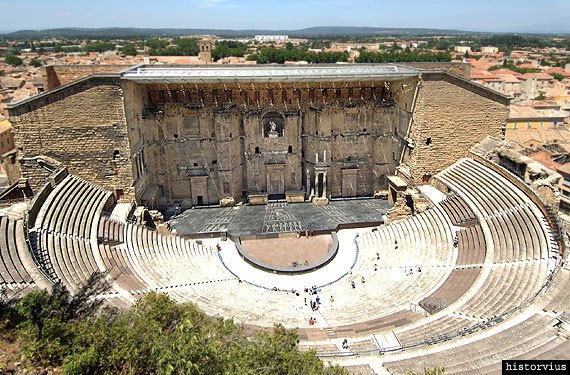
France is packed full of ancient Roman attractions. In fact, some of the very best ruins in the world can be found here. Whether it's a city-break in Paris - where you can explore the hidden Crypte Archeologique or Paris' Roman baths and amphitheatre - or exploring further afield to take in sites such as Pont du Gard , Nimes Arena or the Theatre of Orange there's a huge Roman legacy in France, making it one of the top destinations for seekers of ancient Rome.
Turkey: Ancient Treasure Trove
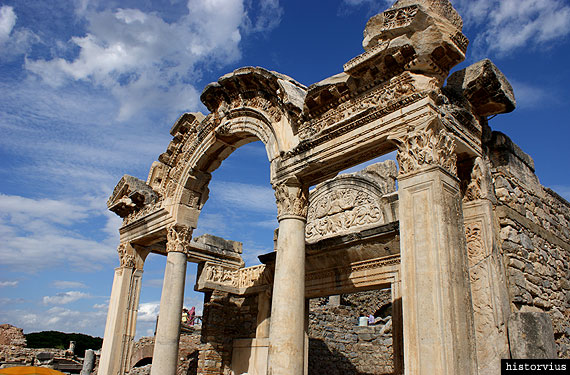
For seekers of history Turkey is hard to beat. With a wealth of ancient sites from several prominent civilizations, Turkey combines it all with great weather and modern tourist resorts to offer a truly appealing historical holiday. There are loads of cities from the Roman age here, probably the best of which are Ephesus , Aphrodisias , Olympos and Perge .
Spain: Picturesque Ancient Attractions
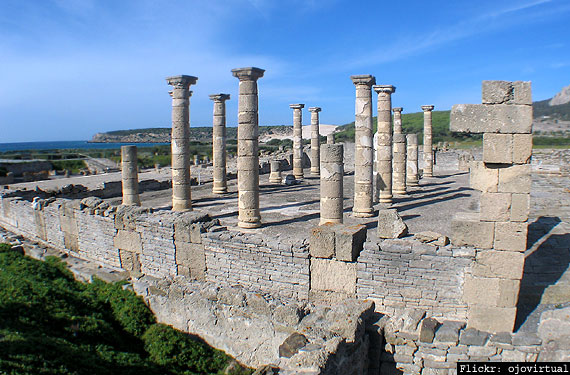
Spain is an oft-frequented hotspot for sun worshippers. But two thousand years before hordes of Northern European tourists descended on the beaches of Spain it was their Italian neighbors who came-a-knocking, in the form of relentless Roman legions. Spain remained part of the Empire for several centuries and today a number of scenic coastal archaeological sites remain to be explored, chief among which are Empuries on the Costa Brava and Baelo Claudia in Costa de la Luz. Inland too Spain has a number of excellent destinations for fans of ancient Rome, particularly the city of Merida which is packed full of stunning sites .
Cyprus: At the heart of the Ancient World
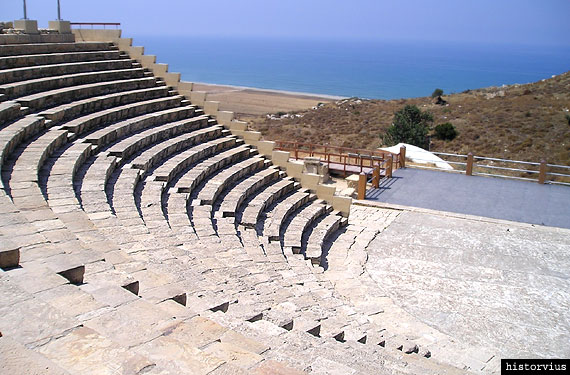
Cyprus is a popular tourist destination known for its multitude of resorts, beaches and entertainment. But placed as it is in the heart of the Mediterranean this island has also been hugely important to the history of the region and has seen some of the most famous ancient civilizations conquer, occupy, rule and crumble through the centuries. Today this rich historical heritage has left Cyprus with a wealth of archaeological wonders, of which the Roman-era remains rank among the best. From the relatively well-known site at Kourion to the obscure Amathus and the rich archaeological site at Nea Pafos , this island is a great way to combine sun, sea and history.
United Kingdom: More than just the Wall
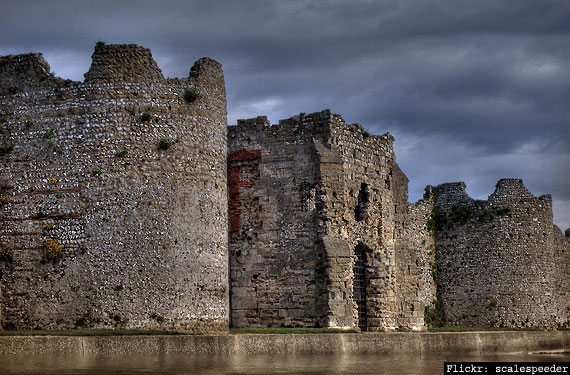
The island of Britain formed an important part of the Empire for hundreds of years and has a number of famous places from the Imperial era - the best known of which are the renowned ancient baths at Bath and of course Hadrian's Wall . But there are many excellent Roman-era destinations in Britain , of particular note are the fortifications of Portchester Castle and Pevensey Castle and the villas at Bignor , Lullingstone and North Leigh .
Italy - Campania: Beyond Pompeii
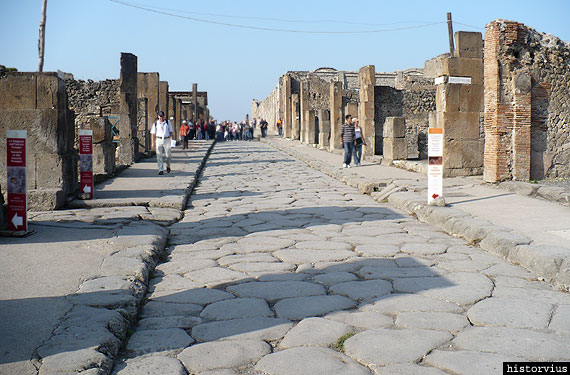
Campania is not only an idyllic destination but it's also home to one of the most famous of all Roman places, Pompeii . Yet beyond this ill-fated ancient metropolis there's a wealth of other great sites which can be explored in the region. Indeed, Pompeii's close neighbor Herculaneum ranks among the very best remnants of ancient Rome in existence. Also nearby is the Greco-Roman city of Paestum and the Roman villas at Oplontis and Boscoreale .
Germany: You'd be Surprised...
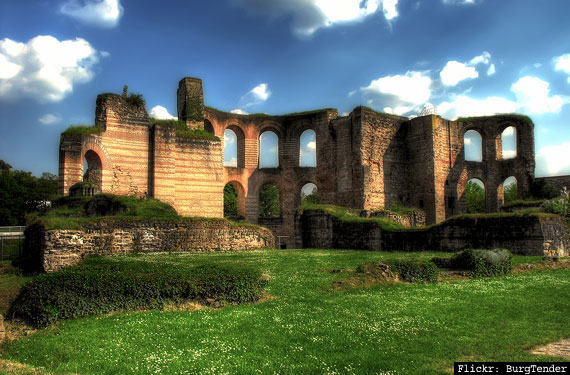
Most people think of Germany as lying outside the boundaries of the Roman Empire. In fact, Germany west of the Rhine was very much Roman territory, indeed it was one of the most important frontiers Rome had. Today there are some fine Roman remnants which can be explored in Germany, particularly in the town of Trier near the Luxembourg border, which boasts the largest single intact chamber to have survived from the Roman period as well as an impressive Imperial baths complex and an ancient amphitheater .
Portugal: Holiday with History
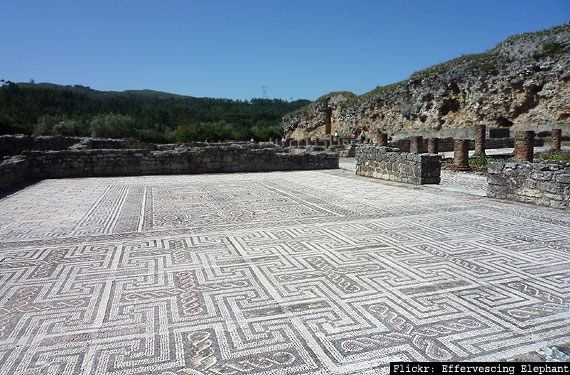
Today better known for its golfing resorts and beachside villas, Portugal offers the history buff a host of interesting archaeological sites to explore. From the Roman era, this country has a number of fascinating ancient cities and settlements, the most famous of which are Conimbriga , Milreu and Mirobriga . But for pure ease of exploration, it's hard to beat the ruins of Troia which are located just yards from the accompanying modern holiday resort. Ancient exploration has never been so lethargic...
Italy - Rome: Heart of Empire
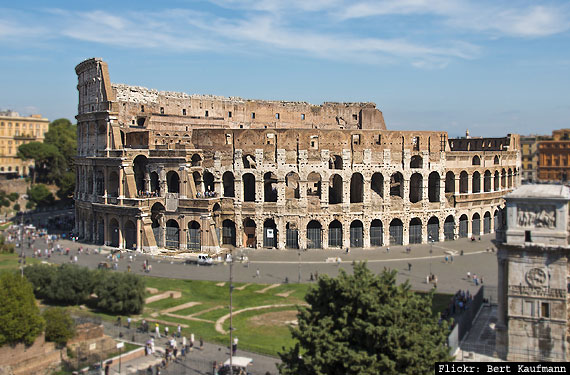
It may seem obvious to see Rome as the best place to explore the legacy of this ancient civilization. After all, it was this city which saw the birth of Roman life and it was from here that the Roman world expanded into Empire and ruled over millions. Yet due to its very significance this famous city suffered far more than many other regions when the Roman world finally collapsed. The center of Empire was lost, sacked, reconquered, fragmented and pulled apart over the centuries, leaving many of the most stunning Roman architectural achievements in ruins. However, that's not to say there aren't still a great many Roman wonders to explore here, quite the opposite. But although some of the most famous sites - such as the Colosseum - are truly spectacular, others are a bit of a letdown, particularly places like the Roman Forum , which offer just a shadow of their ancient grandeur. For some of the very best remnants of Rome to be found here you have to make a little more effort - sites such as Ostia Antica , San Clemente , Trajan's Markets , the Baths of Caracalla and Hadrian's Villa represent just a few of these incredible places.
Greece: Ancient Fusion

Greece is a country synonymous with history. But alongside the incredible remains of their own ancient civilization, Greece is also flooded with ruins from ancient Rome. Indeed, with these two ancient cultures fusing so completely for hundreds of years it can be hard to tell one from the other. To explore the Roman influence on Greece you can start in Athens with sites such as the Theatre of Herodes Atticus and the Roman Agora . But you can also head further afield to places such as Eleusis or Gortyna in Crete . And don't forget the hugely important events in Roman history that took place in Greece at sites such as Pharsalus and Philippi .
More from Historvius: Roman Amphitheaters | Roman Temples | Roman Baths | Places to visit in Rome | Greek Temples
Support HuffPost
Our 2024 coverage needs you, your loyalty means the world to us.
At HuffPost, we believe that everyone needs high-quality journalism, but we understand that not everyone can afford to pay for expensive news subscriptions. That is why we are committed to providing deeply reported, carefully fact-checked news that is freely accessible to everyone.
Whether you come to HuffPost for updates on the 2024 presidential race, hard-hitting investigations into critical issues facing our country today, or trending stories that make you laugh, we appreciate you. The truth is, news costs money to produce, and we are proud that we have never put our stories behind an expensive paywall.
Would you join us to help keep our stories free for all? Your contribution of as little as $2 will go a long way.
As Americans head to the polls in 2024, the very future of our country is at stake. At HuffPost, we believe that a free press is critical to creating well-informed voters. That's why our journalism is free for everyone, even though other newsrooms retreat behind expensive paywalls.
Our journalists will continue to cover the twists and turns during this historic presidential election. With your help, we'll bring you hard-hitting investigations, well-researched analysis and timely takes you can't find elsewhere. Reporting in this current political climate is a responsibility we do not take lightly, and we thank you for your support.
Contribute as little as $2 to keep our news free for all.
Dear HuffPost Reader
Thank you for your past contribution to HuffPost. We are sincerely grateful for readers like you who help us ensure that we can keep our journalism free for everyone.
The stakes are high this year, and our 2024 coverage could use continued support. Would you consider becoming a regular HuffPost contributor?
The stakes are high this year, and our 2024 coverage could use continued support. If circumstances have changed since you last contributed, we hope you’ll consider contributing to HuffPost once more.
Already contributed? Log in to hide these messages.
Popular in the Community
From our partner, huffpost shopping’s best finds, more in life.

16 Best Places to Visit Near Rome| 2024 (with Photos)

Andreas Rukovski - Travel Writer
Last Updated: January 15, 2024
Hey! How's it going? I'm Andreas, an avid traveler who has explored the stunning destinations near Rome. Join me as I uncover the 17 best places to visit near Rome in 2024, complete with captivating photos that will leave you inspired for your next adventure!

Travelers to Rome can be so mesmerized by the city itself that they often overlook the potential of the surrounding towns.
The area around Rome is a treasure trove of history, culture, and natural beauty, offering travelers unique places to explore.
Embark on one of the many day trips from Rome for a pleasant surprise at the endless possibilities waiting outside the city.
Whether you're interested in archaeology, spirituality, or simply soaking in the beauty of the Italian countryside, these 17 places to visit near Rome offer a diverse range of experiences that are sure to captivate any traveler.
Most Recommended Thing to Do
Vatican Museums
Top Choice Hotel
Hassler Roma
Our Top Choice Restaurant
Our Top Choice Bar for Nightlife
Best Time to Visit
Spring and autumn offer the best weather.
Average Temperature
Mild winters, hot summers, and pleasant spring.
Transportation Options
Metro, bus, tram, taxi, bike, scooter, walking, rideshare.
Average Cost ($, $$, $$$)
My Top Recommendation
A visit to the ancient Colosseum is an absolute must. Stand in awe as you witness the majestic amphitheater that once hosted thrilling gladiator battles and events. Take a guided tour to truly understand the significance and stories behind this iconic landmark.
Marvel at the remarkable art and architecture of St. Peter's Basilica, visit the awe-inspiring Sistine Chapel, and make sure to climb to the top of the dome for a breathtaking panoramic view of the city.
What You'll Need to Bring
- Travel documents
- Comfortable walking shoes
What Not to Miss
- Vatican City and St. Peter's Basilica
- Trevi Fountain
- Spanish Steps
What to Avoid
- Crowded tourist attractions
- Beware of pickpockets in crowded areas
- Watch out for scams and street vendors selling counterfeit goods.
Table of Contents

1. Explore Villa Gregoriana Landscape in Tivoli
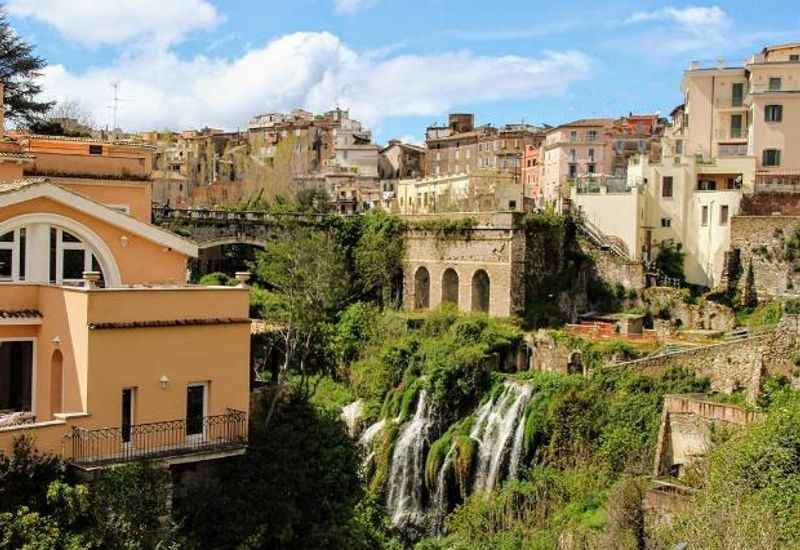
Tivoli, an old town just over an hour from Rome, is well known for its historical landmarks and natural beauty.
A notable attraction is Villa Gregoriana, a stunning park accessible from Tivoli train station, which is ideal for day trips. There are frequent trains between Rome and Tivoli.
Villa Gregoriana is a remarkable 19th-century park commissioned by Pope Gregory XVI. It features waterfalls, grottoes, Roman ruins, and beautiful landscapes, offering a serene and scenic experience in the heart of Italy.
This UNESCO World Heritage site provides a serene escape from the bustling city. The park offers a tranquil retreat where guests can explore the cultural treasures of the ancient site, making it a must-visit destination and popular tourist attraction.
2. Stroll Through the Beautiful Gardens in Villa d'Este

Villa d'Este is a magnificent Renaissance villa located in Tivoli, known for its exquisite gardens, grand fountains, and opulent architecture. A day trip to Villa d'Este from the eternal city is a popular excursion for those interested in ancient Roman history and architecture.
Constructed in the 16th century for Cardinal Ippolito II d'Este, Villa d'Este boasts breathtaking terraced gardens, adorned with tangled fountains, statues, and grottoes.
Villa d'Este has unparalleled beauty and architectural splendor and offers a glimpse into the opulence and elegance of the Italian Renaissance era.
3. Tour Emperor Hadrian's Legacy in Hadrian's Villa
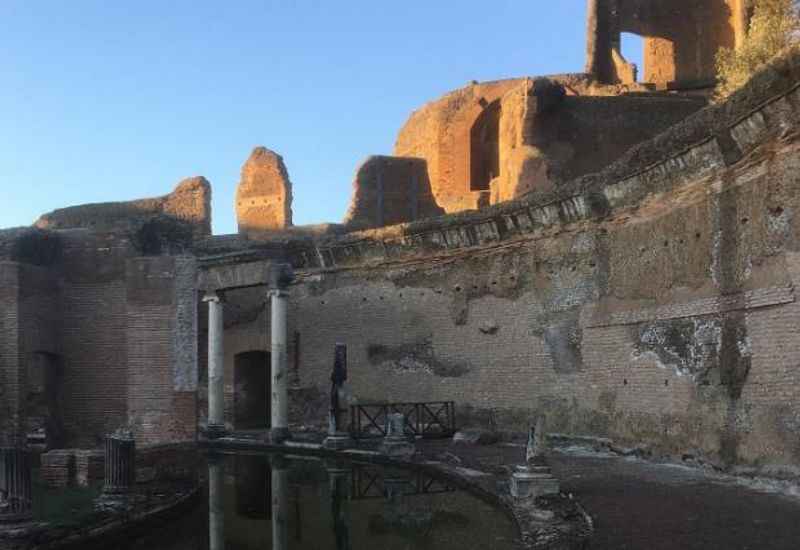
Villa Adriana, also known as Hadrian's Villa, is an ancient Roman village located in Tivoli. Built during the 2nd century AD by Emperor Hadrian, it spans over 120 acres and is a UNESCO World Heritage site .
Hadrian's Villa architecture showcases a unique blend of Roman, Greek, and Egyptian influences, with splendid gardens, courtyards, and numerous buildings, including palaces, libraries, and temples.
Today, it remains a remarkable testament to the grandeur and opulence of the Roman Empire, attracting people from all around the world.
4. See the Pope's Favorite Destination at Castel Gandolfo
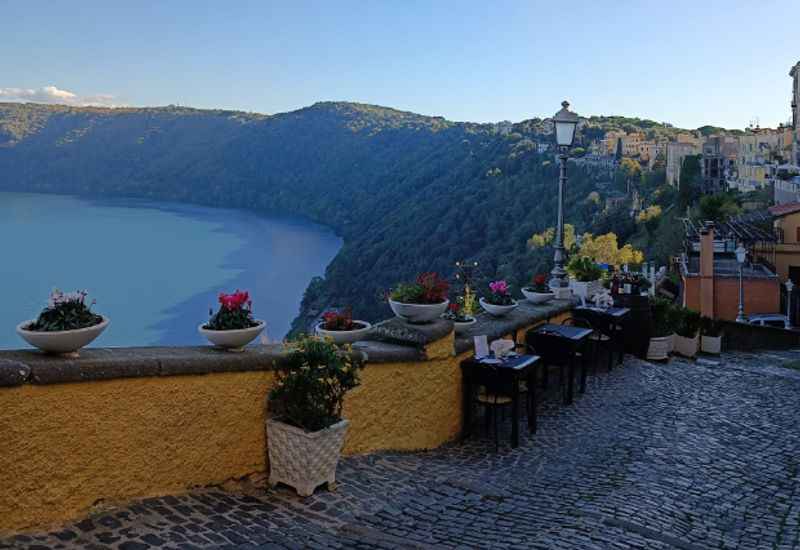
Castel Gandolfo, a small town in the Alban Hills of Italy, is known for its marvelous location overlooking Lake Albano. It is famously recognized as the summer residence of the Pope , and the Papal Palace is a major attraction in the town.
Castel Gandolfo is also known for its historic center with its ancient streets, charming houses, and panoramic views of the lake.
Travelers can enjoy a relaxing day trip from Rome to explore this town, stroll along the cobbled streets, and take in the scenic beauty of the surrounding countryside.
5. Visit the Astonishing Amalfi Coast
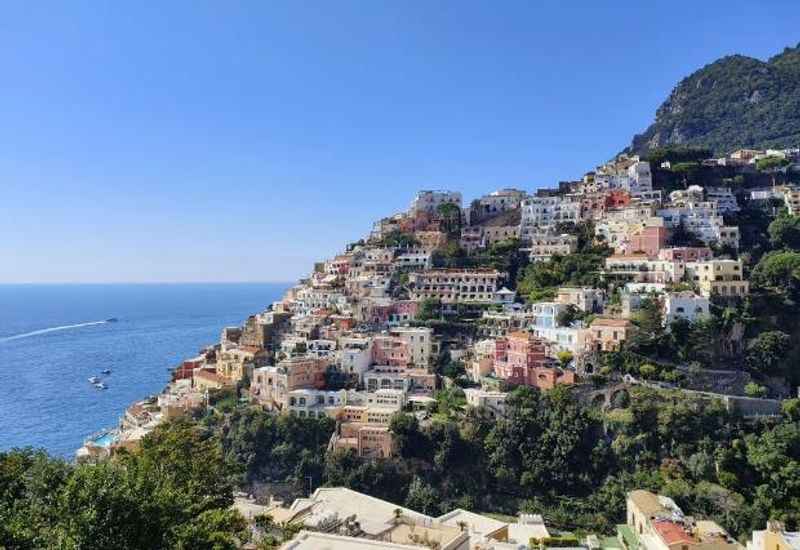
Amalfi Coast day trips from Rome offer a scenic escape to a destination known for its thrilling cliffs, turquoise waters, and gorgeous towns.
With options for train rides or public transport, travelers can easily access this enchanting destination that has been admired since the 1st century BC for its natural beauty.
Explore Amalfi, Positano, and Ravello with their colorful houses, charming streets, sandy beaches, and breathtaking sea views.
Day trips from Rome to the Amalfi Coast promise an unforgettable experience of coastal splendor and timeless allure.
6. Step Back in Time in Civita di Bagnoregio
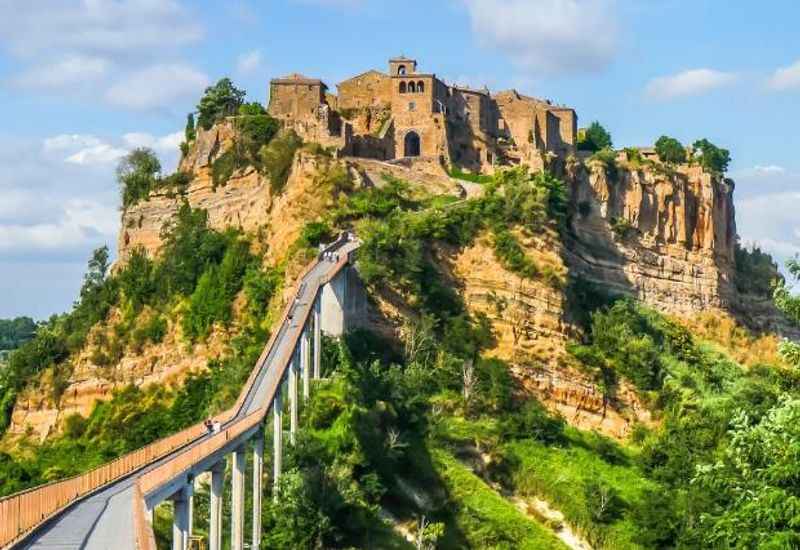
Also known as the " dying city ", Civita di Bagnoregio is an enchanting hilltop village located in central Italy. Perched atop a rugged plateau, this town is accessible only by a footbridge, adding to its remote and mystical charm.
The village is characterized by its ancient streets, and medieval houses, which stand breathtaking panoramic views of the surrounding countryside.
Despite its small size, this place is a popular tourist destination, known for its history, stunning locations, and well-preserved architecture. A visit to Civita di Bagnoregio is like stepping back in time to a bygone era.
7. Explore the Ruins of Pompeii
Pompeii, an ancient Roman city buried by volcanic ash in AD 79 and preserved for centuries, is a captivating destination to explore while visiting the Amalfi Coast in southern Italy.
The well-preserved ruins of buildings, streets, artifacts, and people offer a glimpse into the life and culture of the ancient Romans, making it a must-visit historical site.
The National Archeological Museum of Pompeii further showcases the daily life, culture, and art of the ancient Romans, with exquisite frescoes, sculptures, mosaics, and household items preserved from the ruins.
8. Discover the Charms of Naples
Naples is a bustling city in southern Italy, known for its history and cultural heritage. Naples was the most bombed city in Italy during World War II and it is one of the longest continuously populated cities in Europe. Its fascinating history goes back at least 2800 years.
One of its attractions is the Naples National Archaeological Museum , which houses a vast collection of artifacts from ancient Pompeii, Herculaneum, and other Roman sites. The museum showcases sculptures, frescoes, mosaics, and other archaeological finds, providing a fascinating insight into the ancient Roman civilization
This vibrant city, with its unique town center, delicious cuisine, and lively streets, is unmissable if you are heading to Italy for a vacation.
9. Take a Train Ride to Lake Bracciano
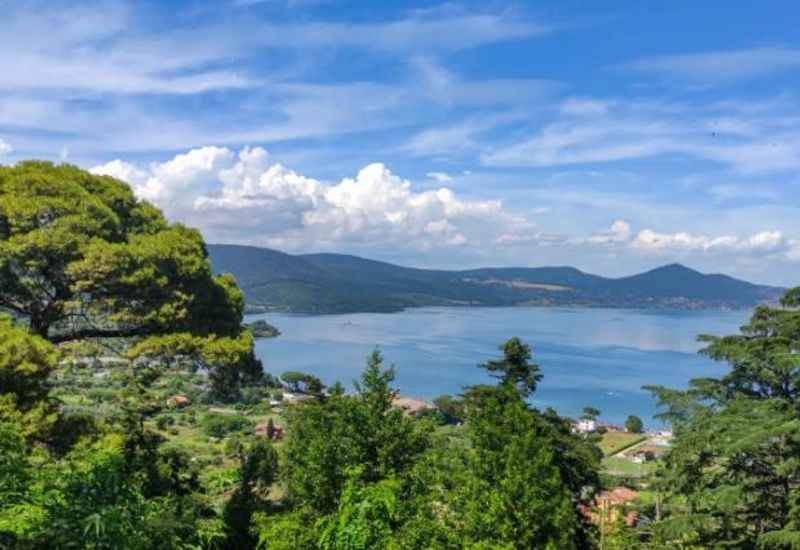
Lake Bracciano is a volcanic lake located near Rome , Italy. It is one of the largest lakes in Italy and is known for its pristine waters and scenic surroundings.
Moreover, Lake Bracciano is a popular destination for boating, swimming, and hiking. Its volcanic origins make it a unique natural attraction.
The lake is also home to several charming towns, such as Bracciano and Anguillara Sabazia, which offer opportunities for sightseeing, dining, and enjoying the peaceful atmosphere of this volcanic lake.
10. Walk Through Ancient Roman Streets in Assisi
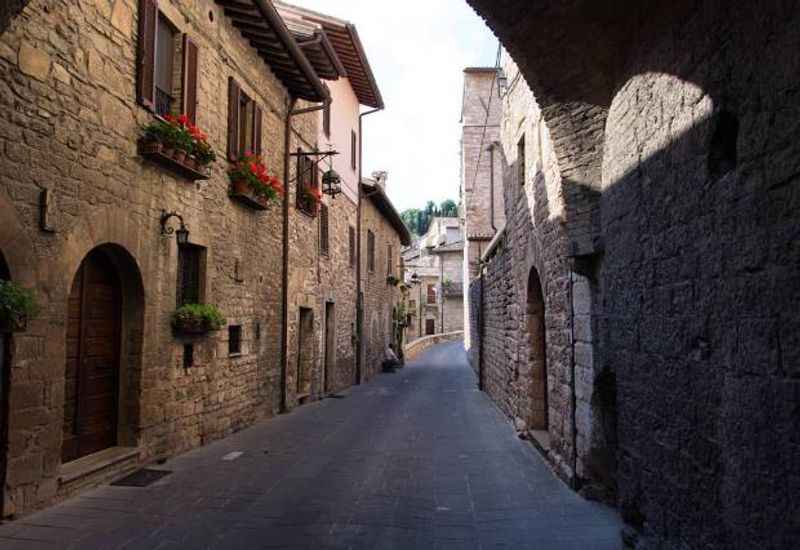
Assisi, located in central Italy, is famous for being the birthplace of St. Francis of Assisi , widely regarded as Italy's patron saint.
The town is known for its Basilica of San Francesco , which houses the remains of St. Francis and is a popular pilgrimage site for Catholics and one of the most popular tourist attractions in the area.
Assisi is also known for its medieval architecture, attractive landscapes, and serene spiritual atmosphere, making it a must-visit destination for those interested in religious history and Italian culture.
11. Enjoy a Day Trip from Rome to Orvieto

Orvieto ****is a hilltop town located in the Umbria region of Italy, known for its amazing panoramic views, history, and remarkable architecture.
The old town is famous for its magnificent Gothic cathedral , which features an intricate marble façade, narrow streets, and beautiful frescoes.
Visitors can explore Orvieto's winding streets, historical center, and ancient underground tunnels, then enjoy local food and wine.
Orvieto is a popular day trip destination from Rome, just over one hour away by train, offering a unique blend of history, culture, a food tour, and breathtaking scenery.
12. Just Over an Hour's Trip to Subiaco
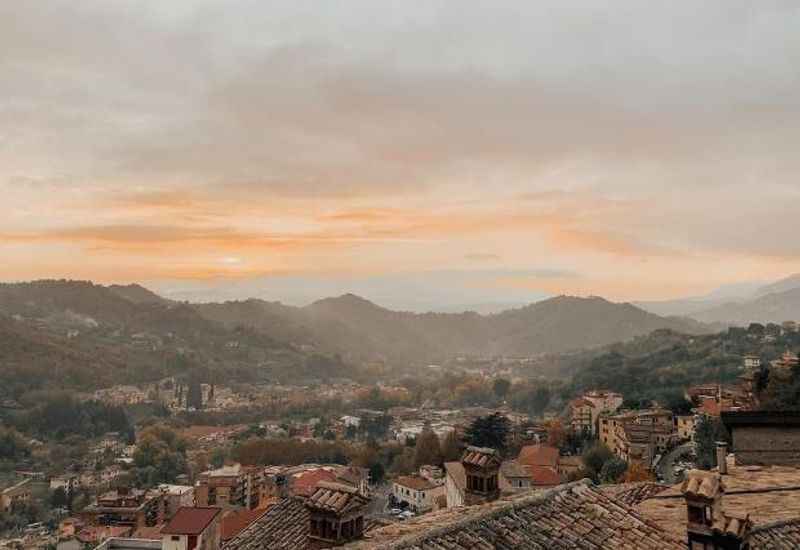
One of the lesser-known but historically significant places near Rome that were established in the fifth century is the Monastery of Saint Benedict in Subiaco.
It is known for its history and beautiful natural surroundings, including the Simbruini Mountains. Subiaco is famous for its ancient monasteries, including the stunning Monastery of Saint Benedict , where the patron saint of Europe is said to have lived.
Visitors can also explore the town's historic center with its cobblestone streets and cultural attractions. Subiaco is a popular destination for day trips from Rome, offering a peaceful retreat from bustling city life.
13. Exciting Tombs of Sutri
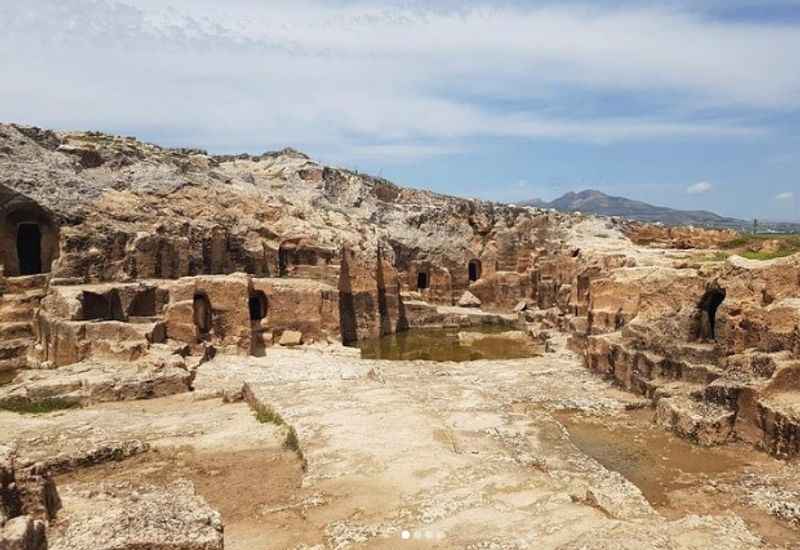
Sutri was an important Etruscan and Roman city, and visitors can explore its well-preserved Roman amphitheater, Etruscan necropolis, and fascinating rock-cut tombs.
Moreover, Sutri is home to the Church of the Madonna del Parto , a unique underground church carved into the tuff rock.
With its ancient heritage and historical significance, Sutri offers visitors a glimpse into Italy's rich past and is a popular day trip destination from Rome.
14. Explore Florence on the Arno River
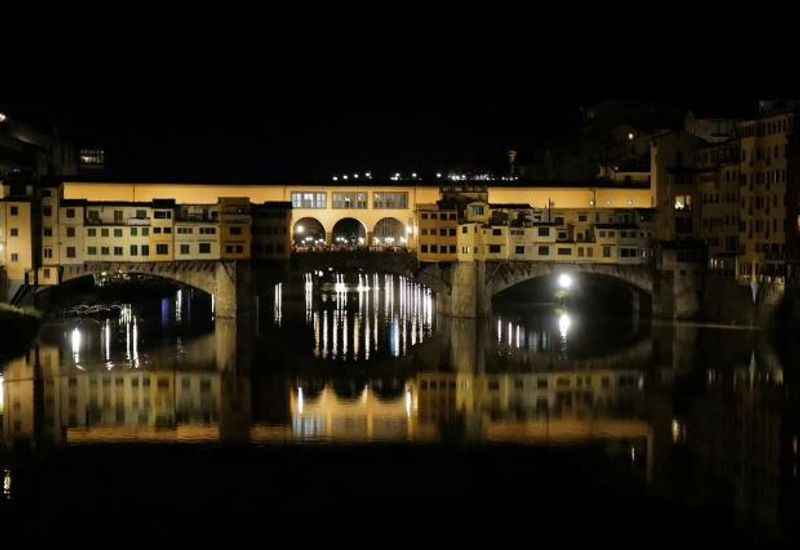
Florence is a beautiful and ancient city in central Italy. Renowned for its history, magnificent art and architecture, and vibrant culture, Florence is unmissable.
It is easily accessible from Rome and well worth the train ride. There are plenty of exciting things to do in Florence , and visitors can explore the charming town center with its ancient apartment buildings, and world-class galleries, including the iconic Uffizi Gallery .
15. Visit the Treasure of Vatican City
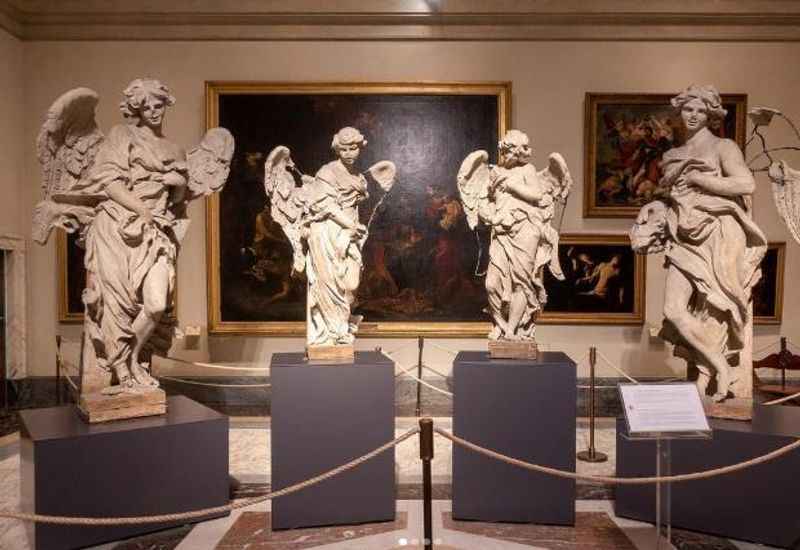
The smallest independent state in the world and the headquarters of the Roman Catholic Church is on the UNESCO world heritage list.
One of the most famous attractions in the Vatican is St. Peter's Basilica , which is the largest church in the world and a masterpiece of Renaissance architecture.
The Vatican Museums are a treasure trove of art and history, located within Vatican City in Rome. They comprise a vast collection of artworks, sculptures, and artifacts from different periods, including Ancient Egypt, Ancient Rome and the Roman Empire, classical antiquity, Renaissance masterpieces, and more.
As a site of immense historical, artistic, and religious significance, Vatican City draws millions of visitors each year to witness its awe-inspiring treasures and impressive churches.
16. The Basilica of Santa Maria Maggiore
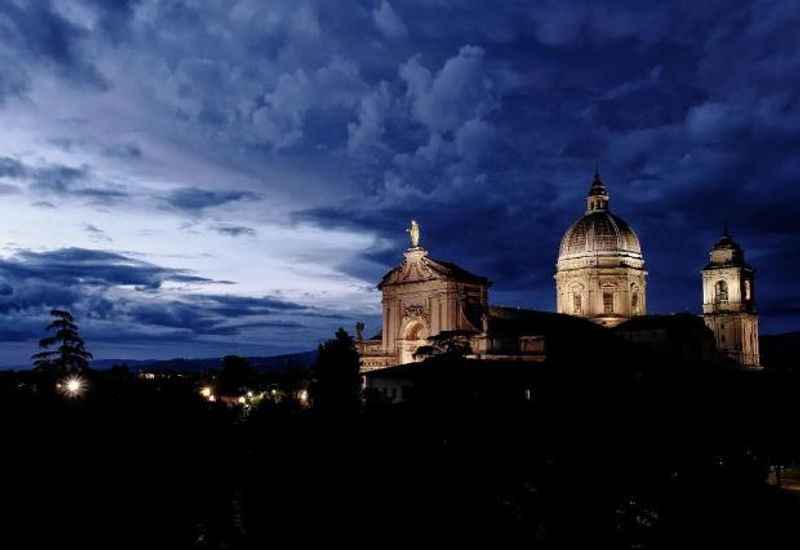
Finally, the Basilica of Santa Maria Maggiore, also known as the Papal Basilicas is an ancient Roman church that was built in the fourth century.
It is one of the oldest churches in Rome and is known for its rich history, beautiful architecture, and stunning mosaics.
The Basilica of Santa Maria Maggiore is a significant religious and cultural landmark, and its ancient origins make it a fascinating destination for those who strive for day trips where they will get to know architecture and art.
FAQs Regarding Places to Visit Near Rome
Let's look at the most frequently asked questions related to places to visit near Rome.
Is it expensive to visit Rome and take day trips on a low budget?
Day trips from Rome can range from affordable to expensive, depending on the destination and services included. However, there are also free attractions within Rome, like the Trevi Fountain and Spanish Steps.
What is the best public transport to use for a day trip from Rome?
Italy prides itself on its high-speed train service. These trains connect Rome with various cities in Italy, offering travelers a convenient and comfortable way to explore different regions of the country. The trains are the best public transport option for day tours and are known for their modern amenities, comfortable seating, and quick travel times.
What should I visit in Rome?
Within the city of Rome, you cannot miss the Piazza di Spagna, also known as the Spanish Steps . This is a famous set of steps in a square in Rome that is popular among tourists. Moreover, the Trevi Fountain is a true masterpiece of Baroque architecture and should also be on your list. Finally, there are countless ancient ruins in Rome, the Palatine Hill, and Piazza Navona.
Summary: Best Places to Visit near Rome
In sum, Italy is a treasure trove of historical sites and fascinating places to visit, offering many options for day tours from Rome.
Whether you choose to wander the cobbled streets of Subiaco, admire the art galleries of Florence, or marvel at the interesting sights of Pompei, Italy boasts numerous great options.
With its rich history, variety of cultural attractions, and easy access to public transport, Italy is a dream destination for day trips and those seeking to immerse themselves in the beauty and heritage of this enchanting country.

Explore Villa Gregoriana Landscape in Tivoli
Tour emperor hadrian's legacy in hadrian's villa.

See the Pope's Favorite Destination at Castel Gandolfo

Visit the Astonishing Amalfi Coast
Explore the Ruins of Pompeii
Related articles, featured in.


When in Rome: 15 things you must do in the capital of Italy
Posted: December 17, 2023 | Last updated: December 17, 2023
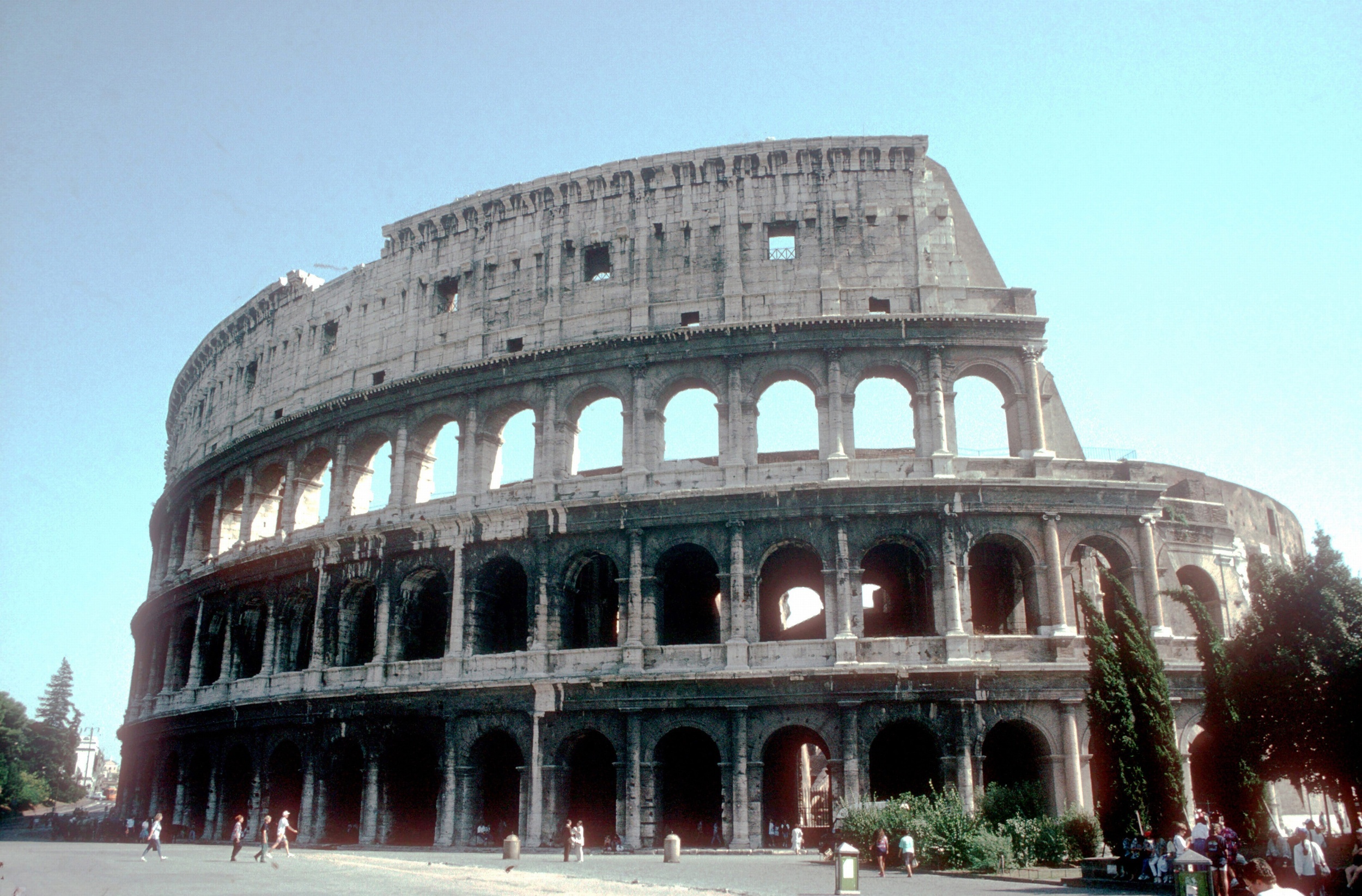
At this point, is there anything we can say about Rome that hasn't already been said? The famous city has been drawing in tourists, romantics, and artists for centuries, and has been the star of more movies than Marcello Mastroianni himself. It's a film come to life, an endless stream of ancient ruins, piazzas, and restaurants that never seems to lose its charm. Looking for a list of the best things to do here? Look no further.
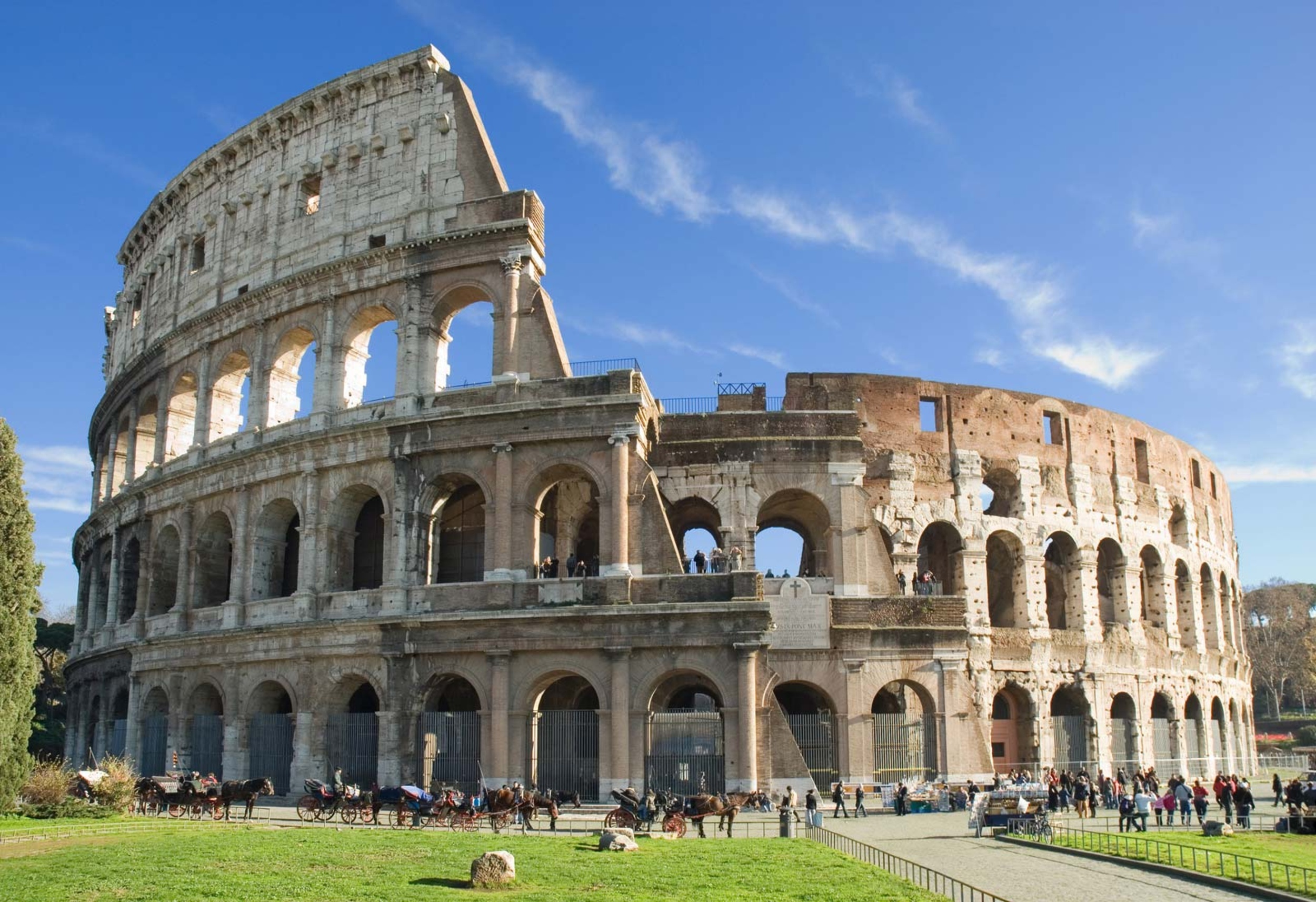
You likely already know, have seen, or heard about the Colosseum. It is the largest amphitheater ever built, and, if you have the chance to explore inside, one of the most impressive things you can see in Rome. The arena that once housed gladiator battles and executions is now a maze of tunnels, columns, and dust. The best views can be found on the 5th level, which offers panoramic views of the theater.
You may also like: 22 Southern slow-cooker recipes
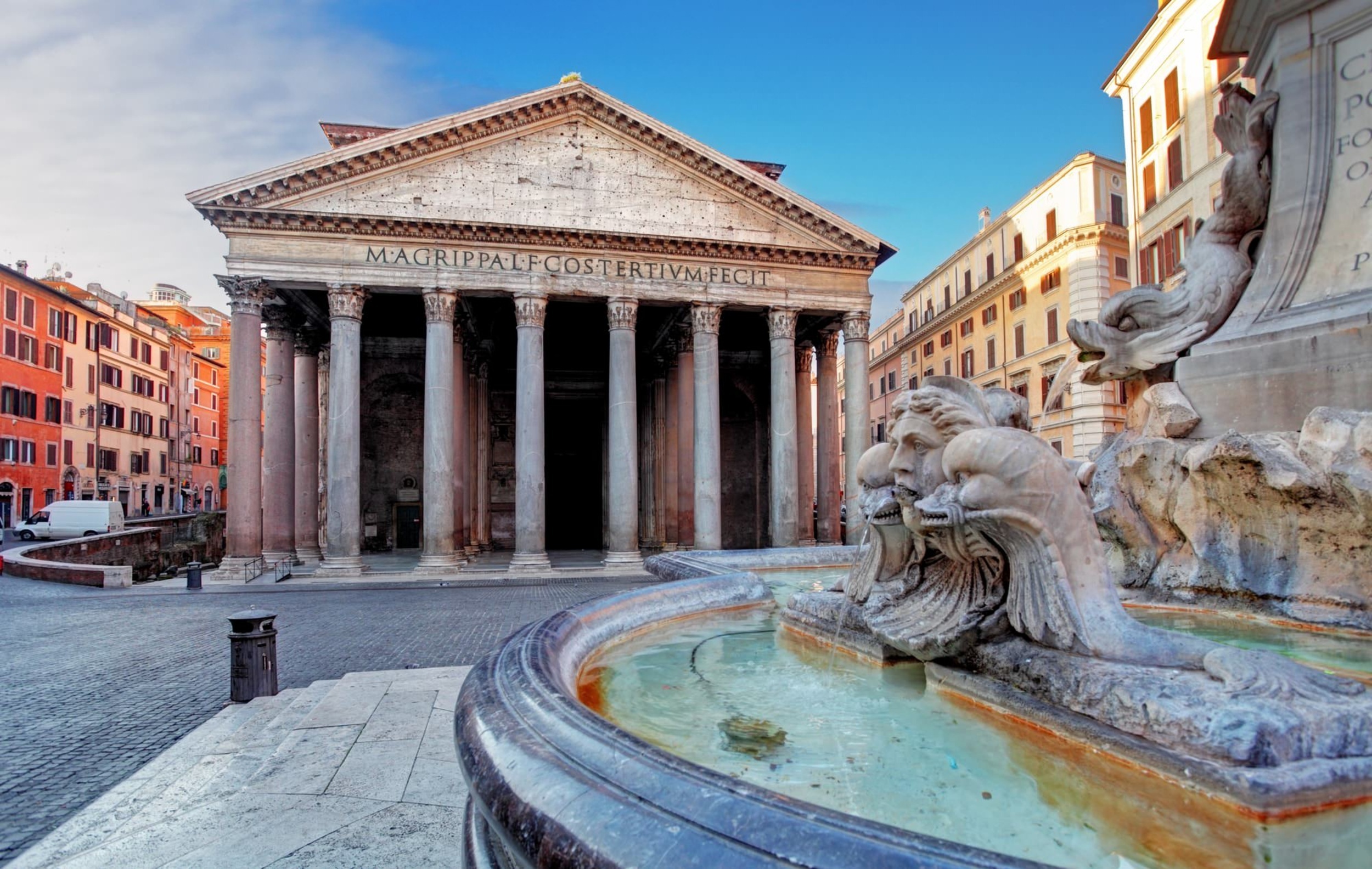
Let's be clear: Rome's Pantheon is not just another temple. It is the city's most important landmark, built in 125 AD and boasting some of the most epic pillars on earth. These things make the White House look small, and no trip is complete without a picture of its facade.
Follow us on MSN to see more of our exclusive lifestyle content.
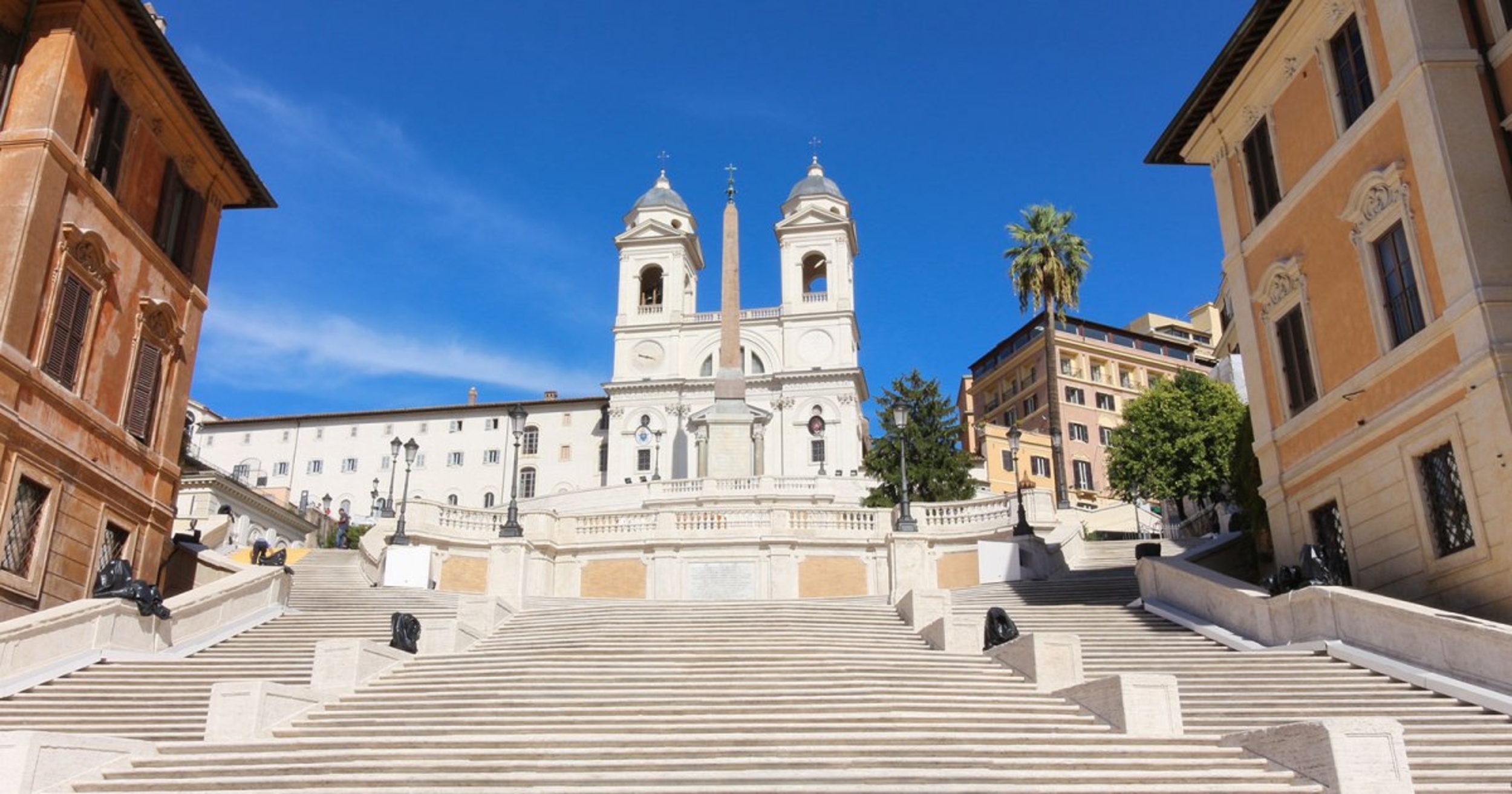
The Spanish Steps
Walking is the perfect way to burn off pasta, so the Spanish Steps make for a perfect afternoon activity. The staircase connecting Piazza di Spagna to the Spanish Embassy is filled with magical sights, from kids splashing in the fountain to emeralds glowing in the embassy.
You may also like: 15 no-cook recipes perfect for meal prep

The Vatican
The Vatican is home to one of the largest and most important art collections in the world and is set across 54 galleries, courtyards, and hallways. You'll find countless works of art by artists like Raphael and Michelangelo, whose Sistine Chapel remains the GOAT of frescos. You get goosebumps just looking at Jesus reach out to Adam--the entire history of man at their fingertips.

Felice a Testaccio
Did we mention Rome might have invented cacio e pepe? Whether the stories are true or not, the city's restaurants all serve their own version of this signature dish. The best place to order one of these plates is at Felice a Testaccio, which prepares the pasta in front of you and has graciously located itself outside of town. You're going to need a long walk after this one.
You may also like: 20 big-batch cocktails that are perfect for small gatherings
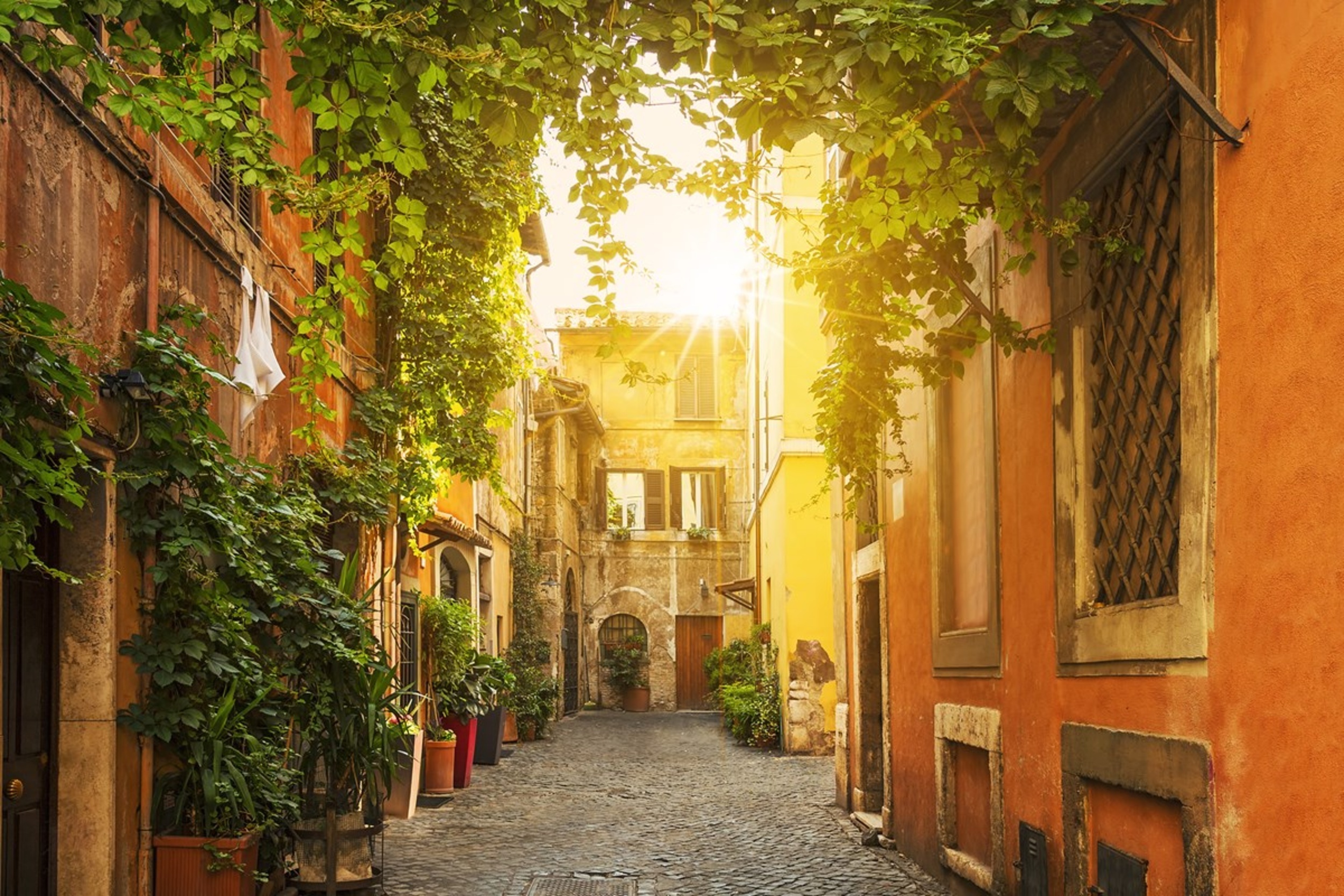
Rome is full of quaint neighborhoods but, with all the sightseers, not many will offer you a proper taste of bohemian life. For that, cross the river to Trastevere: home to street markets, local bars, restaurants, and apartments, and more alleys than all the canals in Venice. Get lost in the maze of streets that make up this section of town--then, after you spend a couple of hours walking, stop in for drinks at one of the many outdoor bars.
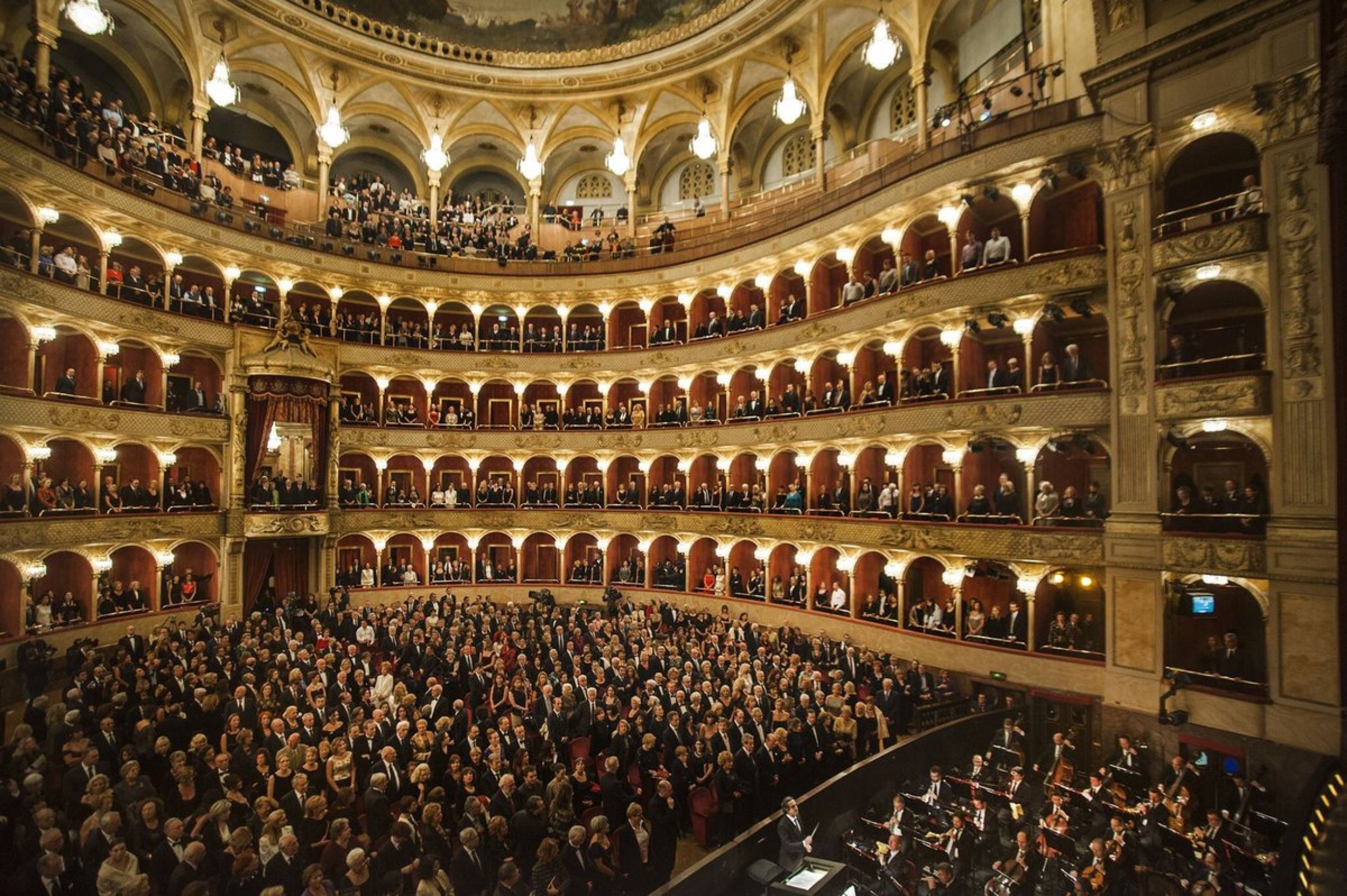
Rome Opera House
Since its founding by Domenico Costanzi in the late 19th century, the Rome Opera House has remained one of the finest opera houses in Europe. We recommend you stop by for an opera or if you find that too snooty, check out one of the many fashion shows put on by brands like Dior. Is that too snooty for you? Take a tour instead, which will give you access to the neo-classical design.
You may also like: Sweet world: 25 dessert recipes from around the globe
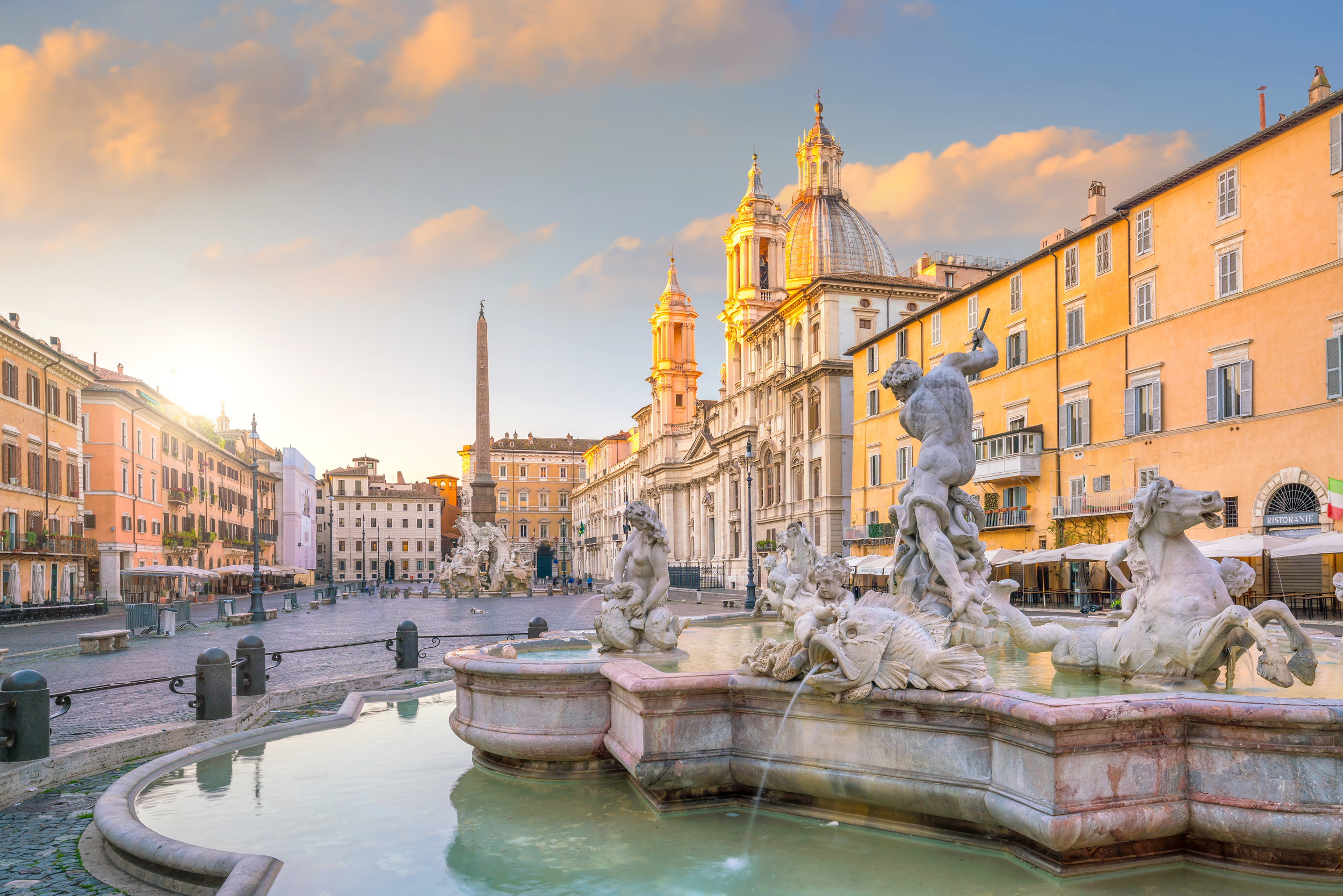
Piazza Novana
You can't visit Rome and not spend at least a couple of hours in a piazza. The best place to do so is Piazza Navona, an area surrounded by restaurants, fountains, and ancient statues. Here, you can grab a bite or an Aperol spritz, and take a second to relax while the rest of the world goes by.
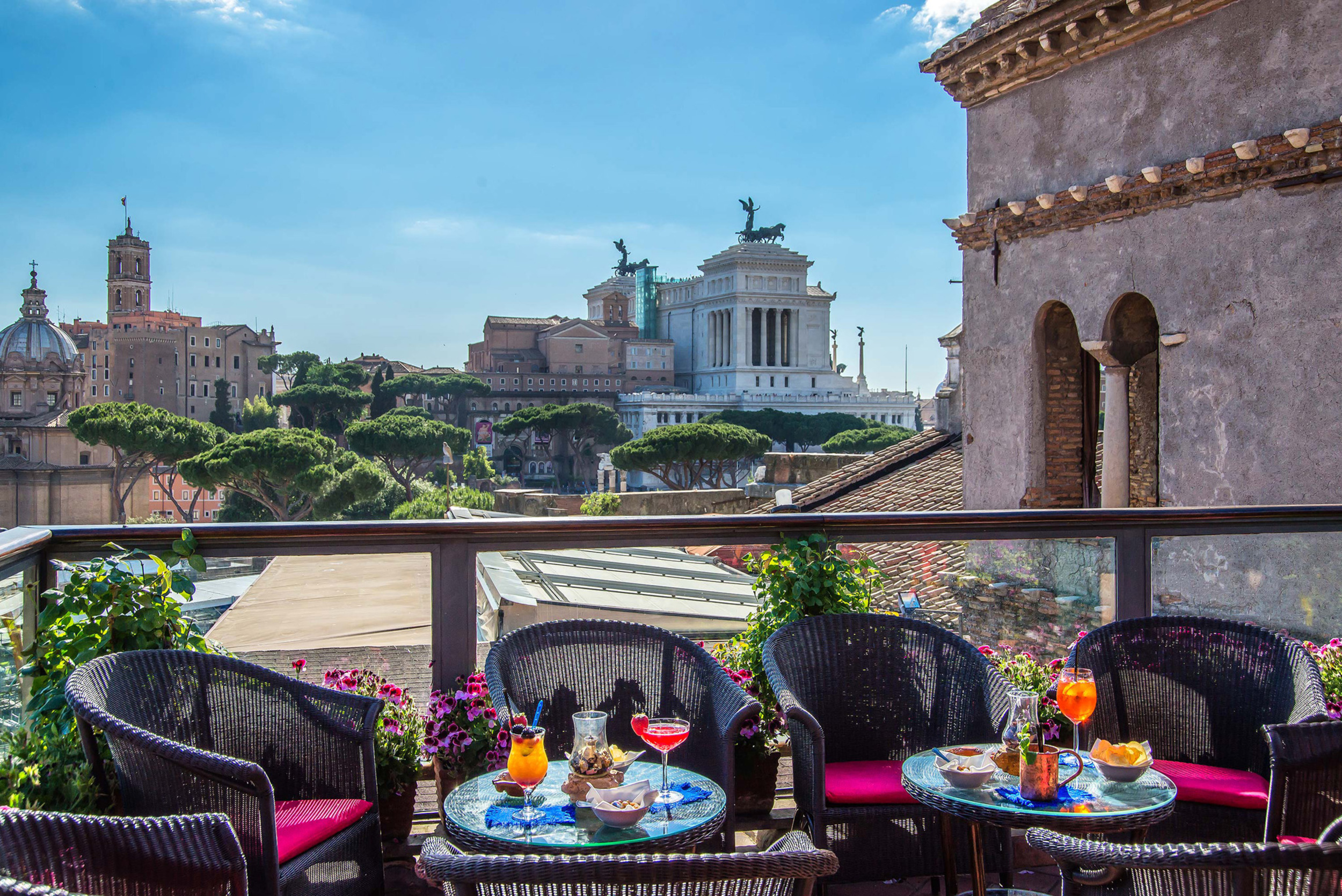
Forum Hotel Bar
Grab a drink at the same place actors like Julia Roberts and Richard Gere frequent, on the rooftop of one of Rome's most prestigious hotels. Located just above the Roman Forum--the ruins next to the Colosseum--this spot is perfect for those looking to take a second to unwind. Many only come here for an Instagram photo, but the best thing you can do here is to spend a couple of hours in the company of silence.
You may also like: 20 ingredients that will make your grilled cheese even better
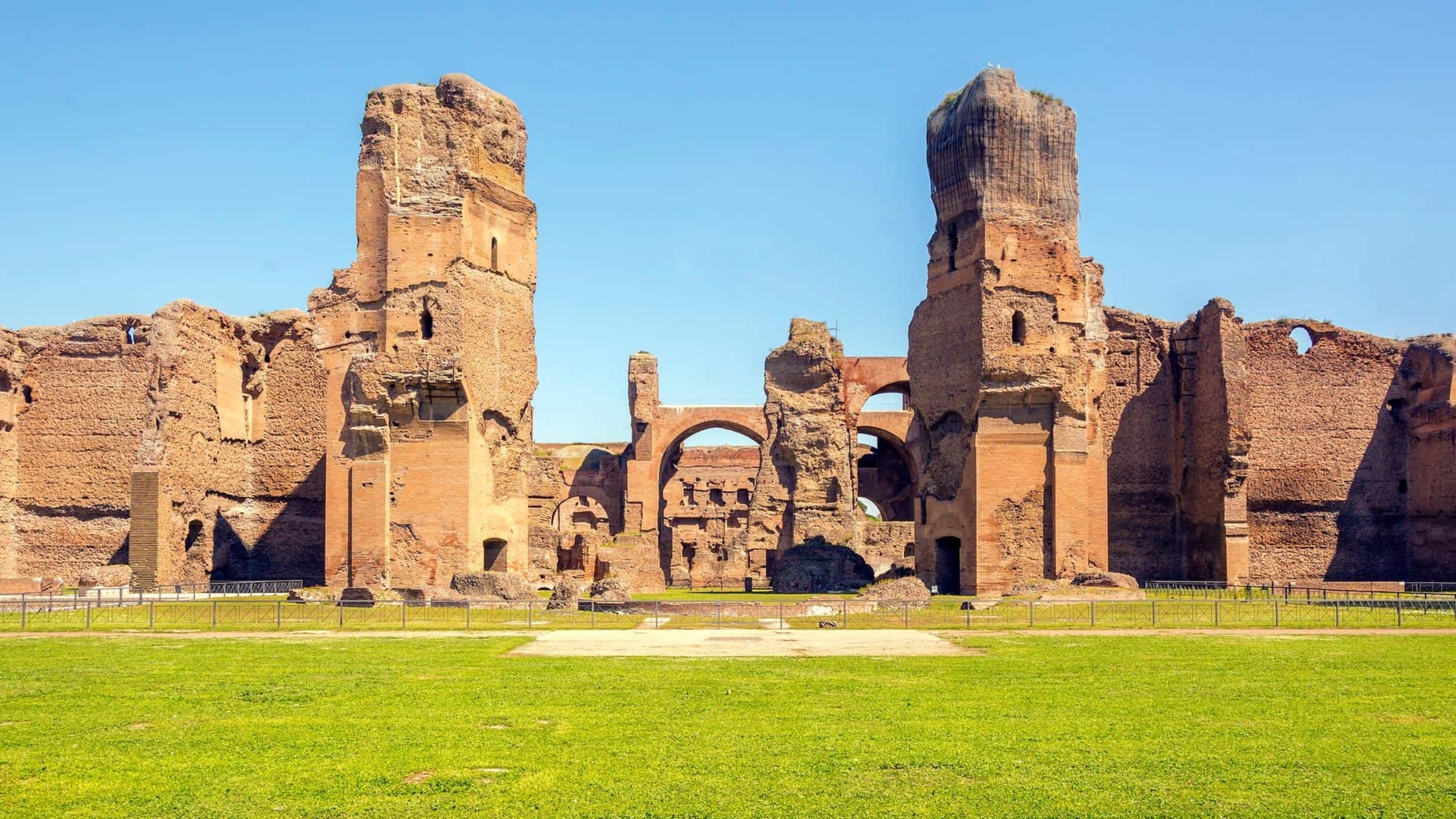
Baths of Caracalla
This oasis was once a public bathing complex in the third century. Now, it's open year-round for visitors to wander its many ruins, fields, and arches. Each summer, the Roman opera performs at the baths to sold-out crowds. Those lucky enough to get tickets are treated to a once-in-a-lifetime experience.
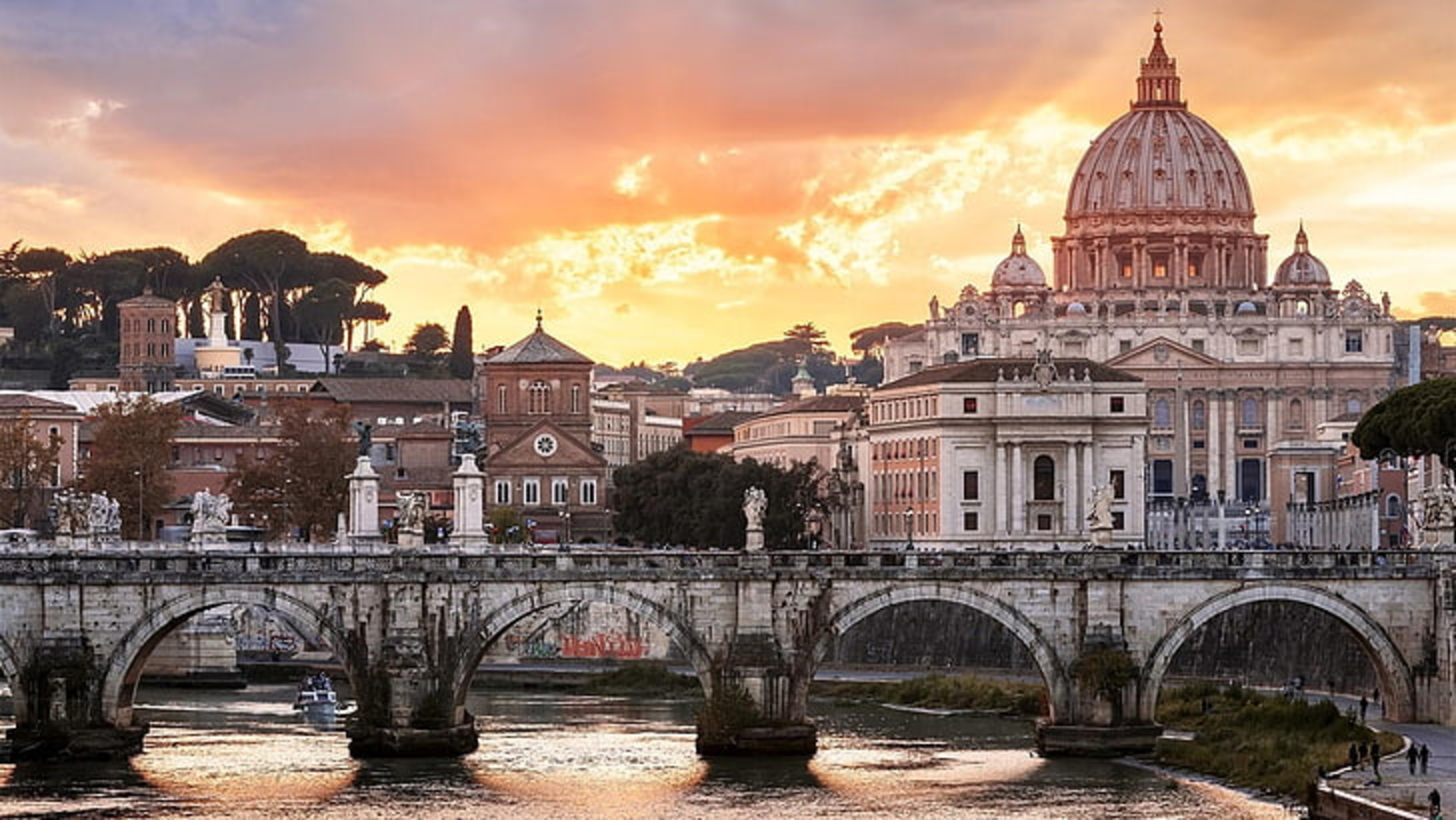
Tiber River
Does anyone here like sunsets? Thought so. If you're in Italy, you'll probably want to see a sunset at some point, which means you should probably head down to the Tiber river at golden hour. There's a great view from the river itself, though we recommend you stand on the bridge to watch the eternal city swirl into an eternal haze.
You may also like: 20 essential tips for decorating on a budget
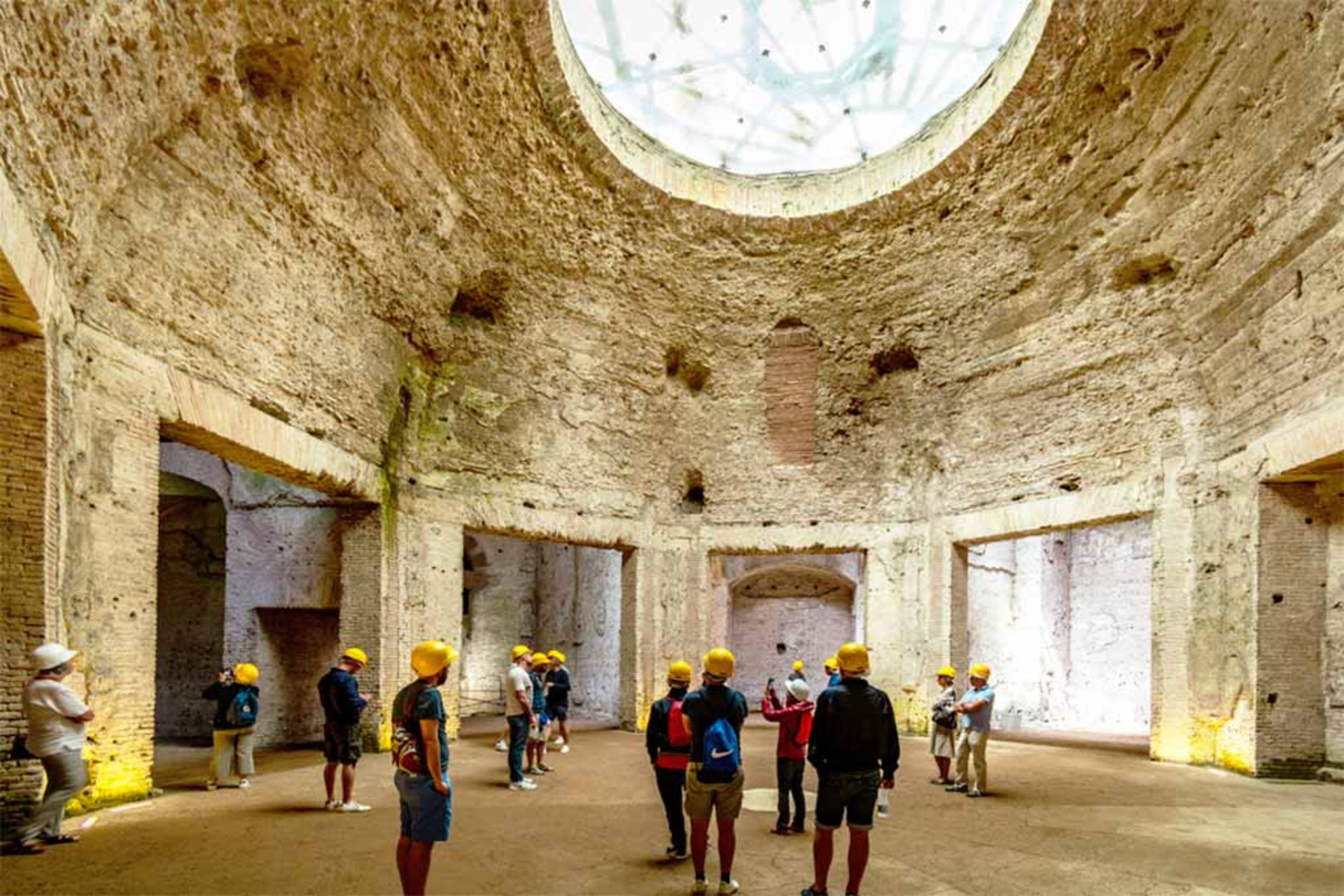
Dormus Aurea
Emperor Nero's pad was once considered the Playboy Mansion of Rome. Built between 64-68 AD, the underground mansion was home to some of the wildest parties in town before it was abandoned completely. The site is under restoration, but visitors can join guided tours on Saturdays and Sundays to see what made this place so unique.
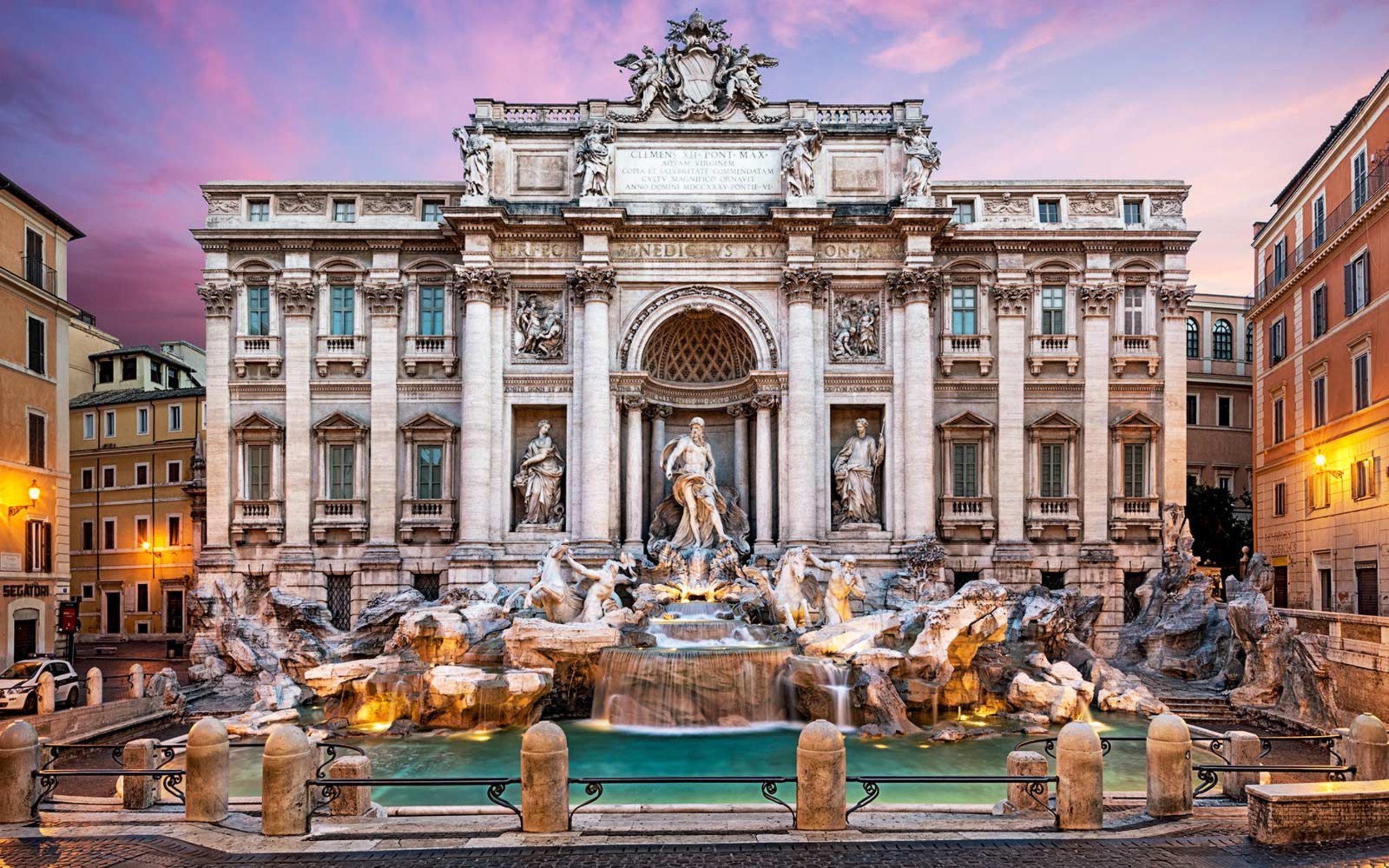
Trevi Fountain
Often referred to as "The Three Street Fountain," the Trevi Fountain is an excellent example of the city's regional art. Located at the intersection of three streets, this fountain draws in visitors from all sides of Rome. Its statues are a lineup of masterpieces from Nicola Salvi, but the real reason everyone is here is because of Federico Fellini, who shot the famous scene of Marcello Mastroianni and Anita Ekberg lapping in the pool at midnight.
You may also like: 20 hacks for small apartment living

Stadio Olimpico
Move over, American football. The crowds of 70,000 that cram into Stadio Olimpico make the Superbowl sound like a high school game. Even people who find soccer boring can't help but be blown away by the noise.
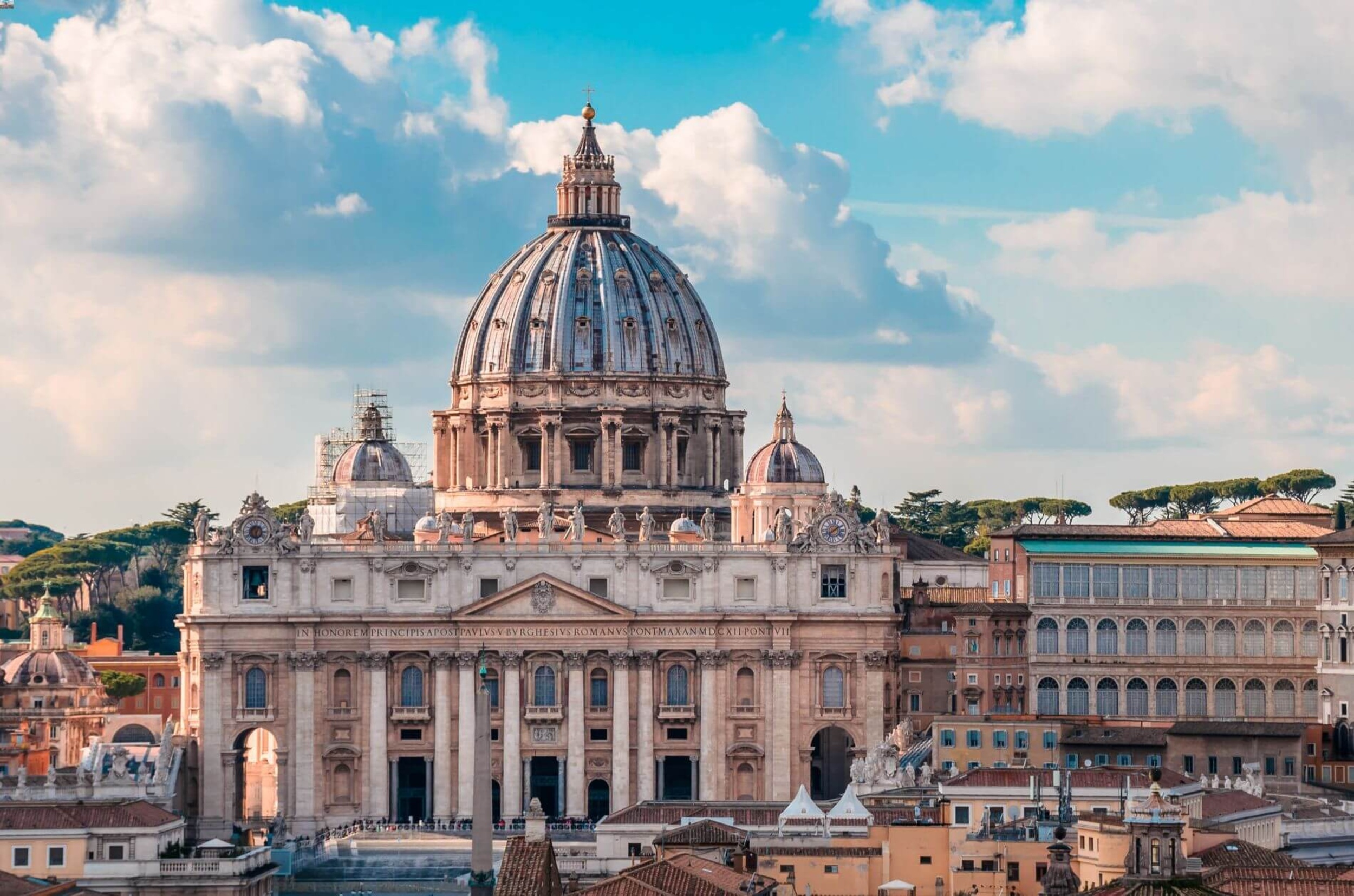
St. Peter's Basilica
St Peter's Basilica is a church built by some of Rome's greatest architects. It is the most renowned piece of Renaissance construction, with contributions from Michelangelo, Maderno, and Bramante, and houses one of Rome's most dramatic squares. On the way to the top, you'll get a birds-eye view of both the square and the Vatican chapels.
Did you enjoy this slideshow? Follow us on MSN to see more of our exclusive lifestyle content.
More for You
Putin Issues F-16 Warning
Republican-passed bill removes role of Democratic governor if Senate vacancy occurs in Kentucky
Kenan Thompson speaks out on Dan Schneider allegations: ‘Investigate more’
Trader Joe's Just Released New Spring Products & These Are The Best Ones
These Are the 16 Smells Rats Hate the Most
Are eggs bad for cholesterol? New study reveals how many you can eat
Ukraine says a missile barrage against Russia's Black Sea Fleet was even more successful than it thought
Judge Throws Cold Water on Hunter Biden’s Political-Prosecution Claim: ‘No Evidence’
McDonald’s fans welcome new menu item after partnership announced
How to Get Rid of Ants in Your House and Yard
19 Traits People Develop Due to Bad Childhoods
What You Need To Know Before Cataract Surgery
‘World’s largest small town’ offering $10,000 for workers to move there
Willie Nelson moves 2024 Fourth of July Picnic out of Texas
Dairy Queen Is Giving Away Free Blizzards for 2 Weeks
Why do I wake up at 3 a.m. every night?
Russian State TV Proposes Seizing Alaska and California
3 underrated Netflix movies you should watch this weekend (March 29-31)
What Smells Do Mosquitoes Hate? 10 Scents You Need to Use This Summer
18 Dogs You Shouldn’t Get If You Have Kids

IMAGES
VIDEO
COMMENTS
Fantastic archaeological sites to visit in Rome Colosseum. Impossible not to start with the Colosseum.Arguably the most popular site in all of the city and the first landmark everyone rushes to, a visit to the Colosseum is a must for every first-timer.. A mighty amphitheater erected in the 1st century, this is where gory shows and fights between gladiators and gladiators against wild animals ...
Roman Ruins And Archeological Sites In Rome Italy. Here are my picks for the 30+ must visit Roman ruins in Rome. 1. Domus Aurea: Nero's Underground Golden House. Nero's Golden House was once the grandest building on earth. It's not your typical Roman tourist site, and is an often overlooked hidden gem in Rome.
1. Palatine Hill & Roman Forum. The origins date from around the 10th century BC. Some of the oldest Roman temples (7-8th century BC) were located in this area as well. The Roman Forum (Forum Romanum) and the Palatine Hill (Palatino) are among the oldest places in the city of Rome.
Pantheon. Built as a pagan temple to the gods, the Pantheon is Rome's best-preserved ancient site, perhaps because it was later consecrated as a church. It was originally constructed by Augustus ...
9. The Trevi Fountain. The Trevi Fountain is an iconic 18th century monument in Rome. A stunning depiction of ancient deities and resplendent with frescos of legends and myths, the Trevi Fountain attracts floods of tourists keen to throw their coins into its waters to assure their return to Rome - or so goes the myth.
Address. Piazza della Rotonda, 00186 Roma RM, Italy. Phone +39 06 6830 0230. Web Visit website. Rome's Pantheon, the temple of all the gods, was built between 118-125 A.D. by Emperor Hadrian. In the 7th century it was made into a church by early Christians and now is lined with tombs.
Rome, Lazio, Italy, Europe. In a city of extraordinary beauty, Rome's ancient heart stands out. It's here you'll find the great icons of the city's past: the Colosseum, the Palatino, the forums and the Campidoglio (Capitoline Hill), the historic home of the Capitoline Museums. Touristy by day, it's quiet at night with few after-hours ...
5. Trevi Fountain. Trevi Fountain. One of the city's most popular tourist attractions, this 17th-century masterpiece has been immortalized in films until it is almost a required visit. Throwing a coin (not three) into the Trevi Fountain (Fontana di Trevi) is a tradition that is supposed to assure your return to Rome.
Monti, Esquilino & San Lorenzo. Trastevere & Gianicolo. Vatican City, Borgo & Prati. Discover the best attractions in Ancient Rome including Colosseum, Roman Forum, and Palatino.
Many scientists, researchers, and philosophers dedicated their careers to its exploration. These six must-see places in Rome help us connect to the ancient world while teaching us about the life of the Roman Empire and important historical events of that time. 1. The Colosseum. The Colosseum, in Rome. Source: National Geographic.
Here's the list of famous Roman ancient sites: The Colosseum. The Colosseum or Coliseum is perhaps the grandest construction in the history and culture of ancient Rome. It was created around 70-72 A.D. by Emperor Vespasian of the Flavian dynasty as a gift to the Roman people.. Moreover, the site had been the most prestigious place for entertainment in the capital and empire for four centuries.
A visit to the Mausoleum offers a captivating look at Imperial Rome's funerary customs and architectural preferences. Portico di Ottavia. Nestled in the heart of Rome's Jewish Quarter, the Portico di Ottavia is infused with the history of a bustling marketplace that once catered to ancient Romans.
The Colosseum itself, which you can visit with a guided tour. The Roman Forum, which is an open-air archaeological park with columns, Triumphal arches, ancient temples, ancient basilicas and the tomb of Julius Caesar. The Palatine Hill, the hill above the forum with the palaces of emperors and Romulus's hut.
The Baths of Caracalla are a significant site in ancient Rome and have a fascinating history that is worth knowing. Emperor Caracalla, who ruled from 211 to 217 AD, commissioned these baths, which were completed around 216 AD. These baths were massive, covering about 25 acres and offering a wide range of amenities such as baths, pools, gyms ...
With a glorious history spanning over 2800 years, the Eternal City boasts several scintillating ancient ruins, archaeological sites, and historic landmarks. That is why we've compiled a list of the best historical sites in Rome. Discover some of the places where Ancient Rome once thrived, declined, and eventually fell.
Guide: the historical places in Rome (itinerary) By Elliot Clennam January 17, 2023. Rome, the capital of Italy, is an ancient city filled with treasuries of history and culture; With a history spanning more than 2,500 years, Rome is home to some of the world's most iconic and historical places. From the Colosseum's grandeur to the ...
ancient Rome, the state centred on the city of Rome. This article discusses the period from the founding of the city and the regal period, which began in 753 bc, through the events leading to the founding of the republic in 509 bc, the establishment of the empire in 27 bc, and the final eclipse of the Empire of the West in the 5th century ad.
12. Ostia Antica. Ostia Antica is an ancient harbor town located about 40 minutes outside Rome, Italy, and contains some impressive Roman ruins. Founded in the 4th century BC, Ostia Antica was an essential commercial hub that helped transport food and grain to Rome's citizens.
2. Colosseum: Rome's Grand Arena of History. The Colosseum stands as a majestic reminder of Rome's rich history, drawing travelers from every corner of the world. As one of the best places to visit in Rome, this ancient amphitheater offers a glimpse into the lives of gladiators, emperors, and the Roman populace.
Places to Visit in Ancient Rome #2 - The Roman Forum. If the Roman Colosseum is the most recognizable of the places to visit in Ancient Rome, the Roman Forum is a very close second. Whereas the Colosseum was where Romans went to be entertained, the Forum was where they went to get things done.
Here's 10 reasons why visiting ancient Rome is pretty awesome, and a bonus 20 pictures to go with it! 1. The Colosseum is about the most impressive place you'll step inside, and you can pretend you are in Gladiator. I definitely wasn't prepared for the sheer magnitude of the Colosseum, and it was my first real "pinch me" moment after ...
For some of the very best remnants of Rome to be found here you have to make a little more effort - sites such as Ostia Antica, San Clemente, Trajan's Markets, the Baths of Caracalla and Hadrian's Villa represent just a few of these incredible places. Greece: Ancient Fusion. Greece is a country synonymous with history.
Finally, there are countless ancient ruins in Rome, the Palatine Hill, and Piazza Navona. Summary: Best Places to Visit near Rome. In sum, Italy is a treasure trove of historical sites and fascinating places to visit, offering many options for day tours from Rome.
You can't visit Rome and not spend at least a couple of hours in a piazza. The best place to do so is Piazza Navona, an area surrounded by restaurants, fountains, and ancient statues.
ANCIENT ROME, Italy 4K Walking Tour - March 2024 ! #travel #italy =====Embark on a serene walking tour through the...